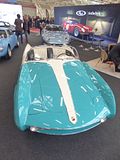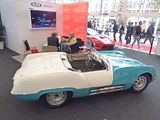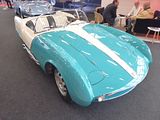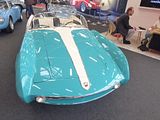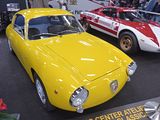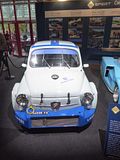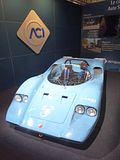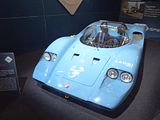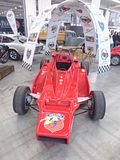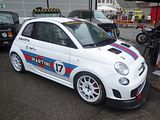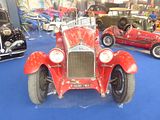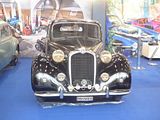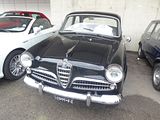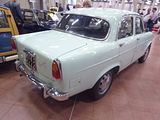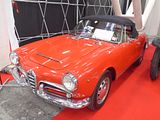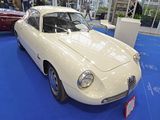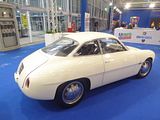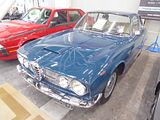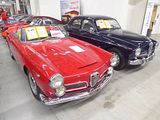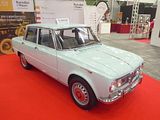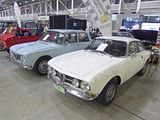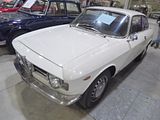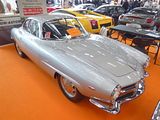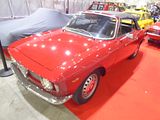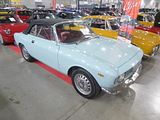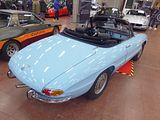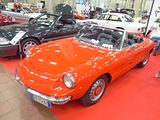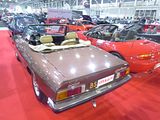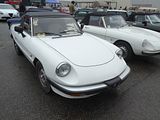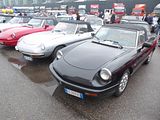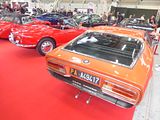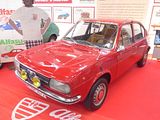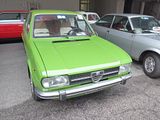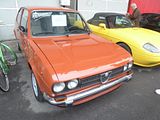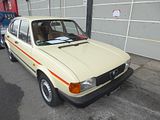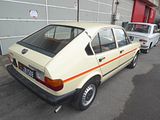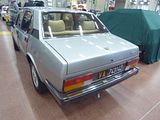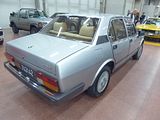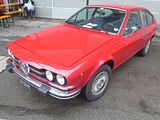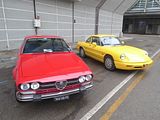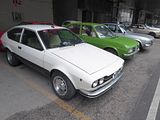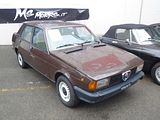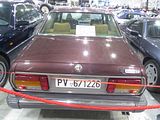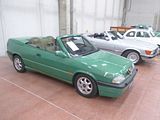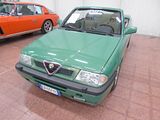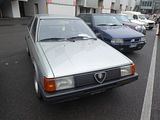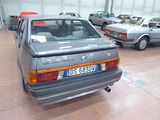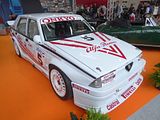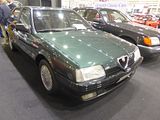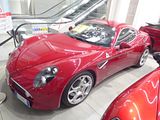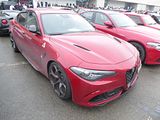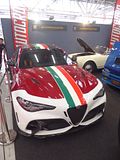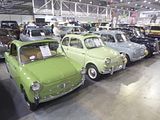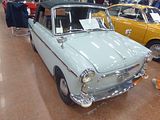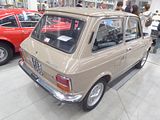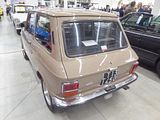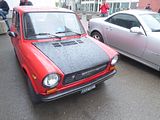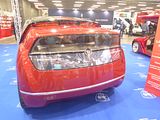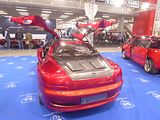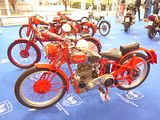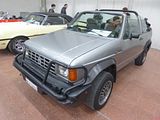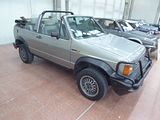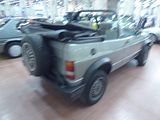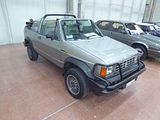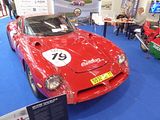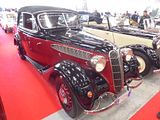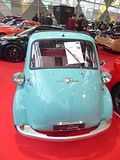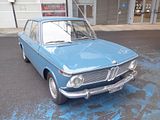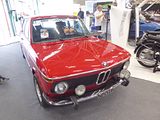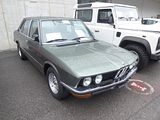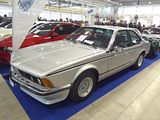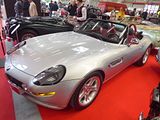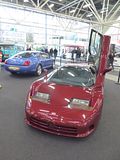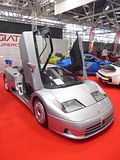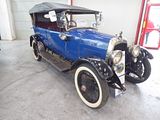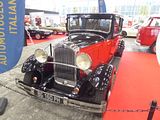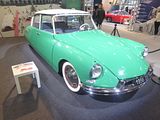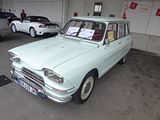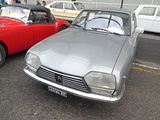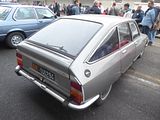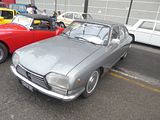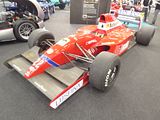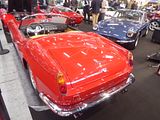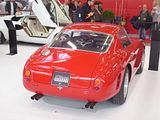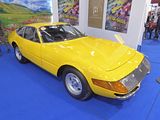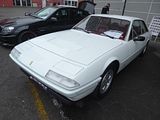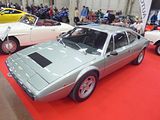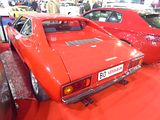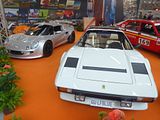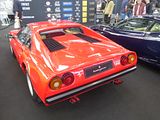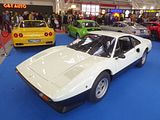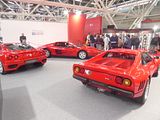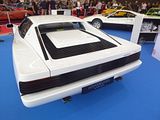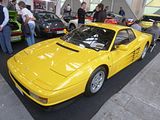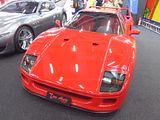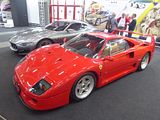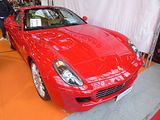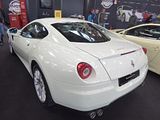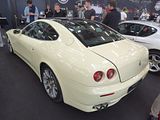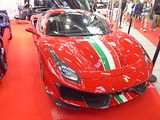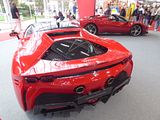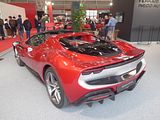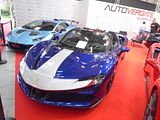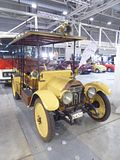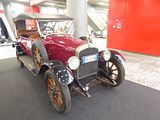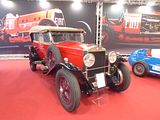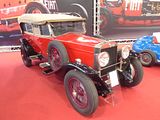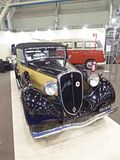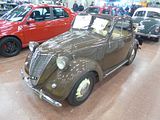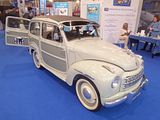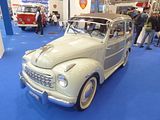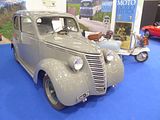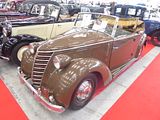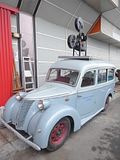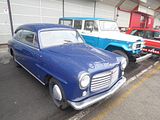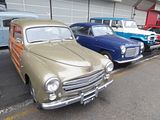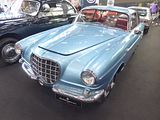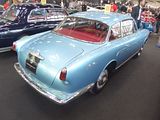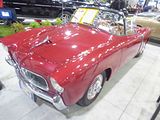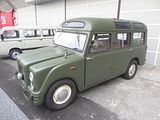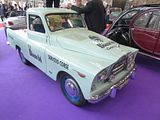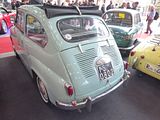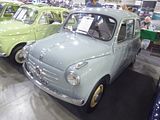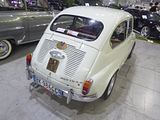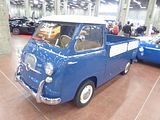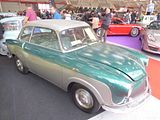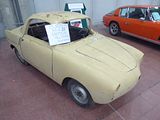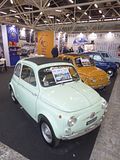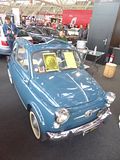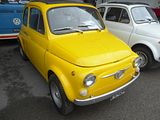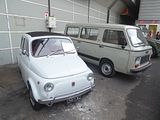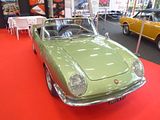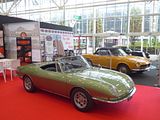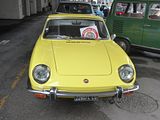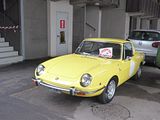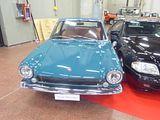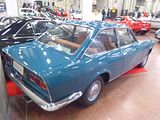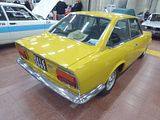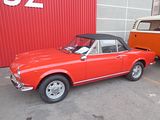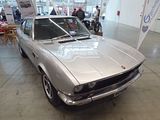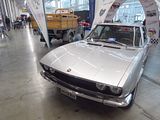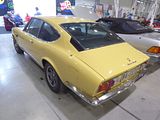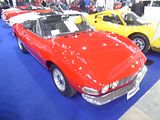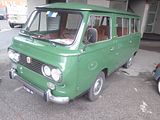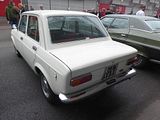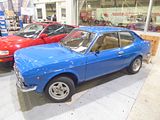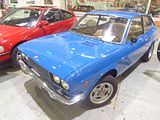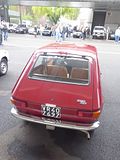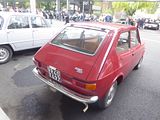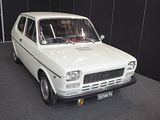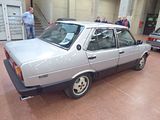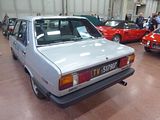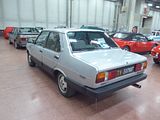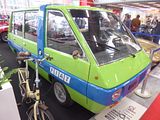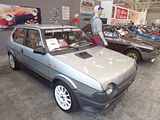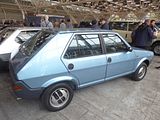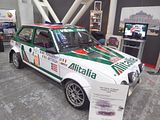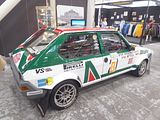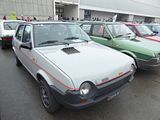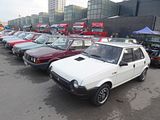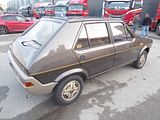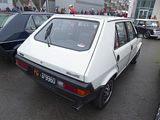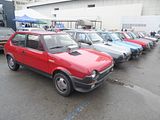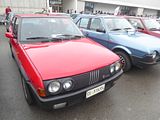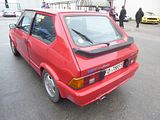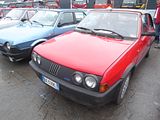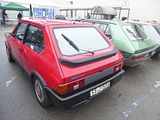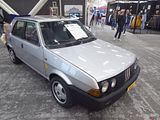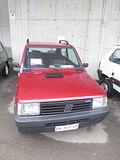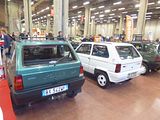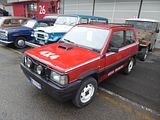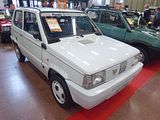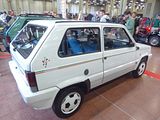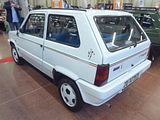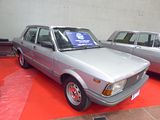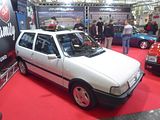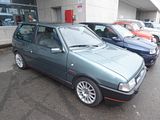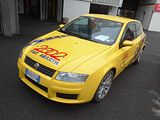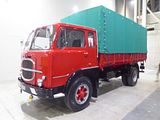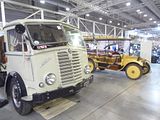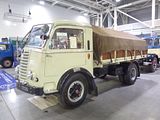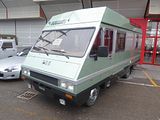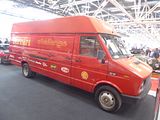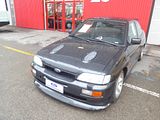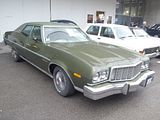The Auto e Moto d’Epoca is not just the largest classic car event in Italy, but also, apparently in Europe. Having attended several of them, in recent years, my feet and my camera can both attest to the fact that it is vast, with several thousand cars and bikes on display. After 39 years when it has held at the Fiera in Padova (Padua), the organisers had to concede that it hard grown too big for the site, and so it was moved to the Bologna Fiera, a larger location, and for many people also that bit easier to get to. The new location was a great success, so it was no surprise that the event returned there for the 2024 edition. And as I enjoyed the event as much as ever, it is also no surprise to anyone who knows me or who follows the sort of events I attend to learn that I inked this one in the diary as soon as the dates were announced.
There was so much to see, and so many photos that this report has to be split into two parts.
Having parked up, I just followed the crowds to exit the parking structure and to head towards the entrance point, and of course when doing so I spotted a few interesting cars, which included a rather nice Alfa 156 and the older 75.
ABARTH
Oldest Abarth here was this spectacular one-off, the A208 A by Boano. The Abarth 208 A Sport epitomizes a poignant emblem of the post-World War II automotive era, characterized by a fervent drive for innovation and style. Born amidst the resumption of civilian automotive production, it emerged as an embodiment of the Stile Transatlantico movement, blending American flamboyance with Italian finesse. Designed by Giovanni Michelotti for Carrozzeria Boano, this sleek spyder exuded allure both on the racetrack and the streets. With its ultra-light chassis and a punchy 1,089 cc four-cylinder engine enhanced by Abarth’s tuning prowess, it promised a thrilling driving experience. Despite its modest size, the 208 A boasted 66 bhp, a testament to Abarth’s dedication to performance. A prominent example of Stile Transatlantico, this Abarth was imported via Tony Pompeo in New York City, a distributor for Abarth and many other Italian marques in New York in the 1950s. The car was sent to the United States on behalf of two brothers of the eponymous Du Pont family. Heirs to their family’s chemical fortune and passionate motor racing enthusiasts, this little Abarth would have no doubt received a lot of attention while in their ownership. After enjoying the Abarth for a few years, the Du Ponts sold the car to a friend of theirs, who later gifted it to Bill Hale. Both Hale and his friend were aircraft mechanics working for the Du Ponts. Hale later recalled that he first saw the Abarth at his friend’s house in Delaware in the early 1970s and was gifted the car in 1973. He took the car home to Long Island, New York, where he drove it locally for the following few summers. Around 1975, Hale’s parents sold their home, where the car was kept, and moved to Maine, and the car would move north with them. Newly married, Hale drove the car with his wife from Long Island up to Maine. A memorable journey, he recalled driving the car from Long Island, across the Brooklyn Bridge to Manhattan, and subsequently north to Maine. Much of the drive took place in a torrential downpour, and needless to say, the Abarth was not equipped to handle such foul weather. Hale and his wife spent half an hour on that journey with the car hiding under a bridge, waiting for the weather to clear before they continued. The Abarth lived in Maine for several years, where his cousin continued to drive it in the summer for a few years, and when Hale bought a house on Long Island, the car returned to New York with him. The car remained largely unchanged during this time. Hale remembers sourcing a correct-specification Abarth rear axle from a friend in Long Island when the Spyder’s needed to be replaced. When he purchased the car, a custom manifold and SU carburettors had already been fitted by the Du Ponts. Upon its return to Long Island, the car was largely hidden from public view until 2007, when it was finally rediscovered by Etceterini collector Elad Shraga. Enamoured with the Abarth, Shraga convinced Hale over the course of the next two years to sell him the car in the summer of 2009. Found to be in exceptionally original condition, it was determined that work needed to be done to the car to rectify some previous minor damage, but its astonishing originality should be preserved. As such, the bodywork was repaired and the mechanical components were restored to bring the 208 A Spyder back to running order. However, nothing else was restored, resulting in an utterly charming and fascinating automobile. Opting to admire the car privately, the Abarth 208 A was shown only once at the Amelia Island Concours d’Elegance in 2013 by Elad Shraga. However, it would surely be welcome at any number of concours events or rallies due to its rarity and historical significance. Sold to the current owner a few years ago, it later received a bare metal repaint in its original colours in its native Italy at a cost of more than €30,000. This work was carried out under the guidance and supervision of Corrado Lopresto and his team in Italy to concours-level conditions. This is an icon of Stile Transatlantico and a significant part of Abarth’s early history
The first Abarth 750 GT appeared in early 1956, and was the first Abarth product to use standard Fiat bodywork, that of the little 600 saloon. Fiat delivered these cars incomplete, to make it easier and more cost effective for Abarth to carry out their performance modifications. Rather than the 633 cc original or Abarth’s own 710 cc model, the engine now displaced 747 cc thanks to a one millimetre wider bore and a stroke increased by four millimetres. Sharper cams, lighter flywheel, a bigger carburettor, and a myriad other traditional tuning tricks were employed; as a result power nearly doubled, up from 21.5 to 40 bhp. Claimed top speed was 80 mph. As well as the “standard” car, a special model was then built with a Zagato body, known as the Fiat Abarth 750 GT Zagato. It was launched at the 1955 Salon di Torino. The original model was also offered in a more luxurious variant for export (called “America”, as it was almost strictly meant for the United States) and a stripped down model with lower, uncovered headlamps and smaller taillights for the domestic Italian market. The “America” also has a different layout around the rear license plate. The all-aluminium bodywork has Zagato’s famous “double-bubble” design and Abarth’s tuned derivazione engine with 43 bhp. Aside from the floorpan, not much of the Fiat 600 remains in use for these cars. It had a top speed of around 90 mph and proved popular. Around 600 were sold. By the time of the appearance of the Abarth Zagato Record Monza 750 Bialbero, the bodywork had been unified into a separate model with a rather large hump on the engine lid, made necessary by the taller twin-cam motor. There were then three distinct models 750 “Double Bubble”, 750 Record Monza and 750 “Sestrieie”, this last having a single cam pushrod engine and the majority built with a steel body and a very small number of Alloy cars, just one of which is known to exist today. The 750 GT Bialbero model appeared at the 1958 Turin Show; along with various alterations to the bodywork, it had the new twin-cam engine with 57 bhp at 7000 rpm. The first series constituted 100 cars, enough to homologate the car for the Gran Turismo competition category. The “Record Monza” was the most successful racing Abarth in the USA under the Franklin D. Roosevelt Jr Racing team, (Abarth cars winning over 700 races worldwide), including both Sebring with the 750cc Bialbero engine and Daytona under 1000cc races in 1959 widely believed to have had the first 982cc Bialbero engine. The Sestriere had upright headlights and two very large air intakes on the engine lid much wider than a double bubble. The Sestriere was believed to be the last model produced for Abarth by Zagato, due to disagreements between Abarth and Zagato, so Abarth developed the 750 GTZ with a twin cam engine and the body evolved by Sibona and Basono into the Bialbero 700 and 1000 models. which were first seen in 1960. They are equally rare these days.
There is a complex history to the rest of the 600-based Abarths, starting with the 850TC, which actually predates the better known 595/695 cars. Officially known as the Fiat-Abarth 850TC Berlina (Turismo Competizione, or “touring competition”), it was introduced towards the end of 1960, using Fiat 600 bodywork with some modifications, most notably a boxlike structure ahead of the front bumper which held the engine’s oil cooler. The rear wings were usually blistered, to accommodate larger wheels. The engine is a four-cylinder model based on a Fiat unit, with 847 cc capacity and 51 hp. Overall length is 3,090 mm (122 in), overall width is 1,400 mm (55 in), height is 1,380 mm (54 in), wheelbase is 2,000 mm (80 in), and its front and rear track are 1,160 mm (46 in). The fuel tank holds 5.9 imperial gallons, and its empty weight was 793 kg (1,748 lb). The 850TC remained in the price lists until 1966. In 1962 the 850TC Nürburgring was introduced, with 55 PS at 6500 rpm. The name was intended to celebrate the class victory of an Abarth 850TC at the 1961 Nürburgring 500 km race. There followed the 850TC/SS with two more horsepower; this was renamed the 850TC Nürburgring Corsa towards the end of the year. Between 1962 and 1971 the 850cc and 1000cc class cars won hundreds of races all over the World and were commonly called “Giant Killers” due to their superior performance over much larger cars, culminating in a famous dispute with SCCA authorities in the USA when Alfred Cosentino (FAZA) was banned from running his 1970 Fiat Abarth Berlina Corsa 1000 TCR “Radiale” engine because his car was faster (mainly in wet conditions) to many V8 Mustangs, AMC AMX’s and Chev Camaro’s etc.The SCCA authorities dictated FAZA and Cosentino be forced to use an early design engine a non “Radiale” engine from 1962 model in his cars but still achieved 51 Victories from 53 races. The most victories in SCCA racing history, thereby cementing the superiority of the Fiat Abarth Berlina Corsa over larger and more powerful cars.
Having concentrated mainly on the modification of Fiat cars, Carlo Abarth began forging links with the French Simca concern in the early 1960s, introducing a series of tuned Simca-Abarth road cars and, in 1962, producing a pretty, 1.3-litre GT coupé similar in style to the existing Fiat-Abarth 1000. Notable as the first car produced with an all-Abarth engine, the 1300GT was based on the newly introduced Simca 1000 whose chassis and suspension it used in modified form. A four-cylinder twin-cam like Abarth’s 1-litre Fiat-based unit, the all-alloy engine differed by employing horizontal, as opposed to down-draught, carburettors, and dry-sump lubrication. The prototype was reported as clocking 142mph on the autostrada, an outstanding performance by a 1,300cc car and one that must have given those racing Alfa Giuliettas cause for concern. Abarth’s next Simca-based model – the 1600GT – arrived in 1963. Though recognisably an evolution of the preceding 1300GT, the newcomer showed the influence of recent aerodynamic developments in the form of an upturned ‘duck tail’ rear end similar to that of Ferrari’s contemporary GTs and sports-racers. Essentially the same as the 1300GT’s, the chassis featured independent suspension and Girling disc brakes all round. The engine’s cast-iron, production-based block was topped by an aluminium-alloy, twin-cam cylinder head featuring two magneto-sparked plugs per cylinder. The gearbox was an all-synchromesh six-speeder. 153bhp and 150mph were claimed. Abarth’s collaboration with Simca ended following the latter’s acquisition by Chrysler in 1965, but before then the relationship’s final flowering had arrived in the form of the potent Abarth-Simca 2000 (Abarth insisted on having their name first for these cars). Constructed around a Simca 1500 block, the latter’s engine came equipped with a pair of the largest Weber carburettors ever made – 58mm-choke DCOs – and at the peak of its development produced a staggering 200+bhp. Independent road tests recorded a top speed of 165mph.
By the late ’60s, noting a dramatic decline in sales of its vehicles, Carlo Abarth decided to focus on the production of sports cars for sale to private entrants. To encourage them with a purchase, he created this car, the 2000 Sport Tipo SE 010. The engine was a four-cylinder 2 litre with two Weber 58 DC03 carburettors that generated 250 hp and gave a maximum speed of 270 km/h. There was a five-speed manual transmission. The chassis frame was of a tubular type made of steel. The front suspensions consisted of oscillating trapezoids, coil springs, stabilizer bars and telescopic hydraulic shock absorbers, while the rear ones had oscillating arms, coil springs, stabilizer bars and telescopic hydraulic shock absorbers. Driven for the first time in the uphill race at Ampus, in France, the 2000 Sport obtained numerous victories and placements, including claiming the first three positions in the 500 km of the Nürburgring in 1968 with Shetty, Ortner and Merzario.
Most Abarths of the 1960s were based on regular Fiat models, and there were some of these on show as well. Smallest of these were those based on the Nuova 500, and there were a couple of them here. For the 595 SS, Abarth increased the engine capacity to 594 cc, just under the limit for the European 600cc racing sedan class. High compression 10:1 pistons were used together with a special camshaft, a specific alloy sump, Abarth valve covers and air filter, propped up engine lid and wheels were fitted and of course the exhaust system was a special in house model. This package together with lowered suspension, flared arches and 10 inch rims amounted to what was known as the Assetto Corsa SS model. These cars have become very rare as many were crashed in competition or simply rotted away due to bad rust protection in the 70s A number of recreations have been built, and these are likely such. So, not original, but still nice and still a lot of fun.
There was one of the Lombardi Grand Prix-based Abarth models here. Although many have now seen them a number of times in the past couple of years, they remain a car that few can identify with any confidence. It was based on the Lombardi Grand Prix, you most have probably never heard of that, either! The Lombardi Grand Prix was a small, rear-engined sports car, based on Fiat 850 underpinnings, developed by the Carrozzeria Francis Lombardi with an in-house design by Giuseppe Rinaldi. It was first shown in March 1968, at the Geneva Motor Show. The design had a Kammback rear and a very low nose with flip-up headlights, and a large single windshield wiper. The headlights were electrically powered. The bodywork was all steel, except the rear panel. The design was originally shown as a prototype based on the front-wheel drive Autobianchi A112, and was adapted by Lombardi for the 850 sedan’s floorpan. At the 1969 Turin Show, a targa version was also shown; called the “Monza”, this open model has a rollover bar. At least two were built but it is unknown whether any were sold. The original Lombardi Grand Prix had the regular 843 cc Fiat 850 engine with 37 PS at 5000 rpm, coupled to a four-speed gearbox. Low drag resistance and weight (630 kg or 1,390 lb) meant that this was supposedly enough for a top speed of 99 mph. Later production models had the 850 Special engine, with 47 PS at 6400 rpm – in a period German test the maximum speed of the more powerful variant was 95.6 mph. Luggage space is limited, with very little space next to the spare wheel up front and with a tiny area behind the seats. In case the electric wind-up mechanism for the headlights should fail, there is also a mechanical lever underneath the bonnet. The single round tail lights are Fiat 850 Coupé units. The front suspension consists of a transverse leaf spring on the bottom and A-arms on top, while the rear received coil sprung semi-trailing arms. The Lombardi Grand Prix was built in two series: early models used the regular, metal engine cover from the Fiat 850 while the Series II has a louvred unit in black metal. The door windows are also different, being of a three-piece design (one on top, two lower pieces of which one could be slid open) while later cars have a more conventional layout with a vent window up front and a single piece which, however, could only be rolled halfway down. A Cypriot casino owner and millionaire had also shown interest in the Lombardi Grand Prix around the time of its introduction. Frixos Demetriou intended to market the car in the United Kingdom and began planning for an order of 1000 cars. After his death in a British Army tank accident in Cyprus, this project came to a sudden halt. Only ten cars were imported into the UK, with the remaining parts languishing in storage in Turin. A few unsold cars were re-exported to Cyprus in 1969 to avoid pending customs bills. The story gets more complex than that. The tiny OTAS company (Officina Trasformazioni Automobili Sportive, or “Sports car conversion shop”) was founded in 1969 and was a collaboration between Francis Lombardi and Franco Giannini – the son of Domenico Giannini of Giannini Automobili – allowing for a more powerful, Giannini-engined Grand Prix model to be marketed abroad. The resulting OTAS Grand Prix has a tuned, 982 cc twin-cam “Tigre” engine. In Italy, this model was sold as the “Giannini 1000 Grand Prix” (beginning in 1969). In a very convoluted operation, Francis Lombardi sold engineless cars to Giannini, while Giannini sold their engines to OTAS for sale outside of Italy. Responding to interest in the important North American market, OTAS also sold the Grand Prix in the United States and in Canada as the “OTAS Grand Prix 820cc”, to give the tiny car its full name. Going on sale in 1970 it was fitted with the same down-sleeved 817 cc version of the inline-four engine as used in federalised Fiat 850s – all to sneak under 50 cubic inches, thereby avoiding the need to carry emissions controls equipment. Sixty-five of these cars were brought to North America, or perhaps as many as a hundred. Fiat 850 chassis numbers were retained for the OTAS 820. Importer John Rich of Glendale, California, also offered tune-up kits directly and Siata International in New Jersey imported nine of the bigger Tigre-engined cars before the strictures of the EPA put a halt to such activities. This was the first car to have US sales curtailed by the EPA. The OTAS was sold until 1971, when the company shut its doors following homologation troubles. The car never sold particularly well, being expensive considering its performance and with a tendency to overheat. Along with other tuners (such as Giannini), Carlo Abarth also had a look at the Grand Prix. Abarth’s version, first seen at the 1968 Paris Motor Show, received a tuned version of the larger 903 cc engine from the recently introduced Fiat 850 Sport Coupé/Sport Spider. The resulting variant has a claimed 52 PS, providing performance more suitable to the sporting bodystyle and name. For better cooling than the original Lombardi and OTAS, Abarth mounted the cooler up front, in the air stream. In 1970 Abarth showed the considerably more powerful “Abarth 1300 Scorpione”, which was to be Abarth’s last independently developed car. Equipped with a version of the Fiat 124s 1.2 litre engine, bored out by 2.5 mm for a total of 1280 cc, this model has 75 PS and only moderately more weight, ranging from 680 to 750 kg (1,500 to 1,650 lb) depending on the source. In a 1970 road test by Auto, Motor und Sport, the Scorpione reached 109.1 mph, close to the claimed 112 mph. There is also mention of a 982 cc Abarth 1000 OT-engined version of the Scorpione. The Scorpione had a special Abarth-made bell housing, to allow matching the 124 engine to the four-speed 850 gearbox. After Abarth was taken over by Fiat in 1971, the Scorpione was quickly cancelled.
This is a Fiat Abarth 033 Formula 2000 racing car, which was developed in the late 1970s. The car was designed to be used in a racing series established to develop young drivers, similar to the British Formula Ford 2000 series. It featured a 2.0-litre, four-cylinder engine with double overhead camshafts, producing around 132 horsepower, and a lightweight chassis. Around 150 units of the racing car were produced.
There were a number of modern Abarths here, most of them from the 500 range, which has been on sale now since the end of 2008, following a launch at the Paris Show that year. Since that time there have been a number of detailed changes to the standard cars and a lot of limited editions. Those who really know the marque can spot most of them, but some are so subtle that unless there is a badge you can see, you will not be quite sure which version you are looking at. It used to be relatively easy, when the model was first launched, as there was only one version as shipped ex works called the 500. It had a 135 bhp 1.4 litre turbo-charged engine coupled to a five speed manual gearbox, with 16″ alloys as standard, and the option of 17″ wheels, and a colour palette comprising of two whites (BossaNova White, the standard colour, or the pearlescent Funk White), Red (Pasadoble), Pale Grey (Campovolo) or Black. If you wanted more power – 160 bhp – then you could order an Esseesse kit, which came in a large wooden crate, containing new wheels, springs, an ECU upgrade, the Monza exhaust system and badging. It was dealer fitted and could be applied at any time within the first 12 months or 10,000 miles from registration. Needless to say, it proved popular. As were many of the optional extras, with stickers for the sides, a large scorpion for the bonnet and even a chequered pattern for the roof among the personalisation options offered
The first of the special production models was actually the 695 Tributo Ferrari and there was one example of the model at the event. Most of these cars are tucked away in collections, never being used, so it was good to see this one. You got more power than was available in the standard cars at the time, with the engine uprated to 180 bhp, thanks to a different Garrett turbocharger. The spec included a MTA (Manual Transmission Automated) electromechanical transmission with paddle shifter, unique to this version 17 inch alloy wheels with performance tyres, Brembo multi-section discs with fixed 4-piston calipers, “Record Monza” variable back-pressure “dual mode” exhaust, Magneti Marelli Automotive Lighting xenon headlights, “Abarth Corsa by Sabelt” seats in black leather upholstery with carbon fibre shell and seat base, black leather steering wheel with red leather inserts and a tricolour hub, Jaeger instrument panel, non-slip aluminium foot wells, Scorpion racing pedals, special kick plates and a plate bearing the vehicle series number. The Tributo Ferrari was unveiled at the 2009 Frankfurt Motor Show, with deliveries starting in 2010. Four colours were offered: grey, Abu Dhabi Blue, Scuderia Red and finally Yellow like Bailey’s car. Of these the red and yellow cars were more numerous, but the car remained rare as it was fearsomely expensive. Just how expensive depended on the dealer, as in a move that only the Italians could make, they were all first registered in Italy and so technically were used cars by the time these right hand drive machines arrived on UK soil, which mean that the dealers could charge what they wanted. Most aimed somewhere between £32 and £36,000, a lot for a car of this size. Nevertheless, they all sold, though many ended up on another boat, off to right hand drive Asian markets, which is why they are a rare sight these days.
At the 2012 Geneva Show, Abarth showed the 695C Edizione Maserati, a limited production version of the Abarth 500C convertible with the 1.4 Turbo T-Jet 16v engine rated at 180 hp, a 5-speed electrically operated manual Abarth Competizione gearbox with steering wheel controls, Maserati “Neptune” 17″ alloy wheels with performance tyres, Brembo 305 mm brake discs with fixed four-piston caliper and special shock absorbers, Record Modena variable back-pressure “dual mode” exhaust, Pontevecchio Bordeaux body colour, Xenon headlights with dipped and driving light functions, sand beige Poltrona Frau leather seats with containment strips featuring single-layer padding and the pista grey contrasting electro-welding, black leather steering wheel, aluminium pedal unit and sill plate, carbon fibre kick plate, boosted hi-fi audio system. Production was limited to 499 units,
Seen by most as the ultimate model, there was the 695 Biposto. First shown at the 2014 Geneva Show, this 2 seater (that’s what Biposto means in Italian) is nothing other than a road legal version of the 695 Assetto Corse Racing car, a vehicle which has its own race series in Europe. Although the car is road legal, it was envisaged that the majority of people who buy one of these cars will use it on the track and quite frequently. So it was conceived accordingly. That means upgrades to all the important bits – engine, brakes, suspension, gearbox – and some fairly drastic measures to save weight which resulted in a car which generates 190 bhp and 199 lb/ft or 250 Nm of torque with a kerb weight of just 997kg. That’s enough to give a 0 – 60 time that is under 6 seconds, and a top speed of 143 mph. Those are supercar figures produced by a city car. There’s more to it than that, though, as the changes that go to make a Biposto are extensive, and they have been well thought through, so this is a long-way from being a hastily conceived or tuned up special. Ignoring the limited edition cars which arrived during 2015, the “regular” Biposto is only offered in Matt Performance Grey paint, and the car is visually distinctive, with a new front bumper, rear diffuser, wider arches, new skirts and bigger roof spoiler. Although the engine is still the same 1.4 T-jet that features in the lesser 500 and 595 cars, it has been reworked here, with a new Garrett turbocharger, larger intercooler, altered fuel rail and an Akrapovic exhaust system. Buyers can choose between the standard five speed gearbox or an optional race-bred dog-ring unit mated to a mechanical limited slip diff. The standard car’s MacPherson strut and torsion beam suspension has been reworked, too, with altered springs, wider tracks adjustable ride height and dampers with more resilient bushings, using Extreme Shox technology shock absorbers. The brakes are upgraded in line with the extra power, featuring 305mm Brembo discs and four pot calipers up front and 240mm discs with single pot calipers at the rear. The wheels are lightened 18″ OZ and attached via a titanium hub, shod with bespoke 215/35 Goodyear tyres. In the interest of weight saving, a number of standard trim items are removed, including the regular door trims, air conditioning, the rear seats and some of the sound deadening material. Even the standard air vents have been changed so they are covered by a simple mesh. In their place is plenty of polished carbon fibre, a titanium strut brace, racing seats and harness, as well as special trim features such as new pedals, tread plates and a race inspired digital display on the dash where the radio usually sits. Although the Matt Performance Grey car is probably the one you think of when someone says “Biposto”, there were other versions, with a very rare red being a car that is only see occasionally and the Record Edition being the version that was here. There were just 133 of these made, all painted in Modena Yellow, at the time an exclusive Biposto colour.
What is known as the Series 4 version of the familiar 595 reached the markets in the middle of 2016. After rumours had circulated all winter following the launch of the facelifted Fiat 500 last year, Abarth finally unveiled the Series 4 at the end of May 2016. Initially, we were told that the cars would not be available in the UK until September, but that came forward somewhat, with dealers all receiving demo cars in June, and the first customers taking delivery in July. Three regular production versions of both the closed car and the open-topped C were initially available, all badged 595, and called Custom, Turismo and Competizione, as before, though numerous limited edition models have since appeared and in most case disappeared. The most significant changes with the Series 4 are visual, with a couple of new colours, including the much asked for Modena Yellow and a different red, called Abarth Red, which replaces both the non-metallic Officina and – slightly surprisingly – the tri-coat pearlescent Cordolo Red. as well as styling changes front and rear. The jury is still out on these, with many, me included, remaining to be convinced. At the front, the new air intake does apparently allow around 15 – 20 % more air in and out, which will be welcome, as these cars do generate quite a lot of heat under the bonnet. Competizione models for the UK retain the old style headlights, as they have Xenon lights as standard, whereas the Custom and Turismo cars have reshaped units. At the back, there are new light clusters and a new rear bumper and diffuser. Inside, the most notable change is the replacement of the Blue & Me system with a more modern uConnect Audio set up, which brings a new colour screen to the dash. Mechanically, there is an additional 5 bhp on the Custom (now 145) and Turismo (now 165 bhp) and the option of a Limited Slip Diff for the Competizione, which is likely to prove a popular option. Details of the interior trim have changed, with a filled-in glovebox like the US market cars have always had, and electric windows switches that are like the US ones, as well as a part Alcantara trim to the steering wheel in Competizione cars.
A limited edition model, the 695 XSR was created in recognition of the fact that for the third year running, in 2017 Abarth was to be the Official Sponsor and Official Car Supplier of the Yamaha Factory Racing Team, competing in the 2017 FIM MotoGP World Championship. In the wake of the Abarth 595 Yamaha Factory Racing and the 695 biposto Yamaha Factory Racing Edition, the 695 XSR Yamaha Limited Edition special series is available exclusively with a Pista Grey livery: only 695 sedans and 695 convertibles will be made. The new car was created to celebrate the Yamaha XSR900 Abarth, which is the first exclusive motorcycle to spring from the collaboration between the two brands and which sports the same grey livery with red trim as the 695 XSR, as well as sharing many of its features. The special series makes extensive use of carbon fibre to demonstrate its affinity with the front fairing, front mudguard and saddle cover of the two-wheel Yamaha. The Abarth 695 XSR and the Yamaha XSR900 Abarth also share Akrapovič ultralight exhaust developed in the racing world to boost the personality, sound and performance of both vehicles. On the Abarth car, the carbon fibre tailpipes enhance the looks and technology of the exhaust system. The XSR logo on the tailgate distinguishes the Abarth 695 XSR, while an aluminium badge identifies the sequential number of 695 units for each body type. Other carbon fibre details, in addition to the mirror caps and Akrapovič tailpipes, are available as optional equipment, such as dashboard fascia, pedal covers, gear knob and kick plate. The car uses the 1.4 T-Jet engine delivering 165 bhp. Equipment on this special series includes Koni rear suspension and Eibach springs, 17” Supersport alloy rims with Matt Black finish, Satin Chrome accents on handles and badge supports, red details on bumpers and mirrors, red brake callipers and a braking system with perforated discs. This version can be customised even further using the tuning kit to increase the power to 180 HP, improve handling by fitting a Koni front suspension with FSD (Frequency Selective Damping) valve and make braking even prompter with 305x28mm perforated and self-ventilating Brembo floating front discs with high-performance Ferodo HP 1000/1 front brake pads. It also features the new UconnectTM 7″ HD LIVE system integrated with Apple CarPlay allows iPhone users to access contents such as Apple Maps, Messages, telephone calls, Apple Music, also with Siri voice assistance.
ALFA ROMEO
In the mid-1920s, Alfa’s RL was considered too large and heavy, so a new development began. The 2-litre formula that had led to Alfa Romeo winning the Automobile World Championship in 1925, changed to 1.5-litre for the 1926 season. The 6C 1500 was introduced in 1925 at the Milan Motor Show and production started in 1927, with the P2 Grand Prix car as starting point. Engine capacity was now 1487 cc, against the P2’s 1987 cc, while supercharging was dropped. The first versions were bodied by James Young and Touring. In 1928, a 6C Sport was released, with a dual overhead camshafts engine. Its sport version won many races, including the 1928 Mille Miglia. Total production was 3000 (200 with DOHC engine). Ten copies of a supercharged (compressore) Super Sport variant were also made. The more powerful 6C 1750 was introduced in 1929 in Rome. The car had a top speed of 95 mph, a chassis designed to flex and undulate over wavy surfaces, as well as sensitive geared-up steering. It was produced in six series between 1929 and 1933. The base model had a single overhead cam; Super Sport and Gran Sport versions had double overhead cam engines. Again, a supercharger was available. Most of the cars were sold as rolling chassis and bodied by coachbuilders such as Zagato, and Touring. Additionally, there were 3 examples built with James Young bodywork. In 1929, the 6C 1750 won every major racing event it was entered, including the Grands Prix of Belgium, Spain, Tunis and Monza, as well as the Mille Miglia was won with Giuseppe Campari and Giulio Ramponi, the Brooklands Double Twelve and the Ulster TT was won also, in 1930 it won again the Mille Miglia and Spa 24 Hours. Total production was 2635.
Final evolution of the Alfa Romeo 6C was the 2500 which was announced in 1938. The 2500 had an enlarged engine compared to the predecessor models, with this Vittorio Jano designed double overhead cam engine available with either one or three Weber carburettors. The triple carburettor version was used in the top of line SS (Super Sport) version. The 2443 cc engine was mounted in a steel ladder frame chassis, which was offered with three wheelbase lengths: 3,250 mm (128.0 in) on the Turismo, 3,000 mm (118.1 in) on the Sport and 2,700 mm (106.3 in) on the Super Sport. Although it was clear that World War II was coming and car development would be stopped, Alfa did continue to produce a few hundred 6C 2500s were built from 1940 to 1945 before resuming production, Postwar. The first new Alfa in his period was the 1946 6C 2500 Freccia d’Oro (Golden Arrow), of which 680 were built through 1951, with bodies by Alfa. Various coachbuilders made their own versions of the 2500, with most of the bodies made by Touring of Milan, though this one has a Rigoli Robini Cabriolet style which is rather attractive. The car was sold to wealthy customers like King Farouk, Alì Khan, Rita Hayworth, Tyrone Power, and Prince Rainier. One was also featured in The Godfather in 1972. The 6C 2500 was one of the most expensive cars available at the time. The last 6C was produced in 1952, when it was replaced by the 1900.
Designed by Orazio Satta, the 1900 was Alfa Romeo’s first car built entirely on a production line. It was also Alfa’s first production car without a separate chassis and the first Alfa offered with left-hand drive. Launched at the 1950 Paris Motor Show, the 1900 was offered in two-door or four-door models, with a new 1,884 cc 90 bhp 4-cylinder twin cam engine. It was spacious and simple, yet quick and sporty. The slogan Alfa used when selling it was “The family car that wins races”, not-so-subtly alluding to the marque’s success in the Targa Florio, Stella Alpina, and other competitions. In 1951 the short wheelbase 1900C (C for Corto, the Italian for short) version was introduced. It had a wheelbase of 2,500 mm In the same year the 1900TI with a more powerful 100 bhp engine was introduced, it had bigger valves, a higher compression ratio and it was equipped with a double carburetor. Two years later the 1900 Super and 1900 TI Super (also 1900 Super Sprint) with 1975 cc engine were introduced. The TI Super had two double carburettors and 115 bhp. The transmission was a 4-speed manual on basic versions and 5-speed manual in Super Sprint version, the brakes were drums. The 1900 had independent front suspension (double wishbones, coil springs and hydraulic telescopic shock absorbers) and live rear axle. Production at the company’s Milan plant continued until 1959: a total of 21,304 were built, including 17,390 of the saloons.
At the end of the 1951 season Alfa Romeo announced the company’s official withdrawal from motorsport. The racing department was not shut down, but instead used to test experimental chassis and engines. Due to their advanced nature these projects could also easily be used for racing, which was exactly the intention of the first new experimental Alfa Romeo unveiled in 1952. Developed jointly by the Milan based manufacturer and coach-builder Touring, this C52 went into history as one of the most famous designs of the 1950s. Except for the suspension, the C52 was a completely new design. Derived from the 1900 road car the front wishbones and rear live axle were bolted on a state of the art tubular spaceframe chassis. It offered superior rigidity to the previously used (tubular) ladder frames, but not at the expense of additional weight. A slightly bored out 1900 engine with a new aluminium block that replaced the cast-iron of the road car’s unit. Equipped with two twin-choke Weber Carburettors, the 2 litre power-plant developed an impressive 158 bhp. The designers at Touring focussed on creating an aerodynamic body. They did not look at the frontal area alone, but also tried to cut the influence of side winds. The result was a very unusual round design with large overhangs on either side of the cockpit and a full under-body In the midst of the 1950s UFO craze the car was quickly nick named ‘Disco Volante’ or flying saucer. It proved to be a very efficient design, enabling top speeds of 220 km/h, but at these speeds the car suffered from pretty serious lift at both ends. After a successful first test at Monza, the Disco Volante was entered at Le Mans for Juan Manual Fangio, Froilan Gonzales and Franco Cortese to drive. For reasons unknown the Alfa Romeo team did not show up and the car was never raced. Two more cars were built with a similar specification in 1953; a Coupe and another Spider. Whereas the Coupe followed the lines of the original Spider, the third example had a ‘Narrow-Hipped’ bodywork designed for tight hill climbs for which the Disco Volante’s wide body was not ideally suited. None of the three Disco Volantes were ever raced, but did inspire the design of a series of six cylinder racing cars that debuted in 1953. Although some consider these to be Disco Volantes as well, the absence of the spaceframe chassis really does not justify that. Clothed by Touring with Coupe or Spider bodies these 6C 3000 CMs raced with considerable success. The new chassis was not abandoned and was first used again for the Sportiva concepts of 1954. The first real application of the spaceframe was in the TZ racers of the 1960s. Both the original Spider and the Coupe are currently owned by the elaborate Alfa Romeo Museo Storico based in Arese, Italy. The more conventional Narrow Hipped Spider has been owned for many years by the Schlumpf brothers in Mulhouse France. A number of replicas have been built.
Following the 1900 family, Alfa’s next new model range would be cheaper and aimed at capturing some of the market from middle class buyers. Known as Giulietta, the 750 and later 101 Series were a series of family-sized cars made from 1954 to 1965, and Alfa Romeo’s first, successful, foray into the 1.3-litre class. The first to be introduced was the Giulietta Sprint 2+2 coupé which was premiered at the 1954 Turin Motor Show. Designed by Franco Scaglione at Bertone, it was produced at the coachbuilder’s Grugliasco plant, near Turin. A year later, at the Turin Motor Show in April 1955, the Sprint was joined by the 4-door saloon Berlina. In mid 1955, the open two-seat Giulietta Spider, featuring convertible bodywork by Pininfarina arrived. The Giulietta used unibody construction and a front-engine, rear-wheel-drive layout. Front suspension was by control arms, with coaxial coil springs and hydraulic dampers. At the rear there was a solid axle on coil springs and hydraulic dampers. The axle was located by a longitudinal link on each side, and by a wishbone-shaped arm linking the top of the aluminium differential housing to the chassis. All Giuliettas (save for the last SZ examples) had hydraulic drum brakes on all four corners. The Giulietta used an Alfa Romeo Twin Cam straight-four of 1290 cc, with an aluminium alloy engine block and cast iron inserted sleeves. Bore and stroke measured 74.0 mm and 75.0 mm. The aluminium alloy cylinder head was of a crossflow design and featured hemispherical combustion chambers. The double overhead camshafts were driven by two timing chains, and acted on two valves per cylinder, angled 80°. In 1957 a more powerful Berlina version, called Giulietta T.I. (Turismo Internazionale) was presented with minor cosmetic changes to the bonnet, the dial lights and rear lamps. Carrozzeria Colli also made the Giulietta station wagon variant called Giulietta Promiscua. Ninety-one examples of this version were built. Carrozzeria Boneschi also made a few station wagon examples called Weekendina. A new version of the Giulietta Berlina debuted at the Frankfurt Motor Show in 1959. Mechanical changes were limited to shifting the fuel pump from the cylinder head to a lower position below the distributor, and moving the previously exposed fuel filler cap from the tail to the right rear wing, under a flap. The bodywork showed a revised front end, with more rounded wings, recessed head lights, and new grilles with chrome frames and two horizontal bars. The rear also showed changes, with new larger tail lights on vestigial fins, which replaced the earlier rounded rear wings. The interior was much more organised and upholstered in new cloth material; the redesigned dashboard included a strip speedometer flanked by two round bezels, that on the T.I. housed a tachometer and oil and water temperature gauges. The T.I. also received a front side repeater mounted in a small spear, unlike the Normale which kept the earlier small round lamp with no decorations. During 1959 the type designation for all models was changed from 750 and 753 to 101. In February 1961 the 100,001st Giulietta rolled out of the Portello factory, with a celebration sponsored by Italian actress Giulietta Masina. In Autumn 1961 the Giulietta was updated a second time. Both Normale and T.I. had revised engines and new exhaust systems; output rose to 61 bhp and 73 bhp. With this new engine the car could reach a speed of almost 100mph. At the front of the car square mesh side grilles were now pieced together with the centre shield, and at the rear there were larger tail lights. Inside the T.I. had individual instead of bench seats, with storage nets on the seatbacks. June 1962 saw the introduction of the Alfa Romeo Giulia, which would eventually replace the Giulietta. As until 1964 the Giulia only had a larger 1.6-litre engine, production of the standard Berlina ended with 1963, whilst the T.I. continued for a full year more. A last T.I. was completed in 1965. The Giulietta sport models had a different fate: Sprint, Sprint Speciale and Spider were fitted with the new 1.6-litre engine, received some updates and continued to be sold under the Giulia name until they were replaced by all-new Giulia-based models during 1965. These days., the Berlina is the model you see the least often. A few of the model are used in historic racing where the car takes on the might of those with far larger engines. A total of 177,690 Giuliettas were made, the great majority in Berlina saloon, Sprint coupé or Spider roadster body styles
The SZ (for Sprint Zagato, officially the Tipo 101.26, or “Type 101.26”) was an aluminium-bodied 2-seater berlinetta, built by Zagato for competition use on the chassis and mechanicals of the Sprint Speciale. A crashed Sprint Veloce was rebodied by Zagato in late 1956, and was immediately successful in competition. Zagato ended up building 18 rebodied Veloces, called the SVZ and the version gave rise to a full production version. The SVZ was about 120 kg (260 lb) lighter than the Coupé on which it was based, and had the highest tuned, 116 hp, version of the Giulietta engine. A production competition version of the Giulietta, with lightened bodywork designed by Franco Scaglione for Bertone was then premiered at the 1960 Geneve Salon. Handbuilt by Zagato, entirely in aluminium and with plexiglass windows, the lightened Sprint Zagato (SZ) was light, fast, and expensive. Two hundred seventeen were built, the original design with a rounded rear and with the last thirty (some say 46) receiving a longer kamm-style rear end as well as disc brakes up front. The original design is called the “Coda Tonda” (round tail), while the Kamm-design is referred to as the “Coda Tronca” (truncated tail). The Coda Tronca is sometimes also referred to as the “SZ2”. The first examples were built in December 1959, and production continued into 1962. Zagato also rebodied a few existing cars with this bodywork, leading to discrepancies in the production numbers. The SZ was very successful in racing, on a national level as well as internationally. The SZ helped Alfa Romeo secure a victory in the 1.3 litre class of the International Championship for GT Manufacturers in 1962 and 1963. Michel Nicol won the Tour de Corse in 1957. On the rare occasions that these cars come up for sale, the price is massive compared to other Giulietta family models
The 2600, or 106 Series, were an evolution of the model first seen in 1958 as a replacement for the 1900, and called the 2000 and known internally as the 102 Series. This was the time when Alfa was still in transition from being a maker of exclusive coachbuilt and racing cars to one that offered volume production models. The 102 Series were never likely to be big sellers, in a world that was still recovering economically from the ravages of the Second World War, but the range was an important flagship, nonetheless. The 2000 models ran for 4 years, from 1958 to 1962, at which point they were updated, taking on the name of 106 Series, with minor styling changes being accompanied by a larger 2600cc engine under the bonnet. As with the 2000 models, the new 2600 cars were sold in Berlina (Saloon), Sprint (Coupe) and Spider (Convertible) versions, along with a dramatically styled SZ Coupe from Italian styling house Zagato and a rebodied Berlina from OSI, all of them with an inline twin overhead cam six cylinder engine of 2.6 litres, the last Alfas to offer this configuration. Just 6999 of the Sprint models were made and 2255 Spiders, very few of which were sold new in the UK where they were exceedingly expensive thanks to the dreaded Import Duty which made them much more costly than an E Type. Many of the parts were unique to these cars, so owning one now is far harder than the more plentiful 4 cylinder Alfas of the era. Whilst the rather square styling of the Berlina, which won it relatively few friends when new and not a lot more in recent times means that there are few of these versions to be seen, the Sprint and Spider models do appear from time to time, and market interest in the cars is now starting to accelerate, with values rise accordingly. Seen here were the regular Coupe and Convertible.
Many people will be unaware that Alfa Romeo have produced Vans in their past. The first the Autotutto was launched back in 1954, and it was updated three times in the following 11 years before being replaced with by the Giulia engined Alfa Romeo F12 and A12 vans in 1967. The front of the vehicle was updated with wider chrome and mesh grille, and the 1,290 cc Alfa Romeo Twin Cam engine was updated now having 52 hp. The front-engined van had four-speed gearbox and front-wheel drive. In 1973 an inline-four 1,760 cc Perkins diesel was also offered, with 50 hp. This same engine was also available in the Giulia Berlina from 1976. The van had top speed of around 115 km/h (71 mph). The front brakes were discs and rear ones drums. Abandoning the use of a model name, “F” denoted a furgone, or van, “A” depicted an autocarro or light truck, while “12” indicated the carrying capacity of 12 quintali (1 quintale = 100 kg (220 lb)). Motor Ibérica took over of FADISA in 1967, this company made Ebro trucks and these FADISA trucks were merged to this same division. As a result, the Alfa Romeo F12 was named as Ebro F-100 in Spain and after the facelift it was sold as the F-108. In 1987 Nissan Motors took control of Motor Ibérica and Ebro trucks were renamed “Nissan Trade”. They continued to be made until the beginning of the 2000s at the Ávila plant in Spain. Between 1967 and 1971 a “light” A11 or F11 version was also available. This has a lighter payload and a lower horsepower rating. All Alfa Romeo vans were facelifted in 1977 with a new black plastic radiator grille, and chrome badging was replaced with black adhesive stickers. Production stopped in 1983. The total production of all A11, A12, F11, and F12 was around 17,300 units.
The Alfa Romeo 450 is a truck manufactured by Alfa Romeo from 1947 to 1959. Its upgraded version was called Alfa Romeo 455. The Alfa Romeo 450 was the successor of Alfa Romeo 430. There were several differences between the two models; the most important difference was the engine, with increased power. The 80 hp of the engine mounted on the 430 ran it to 90 hp. The cockpit was enlarged, and the grille was now marked by five horizontal bars, which replaced three in the 430. In 1959 the Alfa Romeo 450 was updated, and the new truck was renamed Alfa Romeo 455, which was produced until the early sixties. It was also available in all-wheel drive and during the years when it was sold, the bodies, which were based on the chassis of the 450/455, were the subject of aftermarketing.
First of the all-new Giulia models to appear was the Berlina, launched in 1962. The styling was quite straight forward, but great attention was paid to detail. The engine bay, cabin and boot were all square shaped. But the grille, the rooflines and details on the bonnet and boot made for an integrated design from bumper to bumper. Thanks to Alfa Romeo using a wind tunnel during its development, the Giulia was very aerodynamic with a drag coefficient of Cd=0.34, which was particularly low for a saloon of the era and not a bad figure even for cars of today. Couple that with the fact that Alfa Romeo was one of the first manufacturers to put a powerful engine in a light-weight car (it weighed about 1,000 kilograms) and thanks to an array of light alloy twin overhead camshaft four-cylinder engine, similar to that of the earlier Giulietta models range, the car had a lively performance which bettered that of many sports cars of the day. The Tipo 105.14 was the first model, with a 1,570 cc Twin Cam engine with single down-draft carburettor generating 91 hp at 6500 rpm. The “TI” nomenclature referred to a class of Italian saloon car racing known as “Turismo Internazionale”, and had previously been applied to higher-performance versions of the 1900 and Giulietta saloons in the 1950s. However, for the Giulia saloon, the Ti was at first the only version available, and later, with the introduction of the TI Super and Super, the TI became the base version for the 1,600 cc engine class. The steering column gearchange (the only one in the Giulia range) was replaced with a floor change for 1964 (Tipo 105.08). Right hand drive cars, available from 1964, only ever had a floor change (Tipo 105.09). Brakes were by drums all around at first. Discs were introduced later, first at the front, and later all around. A brake servo was not fitted at first, but was introduced in later cars. The steering wheel featured the only horn ring ever in the Giulia range. The dashboard with a strip speedo is a notable feature, as is the steering wheel with a horn ring. The Giulia TI was phased out in 1968 and re-introduced as the austerity model 1600 S. Tipo 105.16 was a special racing model introduced in 1963. Quadrifoglio Verde stickers on the front wings were a distinguishing feature. Only 501 were made for homologation and today it is very rare and desirable. The 1,570 cc engine was fitted with two double-choke horizontal Weber 45DCOE carburettors for 110 hp at 6500 rpm. The body was lightened and a floor gearchange was fitted as standard, as were alloy wheels of very similar appearance to the standard steel ones of the TI. The TI’s instrument cluster with its strip speedometer was replaced with a three-instrument binnacle comprising speedometer, tachometer and a multi-gauge instrument (fuel, water temperature, oil temperature and pressure) – these instruments were similar to those fitted to the contemporary Giulia Sprint and Sprint Speciale coupes and Spider convertibles. The steering wheel was a three-spoke item with centre hornpush, also similar to that of the more sporting models. Braking was by discs all around, although the first cars used drums and early disc models lacked a servo which was introduced later. The police cars seen in The Italian Job were of this type. Tipo 105.06 was an austerity model made from 1964 to 1970 with a 1,290 cc single-carburettor engine for 77 hp at 6000 rpm. Four-speed gearbox with floor change fitted as standard (the 1300 was the only Giulia model not fitted with a five-speed gearbox). Though the engine was given a 105 series type number, it was basically the engine from the 101 series Giulietta Ti. This model appears not to have been exported to many markets outside Italy, if at all. Braking was by discs all around, without a servo at first, later with a servo. Tipo 105.26 was introduced in 1965. It transferred the technology from the racing TI Super to a road car, to make the most successful Giulia saloon. 1,570 cc engine with two double-choke Weber 40DCOE carburettors for a milder, but torquier tune than the TI Super – 97 hp at 5500 rpm. There was a new dashboard with two large round instruments (speedo and tacho) and clock, a sportier steering wheel with three aluminium spokes and centre horn push, similar to that of the Ti Super, later changed for one with the horn pushes in the spokes. All-around disc brakes with servo were fitted as standard from the outset. The serpent crest of the Sforza family appears in a badge on the C-pillar and is a distinguishing feature of the Super. For 1968, there was a suspension update, including revised geometry and a rear anti-roll bar. The wheels were changed in size from 5J x 15 to 5J x 14, and tyres from 155/15 to 165/14. For 1970, updates included dual-circuit brakes, centre-mounted handbrake lever to replace under-dash “umbrella handle”, larger external doorhandles, and top-hinged pedals (the latter in left hand drive models only; right hand drive continued with bottom-hinged pedals to the end of production). In 1972, Tipo 105.26 was rationalised into the Giulia 1.3 – Giulia 1.6 range. Tipo 105.39 built from 1965 to 1972. Right hand drive model replaced in 1970 by the 1300 Super. 1,290 cc engine with single down-draft carburettor for 81 hp at 6000 rpm. Unlike the re-deployed 101-series Giulietta engine of the austerity-model 1300, the 1300 ti motor was a 105 series engine, basically that of the sportier GT1300 Junior coupe with different camshaft timing (but the same camshafts) and induction system. Five-speed gearbox. Three-spoke bakelite steering wheel with plastic horn push covering the centre and spokes. Dashboard initially with strip speedo like that of the TI. For 1968, updates included a dashboard based on that of the Super, but with a simpler instrument binnacle, still featuring two large round instruments (speedo and tacho) and a separate fuel gauge, and the same suspension, wheel and tire updates applied to the Giulia Super in the same year. For 1970, updates included dual-circuit brakes, centre handbrake, larger external doorhandles and top-hinged pedals (on left hand drive cars only), again as applied to the Super for that year. Tipo 105.85 was basically a Giulia TI re-introduced in 1968 as a lower-level model to come between the 1300 and 1300 ti on one hand, and the Super on the other. It had a re-interpretation of the 1,570 cc single-carburettor engine for 94 hp at 5500 rpm and similar trim to the 1300 ti. Replaced in 1970 by the 1300 Super which offered similar performance in a lower tax bracket. The last cars from 1970 featured the top-hinged pedals, centre handbrake and dual-circuit brakes as for the Super and 1300 ti. Tipo 115.09 was introduced in 1970. It was basically a 1300 ti fitted with the engine from the GT 1300 Junior coupe that featured two double-choke horizontal carburettors; the engine actually had the GT 1300 Junior type number. This model was rationalised into the Giulia Super 1.3 – Giulia Super 1.6 range in 1972. In 1972 a rationalisation of the Giulia range saw the Super 1300 (Tipo 115.09) and the Super (Tipo 105.26) re-released as the Super 1.3 and Super 1.6. The two models featured the same equipment, interior and exterior trim, differing only in engine size and final drive ratio. The 1300 ti was dropped. A small Alfa Romeo badge on the C-pillar is a distinguishing feature, as are hubcaps with exposed wheel nuts. In December 1972 Alfa-Romeo South Africa released the 1600 Rallye. This locally developed more powerful 1600 cc version of the 1300 Super used the 1300’s single-headlight body shell. The car was largely ready for competition and was only planned to be built in limited numbers, and was fitted with racing-style rear-view mirrors, rally lamps, fully adjustable seats, and a limited-slip differential. Claimed power was 125 hp. The Giulia Super range was re-released in 1974 as the Nuova Super range, including the Giulia Nuova Super 1300 and 1600 This featured a new black plastic front grille and a flat boot lid without the characteristic centre spine. Otherwise the cars differed little from their Giulia Super predecessors and bore the same Tipo numbers with an S suffix. A Nuova Super fitted with a Perkins 1,760 cc diesel with 54 hp at 4000 rpm, was the firm’s first attempt at diesel power. The same Perkins diesel was used also in Alfa Romeo F12 van. The diesel version was slow, 138 km/h (86 mph), and the engine somehow unsuitable for a sport sedan so it was not big seller, only around 6500 examples were made in 1976 and the car was not sold in the UK. Production of the Giulia ceased in 1977. There are relatively few of these cars in the UK, and many of these are left hand drive models which have been re-imported relatively recently, or have been converted for historic racing, so it was good to see a nice road-going model here.
There’s a complex history to this much-loved classic. The first car was called the Alfa Romeo Giulia Sprint GT, and was revealed at a press event held at the then newly opened Arese plant on 9 September 1963, and displayed later the same month at the Frankfurt Motor Show. In its original form the Bertone body is known as scalino (step) or “step front”, because of the leading edge of the engine compartment lid which sat 1/4 an inch above the nose of the car. The Giulia Sprint GT can be distinguished from the later models by a number of features including: Exterior badging: Alfa Romeo logo on the front grille, a chrome script reading “Giulia Sprint GT” on the boot lid, and rectangular “Disegno di Bertone” badges aft of the front wheel arches; flat, chrome grille in plain, wide rectangular mesh without additional chrome bars; single-piece chrome bumpers; no overriders. Inside the cabin the padded vinyl dashboard was characterised by a concave horizontal fascia, finished in grey anti-glare crackle-effect paint. Four round instruments were inset in the fascia in front of the driver. The steering wheel was non-dished, with three aluminium spokes, a thin bakelite rim and a centre horn button. Vinyl-covered seats with cloth centres and a fully carpeted floor were standard, while leather upholstery was an extra-cost option. After initially marketing it as a four-seater, Alfa Romeo soon changed its definition of the car to a more realistic 2+2. The Giulia Sprint GT was fitted with the 1,570 cc version of Alfa Romeo’s all-aluminium twin cam inline four (78 mm bore × 82 mm stroke), which had first debuted on the 1962 Giulia Berlina. Breathing through two twin-choke Weber 40 DCOE 4 carburettors, on the Sprint GT this engine produced 105 hp at 6,000 rpm. Like all subsequent models, the Sprint GT was equipped with an all-synchromesh 5-speed manual transmission. The braking system comprised four Dunlop disc brakes and a vacuum servo. The rear brakes featured an unusual arrangement with the slave cylinders mounted on the axle tubes, operating the calipers by a system of levers and cranks. According to Alfa Romeo the car could reach a top speed of “over 180 km/h (112 mph)”. In total 21,902 Giulia Sprint GT were produced from 1963 to 1965, when the model was superceded by the Giulia Sprint GT Veloce. Of these 2,274 were right hand drive: 1,354 cars fully finished in Arese, and 920 shipped in complete knock-down kit form for foreign assembly. For 1966, the Giulia Sprint GT was replaced by the Alfa Romeo Giulia Sprint GT Veloce, which was very similar but featuring a number of improvements: a revised engine—slightly more powerful and with more torque—better interior fittings and changes to the exterior trim. Alongside the brand new 1750 Spider Veloce which shared its updated engine the Sprint GT Veloce was introduced at the 36th Geneva Motor Show in March 1966, and then tested by the international specialist press in Gardone on the Garda Lake. Production had began in 1965 and ended in 1968. The Giulia Sprint GT Veloce can be most easily distinguished from other models by the following features: badging as per Giulia Sprint GT, with the addition of round enamel badges on the C-pillar—a green Quadrifoglio (four-leaf clover) on an ivory background—and a chrome “Veloce” script on the tail panel; black mesh grille with three horizontal chrome bars; the grille heart has 7 bars instead of 6; stainless steel bumpers, as opposed to the chromed mild steel bumpers on the Giulia Sprint GT. The bumpers are the same shape, but are made in two pieces (front) and three pieces (rear) with small covers hiding the joining rivets. Inside the main changes from the Giulia Sprint GT were imitation wood dashboard fascia instead of the previous anti-glare grey finish, front seats revised to a mild “bucket” design, and a dished three aluminium spoke steering wheel, with a black rim and horn buttons through the spokes. The Veloce’s type 00536 engine, identical to the Spider 1600 Duetto’s, featured modifications compared to the Giulia Sprint GT’s type 00502—such as larger diameter exhaust valves. As a result it produced 108 hp at 6,000 rpm, an increase of 3 hp over the previous model, and significantly more torque. The top speed now exceeded 185 km/h (115 mph). Early Giulia Sprint GT Veloces featured the same Dunlop disc brake system as the Giulia Sprint GT, while later cars substituted ATE disc brakes as pioneered on the GT 1300 Junior in 1966. The ATE brakes featured an handbrake system entirely separate from the pedal brakes, using drum brakes incorporated in the rear disc castings. Though the Sprint GT Veloce’s replacement—the 1750 GT Veloce—was introduced in 1967, production continued throughout the year and thirty final cars were completed in 1968. By then total Giulia Sprint GT Veloce production amounted to 14,240 examples. 1,407 of these were right hand drive cars, and 332 right hand drive complete knock-down kits. The Alfa Romeo 1750 GT Veloce (also known as 1750 GTV) appeared in 1967 along with the 1750 Berlina sedan and 1750 Spider. The same type of engine was used to power all three versions; this rationalisation was a first for Alfa Romeo. The 1750 GTV replaced the Giulia Sprint GT Veloce and introduced many updates and modifications. Most significantly, the engine capacity was increased to 1779 cc displacement. Peak power from the engine was increased to 120 hp at 5500 rpm. The stroke was lengthened from 82 to 88.5 mm over the 1600 engine, and a reduced rev limit from 7000 rpm to 6000 rpm. Maximum torque was increased to 137 lb·ft at 3000 rpm. A higher ratio final drive was fitted (10/41 instead of 9/41) but the same gearbox ratios were retained. The result was that, on paper, the car had only slightly improved performance compared to the Giulia Sprint GT Veloce, but on the road it was much more flexible to drive and it was easier to maintain higher average speeds for fast touring. For the United States market, the 1779 cc engine was fitted with a fuel injection system made by Alfa Romeo subsidiary SPICA, to meet emission control laws that were coming into effect at the time. Fuel injection was also featured on Canadian market cars after 1971. Carburettors were retained for other markets. The chassis was also significantly modified. Tyre size went to 165/14 from 155/15 and wheel size to 5 1/2J x 14 instead of 5J x 15, giving a wider section and slightly smaller rolling diameter. The suspension geometry was also revised, and an anti-roll bar was fitted to the rear suspension. ATE disc brakes were fitted from the outset, but with bigger front discs and calipers than the ones fitted to GT 1300 Juniors and late Giulia Sprint GT Veloces. The changes resulted in significant improvements to the handling and braking, which once again made it easier for the driver to maintain high average speeds for fast touring. The 1750 GTV also departed significantly from the earlier cars externally. New nose styling eliminated the “stepped” bonnet of the Giulia Sprint GT, GTC, GTA and early GT 1300 Juniors and incorporated four headlamps. For the 1971 model year, United States market 1750 GTV’s also featured larger rear light clusters (there were no 1970 model year Alfas on the US market). Besides the chrome “1750” badge on the bootlid, there was also a round Alfa Romeo badge. Similar Quadrofoglio badges to those on the Giulia Sprint GT Veloce were fitted on C pillars, but the Quadrofoglio was coloured gold instead of green. The car also adopted the higher rear wheelarches first seen on the GT 1300 Junior. The interior was also much modified over that of earlier cars. There was a new dashboard with large speedometer and tachometer instruments in twin binnacles closer to the driver’s line of sight. The instruments were mounted at a more conventional angle, avoiding the reflections caused by the upward angled flat dash of earlier cars. Conversely, auxiliary instruments were moved to angled bezels in the centre console, further from the driver’s line of sight than before. The new seats introduced adjustable headrests which merged with the top of the seat when fully down. The window winder levers, the door release levers and the quarterlight vent knobs were also restyled. The remote release for the boot lid, located on the inside of the door opening on the B-post just under the door lock striker, was moved from the right hand side of the car to the left hand side. The location of this item was always independent of whether the car was left hand drive or right hand drive. Early (Series 1) 1750 GTV’s featured the same bumpers as the Giulia Sprint GT Veloce, with the front bumper modified to mount the indicator / sidelight units on the top of its corners, or under the bumper on US market cars. The Series 2 1750 GTV of 1970 introduced other mechanical changes, including a dual circuit braking system (split front and rear, with separate servos). The brake and clutch pedals on left hand drive cars were also of an improved pendant design, instead of the earlier floor-hinged type. On right hand drive cars the floor-hinged pedals were retained, as there was no space for the pedal box behind the carburettors. Externally, the series 2 1750 GTV is identified by new, slimmer bumpers with front and rear overriders. The combined front indicator and sidelight units were now mounted to the front panel instead of the front bumper, except again on the 1971-72 US/Canadian market cars. The interior was slightly modified, with the seats retaining the same basic outline but following a simpler design. 44,269 1750 GTVs were made before their replacement came along. That car was the 2000GTV. Introduced in 1971, together with the 2000 Berlina sedan and 2000 Spider, the 2 litre cars were replacements for the 1750 range. The engine displacement was increased to 1962 cc. The North American market cars had fuel injection, but everyone else retained carburettors. Officially, both versions generated the same power, 130 hp at 5500 rpm. The interior trim was changed, with the most notable differences being the introduction of a separate instrument cluster, instead of the gauges installed in the dash panel in earlier cars. Externally the 2000 GTV is most easily distinguished by its grille with horizontal chrome bars, featuring protruding blocks forming the familiar Alfa heart in outline, smaller hubcaps with exposed wheel nuts, optional aluminium alloy wheels of the same size as the standard 5. 1/2J × 14 steel items, styled to the “turbina” design first seen on the alloy wheels of the Alfa Romeo Montreal, and the larger rear light clusters first fitted to United States market 1750 GTV’s were standard for all markets. From 1974 on, the 105 Series coupé models were rationalised and these external features became common to post-1974 GT 1300 Junior and GT 1600 Junior models, with only few distinguishing features marking the difference between models. 37,459 2000 GTVs were made before production ended and these days they are very sought after with prices having sky-rocketed in recent years.
This was the Giulietta Sprint Speciale, the earlier version of a car which was produced between 1957 and 1965, latterly with Giulia badging. Just 1,366 examples were made. The first cars were fitted with the 1,290cc Giulietta engine and then in 1963 this was replaced by the more powerful 1,570cc Giulia unit. The SS, or Sprint Speciale series was never intended to be a volume car and it was considerably more expensive than the other models in the Giulietta and Giulia ranges. It certainly looked special, with streamlined bodywork which bore a marked resemblance to some of the marque’s earlier competition designs, particularly the famous Disco Volante sports-racer, not to mention the BAT 9 show car. With an all-up weight of under 950kgs, a five-speed gearbox and an output of 112bhp (in Giulia form) these were excellent road cars and were equally used in competition. They don’t come up for sale very often, and needless to say, the price tag is not small when they do.
Based on the Coupe, but with a model designation of its own, was the GTC, a stunningly pretty open topped model which was only produced for a year in 1965, in very limited numbers making them rare today with a total production of just 1000 cars in right and left hand drive versions. Only 99 were made for the British and South African market. It was based on the Giulia Sprint GT, with the cabriolet modification carried out by Touring of Milan. Besides the cabriolet top, a distinguishing feature is the dashboard finished in black instead of grey crackle. The model was badged with a script reading “Giulia Sprint GTC” on the bootlid. To restore some of the bodyshell rigidity lost by removing the fixed roof and pillars, Carrozzeria Touring added reinforcement to several areas of the bodyshell. Through the production life of the model, several modifications to the reinforcement applied were made by Touring, apparently in an effort to improve the stiffening achieved. Carrozzeria Touring was in financial trouble when the Giulia Sprint GTC went into production. The company went out of business shortly after production of this model ended.
Alfa replaced the Giulia-based Spider model with an all-new design which finally made its debut in 1966 together with the Giulia Sprint GT Veloce at an event organised in Gardone Riviera. With its boat tailed styling, it quickly found favour, even before taking a starring role in the film “The Graduate”. The original 1600cc engine was replaced by a more powerful 1750cc unit at the same time as the change was made to the rest of the range, and the car continued like this until 1970, when the first significant change to the exterior styling was introduced on the 1750 Spider Veloce, with the original’s distinctive elongated round tail changed to a more conventional cut-off tail, called the “Kamm tail”, as well as improving the luggage space. Numerous other small changes took place both inside and out, such as a slightly different grille, new doorhandles, a more raked windscreen, top-hinged pedals and improved interior trim. 1971 saw the Spider Veloce get a new, larger powerplant—a 1962 cc, 132 hp unit—and consequently the name was changed from 1750 Spider Veloce to 2000 Spider Veloce. The 1600 Spider restarted production a year later as the Spider 1600 Junior, and was visually identical to the 1300. 1974 saw the introduction of the rare, factory request, Spider-Targa. Based upon the Spider, it featured a Porsche style solid rear window and lift out roof panels, all made out of black GRP type material. Less than 2,000 models of such type were ever made and was the only part solid roof Spider until the introduction of the factory crafted hard top. The 1300 and 2000 cars were modified in 1974 and 1975 respectively to include two small seats behind the front seats, becoming a “two plus two” four seater. The 1300 model was discontinued in 1977. Also, between 1974 and 1976, the early-style stainless-steel bumpers were discontinued and replaced with black, rubber-clad units to meet increasingly stringent North American crash requirements. 4,557 examples of the 1300 Junior were made and 4,848 of the 1600 Junior as well as 16,320 2000 Spider Veloces and 22,059 of 2000 Spider Veloce US version. There were also 4,027 1750 Spider Veloces produced.
The Series 3 Spider was previewed in North America for the 1982 model year with the introduction of 2.0 litre Bosch electronic fuel injection to replace the SPICA mechanical injection. The Spider underwent a major styling revamp in 1983, which saw the introduction of black rubber front and rear bumpers. The front bumper incorporated the grille and a small soft rubber spoiler was added to the trunk lid. The change altered the exterior appearance of the car considerably and was not universally praised by enthusiasts. Various other minor mechanical and aesthetic modifications were also made, and the 1600 car (never available in North America) dropped the “Junior” name. The Quadrifoglio Verde (Green Cloverleaf) model was introduced in 1986, with many aesthetic tweaks, including sideskirts, mirrors, new front and rear spoilers, hard rubber boot mounted spoilers with integral 3rd stoplight, unique 15″ alloys and optional removable hardtop. Different interior trim included blood red carpets and grey leather seats with red stitching. The QV was offered in only 3 colours: red, silver and black. It was otherwise mechanically identical to the standard Spider Veloce model, with a 1962 cc double overhead cam, four-cylinder engine (twin two-barrel carburettors in Europe; North American models retained the Bosch L-Jetronic fuel injection introduced for the 1982 model year except that the VVT mechanism was now L-Jet activated) and five-speed manual transmission. The interior was revised with a new centre console, lower dash panels (to meet U.S. regulations) and a single monopod gauge cluster (with electronic gauges). For the North American market a model dubbed the Graduate was added in tribute to the car’s famous appearance in the 1967 film, The Graduate, starring Dustin Hoffman. The Graduate was intended as a less expensive “entry-level” Alfa. While it had the same engine and transmission as the Quadrifoglio and Veloce, it lacked the alloy wheels and luxury features of the other two models. The Graduate model had manual windows, basic vinyl seats, a vinyl top, and steel wheels as standard. Air conditioning and a dealer-installed radio were the only options. It first appeared in 1985 in North America and continued until 1990. Minor changes occurred from 1986 to 89, including new paint colours, a centre high mount stop lamp midway through 1986 for North American models, a move away from the fade-prone brown carpet and new turn signal levers. Some 1988 models featured automatic seatbelts that extended from a large device between the front seats.
The S4, the final major change to the long running Spider came in 1990, and mechanically, the biggest different was the use of Bosch Motronic electronic fuel injection with an electric fan. Externally, the Spider lost its front under-bumper spoiler and the rather ungainly rear boot spoiler of the S3, and picked up 164-style rear lights stretching across the width of the car as well as plastic bumpers the same colour as the car. This also marked the first generation of the car with automatic transmission, as well as on-board diagnostics capabilities. The car had remained in production largely thanks to continued demand in North America, though this market had to wait until 1991 for the changes to appear on their cars. European markets were offered a car with a 1600cc engine and carburettors as well as the 2 litre injected unit. Production finally ended in 1993, with an all new model, the 916 Series Spider appearing a year later. The S4 car was not officially sold in the UK, but plenty have found their way to our shores since then.
Looking very different from the rest of the Giulia range was a rather special Coupe, designed by Zagato. First seen in public at the Turin Motor Show of 1969, the GT 1300 Junior Zagato was a limited production two seater coupe with aerodynamic bodywork penned by Ercole Spada while he was at renowned Milanese styling house Zagato Based on the floorpan, driveline and suspension of the 1300 Spider, the Junior Zagato had a floorpan shortened behind the rear wheels to fit the bodyshell. the model evoked the earlier, race-oriented Giulietta Sprint Zagatos which featured aluminium bodywork and had a very active competition history. However, the Junior Zagato featured a steel bodyshell with an aluminium bonnet and, on early cars, aluminium doorskins. The Junior Zagato was not specifically intended for racing and did not see much use in competition. In total 1,108 units were constructed, with the last being built in 1972 although the records suggest that a further 2 cars were built in 1974. In 1972 the 1600 Zagato came out of which 402 units were produced. In this case the floorpan was unaltered from the 1600 Spider, so that the normal fueltank could be left in place. As a consequence, the 1600 Zagato is approximately 100 mm (3.9 in) longer than the 1300 model. This can be seen at the back were the sloping roofline runs further back and the backpanel is different and lower. The lower part of the rear bumper features a bulge to make room for the spare wheel. The 1600 Zagato has numerous other differences when compared to the 1300 Junior Zagato.so if you ever see two side by side, and were a real expert, you could probably tell them apart easily. The last 1600 Zagato was produced in 1973 and the cars were sold until 1975. This is definitely a “marmite” car, with some people loving the rather bold styling and others finding to just odd for their tastes. I am in the former category.
Seeking a model to compete against the Ford Corsair, BMW 2000 and Lancia Flavia, Alfa presented a new larger and more upmarket saloon car in January 1968. The result, the 1.8-litre engined 1750 Berlina was introduced in Italy along with the 1750 GT Veloce Coupé and Spider Veloce. Some days later it was displayed at the Brussels Motor Show. The 1750 Berlina was based on the existing Giulia saloon, which continued in production. The 1750 bodyshell had a longer wheelbase than the Giulia, and revised external panels, but it shared many of the same internal panels. The windscreen was also the same. The revisions were carried out by Bertone, and while it resembled the Giulia some of that vehicle’s distinctive creases were smoothed out, and there were significant changes to the trim details. The car’s taillights were later used on the De Tomaso Longchamp. The car had a 1,779 cc twin-carb engine which produced 116 hp with the help of twin carburettors. For the US market the 1750 was equipped with SPICA fuel injection. There was a hydraulic clutch. In 1971, the 1750 Berlina was fitted with an experimental three-speed ZF automatic gearbox. The model designation was 1750A Berlina. According to official Alfa Romeo archives, 252 units were produced with very few surviving to this day. Some 1750A Berlina didn’t have the model plate with production date embossed. The automatic gearbox wasn’t well-suited to the four-cylinder motor due to baulky shifting and ill-chosen gear ratio. Because of this, its fuel consumption was frighteningly high and acceleration was a bit too slow. During 1971 the 1750 series was superceded across the Alfa Romeo range by the 2000 series; creating, in this case, the 2000 Berlina. Key difference was a larger engine, bored and stroked out to 1,962 cc. With two carburettors, this 2 litre Alfa Romeo Twin Cam engine produced 130 hp, giving a top speed of 200 km/h (124 mph) and 0-100 km/h (62 mph) acceleration took 9 seconds. The gearbox was a 5-speed manual though a 3-speed automatic was also offered. A different grille distinguishes the 2000 from 1750, and the external lights were also different between the models. The 1750 had 7 inch diameter outboard headlights, whereas the 2000 had 5 3/4 inch diameter in all four positions. The tail light clusters were also of a simpler design on the 1750. . In USA this engine was equipped with mechanical fuel injection.. A direct replacement in the 1.8-litre saloon class came that same year, in the form of the all-new Alfa Romeo Alfetta, though the two models ran in parallel for the next five years. In 1977 the Alfetta 2000, a two-litre upmarket Alfetta version, replaced the 2000 Berlina. Total sales of the 1750/2000 amounted to 191,000 units over a 10 year production life, 89,840 of these being 2000 Berlinas, of which just 2.200 units fitted with the automatic gearbox. You don’t see these cars that often.
During the 1950s, Alfa underwent a fairly fundamental transformation from producing cars designed for racing or very high-end sports touring road machines, in small quantities, to being a manufacturer of more affordable cars, albeit with a sporting bias to their dynamics. But the desire to produce something exclusive and expensive was not completely lost, and indeed it was re-manifest in the next Alfa to be seen here, the very lovely Montreal. First seen as a concept car in 1967 at Expo 67, as depicted above in this report, the car was initially displayed without any model name, but the public took to calling it the Montreal. It was a 2+2 coupe using the 1.6-litre engine of the Alfa Romeo Giulia TI and the short wheelbase chassis of the Alfa Romeo Giulia Sprint GT, with a body designed by Marcello Gandini at Bertone. One of the two concept cars built for Expo 67 is displayed in the Alfa Romeo Historical Museum in Arese, Italy, while the other is in museum storage. Reaction to the concept was sufficiently encouraging that Alfa decided to put the car into production. The result, the Tipo 105.64, was shown at the 1970 Geneva Motor Show and was quite different from the original, using a 2593 cc 90° dry-sump lubricated V8 engine with SPICA (Società Pompe Iniezione Cassani & Affini) fuel injection that produced around 200 PS (197 hp), coupled to a five-speed ZF manual gearbox and a limited-slip differential. This engine was derived from the 2-litre V8 used in the 33 Stradale and in the Tipo 33 sports prototype racer; its redline was set at 7,000 rpm, unheard of for a V8 at that time. The chassis and running gear of the production Montreal were taken from the Giulia GTV coupé and comprised double wishbone suspension with coil springs and dampers at the front and a live axle with limited slip differential at the rear.Since the concept car was already unofficially known as The Montreal, Alfa Romeo kept the model name in production. Stylistically, the most eye catching feature was the car’s front end with four headlamps partly covered by unusual “grilles”, that retract when the lights are switched on. Another stylistic element is the NACA duct on the bonnet. The duct is actually blocked off since its purpose is not to draw air into the engine, but to optically hide the power bulge. The slats behind the doors contain the cabin vents, but apart from that only serve cosmetic purposes. Paolo Martin is credited for the prototype instrument cluster. The Montreal was more expensive to buy than the Jaguar E-Type or the Porsche 911. When launched in the UK it was priced at £5,077, rising to £5,549 in August 1972 and to £6,999 by mid-1976. Production was split between the Alfa Romeo plant in Arese and Carrozzeria Bertone’s plants in Caselle and Grugliasco outside Turin. Alfa Romeo produced the chassis and engine and mechanicals and sent the chassis to Caselle where Bertone fitted the body. After body fitment, the car was sent to Grugliasco to be degreased, partly zinc coated, manually spray painted and have the interior fitted. Finally, the car was returned to Arese to have the engine and mechanicals installed. It is worth noting that because of this production method, there is not necessarily any correspondence between chassis number, engine number and production date. The Montreal remained generally unchanged until it was discontinued in 1977. By then, production had long ceased already as Alfa were struggling to sell their remaining stock. The total number built was around 3900. None of them were sold in Montreal, Quebec since Alfa did not develop a North American version to meet the emission control requirements in the United States & Canada. The car was both complex and unreliable which meant that many cars deteriorated to a point where they were uneconomic to restore. That position has changed in the last couple of years, thankfully, with the market deciding that the car deserves better, and prices have risen to you whereas a good one would have been yours for £20,000 only a couple of years ago, you would now likely have to pay more than double that.
It was nice to see a number of examples of the AlfaSud here. These characterful small cars evoke a very positive reaction, with many people wistfully recollecting one that they, or their parents, owned back in the 1970s, but observing that the car, whilst divine to drive, simply rusted away almost before your very eyes. There are a lot more of these cars left in the UK than you might imagine, but most of them are on SORN, needing massive restorations that may or may not ever happen. That should not detract from the splendour of the models on show at this event. Alfa Romeo had explored building a smaller front wheel drive car in the 1950s but it was not until 1967 that firm plans were laid down for an all-new model to fit in below the existing Alfa Romeo range. It was developed by Austrian Rudolf Hruska, who created a unique engineering package, clothed in a body styled by Giorgetto Giugiaro of ItalDesign. The car was built at a new factory at Pomigliano d’Arco in southern Italy, hence the car’s name, Alfa Sud (Alfa South). January 18, 1968, saw the registration at Naples of a new company named “Industria Napoletana Costruzioni Autoveicoli Alfa Romeo-Alfasud S.p.A.”. 90% of the share capital was subscribed by Alfa Romeo and 10% by Finmeccanica, at that time the financial arm of the government controlled IRI. Construction work on the company’s new state sponsored plant at nearby Pomigliano d’Arco began in April 1968, on the site of an aircraft engine factory used by Alfa Romeo during the war. The Alfasud was shown at the Turin Motor Show three years later in 1971 and was immediately praised by journalists for its styling. The four-door saloon featured an 1,186 cc Boxer water-cooled engine with a belt-driven overhead camshaft on each cylinder head. It also featured an elaborate suspension setup for a car in its class (MacPherson struts at the front and a beam axle with Watt’s linkage at the rear). Other unusual features for this size of car were four-wheel disc brakes (with the front ones being inboard) and rack and pinion steering. The engine design allowed the Alfasud a low bonnet line, making it very aerodynamic (for its day), and in addition gave it a low centre of gravity. As a result of these design features, the car had excellent performance for its engine size, and levels of roadholding and handling that would not be equaled in its class for another ten years. Despite its two-box shape, the Alfasud did not initially have a hatchback. Some of the controls were unorthodox, the lights, turn indicators, horn, wipers and heater fan all being operated by pulling, turning or pushing the two column stalks. In November 1973 the first sport model joined the range, the two-door Alfasud ti—(Turismo Internazionale, or Touring International).Along with a 5-speed gearbox, it featured a more powerful version of the 1.2 engine, brought to 67 hp by adopting a Weber twin-choke carburettor; the small saloon could reach 160 km/h. Quad round halogen headlamps, special wheels, a front body-colour spoiler beneath the bumper and rear black one around the tail distinguished the “ti”, while inside there were a three-spoke steering wheel, auxiliary gauges, leatherette/cloth seats, and carpets in place of rubber mats. In 1974, Alfa Romeo launched a more upscale model, the Alfasud SE. The SE was replaced by the Alfasud L (Lusso) model introduced at the Bruxelles Motor Show in January 1975. Recognisable by its bumper overriders and chrome strips on the door sills and on the tail, the Lusso was better appointed than the standard Alfasud (now known as “normale”), with such features as cloth upholstery, headrests, padded dashboard with glove compartment and optional tachometer. A three-door estate model called the Alfasud Giardinetta was introduced in May 1975. It had the same equipment of the Alfasud “L”. It was never sold in the UK and these models are particularly rare now. The Lusso model was produced until 1976, by then it was replaced with the new Alfasud 5m (5 marce, five speed) model, the first four-door Alfasud with a five-speed gearbox. Presented at the March 1976 Geneva Motor Show, it was equipped like the Lusso it replaced. In late 1977 the Alfasud Super replaced the range topping four-door “5m”; it was available with both the 1.2- and 1.3-litre engines from the “ti”, though both equipped with a single-choke carburettor.The Super introduced improvements both outside, with new bumpers including large plastic strips, and inside, with a revised dashboard, new door cards and two-tone cloth seats. Similar upgrades were applied to the Giardinetta. In May 1978 the Sprint and “ti” got new engines, a 78 hp 1.3 (1,350 cc) and a 84 hp 1.5 (1,490 cc), both with a twin-choke carburettor. At the same time the Alfasud ti received cosmetic updates (bumpers from the Super, new rear spoiler on the boot lid, black wheel arch extensions and black front spoiler) and was upgraded to the revised interior of the Super. The 1.3 and 1.5 engines were soon made available alongside the 1.2 on the Giardinetta and Super, with a slightly lower output compared to the sport models due to a single-choke carburettor. All Alfasuds were upgraded in 1980 with plastic bumpers, new instrument panel, headlamps and rear lights as well as other revisions. The Ti version was now fitted with a twin-carburettor version of the 1490 cc engine that had been fitted to the Sprint the previous year, developing 95 bhp A three-door hatchback was added to the range in 1981 in either SC or Ti trim and the two-door Ti and Giardinetta were deleted from most markets around this time. Belatedly in 1982 the four-door cars were replaced by five-door versions as by now, most of its competitors were producing a hatchback of this size, although some also produced a saloon alternative. The range was topped by the five-door Gold Cloverleaf, featuring the 94 hp engine from the Ti and enhanced interior trim. In 1983 an attempt to keep pace with the hot hatchback market, the final version of the Alfasud Ti received a tuned 1490 cc engine developing 105 PS Now named Quadrifoglio Verde (Green Cloverleaf) this model was also fitted with Michelin low profile TRX tyres on metric rims as well as an enhanced level of equipment. The five-door Alfasud saloons were replaced by the 33 models in 1983. The 33 was an evolution of the AlfaSud’s floorpan and running gear, including minor suspension changes and a change from four-wheel disc brakes to front disc and rear drum brakes to reduce costs. The three-door versions continued for a further year before being replaced by the unsuccessful Alfa Romeo Arna a joint venture between Alfa Romeo and Nissan.
Taking its name from the successful Formula One car of 1951, the Type 159, was the Alfetta, and there were several of these to be seen here. The 116 Series Alfetta was launched in 1972, equipped with a 1.8-litre four-cylinder. It was a three-box, four-door saloon (Berlina in Italian) with seating for five designed in-house by Centro Stile Alfa Romeo; the front end was characterised by twin equally sized headlamps connected to a central narrow Alfa Romeo shield by three chrome bars, while the tail lights were formed by three square elements. At the 1975 Brussels Motor Show Alfa Romeo introduced the 1,594 cc 08 PS Alfetta 1.6 base model, easily recognizable by its single, larger round front headlights. Meanwhile, the 1.8-litre Alfetta was rebadged Alfetta 1.8 and a few months later mildly restyled, further set apart from the 1.6 by a new grille with a wider central shield and horizontal chrome bars. Engines in both models were Alfa Romeo Twin Cams, with two overhead camshafts, 8-valves and two double-barrel carburettors. Two years later the 1.6 was upgraded to the exterior and interior features of the 1.8. In 1977 a 2.0-litre model was added. Launched at the March Geneva Motor Show, the Alfetta 2000 replaced the long running 115 Series Alfa Romeo 2000. This range-topping Alfetta was 10.5 cm (4.1 in) longer than the others, owing to a redesigned front end with square headlights and larger bumpers with polyurethane inserts; the rectangular tail light clusters and C-pillar vents were also different. Inside there were a new dashboard, steering wheel and upholstery materials. Just a year later, in July 1978, the two-litre model was updated becoming the Alfetta 2000 L. Engine output rose from 122 PS to 130 PS; inside, the upholstery was changed again and dashboard trim went from brushed aluminium to simulated wood. The 2000 received fuel injection in 1979. A turbodiesel version was introduced in late 1979, the Alfetta Turbo D, whose engine was supplied by VM Motori. Apart from a boot lid badge, the Turbo D was equipped and finished like the top-of-the-line 2000 L both outside and inside. Therefore, it received a tachometer—very unusual in diesels of this era, but no standard power steering, in spite of the additional 100 kg (220 lb) burden over the front axle. The turbodiesel, a first on an Alfa Romeo’s passenger car, was of 2.0 litres and produced 82 PS. The Alfetta Turbo D was sold mostly in Italy and in France, as well as a few other continental European markets where the tax structure suited this model. It was never offered in the UK. In 1981 Alfa Romeo developed in collaboration with the University of Genoa a semi-experimental Alfetta version, fitted with a modular variable displacement engine and an electronic engine control unit. Called Alfetta CEM (Controllo Elettronico del Motore, or Electronic Engine Management), it was shown at the Frankfurt Motor Show. The 130 PS 2.0-litre modular engine featured fuel injection and ignition systems governed by an engine control unit, which could shut off two of four cylinders as needed in order to reduce fuel consumption. An initial batch of ten examples were assigned to taxi drivers in Milan, to verify operation and performance in real-world situations. According to Alfa Romeo during these tests cylinder deactivation was found to reduce fuel consumption by 12% in comparison to a CEM fuel-injected engine without variable displacement, and almost by 25% in comparison to the regular production carburetted 2.0-litre. After the first trial, in 1983 a small series of 1000 examples was put on sale, offered to selected clients; 991 examples were produced. Despite this second experimental phase, the project had no further developments. In November 1981 the updated “Alfetta ’82” range was launched, comprising 1.6, 1.8, 2.0 and 2.0 Turbo Diesel models. All variants adopted the bodyshell and interior of the 2.0-litre models; standard equipment became richer. All Alfettas had black plastic rubbing strips, side sill mouldings, tail light surround and hubcaps; the 2000 sported a satin silver grille and a simulated mahogany steering wheel rim. July 1982 saw the introduction of the range topping Alfetta Quadrifoglio Oro (meaning Gold Cloverleaf, a trim designation already used on the Alfasud), which took the place of the discontinued 2000 L. The Quadrifoglio Oro was powered by a 128 PS version of the usual 1962 cc engine, equipped with the SPICA mechanical fuel injection used on US-spec Alfettas; standard equipment included several digital and power-assisted accessories like a trip computer, check control panel and electrically adjustable seats. Visually the Quadrifoglio Oro was distinguished by twin round headlights, concave alloy wheels, and was only available in metallic grey or brown with brown interior plastics and specific beige velour upholstery. In March 1983 the Alfetta received its last facelift; the exterior was modernised with newly designed bumpers (integrating a front spoiler and extending to the wheel openings), a new grille, lower body plastic cladding, silver hubcaps and, at the rear, a full width grey plastic fascia supporting rectangular tail lights with ribbed lenses and the number plate. The C-pillar ventilation outlets were moved to each side of the rear screen. Inside there were a redesigned dashboard and instrumentation, new door panels and the check control panel from the Quadrifoglio Oro on all models. Top of the range models adopted an overhead console, which extended for the full length of the roof and housed three reading spot lamps, a central ceiling light, and controls for the electric windows. Alongside the facelift two models were introduced: the 2.4 Turbo Diesel, replacing the previous 2.0-litre, and a renewed Quadrifoglio Oro, equipped with electronic fuel injection. Thanks to the Bosch Motronic integrated electronic fuel injection and ignition the QO had the same 130 PS output of the carburetted 2.0, while developing more torque and being more fuel efficient. In April 1984 the successor of the Alfetta debuted, the larger Alfa Romeo 90. At the end of the year the Alfetta Berlina went out of production, after nearly 450,000 had been made over a 12-year production period.
As was still the practice in the 1970s, Alfa followed up the launch of the Alfetta Berlina with a very pretty coupe. Styled by Giugiaro, this car, initially called the GT, and premiered in the autumn of 1974, looked completely unlike the saloon on which it was based. The first cars had 1.8 litre four cylinder engines and there was one of those on show. In 1976 the range was expanded both up and down with a 1.6 and a 2.0 model, the latter adopting the legendary GTV name. A rare SE model from this period was part of the display, complete with period vinyl roof (look closely), and although the pain does appear a bit like a lot of older Alfa reds, having gone rather pink, this was the actual shade when the car was new. In 1981, with the 2.5 litre V6 engine that had been developed for the ill-fated Alfa 6 luxury saloon available, Alfa was able to create a true rival for the 2.8 litre Capri with the GTV6. A facelift modernised the look of the car with plastic bumpers front and rear and a new interior looked rather better as well as being more ergonomically logical. There was a good mix of the earlier chrome bumpered and later plastic bumpered models, the last with 2.0 and 2.5 GTV6 versions both represented. There was also a car sporting 3.0 badging and right hand drive. This is a South African car. From 1974 South African Alfetta’s were manufactured at Alfa Romeo’s own Brits plant. South Africa was one of two markets to have a turbocharged GTV6, with a Garrett turbocharger and a NACA intake. An estimated 750 were assembled before all production ceased in 1986. The South African range included a 3.0 litre GTV-6, predating the international debut of the factory’s 3.0 litre engine in 1987 (for the Alfa 75). and 212 of these were built in South Africa for racing homologation. The last 6 GTV-6 3.0’s were fuel injected. To this day, the GTV-6 remains the quintessential Alfa Romeo for South Africans.
Slotting into the range below the Alfetta was the 116 series Giulietta, and there was just one of these cars, a late model. This Giulietta was introduced in November 1977 and while it took its name from the original Giulietta of 1954 to 1965, it was a new design based on the Alfa Romeo Alfetta chassis (including its rear mounted transaxle). While it was a conventional three-box saloon/sedan body style, a defining point of difference was at the rear, where there was a short boot, and a small aerodynamic spoiler, integrated into the body. The Giulietta was only offered in saloon form, but there were several estate/station wagon conversions made. First out was Moretti, whose conversion appeared in the first half of 1978. At launch, two models were available: Giulietta 1.3, with an oversquare 95 PS 1357 cc engine, and Giulietta 1.6, with a 109 PS 1570 cc engine, both Alfa Romeo Twin Cam inline-fours fed by two twin-choke carburettors. In April 1979, just under two years later, Giulietta 1.8 with a 122 PS 1,779 cc engine was added, and in May of the following year the Giulietta Super with a 2-litre engine (1,962 cc, 130 PS appeared. In summer of 1981, the Giulietta received a minor facelift, externally and internally, while the engines remained the same. The car got plastic protection around the lower body, while interior modifications included a new steering wheel and new seats. The instrument panel and the centre armrest were also modified. The Autodelta-produced Giulietta 2.0 Turbo Autodelta (175 PS) was introduced at the 1982 Paris motor show. This special version had a turbocharged 1,962 cc engine. The production Giulietta Turbodelta version had 170 PS and a KKK turbocharger coupled with two double-barrel Weber carburettors. All turbo versions were black with red interior; only 361 were produced. In the same year, the Giulietta 2.0 Ti and turbodiesel (VM) 1995 cc version with 82 PS were also introduced, going on sale in early 1983. In 1982, Alfetta and Giulietta turbodiesels achieved seven world speed records over 5/10/25/50 thousand kilometres and 5/10/25 thousand miles at Nardò (Lecce). While one of the quickest diesels in its category at the time, the Giulietta was rather costly and suffered from a very forward weight distribution (56.9 per cent over the front wheels). In late 1983, the “84” Giulietta (Series 3) was presented, with minor differences in appearance, bumpers were redesigned and the dashboard was significantly re-designed, the instruments changed slightly and the rear seat in some versions changed its form. Mechanically it was basically the same, with minor modifications to the brake booster and inlet manifold on some versions. The largest market for the Giulietta was South Africa, where a very successful TV advertising campaign by Alfa Romeo produced good sales between 1981 and 1984. Central to this campaign was emphasis of the Giulietta’s new ‘aerodynamic’ line, which was carried over to the 75, and then the 33. The Giulietta was the ‘last hurrah’ for Alfa in South Africa before the appearance of the 164 and 156 models in the 1990s. In 1985, after around 380,000 Giuliettas had been built, it was replaced by the Alfa Romeo 75, which used much of the Alfetta/Giulietta underpinnings.
On its launch in 1979, the Alfa 6 was the flagship of the Alfa Romeo range. The four-door body was fairly conventional and used a similar style to the existing Alfa Romeo Alfetta, and in fact both vehicles share a great number of parts, including door panels; Design work on the 6 was done prior to the Alfa Romeo Alfetta, but the fuel crisis of 1973 delayed further development and led to the 6’s belated 1979 debut. The styling was not particularly aerodynamic but the drag coefficient was a somewhat respectable 0.41. Power came from an all-new 2.5 V6 engine which generated 158 PS at 5600 rpm using a total of six carburettors and a single, belt driven camshaft in each cylinder head. Power steering, power windows, central locking, electric wing mirrors and a 25% limited slip differential were standard, making the Alfa 6 competitively priced compared to similar saloons of that time where such equipment typically was a costly extra. The car was also designed to set new standards in safety; for example it featured a shock sensor in the boot which would cut off the fuel supply in the event of a crash. UK sales did not start until the autumn of 1980. In 1983, the car was revamped, with single rectangle headlights replacing the twin round units, new bumpers, a new grille and new trim around the rear lights. Minor interior changes were also carried out, whilst mechanically the engine’s troublesome six carburettors were replaced by Bosch L-Jetronic fuel injection, with the power remaining at 158 PS. This revamp also saw the introduction of two new engines, a 2.0 version of the existing V6 engine (which retained the carburettors and was specific for the Italian market, where engines larger than two litres were heavily taxed) and a 2.5 litre VM 5 cylinder turbodiesel. Sales petered out in 1985. The car was not a success even in its native Italy, with just 12.070 built in total.
Follow on to the much-loved AlfaSud was the Alfa 33. Despite the low survival rate, believe it or not, the 33 is actually the best selling Alfa in history, with just under a million of them sold between 1983 and 1994. One reason why precious few seem to have survived is that the 33 struggled even new to gain the affections of the enthusiasts in the way that the model’s predecessor, the AlfaSud, did, so when rust and old age came on, the vast majority of the cars were simply scrapped. There were two distinct generations of the 33. The first ran from 1983 until 1990 and then a major facelift was applied with new front and rear styling to bring the looks more into line with the new 164. A mild facelift was applied to the first 905 series cars in late 1986. Exterior alterations were limited to clear indicator lens, wheel covers and alloy wheels of new design, the adoption of side skirts on all models, and a new front grille. Two-tone paint schemes were discontinued. There were more significant changes inside, with a more conventionally designed dashboard and steering wheel, which superseded the innovative moveable instrument binnacle. All 1.5 variants now had the 105 PS engine from the now discontinued 1.5 QV; a TI (Turismo Internazionale) trim level was exclusive to the front-wheel drive 1.5 hatchback. Changes were made to the suspension, brakes and gearbox, with closer-spaced ratios. A new 1,712 cc 116 bhp engine was introduced on the 1.7 Quadrifoglio Verde, which replaced the 1.5 QV. The 1.7 engine was developed from the 1.5 by enlarging bore and stroke; it also used new cylinder heads, incorporating hydraulic tappets. To cope with the increased power the new QV was equipped with vented front brake discs. The 1.7 QV looked close to its predecessor, but had lost the grey mid-body stripe and gained new alloy wheels, wind deflectors on the front windows, more pronounced side skirts and a rear body-colour spoiler on the boot lid. Inside it featured a leather-covered steering wheel, red carpets, and leatherette-backed sport seats upholstered in a grey/black/red chequered cloth. Diesel models were offered in some continental markets, but these were not sold in the UK, where only 1.5 and 1.7 Green Cloverleaf hatchback models were sold, as well as a market-specific 1.7 Sportwagon estate; all three were also available in “Veloce” versions, outfitted by Alfa Romeo GB with a colour-matching Zender body kit.
Offered for sale at a rather ambitious sounding €100,000 was this Alfa 33 Cabrio. There’s not a lot of info available, even online, but it would seem that this is a one-off which was built in 1993, towards the end of the production of the 33. It is based on a 33 1.5S Permanent 4, so it has four wheel drive, and the base car was provided by the factory. But they were not responsible for creating it. Some people say that it was a Zagato project, especially because of the cover that covers the roof when it is folded, but this is not true. Thet work was done by a variety of companies with support from the Italian magazine Auto Oggi. One of the challenges is that the Alfa 33 was only ever sold as a 5 door car, and this one is a three door. Nevertheless, the designer achieved a rear end that is very integrated into the design, well proportioned and well finished, which did not leave the profile of the car deformed, as sometimes happens with convertibles based on five-door bodies. The manufacturing was carried out by the company Engalcar. Even the paint, an iridescent green, was a special creation for the project – it was even polished with special products provided by one of the companies involved in the project. As expected, the project had some problems, especially related to the chassis and its rigidity, but eventually they were all solved. The car has only recently appeared back in public.
On 9 October 1980, Takashi Ishihara of Nissan and Alfa Romeo President Ettore Massacesi signed a memorandum in Tokyo for increased cooperation between their two firms, and revealed their intent to create a joint production venture called AR.N.A. S.p.A. (Alfa Romeo Nissan Autoveicoli). Italian Prime Minister Francesco Cossiga endorsed the deal, despite political and auto industry opposition, because he hoped to bolster the fortunes of the state owned manufacturer, which had a cult following but was losing money. The immediate priority of Alfa management, including Massacesi and managing director Corrado Innocenti was to field a competitor in the increasingly lucrative family hatchback market sector where the compact Volkswagen Golf and Lancia Delta were proving successful, and they hoped an alliance with Nissan would bring a competitive model to market faster and more cheaply. During that period, European countries were engaging in protectionism to guard their domestic car industries, with France even banning the import of Japanese made vehicles. Working with Alfa Romeo, who controlled a respectable amount of European auto sales at the time was seen as a good hedge for Nissan and a chance to establish a foothold in the European market. For the joint venture, a new plant was constructed in Pratola Serra, near Naples. The body panels of the car were constructed in Japan by Nissan, then shipped to Italy for final assembly. Nissan and Alfa Romeo also engaged in a commercial cabover truck, called the Romeo and rebadged as the Nissan Trade for a short time. The product of the relationship was launched at the 1983 Frankfurt Motor Show; the car’s name was an acronym meaning Alfa Romeo Nissan Autoveicoli. The Arna was largely based on the N12 series Nissan Pulsar / Nissan Cherry but featured Alfa Romeo engines carried over from the Alfasud, as well as an Alfa transmission, steering, front brakes and front suspension. It did however use an independent rear suspension and rear brakes from Nissan. The Arna was also briefly marketed as the Nissan Cherry Europe in the United Kingdom and Spain. Italian built cars badged as Nissan Cherry Europe can be readily identified by their rear lighting clusters, which match those of the Arna rather than the Japanese built Cherry. Although no variants of the Italian built Arna were ever sold in Japan, a domestic version of the N12 Nissan Pulsar, labelled the Nissan Pulsar Milano X1, made use of the Alfa Romeo connection in its publicity and was fitted with the same black and green interior as the Arna Ti or Cherry Europe GTi. The model was entirely N12 based, though, and featured the usual transversely mounted the infamous Nissan E engine. While British Leyland and Honda had a limited partnership in the United Kingdom at that time, the Nissan and Alfa Romeo alliance was the first of its kind between a European and Japanese automaker with joint investment into manufacturing and development. It was feared by the European Economic Community and ironically, Alfa’s future parent Fiat, that the success of this partnership would create a Trojan horse, enabling Japanese automakers to compete “unfairly” in Europe, and thereby take sales away from other European auto-makers. However, such fears were quickly allayed upon the Arna’s release when it became obvious that the Arna exhibited the worst qualities of each of its parents. The Arna featured tempestuous mechanicals, rust prone bodywork and indifferent build quality courtesy of Alfa Romeo, married to a Nissan body of questionable build and frumpy, box like styling, with insipid handling common to Japanese cars of the time. This mismatch of technical strengths served to kill the sales of the Arna very rapidly. As the car gained a reputation for poor build quality and questionable reliability, sales of the Nissan badged Cherry Europe sister car also nosedived, as loyal Nissan customers shunned it in favour of the “genuine” Japanese built Cherry instead. By 1986, Alfa Romeo’s parent company, the Italian government owned Istituto per la Ricostruzione Industriale was suffering from heavy losses, and IRI president Romano Prodi put Alfa Romeo up for sale, with Fiat ultimately emerging as the new owner of Alfa. Fiat’s first decision was to cease Arna production owing to its poor reputation and poor sales, and to terminate the unsuccessful Alfa Romeo Nissan alliance. Production ceased in 1987, with Fiat intending to strengthen the competitiveness of the Alfa Romeo 33 as Alfa’s entry in that segment. By this time, Nissan had set up a European operation of its own at Nissan Motor Manufacturing UK in Sunderland, which became hugely successful. The Arna was initially sold as a three-door L and a five-door SL, and was fitted with the Alfasud 1.2 boxer engine (63 PS). In 1984, a three-door TI version, with an 85 bhp 1.3-litre boxer four engine, was introduced, which was capable of reaching a top speed of 170 km/h (106 mph). In November 1984 came a more powerful 1.2 engine in the same trim configurations with 67 bhp, while there were no external differences there were light alterations to the interior. Later, there were also some TI trim cars built with 1.5-litre engines, sold also as the Nissan Cherry Europe GTI. The more powerful 1.5 TI/Cherry GTI had a top speed of 175 km/h (109 mph). The TI version was discontinued halfway through 1986.
The Alfa Romeo 90 (Type 162A) is an executive car produced between 1984 and 1987. Designed by Bertone and introduced at the 1984 Turin Motor Show, the 90 was pitched between the Alfa Romeo Giulietta (nuova) and the Alfa Romeo Alfa 6, both of which were soon discontinued after the 90’s launch. The car used the Alfetta chassis (including its rear mounted transaxle) and took its engines from the larger Alfa 6. The bodywork was similar to both, albeit modernised. One notable feature of the 90’s design was a small chin spoiler which extended above a certain speed to aid engine cooling. Its angular lines with integrated bumpers gave the car a neat look consistent with the period, however the aerodynamics suffered with a drag coefficient of Cd=0.37. The cars design was conservative, inside and out, with perhaps the only unusual element being the U-shaped parking brake lever. The 90 was well equipped, including electric front windows and electrically adjustable seats as standard. The luxurious Gold Cloverleaf (Quadrifoglio Oro) model had electric rear windows, a trip computer, power steering, central locking, metallic paint and a digital instrument panel as standard. The passenger fascia included a slot for an optional briefcase, made by Valextra. The external finish was very similar across the board, it being near impossible to tell the different models apart from appearance alone. The 90 was made only as a sedan but in 1985 Carrozzeria Marazzi developed an Alfa 90 Station Wagon prototype at the behest of Italian motoring magazine Auto Capital; only two cars were made. The Alfa 90 has a longitudinal front engine, a rear mounted gearbox with differential lock and independent front suspension wishbones with torsion bar springs and rear De Dion tube. It has disc brakes on all four wheels, the rear brakes are mounted inboard. Five engines were available: two Alfa Romeo Twin Cam engines; 1,779 cc and 1,962 cc and two fuel injected Alfa Romeo V6 engines: 1,996 cc or 2,492 cc, and finally a 2,393 cc turbodiesel made by VM Motori. The carburettor fours have twin Dell’Ortos with manual chokes, while the 1,962 cc was also available in a fuel injected model which also incorporated a novel variable valve timing system. The fuel injected engine has the same maximum power but offered somewhat less torque; this was perhaps more than made up for with a 20 percent improvement in fuel economy. The 2.0 V6 version was dedicated to the Italian market, where up to 1993 cars with engines over 2.0-litres were subjected to a doubled 38% VAT. It was equipped with an innovative engine control unit and electronic injection system named CEM (Controllo Elettronico del Motore), developed by Alfa Romeo subsidiary SPICA. It manages the opening time of the injectors and the ignition depending on the angle of the butterfly valves, with one throttle body per cylinder unlike on the Bosch L-Jetronic used on the 2.5 V6. V6 cars receive a double-plate clutch while the four-cylinders rely on a single-plate unit. The 90 was revamped in 1986 with many minor changes throughout, the most obvious exterior change being a new grille with smaller horizontal slants. A total of 56,428 cars were sold over the four years of production. It is believed that just 10 of these cars remain in the UK and at any one time, most of them are on SORN so they are a very rare sighting indeed.
The Alfa 75 was the last Alfa model to be developed before the company was bought by Fiat. It was introduced in May 1985, to replace the 116 Series Giulietta with which it shared many components. It was named to celebrate Alfa’s 75th year of production. The body, designed by head of Alfa Romeo Centro Stile Ermanno Cressoni, was styled in a striking wedge shape, tapering at the front with square headlights and a matching grille. The 75 was only ever sold as a four door saloon, though at the 1986 Turin Auto Salon, a prototype 75 estate was to be seen, an attractive forerunner of the later 156 Sportwagon. This version was, however, never listed for sale, being cancelled after Fiat took control of Alfa Romeo. The car, dubbed the 75 Turbo Wagon, was made by Italian coachbuilder Rayton Fissore using a 75 Turbo as the basis. Two estate versions were to be found at the later 1987 Geneva Motor Show; one was this Turbo Wagon and the other was a 2.0 litre version named the Sportwagon. The 75 featured some unusual technical features, most notably the fact that it was almost perfectly balanced from front to rear. This was achieved by using transaxle schema — mounting the standard five-speed gearbox in the rear connected to the rear differential (rear-wheel drive). The front suspension was a torsion bar and shock absorber combination and the rear an expensive de Dion tube assembled with shock absorbers; these designs were intended to optimise the car’s handling; moreover the rear brake discs were fitted at the centre of the rear axle, near the gearbox-differential group. The engine crankshaft was bolted directly to the two-segment driveshaft which ran the length of the underside from the engine block to the gearbox, and rotated at the speed of the engine. The shaft segments were joined with elastomeric ‘doughnuts’ to prevent vibration and engine/gearbox damage. The 2.0 litre Twin Spark and the 3.0 litre V6 were equipped with a limited slip differential. The 75 featured a then-advanced dashboard-mounted diagnostic computer, called Alfa Romeo Control, capable of monitoring the engine systems and alerting the drivers of potential faults. The 75 engine range at launch featured four-cylinder 1.6, 1.8 and 2.0 litre petrol carburettor engines, a 2.0 litre intercooled turbodiesel made by VM Motori, and a 2.5 litre fuel injected V6. In 1986, the 75 Turbo was introduced, which featured a fuel-injected 1779 cc twin-cam engine using Garrett T3 turbocharger, intercooler and oil cooler. In 1987, a 3.0 litre V6 was added to the range and the 2.0 litre Alfa Romeo Twin Cam engine was redesigned to have now two spark plugs per cylinder, the engine was named as Twin Spark. With fuel injection and variable valve timing this engine produced 146 hp. This was the first production engine to use variable valve timing. In North America, where the car was known as the Milano, only the 2.5 and 3.0 V6s were available, from 1987 to 1989. The North American 2.5-litres were fundamentally different from their European counterparts. Due to federal regulations, some modifications were required. Most noticeable from the outside were the ‘America’ bumpers, with the typical rubber accordions in them. Furthermore, these bumpers had thick (and heavy) shock-absorbing material inside them and in addition, they were mounted to the vehicle on shock absorbers. To accommodate these shock absorbers, the ‘America’-bodies were slightly different from the European ones. The North American cars also had different equipment levels (depending on the version: Milano Silver, Milano Gold or Milano Platinum). electrically adjustable outside mirrors, electrically reclining seats and cruise control were usually optional in Europe. The car was also available with a 3-speed ZF automatic gearbox option for the 2.5 V6. Other, more common options such as electrically operated rear windows and an A/C system were standard in the USA. The USA-cars also had different upholstery styles and of course different dashboard panels also indicating speed in mph, oil pressure in psi and coolant temperature in degrees F, and as a final touch the AR control was different, including a seat belt warning light. The European-spec 2.5 V6 (2.5 6V Iniezione or 2.5QV) was officially sold only between 1985 and 1987, although some of them were not registered until 1989. Relatively few of them were sold (about 2800 units), especially when the 155 PS 1.8 Turbo was launched, which in some countries was cheaper in taxes because of its lower displacement. To create a bigger space between the V6 and the inline fours, the 2.5 was bored out to 2959 cc’s to deliver 188 PS and this new engine was introduced as the 3.0 America in 1987. As its type designation suggests, the 3.0 only came in the US-specification, with the impact-bumpers and in-boot fuel tank. However, the European ‘America’s’ were not equipped with side-markers or the door, bonnet and boot lid fortifications. Depending on the country of delivery, the 3.0 America could be equipped with a catalytic converter. In 1988 engines were updated again, the 1.8 litre carburettor version was replaced with fuel injected 1.8 i.e. and new bigger diesel engine was added to the range. In the end of 1989 the 1.6 litre carburettor version was updated to have fuel injection and 1990 the 1.8 Turbo and 3.0i V6 got some more power and updated suspension. The 3.0 V6 was now equipped with a Motronic system instead of an L-Jetronic. The 1.8 Turbo was now also available in ‘America’-spec, but strangely enough not available for the USA market. The 3.0 V6 did make it to the United States, and was sold as Milano Verde. The UK never particularly warmed to the 75 when it was new, but its reputation has got ever stronger as the car ages. Many UK cars were snapped up by the owners of driving schools at r acing circuits, thanks to its handling characteristics, but there are also some nice road cars left.
I was delighted to see that the larger 164 was also represented here, as I had the pleasure of driving one for 4 years and 160,000 miles and to this day, it is the car I regret parting with more than any other of the fleet that I have owned over the years. When I bought mine, Alfa were selling a very small number of cars per month in the UK, so they were never that common, and sadly, survival rates are very low. Most people who know anything about the history of the 164 will be aware that this is one of the four so-called Type 4 cars, a joint venture involving Alfa Romeo, Fiat, Lancia and Saab. In 1978 these four marques agreed to each develop an executive saloon based on a shared platform to compete against the likes of the Ford Granada and Opel Rekord (Vauxhall Carlton) as well as more premium saloons by BMW and Mercedes-Benz in the form of the 5-Series and E-Class, respectively. Alfa’s Project 164 started life as Project 154 and was completed in 1981, then still under Alfa Romeo. A year later, that project morphed into the 164 based on the Type Four platform. This new model was designed by Enrico Fumia of Pininfarina, with a wedge shape that afforded it a leading drag coefficient of Cd=0.30. The design would later influence the rest of the Alfa Romeo range starting in 1990 with the major redesign of the 33 and culminating with the 155, and Pininfarina also adapted it (much to the maker’s chagrin) for the 1987 Peugeot 405 and the 1989 Peugeot 605 saloons. Initial testing of the 164’s dynamic elements (engine and drivetrain) began in 1984, where mules based on the then contemporary Giulietta were used. In 1985, the first pre-production 164’s were put through their paces on the road. Heavily disguised, with many false panels and even a false nose design (borrowing heavily from the then equally undeveloped 155), sporting 4 round headlamps, these vehicle mules served to test the 164 for the gruelling 1 million kilometre static and road testing demanded of the design. In 1986 and 1987, the first 150 164’s were given their pre-production testing. In terms of engineering demands, these exceeded every Alfa before, and by quite a substantial margin. In Morocco, desert testing saw 5 grey 164 Twin Sparks and V6’s undergo the equivalent of the Paris-Dakar rally. Road conditions varied from good tarmac to off-road conditions, and accelerometers confirmed the superiority of the 164 in terms of passenger comfort. This data was cross-confirmed in the engineering laboratory with a sophisticated dummy in the driver’s seat, with accelerometers both in its seat, and in its ears to mimic that of the semi-circular canals of the ear. The Twin Spark and the V6 underwent handling trials at Arese. The Twin Spark displayed very mature driving manners at the limit, with minimal skid. The V6 displayed a 25% increase in at-the-limit skid, a natural consequence of its greater nose weight. ABS testing confirmed that the Twinspark has superior braking to the V6. Brake linings of the 164’s were run at maximum braking until they literally glowed with heat, and displayed no deviation in form. The 164 was the first Alfa to feature slotted double-walled disc brakes. At no point were the discs drilled to release excess heat, the original design being demonstrated to be excellent. Sound production was tested in an anechoic chamber, the car being subjected to stress and road noise testing, with instruments and with live subjects at the wheel, on a specially designed rig. Electromagnetic stability of the complex electronic system was also tested, in an anechoic chamber equipped with EM emitters (radar). The 164 engines were run to destruction, the Twinspark proving to be the most robust, and with the longest possible engine life. The V6 displayed only 10% shorter overall engine life. All this testing meant that by the time the production car, called the 164 was unveiled at the 1987 Frankfurt Motor Show – the last model to be developed while the Alfa Romeo was still a fully independent company, even though the launch was a few months after the takeover by Fiat – that the car was far more thoroughly developed and tested than any Alfa preceding it. There were plenty of innovations in the build, too, thanks to the extensive use of galvanised steel for the frame and various body panels for the first time in the brand’s history. Moreover, the car featured advanced electronics thanks to the most complex wiring harness fitted to any Alfa Romeo. For example: it had three onboard computers (one for air conditioning, one for instrumentation, and one for the engine management); air conditioning and instrument functions shared a multiple-mode coded Zilog Z80-class microcontroller for dashboard functioning). The instrumentation included a full range of gauges including an advanced check-panel.. The car was a sensation at launch. For a start, it looked fantastic thanks to Enrico Fumia of Pininfarina’ design. The first 1:1 scale model of the car had been produced in 1982 and design cues had been publicly revealed on the Alfa Romeo Vivace concept car, which was exhibited at the 1986 Turin Motorshow that went on to influence the design of the Alfa Romeo GTV and Spider (916 series) launched in 1993, but the result was distinctive and elegant and very different from any of its rivals, or indeed any of the other Tipo 4 cars. The 164 became the first Alfa to benefit from extensive use of computer aided design, used to calculate structural stresses that resulted in a very rigid but still relatively lightweight chassis. Although sharing the same platform as that of the Lancia Thema, Fiat Croma and Saab 9000, by virtue of the fact that it was the last of the four to enter production, it featured unique front suspension geometry and the most distinctive styling of the lot. In fact, for example, the other cars all shared identical side door panels. Though still voluminous, the 164 had the tightest aperture to the boot, which had a 510-Litre capacity. The interior was spacious and modern, available with standard velour seating or leather trim depending on the model. Its dashboard continued the avantgarde design of the exterior with a centre dashboard that was dominated by a large number of seemingly identical buttons arranged in rows. Air-direction within the ventilation system was controlled by a pair of servomechanisms, which were constructed using notoriously fragile plastic gears that were prone to failure. Depending on the model, the 164 could feature automatic climate control and electronically controlled damping suspension – the latter, for example, in the sports-oriented Quadrifoglio Verde (“Green Cloverleaf “) and 164S models. This suspension actively reduced damping in response to conditions to provide a dynamic compromise between road holding and comfort. At launch, the original 164 range comprised three models: a 148 bhp 2.0 Twin Spark, the 192 bhp 3.0i V6 12-valve and a 2.5 Turbodiesel (badged “TD”). It took a year before the first cars reached the UK and the first eighteen months saw only the 3 litre model offered. The bigger selling 2.0 TS arrived in the simmer of 1990, just before the range was expanded by the 4-cylinder 2.0i Turbo, the sports-oriented 3.0i V6 Quadrifoglio Verde (badged “QV” or “S”) and North American export versions that included the luxury-oriented 164 L (“L” for Lusso) and the 164 S (in essence, the “QV”). Apart from minor running production upgrades, the next change came in 1993 with the launch of the 164 Super. Key differences on the outside consisted of larger bumpers with chrome trimmings added to the upper edge and revised headlights with a slimmer profile. Inside, there were revised instruments and a centre console that featured more delineated switchgear. The range was now also bolstered by a 3.0 V6 24V with a 24-valve engine upgrade and the 3.0 V6 Quadrifoglio 4 (badged “Q4”), which was the most powerful and sole all wheel drive variant built. Production ended in late 1997, with a gap of nearly two years before the replacement model would go on sale.
It was more than 10 years after the Montreal had ceased production before Alfa offered another high-end and costly Coupe model, and the result, seen for the first time in 1989, could hardly have been more different than its forebear. That car had been praised for its looks, whereas this one, the SZ, and cruelly nicknamed “Il Mostro”, was almost wilfully, well, “different”. First seen at the 1989 Geneva Show, the car was also first shown simply as a concept, called the ES-30, for Experimental Sports car 3 litre. It was produced by Zagato. Robert Opron of the Fiat design studio was responsible for the initial sketches while Antonio Castellana was largely responsible for the final styling details and interior. Only the ‘Z’ logo of Zagato was kept. The car possessed unusual headlights positioned in a trio on each side – a styling used more subtly on later Alfa Romeos in the 2000s. Mechanically and engine-wise, the car was based on the Alfa 75, production being carried out by Zagato at Terrazzano di Rho near the Alfa factory in Arese. The thermoplastic injection moulded composite body panels were produced by Italian company Carplast and French company Stratime Cappelo Systems. The suspension was taken from the Alfa 75 Group A/IMSA car, and modified by Giorgio Pianta, engineer and team manager of the Lancia and Fiat rally works team. A hydraulic damper system was made by Koni. The SZ was originally equipped with Pirelli P Zero tyres (front 205/55 ZR 16, rear 225/50 ZR 16) and is able to sustain over 1.1 G in cornering, some drivers have measured a cornering force of 1.4 G, which remains an excellent performance figure. Low volume production got underway late in 1989, and over the next three years, 1036 were built, slightly more than planned. With the exception of a black car made for Zagato, all of them were red. Subsequently a convertible version, the RZ (for Roadster Zagato), was produced from 1992 until December 1994. Although almost identical to look at the two cars had completely different body panels save for the front wings and boot. The RZ had a revised bumper and door sills to give better ground clearance and the bonnet no longer featured the aggressive ridges. Three colours were available as standard: black, yellow and red, with black and yellow being the more popular choices. Yellow and red cars got a black leather interior and black cars burgundy. Although the interior layout was almost unchanged from the SZ, the RZ had a painted central console that swept up between the seats to conceal the convertible roof storage area. 350 units were planned but production was halted after 252 units when the Zagato factory producing the cars for Alfa Romeo went in to receivership, a further 32 cars were then completed under the control of the receivers before production finished at 284 units. Of those final three were painted silver with burgundy interior and another pearlescent white.
The 155 was one of a series of cars built by the Fiat Group on a shared platform, the so called Tipo 3 or Tipo Tre, which sat under the Fiat Tipo, and Lancia Delta 2, as well as the Fiat Coupe. Built to replace the rear wheel drive 75, the 155 was somewhat larger in dimension than its predecessor. The 155 was designed by Italian design house I.DE.A Institute which achieved an exceptional drag coefficient of 0.29, and the rather boxy design gave the car a sizeable boot, as well. The single most significant technical change from the 75 was the change to a front-wheel drive layout. This new configuration gave cost and packaging benefits but many Alfa die-hards and the automotive press lamented the passing of the “purer” rear-wheel drive layout on a car from this sporting marque. Not even the availability of the 155 Q4, which had a 2.0-litre turbocharged engine and a permanent four-wheel drive powertrain, both derived from the Lancia Delta Integrale; making the car essentially a Lancia Delta Integrale with a different body was enough to win the sceptics over. Reception of the model was generally lukewarm. The 75 had been conceived prior to Fiat’s acquisition of the Alfa brand, so as “the last real Alfa” it cast rather a shadow over the 155; the loss of rear-wheel drive was frequently cited as the main cause of the disappointment. Nevertheless, the 155 was entered in Touring Car racing and was successful in every major championship it entered, which gradually improved its image. Belatedly, the factory introduced a wider version in 1995 (the “wide-body”) which as well as a wider track and revised steering based on racing experience or requirements, also brought in new 16-valve engines for the 1.8 and 2.0-litre whilst retaining the 2.5 V6 and making some improvements to cabin materials and build quality. There were several Sport Packs available, including a race-inspired body kit (spoiler and side skirts) and black or graphite-coloured 16-inch Speedline wheels. The more genteel could opt for the Super which came with wood inserts in the cabin and silver-painted alloy wheels. With this version, the 155 really came good. When production ceased in 1998, following the launch of the 156, 192,618 examples had been built.
The 916 Series cars were conceived to replace two very different models in the Alfa range. First of these was the open topped 105 Series Spider which had been in production since 1966 and by the 1990s was long overdue a replacement. Alfa decided to combine a follow on to the Alfetta GTV, long out of production, with a new Spider model, and first work started in the late 1980s. The task was handed to Pininfarina, and Enrico Fumia’s initial renderings were produced in September 1987, with the first clay models to complete 1:1 scale model made in July 1988. Fumia produced something rather special. Clearly an Italian design, with the Alfa Romeo grille with dual round headlights, recalling the Audi-based Pininfarina Quartz, another design produced by Enrico Fumia back in 1981, the proposal was for a car that was low-slung, wedge-shaped with a low nose and high kicked up tail. The back of the car is “cut-off” with a “Kamm tail” giving improved aerodynamics. The Spider would share these traits with the GTV except that the rear is rounded, and would feature a folding soft-top with five hoop frame, which would completely disappear from sight under a flush fitting cover. An electric folding mechanism would be fitted as an option. Details included a one-piece rear lamp/foglamp/indicator strip across the rear of the body, the minor instruments in the centre console angled towards the driver. The exterior design was finished in July 1988. After Vittorio Ghidella, Fiat’s CEO, accepted the design, Alfa Romeo Centro Stile under Walter de Silva was made responsible for the completion of the detail work and also for the design of the interiors, as Pininfarina’s proposal was not accepted. The Spider and GTV were to be based on the then-current Fiat Group platform, called Tipo Due, in this case a heavily modified version with an all new multilink rear suspension. The front suspension and drivetrain was based on the 1992 Alfa Romeo 155 saloon. Chief engineer at that time was Bruno Cena. Drag coefficient was 0.33 for the GTV and 0.38 for the Spider. Production began in late 1993 with four cars, all 3.0 V6 Spiders, assembled at the Alfa Romeo Arese Plant in Milan. In early 1994 the first GTV was produced, with 2.0 Twin Spark engine. The first premiere was then held at the Paris Motor Show in 1994. The GTV and Spider were officially launched at the Geneva Motor Show in March 1995 and sales began the same year. The cars were well received. At launch, many journalists commented that Alfa had improved overall build quality considerably and that it came very close to equalling its German rivals. I can vouch for that, as I owned an early GTV for eighteen months, and it was a well built and reliable car. In 1997 a new engine, a 24-valve 3.0 litre V6, was available for the GTV along with bigger, 12.0 inch brakes and red four-pot calipers from Brembo. The console knobs were changed from round central to rectangle ones and to a three-spoke steering wheel. Some versions were upgraded with different front bumper mesh to bring the wind noise down to 74 dBA. In May 1998 the cars were revamped for the first time, creating the Phase 2 models. Most of the alterations were inside. The interior was changed with new centre console, painted letters on skirt seals, changed controls and switches arrangement and different instrument cluster. Outside, the main changes included chrome frame around the grille and colour-coded side skirts and bumpers. A new engine was introduced, the 142 hp 1.8 Twin Spark, and others were changed: the 2.0 Twin Spark was updated with a modular intake manifold with different length intakes and a different plastic cover. Power output of the 2.0 TS was raised to 153 hp. Engines changed engine management units and have a nomenclature of CF2. The dashboard was available in two new colours in addition to the standard black: Red Style and Blue Style, and with it new colour-coded upholstery and carpets. The 3.0 24V got a six-speed manual gearbox as standard and the 2.0 V6 TB engine was now also available for the Spider. August 2000 saw the revamp of engines to comply with new emission regulations, Euro3. The new engines were slightly detuned, and have a new identification code: CF3. 3.0 V6 12V was discontinued for the Spider and replaced with 24V Euro3 version from the GTV. 2.0 V6 Turbo and 1.8 T.Spark were discontinued as they did not comply with Euro3 emissions. By the 2001-2002 model year, only 2 engines were left, the 2.0 Twin.Spark and 3.0 V6 24V, until the Phase 3 engine range arrived. The Arese plant, where the cars had been built, was closing and, in October 2000, the production of GTV/Spider was transferred to Pininfarina Plant in San Giorgio Canavese in Turin. In 2003 there was another and final revamp, creating the Phase 3, also designed in Pininfarina but not by Enrico Fumia. The main changes were focused on the front with new 147-style grille and different front bumpers with offset numberplate holder. Change to the interior was minimal with different centre console and upholstery pattern and colours available. Instrument illumination colour was changed from green to red. Main specification change is an ASR traction control, not available for 2.0 TS Base model. New engines were introduced: 163 hp 2.0 JTS with direct petrol injection and 237 hp 3.2 V6 24V allowing a 158 mph top speed. Production ceased in late 2004, though some cars were still available for purchase till 2006. A total of 80,747 cars were made, and sales of the GTV and Spider were roughly equal. More V6 engined GTVs than Spiders were made, but in 2.0 guise, it was the other way round with the open model proving marginally more popular.
When the 156 was launched in 1997, things looked very bright for Alfa. Striking good looks were matched by a driving experience that the press reckoned was better than any of its rivals. The car picked up the Car of the Year award at the end of the year. and when it went on sale in the UK in early 1998, waiting lists soon stretched out more than 12 months. Reflecting the way the market was going, Alfa put a diesel engine under the bonnet, launched a (not very good, it has to be admitted) automated transmission with the SeleSpeed, added a very pretty if not that commodious an estate model they called Sport Wagon and then added a top spec 3.2 litre GTA with its 250 bhp engine giving it a performance to outrun all its rivals. And yet, it did not take long before the press turned on the car, seduced by the latest 3 Series once more, citing build quality issues which were in fact far from universal. The 156 received a very minor facelift in 2002 and a more significant one in late 2003 with a new front end that was a clue to what would come with the car’s successor. Production ceased in 2005. These cars are getting quite rare at events now.
A significant addition to the 156 range came in 2000 with the introduction of the Sportwagon station wagon or estate bodystyle, debuting at the Geneva Motor Show. The new bodystyle was in development from 1998 by Stola under the project code ‘932 AF’. According to Stola’s records the initial considered name was “Powerwagon”. While not a core part of the company’s range, estate versions of the Alfasud and 33 – the first to carry the name Sportwagon – were produced and a 75 Sportwagon was shown at Geneva, but became an early victim of the Fiat takeover. The Sportwagon was also available with Boge-Nivomat self-levelling hydropneumatic rear suspension. The Sportwagon was marketed as a lifestyle estate without large carrying capacity. The Sportwagon bodystyle filled a gap in the market that Alfa Romeo had distanced themselves from since the 33 SportWagon of the 1980s.
Replacement for the much loved 156 was the 159. The Alfa Romeo 159 had a troubled development, being designed in the midst of the Fiat-General Motors joint venture which was terminated in 2005. Originally, the 159 was intended to use GM’s Epsilon platform; however, late during its development it was changed to the GM/Fiat Premium platform. The Premium platform was more refined and expensive, being intended for E-segment executive cars such as an Alfa Romeo 166 successor but that never materialised, so Alfa Romeo attempted to recoup some of the platform development costs with the 159. General Motors originally planned Cadillac, Buick and Saab models for this platform but ending up discarded them over cost concerns. Unfortunately, the 159’s late transition to what was fundamentally made as an E-segment platform resulted in the 159 having excessive weight, a problem shared by its sisters, the Alfa Romeo Brera coupe and Spider convertible. The 159 was designed by Giorgetto Giugiaro in collaboration with the Centro Stile Alfa Romeo. The nose featured a traditional Alfa Romeo V-shaped grille and bonnet, and cylindrical head light clusters. Similar to its coupé counterpart, front of the car was influenced by the Giugiaro designed 2002 Brera Concept. Several exterior design cues were intended to make the car appear larger, supposedly to appeal to potential buyers in the United States; however, the 159 was never exported to that region. The interior featured styling treatments familiar from earlier cars, including the 156, such as deeply recessed instruments which are angled towards the driver. Alfa Romeo intended for the 159 to compete more directly with BMW, Mercedes-Benz and Audi by using higher quality interior materials; however, it has been said that Alfa Romeo misjudged their brand’s positioning relative to the more well-known German luxury automakers. Several levels of trim were available, depending on market. Four trim levels: Progression, Distinctive, Exclusive and Turismo Internazionale (TI) featured across Europe. In the UK there were three levels of trim: Turismo, Lusso and Turismo Internazionale (TI). A Sportwagon variant was introduced at the Geneva Motor Show in 2006. The 159’s size made it considerably more comfortable than the 156 due to its larger, roomy interior. However, the considerable growth in dimensions deterred many 156 owners from considering the 159 as a direct replacement model, and something seemed to be lost in the character of the new car. Initially offered with a choice of 1.9 and 2,2 litre 4 cylinder and 3.2 litre V6 petrol engines and 1.9 and 2.4 litre diesel units, and an optional four wheel drive system. An automatic gearbox option for the 2.4 JTDM diesel model was also launched in late 2006, and later extended to other versions. In 2007 a four-wheel drive diesel model was released and the 2.4-litre diesel engines’ power output increased to 210 hp, with a newly reintroduced TI trim level also available as an option. For model year 2008 the mechanics and interiors of the 159 were further developed. The 3.2 litre V6 model was offered in front wheel drive configuration, achieving a top speed of 160 mph. All model variants came with Alfa’s electronic “Q2” limited slip differential. As a result of newly introduced aluminium components, a 45 kilograms (99 lb) weight reduction was achieved. For 2009, Alfa introduced a new turbocharged petrol engine badged as “TBi”. This 1742 cc unit had direct injection and variable valve timing in both inlet and exhaust cams. This new engine had 200 PS (197 hp) and would eventually replace the GM-derived 2.2 and 1.9 JTS units. In 2010, all petrol engines except for the 1750 TBi were retired, ending the use of General Motors-based engines in the 159. The only remaining diesel engines were the 136 PS and 170 PS 2.0 JTDm engines. In 2011, the 159 was powered only by diesel engines. In the UK, Alfa Romeo stopped taking orders for the 159 on 8 July 2011. Production for all markets ceased at the end of 2011, after 240,000 had been built.
Although I am sure there are those who would beg to differ, my contention is that car styling in the twentyfirst century has gone through a period which will not be viewed particularly positively in years to come, with a myriad of forgettable designs and more recently plenty which in trying to be distinctive are just downright ugly. There have been a few high points, though, and top of that list for me must be the Alfa 8C Competizione, a lone example of which was to be seen here. As well as the looks, this car also has noise on its side, with a sound track which must rate as one of the best of recent times. So that is two boxes ticket for me. The press saw it rather differently, and were rather critical of the car when it was new, but for me, finding plenty to fault with the way the car drove. First seen as a concept car at the Frankfurt Motor Show in 2003, the concept was conceived as a reminder for people who were perhaps slightly disillusioned with contemporary Alfa products that the company could still style something as striking in the 21st century as it had been able to do in the 1950s and 1960s. Public reaction was very positive, but Fiat Group Execs were very focused on Ferrari and Maserati and they were not entirely convinced that a car like this was appropriate as it could encroach on those brands’ territory. It was only in 2006, with new management in place that it is decided that a limited production run of just 500 cars would give the once proud marque something of a boost. Announcement of the production version, visually little different from the 2003 concept car was made at the 2006 Paris Show, and it was soon evident that Alfa could have sold far more than 500 cars To turn the concept into reality, Alfa used a shortened Maserati Quattroporte platform with a central steel section, subframes front and rear and main outer panels that were all made from carbon fibre, with the result that the complete car weighed 300 kg less than the GranTurismo. Final assembly was carried out by Maserati, with the cars being built between 2007 and 2010. Competiziones (Coupes) first, and then 500 Spiders. Just 40 of the Competizione models came to the UK. Most of them were sent to the US, so this car is exceptionally rare and is much sought after by collectors. They were fearsomely expensive when new, listing for around £150,000, but prices have never dipped far below this, so anyone who bought one, should they ever feel the need to sell it, is not going to lose money on the car.
There were also a number of examples of the modern and still current Giulia here. Launched in July 2015, with cars going on sale the following year, this car has sold steadily so there are plenty around now, especially where enthusiasts are gathered.
On 2 March 2020, Alfa Romeo introduced two new GTA and GTAm models which would have a limited production run of 500 units. The GTA and GTAm versions are developed to celebrate the marque’s 110th anniversary in 2020, and pay tribute to one of the most emblematic automobile of Alfa Romeo: Giulia GTA. The GTA and GTAm use the same engine, rated at 540 PS/533 bhp and are 100 kilograms (220 lb) lighter than the Quadrifoglio, allowing for a power to weight ratio of 2.82 kg/PS. The GTA and GTAm can accelerate from 0 to 100 km/h in 3.6 seconds, with launch control. The GTAm is a track focused model and as a result has two seats, racing harnesses, and Lexan side and rear windows. The GTA’s handling was improved by widening the front and rear track by 50 millimetres (2.0 in). The car is fitted with single nut wheels for weight reduction measures. Broader fenders cover the additional width. New springs, shocks, and bushings update the suspension as further means to improve the handling. Buyers will also receive a “personalized experience package” which includes a Bell racing helmet in special GTA livery, a full racing suit by Alpinestars, a personalized Goodwool car cover, and a specific driving course devised by the Alfa Romeo Driving Academy. Modifications to the engine include higher boost pressure from the turbochargers, an Akrapovič exhaust system and redesigned pistons to ensure constant power and reliability: the piston cooling system now uses four oil jets instead of two as is the case on Quadrifoglio model.
ARNOLT
In the automotive industry, S.H. Arnolt Inc. of Chicago and Warsaw, Indiana, sold four different manufacturer’s cars with Bertone bodies during the period 1953 to 1968. Stanley H. “Wacky” Arnolt was a Chicago industrialist, who began importing foreign cars in the 1950s to the United States. Though sold as American cars, the cars were true hybrids, with British mechanicals, Italian bodywork, and U.S. sales and distribution, as well as in some cases final assembly and body work. S.H. Arnolt Inc. was a licensed automobile manufacturer in the State of Illinois. A fortuitous meeting with Bertone at the Turin Auto Show in 1952 resulted in four collaborative efforts between Arnolt and Bertone, involving running gear and engines from the British car manufacturers MG, Aston Martin, Bentley, and Bristol. The first car produced by Arnolt was the Arnolt-MG, a four-seater Bertone-bodied car based on the MG TD chassis and XPAG 54hp engine that was built between 1953 and 1954. The Arnolt MG was designed by Giovanni Bertone, his son Nuccio, and Giovanni Michelotti. Of a planned production of 200 cars, 103 have been documented as built between 1953 and 1954 (67 coupes and 36 convertibles). Out of this total, the whereabouts of 36 are unknown and three are known to have been scrapped (as of 1993). The initial price was $3145. In 1954, MG informed Arnolt that it could no longer supply chassis and engines due to demand for its own complete cars (as well as the replacement of the TD by the TF), so Arnolt began looking for a larger-engined car.
ASTON MARTIN
The DB12 was introduced as a replacement for the DB11. More of a heavy facelift than an all new model, it is quite hard to tell apart from its predecessor.
AUDI
Still well-regarded over 40 years since its launch is the Quattro, a legend which transformed rallying and brought the idea of four wheel drive as a performance benefit to the market. The idea for a high-performance four-wheel-drive car was proposed by Audi’s chassis engineer, Jörg Bensinger, in 1977, when he found that the Volkswagen Iltis could outperform any other vehicle in snow, no matter how powerful. Bensinger’s idea was to start developing an Audi 80 variant in co-operation with Walter Treser, Director of Pre-Development.. Following an unveiling on 1st March 1980, Audi released the original Quattro to European customers in late 1980, with the car featuring Audi’s quattro permanent four-wheel drive system (hence its name), and the first to mate four-wheel drive with a turbocharged engine. The original engine was the 2,144 cc in-line-5-cylinder 10 valve SOHC, with a turbocharger and intercooler. It produced 197 bhp propelling the Quattro from 0 to 100 km/h in 7.1 seconds, and reaching a top speed of over 220 km/h (137 mph). The engine was eventually modified to a 2,226 cc inline-5 10 valve, still producing 197 bhp, but with peak torque lower in the rev-range. In 1989, it was then changed to a 2,226 cc inline-5 20v DOHC setup producing 217 bhp, now with a top speed of 230 km/h (143 mph) Audi Quattros are referred to among owners and enthusiasts by their engine codes, to differentiate between the earlier and later versions: the earliest 2144 cc 10v being the “WR” engine, the 2226 cc 10v being the “MB” engine, and the later 20v being the “RR” engine. Hence, Quattro models may be referred to as either the WR Quattro, MB Quattro, and RR or “20v” Quattro, respectively. Quattro car production was 11,452 vehicles over the period 1980–1991, and through this 11 year production span, despite some touch-ups, there were no major changes in the visual design of the vehicle. For the 1983 model year, the dash was switched from an analogue instrument cluster, to a green digital LCD electronic instrument cluster. This was later changed in 1988 to an orange LCD electronic instrument cluster. The interior was redesigned in 1984, and featured a whole new dash layout, new steering wheel design, and new centre console design, the switches around the instrument panel were also redesigned at this time. In 1985 the dash changed slightly with harder foam and lost a diagonal stripe, the dash switches were varied slightly and the diff lock pull knob gave way to a two-position turning knob with volt and oil temp digital readouts. External styling received very little modification during its production run. Originally, the car had a flat fronted grille featuring four separate headlamp lenses, one for each of the low and high beam units. This was altered for the 1983 model year, and replaced with combined units featuring a single lens, but housing twin reflectors. This was changed again, for the 1985 model year, in what has become known as the ‘facelift model’ and included such alterations as a new sloping front grille, headlights, and trim and badging changes. Max speed was 124 mph. The RR 20v Quattro also featured a new three spoke steering wheel design, leather covering for door arm rests, gloveboxes, centre console and door pockets. There was also a full length leather-wrapped centre console running all the way to the rear seats. The 20v was also the first Ur-Q to have “quattro” script interior with partial leather seats. The floor on the driver’s side had a bulge due to dual catalytic exhaust setup. The different models may be distinguished by the emblems on their boot lids: the WR had a vinyl ‘quattro’ decal or a brushed aluminium effect plastic emblem, the MB had chrome plated ‘audi’, ‘audi rings’ and ‘quattro’ emblems, whilst the RR had only chrome plated ‘audi rings’. The rear suspension was altered early on with geometry changes and removal of the rear anti-roll bar to reduce a tendency for lift-off oversteer. For the 1984 facelift, the wheel size went from 6×15-inch with 205/60-15 tyres to 8×15-inch wheels with 215/50-15 tyres. At the same time the suspension was lowered 20 mm with slightly stiffer springs for improved handling. For 1987, the Torsen centre differential was used for the first time, replacing the manual centre differential lock. The last original Audi Quattro was produced on 17 May 1991, more than two years after the first models of the new Audi Coupe range (based on the 1986 Audi 80) had been produced.
Many of the components in the Quattro were shared with these cars, the second generation Audi 80. This had been launched in September 1978, as a four door saloon, like its predecessor, and available with a small number of different engines and trims. Deliveries of the fuel injected GLE and two door bodied cars began early in 1979. The body of the B2 Audi 80 was designed by Giorgetto Giugiaro. No Estate or Avant variant was available, as the Volkswagen Passat filled that role, as the B2 was intended to move the 80 upmarket from the mid-sized family segment to a compact executive model pitched to rival the BMW 3-Series. The corresponding B2 version of the Passat appeared two years later, and although the two cars shared the same platform and running gear as before, the Passat had a much stronger visual identity distinct from its Audi 80 sister in comparison with the B1. The 80 first became available with four-wheel drive in 1983. The model was essentially an Ur-Quattro without the turbocharger and with saloon bodywork. The four-wheel drive 80, however, weighed more than a front-wheel drive Audi 100 CD with the same 2144 cc 136 PS engine, and with its worse aerodynamics it was slower than the larger, better equipped, and lower-priced 100. The 80 quattro received twin headlamps, a front spoiler with integrated foglights, and a body-coloured rubber spoiler on the rear. There was also a “quattro” script on the bootlid and a twin exhaust. The luggage compartment was marginally smaller. The 80 quattro was a bargain compared to the Ur-Quattro, but less so in comparison with the two-wheel drive 80 GTE or the 100 CD, although they did not offer the impressive road holding that the quattros do. In 1983, the 80 Sport was introduced in the UK, based on the GTE. It came with quattro-style Ronal alloys, rubber rear spoiler, deep chin spoiler, striped charcoal Recaro interior, and optional body graphics including full-length “Audi Sport” stripes. In mid-1984, Audi gave the B2 a subtle facelift with tail lights resembling the ones of the Typ 44 Audi 100, and different front and rear bumpers and headlights and an updated interior, and introduced the 90 nameplate for the 5 cylinder cars, pushing them still further up-market. The 1.6- and 1.8-litre 4 cylinder engines were replaced by newer iterations of the same, enabling the fitment of catalytic converters. The saloons were offered until late 1986 in Europe, and the B2-based Audi Coupé lasted through to 1988 before being changed.
AUSTIN HEALEY
Donald Healey had been producing a range of expensive sports cars from the 1940s, cars such as the Silverstone, the Abbott and the Farnham. For the 1952 London Motor Show, he produced a new design, which was called the Healey Hundred, based on Austin A90 mechanicals, which he intended to produce in-house at his small car company in Warwick. It was one of the stars of the 1952 Show, and it so impressed Leonard Lord, the Managing Director of Austin, who was looking for a replacement to the unsuccessful A90. that Lord struck a deal with Healey on the spot, to build it in quantity. Bodies made by Jensen Motors would be given Austin mechanical components at Austin’s Longbridge factory. The car was renamed the Austin-Healey 100, in reference to the fact that the car had a top speed of 100 mph. Production got under way in 1953, with Austin-Healey 100s being finished at Austin’s Longbridge plant alongside the A90 and based on fully trimmed and painted body/chassis units produced by Jensen in West Bromwich—in an arrangement the two companies previously had explored with the Austin A40 Sports. By early 1956, production was running at 200 cars a month, 150 of which were being sold in California. Between 1953 and 1956, 14,634 Austin-Healey 100s were produced, the vast majority of them, as was the case for most cars in this post war era, going for export. The car was replaced by an updated model in 1956, called the 100-6. It had a longer wheelbase, redesigned bodywork with an oval shaped grille, a fixed windscreen and two occasional seats added (which in 1958 became an option with the introduction of the two-seat BN6 produced in parallel with the 2+2 BN4), and the engine was replaced by one based on the six-cylinder BMC C-Series engine. In 1959, the engine capacity was increased from 2.6 to 2.9 litres and the car renamed the Austin-Healey 3000. Both 2-seat and 2+2 variants were offered. It continued in this form until production ceased in late 1967
AUTOBIANCHI
The Bianchina cars were the first Autobianchi models to be produced. Based on the Fiat 500, they were available in various configurations: Berlina (saloon), Cabriolet, Trasformabile (convertible), Panoramica (station wagon), and Furgoncino (van). The car was presented to the public on 16 September 1957 at the Museum of Science and Technology in Milan. Initially, the car was equipped with the smallest Fiat engine, air-cooled 479 cc producing 15 PS. In 1959, the engine power was increased to 17 PS and in 1960, the cabriolet version was launched. In the same year, the Trasformabile, whose engine cylinder capacity was increased to 499 cc (18 hp), was made available in a Special version with bicolour paint and an engine enhanced to 21 PS. The Trasformabile featured fixed B-pillar and partial roof, as the rest of the opening was covered with foldable fabric hood. Cabriolet version had no B-pillar. Also this was the only version to feature suicide doors. In 1962, the Trasformabile was replaced by a four-seat saloon. The engine and chassis were the same as in the Trasformabile. In 1965, a minor facelift was made. In France, the models were sold under different names: the Berlina became the Lutèce, the Familiare the Texane, and the Trasformabile was marketed as the Eden Roc. Production ceased in 1970.
The Autobianchi A112 was a supermini, developed using a shrunken version of the contemporary Fiat 128’s platform and whose mechanicals subsequently underpinned the Fiat 127. It was introduced in November 1969, as a replacement for the Bianchina and Primula, and was built until 1986, when it made way for the more modern Autobianchi Y10 (branded in most export markets as the Lancia Y10). Over 1.2 million A112s were produced in Autobianchi’s Milan factory. The A112 was available only with a 3-door body. It was offered with the OHV engine of 903 cc from the Fiat 850 capable of attaining 42 PS. The Autobianchi represented the first appearance of this engine in a front-engine, front-wheel drive configuration which would later become familiar to a wider range of drivers in the top selling Fiat 127 and its derivatives. Claimed power increased to 47 PS in 1971, but without any mechanical changes having taken place. The A112 reached a very particular market; by 1984 female buyers represented 35% of A112 owners and about a third were in the 18-24 age range. In September 1971 the A112 E (“E” for Elegant, which also became its name after the 1973 facelift) was introduced. This featured improved seats, higher grade trimming and equipment, as well as a five-speed gearbox later in life. The mechanics were originally identical to the regular version, now referred to as the Normale, but from 1975 until 1977 the Normale’ received a less powerful engine. A performance edition “Abarth” was introduced too. In March 1973 the A112 received a makeover. The grille was new, with a larger mesh, and the bumpers were now of rubber with chrome insert (although the Normale retained the old metal bumpers with rubber strips). A new style of alloys were also available, and the seats and dashboard underwent some changes. The Abarth received a new chess pattern upholstery. In 1975 the third series arrived. The insides in the rear were recontoured, so that the car now became a five-seater (instead of four). The easiest way to spot a third series is that it received new, much larger vents on the C-pillars, as well as redesigned taillights – with integrated reversing lights on the Elegant and Abarth. The Abarth also received a new larger 1050 cc engine (“70HP”), while the Normale’s output dropped to 42 PS in July 1975. All engines were still pushrod units, derived from the old tipo 100 engine first introduced in the Fiat 600. In 1976, due to new emissions standards, the Elegant lost two horsepower, now down to 45 PS. Third series Normales still received metal bumpers, but from now on they were painted black (instead of being chromed) and no longer had a rubber strip. This was the last model to have the diamond shaped turn signals on the front fenders, with later models receiving more orthodox rectangular ones. In November 1977 the “Nuova A112” (new A112) was introduced: The most obvious difference is a slightly taller roof, with a marked edge around the sides. This improved interior habitability considerably. Autobianchi also at this time modified the upmarket version branded as the “A112 Elegant” with an engine enlarged to 965 cc, now promising 48 PS and improved torque. Later, there were also “A112 Elite” and “A112 LX” versions which received even more comfortable equipment. The 903 cc engine of the lesser A112 Normale remained unchanged. In July 1979 the car underwent another styling modification, receiving large black plastic cladding on the rear, surrounding new taillights, and new side trim and bumpers. The grille was also new, and there was black plastic wheelarches to link all of the plastic parts together. The extractor vents behind the rear side windows were also larger, of black plastic, and wrapped around the pillar. In terms of transmissions, a five-speed transmission now became available on certain models. The fifth gear was an overgear, while the ratios of the four lower speeds and the final gearing remained unchanged. The front turn signals were moved from the front of the fenders to a spot just in front of the leading edge of the doors, while a small badge denoting the trim level appeared in the turn signal’s old place. The Normale now became the Junior, and the Elite version was added, a notch above the Elegant in the lineup. There were some very light modifications to the interior. A large, rollback canvas sunroof became available on the Junior, and a rear window wiper became optional across the range. Aside from the new transmission there were no notable mechanical changes. Power outputs remained at 42, 48, and 70 PS. The Abarth also received the new five-speed gearbox, as well as new alloy wheels and foglights as standard. A lot of the plastic excesses of the fifth series were reversed for the sixth series, which was introduced in the autumn of 1982. New smoother bumpers, removal of the wheelarch trim, and a less heavy grille treatment brought back some of the original elegance of the A112, while the interior was also completely renovated. Another new version arrived, the top-of-the-line LX, which featured tinted windows, velvet seat trimming, power windows, metallic paintwork, and a digital clock amongst other creature comforts. Mechanically, the LX was identical to the Elite, with the five-speed transmission and 965 cc engine. The Elegant version was discontinued, with the Elite taking its position in the lineup. The sixth series also received new body-coloured vents on the C-pillar, and the front corner lights were incorporated into the top of the bumper. The seventh series, presented in 1984, only saw minor changes, largely remaining the same as the sixth. The taillights were again redesigned and were now joined by a reflective strip. The rear license plate was relocated to the bumper and the dashboard received modifications, more noticeable in the better equipped Elite and LX versions. The Abarth received standard front foglights, which were optional on the other versions. The Abarth also has red seatbelts. While the Junior retained small hubcaps, and the Abarth received alloys, the rest of the range now received full-face hubcaps. The front corner lights were now white, instead of orange as before. The engines remained as before, all models except the lowest-priced Junior now used five-speed transmissions. By this time, only France, Italy and Israel still used the “Autobianchi” badge; all others had switched to calling the car a Lancia. At the time of the seventh series introduction, a total of 1,115,000 A112s had been built. As the new Autobianchi Y10 was introduced in 1985, the A112 range was cut down considerably, with only the Junior remaining on sale as a low-priced alternative. It was no longer called Junior, however, now being marketed simply as the “Autobianchi A112”. Other than the name change, there were no design changes to the car. Production continued into 1986, at which point 1,254,178 Autobianchi A112s had been built. The most interesting version was the A112 Abarth, introduced in September 1971 at the same time as the Elegant. It was prepared by the motorsports division of the Fiat Group, at first with a 982 cc engine, obtained by increasing the stroke, coupled to a sportive exhaust, a twin carburettor, and a different camshaft. In 1975, displacement was increased to 1,050 cc, while power climbed from 58 HP to 70 HP at 6600 rpm, for a weight of only 700 kg (1,540 lb). The two engines were offered in parallel until production of the smaller unit ended in late 1976. The 1975 model was also the first A112 to use a 5-speed manual gearbox. These changes turned the A112 into a nervous machine, much admired by young performance enthusiasts. The car was entered in various rallying events throughout Europe and even spawned a one-make trophy: the Campionato A112 Abarth spanned eight editions, from 1977 to 1984, and adopted contemporary Group 1 rules, which meant nearly-stock cars. Some famous Italian rally drivers, including Attilio Bettega, Fabrizio Tabaton and Gianfranco Cunico, were among the winners of the championship. The increasing popularity of the A112 in historic rallies and hillclimbs led to the reintroduction of a one-make trophy, called Trofeo A112 Abarth, in 2010. Abarths have often led hard lives, having been preferred by young owners with aggressive driving styles!
Final car to bear the Autobianchi name was the Y10, which was launched in 1985 as a replacement for the long running Autobianchi A112. It retained the Autobianchi badging in some European markets, but in the UK where that brand had never been sold, it was a Lancia. A boutique city car, it created a small market niche all of its own long before the world had become obsessed with “premium” at every point of the market. When first launched, the top model of the range was the Turbo, which was a slightly raw pocket rocket created by the simple expedient of strapping a small IHI turbo on the 1050cc engine, resulting in a car with 85 bhp at its disposal. When the Y10 was facelifted in 1989, the Turbo was gone, replaced by the GTie, which is the version seen here. The new unit, a naturally aspirated 1301cc engine of 1301 cc and Multi Point fuel injection was derived from the previous 1050, and although not quite as potent, with maximum power of 78 hp at 5750 rpm and a maximum torque of 100 Nm at 3250 rpm was still able to propel the car to 178 km/h and to accelerate from 0 to 100 km/h in 11.5 seconds. It also delivered more comfort and a smoother drive than the rather raucous turbo version, which made the GT a much more “usable” and “all-rounder” of a GT. As was common with sports models at the time, the GT i.e. is characterised by red border that frames the front grille, by an adhesive strip, with the mark of identification, which runs through the lower edge of the side, by original hub caps (optional alloy wheels) and chrome tailpipe. It was the lesser models which achieved most of the sales, of course. Over 850,000 Y10s were made between 1985 and 1992.
AUTOMOTO CLUB STORICO (ASI)
A large display stand had an interesting collection of concept cars and bikes on show.
The Bertone Genesis, sometimes referred to as the Lamborghini Genesis, is a Bertone designed concept car using Lamborghini parts. It was first displayed to the public at the 1988 Turin Auto Show. The Genesis is a five-door minivan and features gull-wing doors in the front and sliding doors at the back. It was powered by the same 455 bhp 5.2 L V12 engine found in the Lamborghini Countach Quattrovalvole, mated to a 3 speed TorqueFlite automatic transmission sending power to the rear wheels. The Genesis was significantly slower than the Countach though, with a weight of around 1,800 kg (3,968 lb) combined with the shorter gear ratios from the Chrysler 3-speed transmission. The interior of the Genesis features seating for five, with two bucket seats in the front, placed over the engine, and three bucket seats in the rear, arranged in a V pattern. The rear two seats feature retractable leg rests which extend from under the seat, while the third rear seat, positioned further forward and in the middle of the other two, can swivel 180 degrees to face backwards, as well as be folded down. While the LM002 had recently finished production, freeing up potential assembly space for the Genesis, or a vehicle like it, it was never really intended to go beyond the show car design study.
The Lamborghini Portofino is a concept car developed for Lamborghini by Kevin Verduyn, one of Chrysler’s chief designers. Introduced at the 1987 Frankfurt Auto Show, it was a fully functional, four-door, four-seat sport sedan. In 1986, Kevin Verduyn designed a concept car model for Chrysler called the Navajo. The concept never went beyond the clay model stage, but when Chrysler acquired Automobili Lamborghini S.p.A. in 1987, the design was resurrected and with some fairly minor tweaks, turned into the Portofino. The Portofino was built by Coggiola of Turin, Italy on a lengthened Jalpa chassis, giving the car a mid-engine rear-wheel drive layout. It also used the Jalpa’s 3.5 L V8 water-cooled engine and 5-speed manual transmission. The engine could rev to 7,000 rpm, with 64.6 bhp/litre. The Portofino featured dual scissor doors, enclosing a pillarless passenger compartment. The front doors pivoted forward and upward, as in Lamborghini’s Countach. The rears were also scissor-style, but pivoted upward to the rear. The logo on the hood featured the Lamborghini bull inside the Chrysler Pentastar. While the Portofino was a one-of-a-kind concept car and while Chrysler ownership of Lamborghini would not survive, the concept’s design would inform and influence Chrysler cars for the next two decades. The wide-and-low stance and the open-plan interior would become the hallmark of the Chrysler LH body vehicles and their “cab-forward” design standard (which was extensively marketed as such). The triangular headlights and dual notched rear indicators would find their way directly to the first generation Dodge Intrepid and would serve as key design points throughout that vehicle’s existence. Only the single prototype Portofino, chassis #LC0001, was ever produced. In 1991, it was heavily damaged in an accident in transit. However, Chrysler had it restored by Metalcrafters in Costa Mesa, California for $300,000, and it is now on display at Chrysler headquarters in Auburn Hills, Michigan. From November 15, 2020 to January 9, 2022, the Portofino was one of 12 vehicles on display at the Detroit Institute of Arts, part of a special exhibit titled “Detroit Style: Car Design in the Motor City, 1950–2020”. The Portofino was notable for being an early example of cab-forward styling, and many aspects of its design made it into the Chrysler LH platform which initially included the Chrysler Concorde, Dodge Intrepid and Eagle Vision.
The Porsche Karisma Bertone, introduced at the 1994 Geneva Motor Show as a high-performance saloon car, marked a significant rekindling of the Bertone-Porsche partnership in the 1990s. This collaboration traced back to the 1960s when they presented a spider/roadster on a 911 chassis at the 1966 Geneva Motor Show. The Karisma, however, took a different route, showcasing unique features and design elements. Built on the mechanics of the Porsche 911, the Karisma’s standout characteristics included deep swage lines along the wings, a transparent roof, and large gull-wing doors that encompassed the entire driver and passenger compartment. These features set the Karisma apart as a provocative saloon, pushing boundaries with its unconventional design. In the 1990s, while the Porsche 911 reaffirmed its enduring appeal, Bertone decided to steer clear of direct comparisons. Instead, they focused on crafting a classy saloon that could stand on its own merits. The project evolved with the goal of achieving a design that combined feasibility in terms of size and functionality. The Karisma’s styling continued to be defined by deep swage lines, a transparent roof, and the distinctive gull-wing doors, a concept initially explored in the 1967 Marzal prototype with Lamborghini mechanics. The extensive glazed surfaces provided onlookers with a generous view of the interiors, including the rear-mounted engine compartment. Inside, the Karisma prioritized comfort and well-being by eliminating unnecessary features. The result was a futuristic four-seater saloon with a rear-mounted engine, boasting both innovative functions and design features. The transparent roof and gull-wing doors, carrying echoes of Bertone’s past ventures, contributed to the overall allure of the Karisma. In retrospect, the Bertone Porsche Karisma not only reinforced the collaboration between the two iconic names but also stood as a testament to Bertone’s commitment to pushing design boundaries. The Karisma’s bold and unique features, combined with its high-performance capabilities, added a distinctive chapter to the legacy of Bertone-designed automobiles.
There were also a number of classic motor bikes on the stand.
BALDI
The Baldi Frog is a small two-door, two-seat car created by the Italian coach-works company GAMC Baldi in the mid 70’s. It is based upon a modified Fiat 500 chassis with fibreglass bodywork, powered by rear-mounted Fiat air-cooled two-cylinder 500cc / 595cc or a Lambretta single-cylinder 125cc engine. Appx 300 vehicles were produced between 1973-75
BANDINI
This is a 750 Sport Sapnetta. This car took part in the 1957 Mille Miglia in the hands of Bruno Garavini, powered by the Bandini-Crosley 750 cc twin-cam engine (68 ch) designed by Ilario Bandini. Another Saponetta was also entered for the event, driven by Carlo Camisotti and Giovanni Sintoni, but the two cars had to retire with engine problems. This Saponetta (chassis 159) had a number of special details, like the small air intake on the left side at the base of the windscreen. Contrary to the registration documentation, this car was built in 1956 and not 1953. In fact, Ilario Bandini sometimes used the same plate to register different cars. This Bandini took part in other races in Italy up until it was bought in 1962 by a certain Giovanni Fabbri during a visit to the Bandini workshop. The car was then missing an engine and had a truncated rear body. Fabbri took it with him to Ravenna and fitted a Ford 105 E 4-cylinder engine so that he could use it regularly. Subsequently, the car was registered in Florence (FI334440) and, at the start of the 1980s, it took part in a Mille Miglia retrospective. It also regained its original rear body shape, as well as a Crosley-Bandini engine with 850 version head. The car, in the hands of the current owner for 30 years, is in lovely condition and benefits from regular maintenance by the specialist Brixia Motor Classic, in Brescia. Sold with its old FIVA passport, it is the ideal machine for taking part in the historic Mille Miglia, or for taking part in concours d’élégance events. Here is a car that is both original and rare, being one of just nine Saponettas built by Ilario Bandini, one of his most accomplished models.
This is the Bandini Dora concept car, an all-electric, roofless sports car designed by GFG Style. The Dora was designed by Giorgetto and Fabrizio Giugiaro (GFG Style) and presented in 2020. It is an open-top, two-seater vehicle with an aluminum space frame chassis and a carbon fiber body. The car is powered by two electric motors (one on each axle) that provide all-wheel drive and a combined 536 horsepower. The design includes unique features like scissor doors and a windscreen integrated into the structure, inspired by F1’s Halo system. The car is a limited-series production vehicle, intended to revive the historic Bandini brand.
BIAGINI
The Biagini Passo is a compact convertible all-wheel drive crossover built in Italy from 1990 to 1993. It made extensive use of Volkswagen components. Reminiscent of some earlier beach cars and buggys, it has been called the first ever convertible crossover. The corporate background of the Biagini Passo has been described as “complex”. Period advertising calls the Passo a product of Automobili Biagini, a division of ACM SpA. ACM had previously operated under the name Ali Ciemme SpA, part of that name being an initialism for even earlier company names; “Carrozzeria Mediterranea”, and, later, “Centro Multiindustriale”. ACM was best known for assembling a version of the Romanian ARO 10 for sale in Italy. Early copies used the original ARO body style. Models with Renault gasoline engines were called the Aro Ischia, and those with Volkswagen diesel engines were the Aro Super Ischia. A later model with revised bodywork was called the ACM Enduro x4. A key person behind both ACM and the development of the Biagini Passo was Livio Biagini. Early in his career, Livio worked for his uncle Bruno Cavani, who produced motorcycles under his own name using engines from DKW and frames and other parts sourced locally. In 1957 Cavani transferred control of DKW-Cavani to his nephew Livio, who shortly thereafter closed it down and established a new company called Motauto. Livio was later one of the principals of IAP-Honda, an Italian company established to assemble Honda motorcycles for sale in Europe from imported and locally-produced parts. He was subsequently investigated for fraud in relation to this company’s dealings. During the investigation Livio apparently fled the country, possibly to Venezuela, and was considered a fugitive. Livio’s name was also found on a list of purported members of the illegal Propaganda Due organization. Livio returned to Italy and became the local importer of Chrysler products for the country. His dealings with the Romanian ARO came after this. The Biagini Passo was built in ACM’s factory in Atessa, in the province of Chieti. 220 people worked at this location building the car. While most production Passos used a 1.8 L gasoline engine, a 2.0 L version was available in some markets, including Italy. The company planned to eventually offer three different gasoline engine options and one diesel, and also said that a hardtop version of the Passo was being developed. Inadequate corrosion protection has resulted in many Passos being scrapped due to rust damage, making roadworthy examples even rarer. Volkswagen called the Biagini Passo a “conceptual predecessor” of their own T-Roc Cabriolet of 2020. A Biagini Passo was displayed at the Volkswagen AutoMuseum in February 2019. The Biagini Passo is based on the body and unibody chassis of the Volkswagen Golf Mk1 Cabriolet. Biagini added a custom subframe that allowed it to accept the Syncro all-wheel drive powertrain from the MkII Golf Country. Ground clearance was raised to 10.2 in (259 mm). The Golf Country powertrain provided the Passo’s 1.8 L Volkswagen EA827 single overhead camshaft (SOHC) inline four cylinder gasoline engine and five-speed manual transmission. It also provided the part-time all-wheel drive system developed by Steyr-Daimler-Puch with viscous coupler that engages the rear wheels when the fronts began to slip. The Passo’s headlamps and front indicators are from the 1980–1985 Fiat Panda, side indicators from the 1983 Fiat Ritmo, and taillamps from the 1983 Opel Kadett D sedan and first generation Vauxhall Astra. The Golf’s original top-hinged rear liftgate is replaced with a wider bottom-hinged dropgate. The folding roof framework is a modified Golf Mk1 Cabriolet assembly used with the original soft top. The Golf’s original glass rear window panel is replaced with a transparent Perspex panel that can be zipped out, a change necessitated by the revised tailgate. The front fenders and the hood are custom pieces produced by Biagini. A bullbar was added in front, plastic fender flares on the sides, and at the rear an externally mounted spare wheel and tyre. On the interior, the fascia is from the Golf Mk1 but is fitted with an additional full-width handle that extends across to the passenger side. The steering wheel is from Nardi, and the front seats from Recaro. The interior is trimmed in a combination of cloth and leather or Alcantara. Production estimates range from a high of around 300 units, to a low of less than 100, and possibly as few as 65. The Passo was sold in both Italy and Germany. This is one of only a handful that featured a hardtop.
BIZZARRINI
BMW
Dixi
The BMW 326 is a medium-sized sedan produced by BMW between 1936 and 1941, and again briefly, under Soviet control, after 1945. The 326 was BMW’s first four-door sedan.[4] It had an innovative design and sold well despite its relatively high price. It also had an unusually involved afterlife. Designed by Fritz Fiedler, the 326 featured a box-section frame that could readily be adapted for derivative models. Also innovative were the torsion bar rear suspension, inspired by the dead axle suspension of the Citroën Traction Avant, and the hydraulic braking system, the first to be used on a BMW car. Styled by Peter Szymanowski, the 326 was offered as a four-door sedan and as a two- or four-door cabriolet. The 326 sedan was the first BMW available with four doors. The BMW 320, BMW 321, BMW 327, and BMW 335 were based on the 326. The streamlined form of the body contrasted with previous relatively upright BMWs: drag was presumably reduced further by including a fixed cover over the spare wheel at the back. The 1971 cc straight 6 engine was a version of the 319’s power plant, with the bore increased from 65 mm to 66 mm, and an unchanged stroke of 96 mm giving a displacement of 1,971 cc. In the 326 application, it was fed by twin 26 mm Solex carburetors to produce a claimed maximum output of 50 PS at 3750 rpm. The top speed is 115 km/h (71 mph). The four-speed gear box was supported by freewheeling on the bottom ratios and synchromesh on the top two. The 326 was introduced at the Berlin Motor Show in February 1936, the 326 was offered for sale from May of that year. The 326 was a success. By the time production was suspended in 1941, the Eisenach plant had produced 15,949 of them
The Isetta is far more significant than many show-goers would realise, as without these cars, the modern BMW company simply would not exist. However, the car originated with the Italian firm of Iso SpA, and it is two of those models which were to be seen here. In the early 1950s the company was building refrigerators, motor scooters and small three-wheeled trucks. Iso’s owner, Renzo Rivolta, decided he would like to build a small car for mass distribution. By 1952 the engineers Ermenegildo Preti and Pierluigi Raggi had designed a small car that used the motorcycle engine of the Iso Moto 200 and named it Isetta—an Italian diminutive meaning little ISO. The Isetta caused a sensation when it was introduced to the motoring press in Turin in November 1953, it was unlike anything seen before. Small (only 7.5 ft long by 4.5 ft wide) and egg-shaped, with bubble-type windows, the entire front end of the car hinged outwards to allow entry. In the event of a crash, the driver and passenger were to exit through the canvas sunroof. The steering wheel and instrument panel swung out with the single door, as this made access to the single bench seat simpler. The seat provided reasonable comfort for two occupants, and perhaps a small child. Behind the seat was a large parcel shelf with a spare wheel located below. A heater was optional, and ventilation was provided by opening the fabric sunroof. Power came from a 236 cc 9.5 hp split-single two-stroke motorcycle engine. The engine was started by a combination generator-starter known as Dynastart. A manual gearbox provided four forward speeds and reverse. A chain drive connected the gearbox to a solid rear axle with a pair of closely spaced 25 cm (10 in) rear wheels. The first prototypes had one wheel at the rear, but having a single rear wheel made the car prone to roll-overs, so the rear wheel layout was changed to two wheels set 19 in apart from each other. This narrow track eliminated the need for a differential. The front axle was a modified version of a Dubonnet independent front suspension. The Isetta took over 30 seconds to reach 50 km/h (31 mph) from rest. Top speed was only about 75 km/h (47 mph). The fuel tank held only 13 litres. However, the Isetta would get somewhere between 50 and 70 mpg depending on how it was driven. In 1954, Iso entered several Isettas in the legendary Mille Miglia where they took the top three spots in the economy classification. Over a distance of 1,600 km (1,000 mi) the drivers achieved an average speed of over 70 km/h (43 mph). In view of its maximum speed, which was just 15 km/h (9 mph) higher, this was an almost incredible figure. However, despite its initial success, the Isetta was beginning to slip in popularity at home. This was mainly due to renewed competition from Fiat with its 500C model. Renzo Rivolta wanted to concentrate on his new Iso Rivolta sports car, and was extremely interested in doing licensing deals. Plants in Spain and Belgium were already assembling Isettas and Autocarros using Italian made Iso components. BMW began talking with Rivolta in mid-1954 and bought not just a license but the complete Isetta body tooling as well. Rivolta did not stop with licensing the Isetta to BMW. He negotiated similar deals with companies in France and Brazil. After constructing some 1,000 units, production of the Italian built cars ceased in 1955, although Iso continued to build the Isetta in Spain until 1958. In addition to the Turismo, Iso in Spain also built the Autocarro, a commercial version with full-width rear axle. The Autocarro was offered in several body styles, a flatbed pickup, enclosed truck, a tilt-bed, or even a fire engine, although some of these might not have been sold. The Autocarro was an extremely popular type of vehicle in Italy, and numerous manufacturers produced some variant of the type. Iso had previously produced a motorcycle-type Isocarro. The Iso Autocarro was larger than most, with its four-wheel layout, conventional rear axle with differential and leaf springs, and a large tubular frame. It could carry a 500 kg load. It is thought that more than 4,000 Autocarros were built
Recognising the need to go upmarket a bit, BMW produced the 700, a small rear-engined car which was offered in various models from August 1959 to November 1965. It was the first BMW automobile with a monocoque structure. The 700 was a sales success at a time when BMW was close to financial ruin. The 700 was also successful in its class in motorsport, both in its stock form and as the basis of a racing special called the 700RS. Wolfgang Denzel, the distributor of BMW cars in Austria, commissioned Giovanni Michelotti to prepare concept sketches based on a lengthened BMW 600 chassis. In January 1958, Denzel was awarded a development contract for the 700. Denzel presented a prototype to BMW’s management in July 1958. The concept, a two-door coupé with a slanted roof, was generally well received, but objections were raised about the limited passenger space. BMW decided to produce two versions, the coupe, and a two-door sedan with a taller, longer roof. The engineer responsible for the chassis and suspension was Willy Black, who had designed and engineered the 600. The drivetrain and suspension were similar to those of the 600, with a rear-mounted flat-twin engine powering the rear wheels, leading arm suspension at the front, and semi trailing arm suspension at the rear. The 700 used a steel monocoque structure, and was the first BMW automobile to do so. The engine was an enlarged version of that used in the R67 motorcycle and the 600. With a bore of 78 mm and 73 mm of stroke, the engine displaced 697 cc. The engine originally used a single Solex 34PCI carburetor and had a compression ratio of 7.5:1, resulting in a power output of 30 bhp. The coupe and saloon versions of the 700 were shown at the 1959 Frankfurt Motor Show. After the show, BMW received 25,000 orders for 700s. Production of the BMW 700 Coupe began in August 1959, with the saloon version following in December. The large number of orders was welcome news for BMW, which was in a financial crisis. In December 1959, shareholders blocked a proposal by BMW’s supervisory board to merge BMW into Daimler-Benz. The subsequent heavy investment in BMW by Herbert Quandt has been attributed in part to the success of the 700. By April 1960, production of the 700 was at 155 cars per day. The first variant of the 700 to appear after the original coupé and saloon was the 700 Sport in August 1960. Available only as a coupé, the Sport used an uprated engine with a pair of Solex carburettors and a 9.0:1 compression ratio. This brought the power output to 40 PS. The Sport also had a rear anti-roll bar. A ribbed oil pan was used to reduce the oil temperature of the more powerful engine. The 700 Sport was renamed the 700 CS in 1963. The 700 Cabriolet was introduced shortly after the 700 Sport, and was available only with the Sport’s 40 bhp. The convertible body was made by Karosserie Baur of Stuttgart. 2,592 convertibles were built. A Saxomat semi-automatic transmission was offered as an option on 700s from September 1960. The 700 Luxus (deluxe) replaced the original saloon in 1962. A longer wheelbase variant, the LS, was also added, extending the wheelbase by 16 centimetres (6.3 in). In February 1963, the size of the inlet valves in the 700’s base engine was increased. This increased power to 32 PS. The final development of the 700 was the 700 LS Coupé of 1964. This was a long-wheelbase coupé with the Sport engine. 1,730 LS Coupés were built. Production of the BMW 700 ended in November 1965 and 188,211 BMW 700s had been built. By that time, the successful New Class cars had established themselves in the marketplace. High demand for these larger cars with larger profit margins led BMW to stop making economy cars.
During the 1950s, the BMW line-up consisted of luxury cars with displacements of two litres or greater, economy cars powered by motorcycle engines, and motorcycles. With their luxury cars becoming increasingly outdated and unprofitable and their motorcycles and economy cars becoming less attractive to an increasingly affluent society, BMW needed a car in the 1.5 to 2 litre class to become competitive. Prototypes powered by a 1.6 L engine based on one bank of the BMW OHV V8 engine were built and evaluated without a convincing result. In 1960, Herbert and Harald Quandt invested heavily in BMW, and gained a controlling interest in the company.That year, the “Neue Klasse” project was begun. Led overall by Fritz Fiedler, the project had Eberhard Wolff in charge of chassis design, Wilhelm Hofmeister in charge of styling and body engineering, and Alex von Falkenhausen in charge of engine design. The team was to produce a new car with a new engine, which BMW had not done since the 303 in 1933. The prototype was introduced in September 1961 at the Frankfurt Motor Show as the BMW 1500 four-door saloon, alongside the BMW 3200 CS, the last BMW with the OHV V8. The term New Class referred to the 1.5–2–litre class from which BMW had been absent since World War II. Introduced in September 1961 at the Frankfurt Motor Show, the BMW 1500 entered regular production in October 1962 and was manufactured until December 1964. The M10 4-cylinder engine used oversquare dimensions of 82 mm bore and 71 mm stroke produced 80 hp in the BMW 1500. Contemporary reports praised the all-round visibility and the commanding driving position while recording that it was necessary to lean forward a little to engage first and third gears due to the long travel distance of the gear lever. The large 40 cm tall luggage compartment was also commended. The 1500 could accelerate to 100 km/h (62 mph) in approximately 15 seconds. The performance was at the time considered lively in view of the engine size, and although the engine needed to be worked hard in order to achieve rapid progress, it ran smoothly even at speeds above 6,000 rpm. The firm suspension and correspondingly harsh ride surprised those conditioned by the BMW 501 to anticipate a more comfort-oriented suspension setup. Notable problems that developed with the 1500 included separation of the semi-trailing arm mounts from the body, rear axle failure, and gearbox problems. These were resolved in later versions of the New Class sedan. The 1500 was replaced in 1964 by the 1600, but it was still made available in markets where capacities greater than 1500 cc incurred higher tax rates. Introduced in September 1963, the BMW 1800 was the second member of the New Class family. This model had an M10 engine with a 84 mm bore and 80 mm stroke, giving a displacement of 1,773 cc. It produced 90 hp at 5,250 rpm and 130 Nm (96 lb/ft) at 3,000 rpm. The 1800 TI (Turismo Internazionale) model featured components developed for the 1800 by the tuning company Alpina. The upgrades included dual Solex PHH side-draft carburettors and higher-compression pistons for 110 hp at 5,800 rpm and 136 Nm (100 lb/ft) at 4,000 rpm. A homologation special, the 1800 TI/SA, was introduced in 1964. The TI/SA’s engine had dual Weber DCOE-45 carburettors and a 10.5:1 compression ratio. This engine produced 130 hp at 6,100 rpm and 144 Nm (106 lb/ft) at 5,250 rpm. The TI/SA also had a Getrag five-speed gearbox, stronger anti-roll bars, and larger-diameter brake discs than the TI. 200 examples of the TI/SA were built and were only sold to licensed racing and sports drivers. An automatic transmission option was introduced in 1966 and in 1967 the 1800 was generally updated along with the 2000. The updates included interior changes (a modernized dashboard design and simpler door panels) as well as styling changes to the front grilles. In 1968 the 1,773 cc engine used in the 1800 was replaced by an engine with the 89 mm bore of the 2.0 L engine and the original 71 mm (2.8 in) stroke, which resulted in a displacement of 1,766 cc and a stroke/bore ratio of 0.798:1 (compared with the previous 1800 engine’s ratio of 0.952:1) The 1600, introduced as the replacement to the 1500 in 1964, used the 84 mm bore of the 1800 with the 1500s 71 mm stroke, resulting in a displacement of 1,573 cc, a power output of 83 hp at 5,500 rpm and 113 Nm (83 lb/ft) at 3,000 rpm. The 1600 was produced until early 1971. The engines from the 2000C and 2000CS coupes were used in the 4-door sedan body for the 2000 and 2000TI models. The 2000 sedan, released in 1965, used the 101 bhp engine from the 2000 C. The 2000TI sedan, released in 1966, used the 121 hp engine from the 2000 CS with twin Solex PHH side-draft carburettors. Intended as an upscale version of the 1800, the 2000 featured distinct wide taillights, more exterior trim, and unique rectangular headlights. The American market 2000 sedans could not have the rectangular headlights due to government regulations. A different grille with four individual round headlights, similar to the design that BMW later used in the 2500 sedan, was offered in the US. The 2000TI retained the ‘1800’ taillights and headlights. A more luxurious 2000TI-lux (later “tilux”) featured the sporty TI engine with a more high-grade interior and accessories, including a wood dashboard and optional leather seats. In 1969, BMW introduced the 2000tii (‘touring international, injected’), BMW’s first fuel-injected model, featuring Kugelfischer mechanical fuel injection. The 2000tii produced 130 hp at 5,800 rpm and 178 Nm (131 lb/ft) at 4,500 rpm. 1,952 2000tii cars were built of this final New Class sedan model.
The BMW New Class coupé range, which comprised the BMW 2000 C and BMW 2000 CS, was a coupé body style built by Karmann for BMW from the summer of 1965 to 1969. In 1965, BMW ended production of their Bertone-bodied 3200 CS coupé, the last of their line of V8 powered luxury cars from the 1950s. BMW decided to continue with a coachbuilt coupé. Based on the New Class platform, the 2000 C and 2000 CS introduced the 2.0 L version of the M10 4-cylinder engine and replaced the 3200 CS as BMW’s flagship model in 1965. The New Class coupes were replaced by the E9 coupés, which were based on a stretched 2000 CS chassis and use a 6-cylinder engine.
The 1600-2, as the first “02 Series” BMW was designated, was an entry-level BMW, and was smaller, less expensive, and less well-appointed than the New Class Sedan on which it was based. BMW’s design director Wilhelm Hofmeister assigned the two-door project to staff designers Georg Bertram and Manfred Rennen. The 9.1 in shorter length and wheelbase and lighter weight of the two-door sedan made it more suitable than the original New Class sedan for sporting applications. As a result, the two door sedan became the basis of the sporting 02 Series. The 1600-2 (the “-2” meaning “2-door”) made its debut at the Geneva Show in March 1966 and was sold until 1975, with the designation being simplified to “1602” in 1971. The 1.6 litre M10 engine produced 84 hp at 5,700 rpm and 96 lb·ft. A high performance version, the 1600 TI, was introduced in September 1967. With a compression ratio of 9.5:1 and the dual Solex PHH side-draft carburettor system from the 1800 TI, the 1600 TI produced 110 hp at 6,000 rpm. Also introduced in September 1967 was a limited-production cabriolet, which would be produced by Baur from 1967 through 1971. A hatchback 1600 Touring model was introduced in 1971 but was discontinued in 1972. It was what came next which was more significant. Helmut Werner Bönsch, BMW’s director of product planning, and Alex von Falkenhausen, designer of the M10 engine, each had a two litre engine installed in a 1600-2 for their respective personal use. When they realised they had both made the same modification to their own cars, they prepared a joint proposal to BMW’s board to manufacture a two litre version of the 1600-2. At the same time, American importer Max Hoffman was asking BMW for a sporting version of the 02 series that could be sold in the United States. As per the larger coupe and 4-door saloon models, the 2.0 engine was sold in two states of tune: the base single-carburettor 2002 producing 101 hp and the dual-carburettor high compression 2002 ti producing 119 hp. In 1971, the Baur cabriolet was switched from the 1.6 litre engine to the 2.0 litre engine to become the 2002 cabriolet, the Touring hatchback version of the 02 Series became available with all engine sizes available in the 02 Series at the time and the 2002 tii was introduced as the replacement for the 2002 ti. The 2002 tii used the fuel-injected 130 hp engine from the 2000 tii, which resulted in a top speed of 185 km/h (115 mph). A 2002 tii Touring model was available throughout the run of the tii engine and the Touring body, both of which ended production in 1974. The 2002 Turbo was launched at the 1973 Frankfurt Motor Show. This was BMW’s first turbocharged production car and the first turbocharged car since General Motors’ brief offerings in the early 1960s. It produced 170 hp. The 2002 Turbo used the 2002 tii engine with a KKK turbocharger and a compression ratio of 6.9:1 in order to prevent engine knocking. Kugelfischer mechanical fuel injection was used, with a sliding throttle plate instead of the usual throttle butterfly. The 2002 Turbo was introduced just before the 1973 oil crisis, therefore only 1,672 were built. The 1802 was introduced in 1971 and was available with either the original 2-door sedan body or the 3-door Touring hatchback introduced that year. Production of the Touring model continued until 1974, with the 1802 sedan ending production the following year. The 1502, an economy model with an engine displacement of 1573 cc was introduced in 1975. This engine had a lower compression ratio of 8.0:1, therefore standard-octane petrol could be used. While the rest of the 02 Series was replaced in 1975 by the E21 3 Series, the 1502 was continued until 1977.
The E12 was the first generation of BMW 5 Series mid-size luxury sedans, which was produced from June 1972 to 1981, as a replacement for the “New Class” saloons. The lead designer for the E12 was Paul Bracq. At the 1970 Geneva Motor Show, BMW had unveiled the 2200ti Gamish concept car, a 2-door sedan which was developed in conjunction with Bertone. Although the 2200ii Gamish concept car was shown as a potential replacement for the New Class sedans, the eventual E12 production model is visually very different to the concept car. At launch, the car was offered with a choice of 2 litre carburettor and injected engines, the 520 and 520i. Over the following years, BMW expanded the range, with the first addition being the more powerful 6 cylinder 525 in 1974, and then the cheaper 518 and more potent 528 joined the following year. In 1977, the M10 four cylinder unit in the 520 models was replaced by the M20 six cylinder unit. (which was initially named “M60”, but renamed to M20 in mid-1981), and this model is often referred to as the 520/6. A minor facelift came in at this time, too and the 525 and 528’s dual Zenith carburettors were replaced with a single Solex 4A1 DVG four-barrel. The 528 was produced until September 1977, replaced by the fuel-injected 528i, which began production in July 1978. More potent 530 and the M535i were added to the range in 1979. There was no M5 model for the E12, however the E12 M535i is considered to be the predecessor to the M5. The E12 was replaced by the similar looking E28 in 1981, although E12 production continued until 1984 in South Africa. The production total for the E12 is 699,094 units, including 23,100 produced in South Africa, fewer than any subsequent 5 series generation.
The first car to bear the 6 Series nomenclature was the E24, which was launched in 1976, as a replacement for the E9 model 3.0 CS and CSL coupés first produced in 1965. The 3.0 CS was almost changed by adding a few centimeters in height to make it easier for customers to get into the car. However, Bob Lutz rebelled against the decision and rough drafted an alternative version that soon became the 6 series. Production started in March 1976 with two models: the 630 CS and 633 CSi. Originally the bodies were manufactured by Karmann, but production was later taken in-house to BMW. In July 1978 a more powerful variant, the 635 CSi, was introduced that featured as standard a special close-ratio 5-speed gearbox and a single piece black rear spoiler. The bigger bore and shorter stroke facilitated max 218 hp at 5200rpm and a better torque curve. For the first year, the 635 CSi was offered in three colours (Polaris, Henna Red, Graphite), and could also be spotted by the front air dam that did not have attached fog lights. These simple cosmetic changes reportedly worked to reduce uplift on the car at high speeds by almost 15% over the non-spoiler body shape. This early model shared suspension components with the inaugural BMW 5-series, the E12. In 1979 the carburettor 630 CS was replaced with the 628 CSi with its fuel injected 2.8 litre engine taken from the BMW 528i. In 1980 the 635 CSi gained the central locking system that is also controlled from the boot. Also, the E24 body style converted from L-jetronic injection to a Bosch Motronic DME. In 1982 (Europe) and 1983 (US), the E24 changed slightly in appearance, with an improved interior and slightly modified exterior. At the same time, the 635 CSi received a new engine, a slightly smaller-bored and longer-stroked 3430 cc six to replace the former 3453 cc engine and became available with a wide-ratio 5-speed manual or an automatic. This slight change was in fact a major change as pre-1982 cars were based on the E12 5-series chassis; after mid-1982, E24s shared the improved E28 5-series chassis. The only parts that remained the same were some of the exterior body panels. E24s produced after June 1987 came with new, ellipsoid headlamps which projects beam more directly onto road surface (newly introduced E32 7-series also sporting them). The sleeker European bumpers were also discontinued. Previous cars had either a European-standard bumper or a larger, reinforced bumper to meet the US standard requiring bumpers to withstand impact at 5 mph without damage to safety-related components. 1989 was the last year for the E24 with production stopping in April. The E24 was supplanted by the considerably heavier, more complex, and more exclusive 8 Series. BMW Motorsport introduced the M 635 CSi in Europe at the Frankfurt Motor Show in 1983. It is essentially an E24 powered by the powerplant of the BMW M1 – the M88 with 286 PS). Most of the cars were equipped with special metric 415 mm diameter wheels requiring Michelin TRX tyres. A catalysed, lower compression ratio version of the car with the S38 engine (260 PS ) was introduced in the U.S. in 1987. All M6 cars came standard with a 25% rear limited slip differential. U.S. models included additional comforts that were usually optional on models sold in Europe such as Nappa leather power seats and a dedicated rear A/C unit with a centre beverage chiller. 4,088 M635CSi cars were built between 1983 and 1988 with 1,767 U.S. M6 built. Seen here was a rather nice M635 CSi.
Originally presented as a concept, the Z07, a styling exercise intended to evoke and celebrate the 1956-’59 BMW 507 and to celebrate the millennium change, the car was a sensation at the ’97 Tokyo Auto Show and its overwhelming popularity spurred BMW’s decision to produce a limited production model. Fortunately, the Z07 had been designed with production in mind. As a result, practical and regulatory considerations necessitated very few changes for the production model. Nevertheless, the windscreen of the Z8 was extended upward, and a larger front airdam was fitted. Both changes were implemented to provide aerodynamic stability and a reasonably placid cockpit environment. The four-spoke steering wheel of the concept car was replaced by a three spoke design. The hardtop was changed from a double-bubble form with a tapering faring to a single dome with a truncated convex backside. The concept’s exotic driver’s side helmet fairing was eliminated to allow easy operation of the power soft top. Despite these changes, the Z8 remained extremely faithful to the concept car. The side-mounted indicators were integrated into the side vents in a fashion that rendered them invisible until activated. The vintage simplicity of the interior was preserved by hiding the modern equipment under retracting panels. Complex compound curves were preserved through the use of an expensive MIG-welded aluminium space frame. The Z8 even retained the concept’s five-spoke wheel design, albeit without the race-style centre lug nut. The Z8’s spaceframe was produced in the Dingolfing Plant and the car hand-finished in Munich. It had an all-aluminium chassis and body and used a 4941 cc 32-valve V8, that developed 400 hp and 370 lb·ft (500 N·m) torque. This engine, known internally as the S62, was built by the BMW Motorsport subsidiary and was shared with the E39 M5. The engine was located behind the front axle in order to provide the car with 50/50 weight distribution. The factory claimed a 0–100 km/h (0–62 mph) time of 4.7 seconds; Although it could outperform a Ferrari 360 Modena in several respects, as with most BMW products, its top speed was electronically limited to 155 mph (250 km/h). The Z8 used neon exterior lighting, the tail lights and indicators are powered by neon tubes that offer quicker activation than standard lightbulbs and expected to last for the life of the vehicle. The Z8’s head and tail lights were done by Vipin Madhani. Every Z8 was shipped with a colour-matching metal hardtop. Unlike many accessory hardtops, which are provided for practical rather than stylistic considerations, the Z8 hardtop was designed from the outset to complement the lines of the roadster. In order to promote the Z8 to collectors and reinforce media speculation about the Z8’s “instant classic” potential, BMW promised that a 50-year stockpile of spare parts would be maintained in order to support the Z8 fleet. Due to the limited volume of Z8 production, all elements of the car were constructed or finished by hand, thereby compounding the importance of ongoing manufacturer support for the type. The price point and production process allowed BMW to offer custom options to interested buyers. A significant number of Z8s with non-standard paint and interior treatments were produced over the course of the four-year production run by BMW Individual. 5,703 Z8s were built.
BUGATTI
Many would tell you that this is THE classic Bugatti, the Type 35 and there was a nice example here. The Type 35 was phenomenally successful, winning over 1,000 races in its time. It took the Grand Prix World Championship in 1926 after winning 351 races and setting 47 records in the two prior years. At its height, Type 35s averaged 14 race wins per week. Bugatti won the Targa Florio for five consecutive years, from 1925 through 1929, with the Type 35. The original model, introduced at the Grand Prix of Lyon on August 3, 1924, used an evolution of the 3-valve 1991 cc overhead cam straight-8 engine first seen on the Type 29. Bore was 60 mm and stroke was 88 mm as on many previous Bugatti models. 96 examples were produced. This new powerplant featured five main bearings with an unusual ball bearing system. This allowed the engine to rev to 6000 rpm, and 90 hp was reliably produced. Solid axles with leaf springs were used front and rear, and drum brakes at back, operated by cables, were specified. Alloy wheels were a novelty, as was the hollow front axle for reduced unsprung weight. A second feature of the Type 35 that was to become a Bugatti trademark was passing the springs through the front axle rather than simply U-bolting them together as was done on their earlier cars. A less expensive version of the Type 35 appeared in May, 1925. The factory’s Type 35A name was ignored by the public, who nicknamed it “Tecla” after a famous maker of imitation jewellery. The Tecla’s engine used three plain bearings, smaller valves, and coil ignition like the Type 30. While this decreased maintenance requirements, it also reduced output. 139 of the Type 35As were sold. The Type 35C featured a Roots supercharger, despite Ettore Bugatti’s disdain for forced induction. Output was nearly 128 hp with a single Zenith carburettor. Type 35Cs won the French Grand Prix at Saint-Gaudens in 1928, and at Pau in 1930. Fifty examples left the factory. The final version of the Type 35 series was the Type 35B of 1927. Originally named Type 35TC, it shared the 2.3 litre engine of the Type 35T but added a large supercharger like the Type 35C. Output was 138 hp, and 45 examples were made. A British Racing Green Type 35B driven by William Grover-Williams won the 1929 French Grand Prix at Le Mans.
The first “official” new Bugatti to produced in recent times was the EB110, of course. Believe it or not, this car owes its origins, at least in part, to Ferruccio Lamborghini. By the mid 1980s, he was no longer involved with the marque which bears his name, but he remained interest in the world of cars, even though he was now making his money as a vintner. He still harboured a dream of once again making cars, and he managed to get introduced to Romano Artiolo, who a the time was one of Ferrari’s most successful European distributors across Germany and Italy, and who owned a number of classic Bugattis. A discussion between the two men at the 1986 about trying to revive the marque led to a scheme with the EB110 at its heart, though Lamborghini soon lost interest in the venture and his part in the Bugatti revival are largely forgotten these days. As plans were made, an array of other stars from the industry came and went. Paolo Stanzani, former Technical Director at Lamborghini did not last long as he did not get on with Artioli and his place was taken by Nicola Materazzi, who had been the project leader on the Lancia Stratos and was heavily involved with the Ferrari Testarossa, 288 GTO and F40. Marcello Gandini, by then a freelancer, was engaged to style the car. No expense was spared, with a purpose-designed state of the art factory being constructed in Campogalliano on the outskirts of Modena. The specification was equally ambitious, with early prototypes with aluminium monocoques being deemed not sufficiently rigid, so aeronautics company Aerospatiale was engaged to develop and produce the carbon fibre tub. The engine was a 3.5 litre all-alloy 60 valve V12, with four small superchargers, which meant that in the SuperSport version, there was 603bhp available. A six speed manual gearbox transmitted all those horses to all four wheels. There was a fairly conventional double wishbone suspension with twin spring/damper units, Brembo brakes and tyres specially developed by Michelin, which all helped the car to establish a production car top speed record of 212.5 mph. Artioli wanted to make ownership painless (relatively) with a three year warranty and service deal. The car was unveiled at the Place de la Defence in Paris in September 1991, on the occasion of Ettore Bugatti’s 110th birthday. Everything looked rosy. but then the world’s economies then stagnated. Artioli’s Suzuki franchise collapsed, though somehow he still had the money to buy up Lotus, but money became tight. The proposed EB112 saloon was quietly shelved, and the EB110 struggled to find buyers. It never got close to the projected 300 units per year. First deliveries were made in December 1992 and when the last car was made in September 1995, just 102 cars had been made. 102 of them were GTs and 38 Supersports. The EB110 was not a bad car, but what really sealed its fate was the McLaren F1, which is just about every respect was simply a better one. That was true back in 1994 and if you look at values of the two cars now, it is clear that the market sees it that way now. On the rare occasions that F1s come up for sale, you are going to have to pay sums in excess of £5 million, which would buy you 10 of the EB110s.
CEIRANO
This is a 1918 Ceirano CS Tourer. The car was first registered for the road in January 1919, with the chassis produced in late 1918. It was a demonstrator for Shields Motors in Melbourne and is fitted with optional wire wheels and other Ceirano-themed accessories. The Ceirano CS was a retooled 1914 SCAT model, displaying Edwardian characteristics such as a right-hand gate change gearbox. The body is believed to have been made by Melbourne Motor Bodies.
CHEVROLET
Redesigned in 1965, the Impala set an all-time industry annual sales record of more than 1 million units in the United States. All new full-size Chevrolets eschewed the “X” frame for a full-width perimeter frame, a new body that featured curved, frameless side glass (for pillarless models), sharper angled windshield with newly reshaped vent windows, and redesigned full-coil suspension. In 1965, Chevrolet introduced a new luxury package for the Impala four-door hardtop, called “Caprice” and coded as RPO Z18. Caprices received tufted upholstery, wood grained accents on the dashboard and specialty pulls on the insides of the doors. This “halo” model also featured the “spinner” wheel covers from the Impala SS, with the “SS” logo centers replaced by a Chevrolet “bowtie” emblem. The Super Sport’s blackout rear trim strip below the triple taillights was also used, with the “Impala SS” emblem replaced by a large “Caprice by Chevrolet” badge. The Impala block lettering on each front fender was replaced with “Caprice” script. The Caprice package was reintroduced as the Chevrolet Caprice Custom in 1966, taking the top position in the full-size Chevrolet lineup. Engine choices included the inline six-cylinder as well as the small-block and big-block V8s. A new three-range Turbo Hydra-Matic automatic transmission was optional for 396 cu in (6.5 L) V8. The old 409 cu in (6.7 L) “W” engine was discontinued early in the 1965 model year, so early-production 1965s got the 409, as well as 1/10 of 1% had the 396 CID big-block. Other later-built cars had the 396 cu in (6.5 L) as the big-block option. Two-speed Powerglide, as well as 3- and 4-speed manual transmissions were available. As with previous years, Impalas featured more chrome trim inside and out, with pleated tufted upholstery and door panels. The Impala would be the #2-selling convertible in the US in 1966, with 38,000 sold; it was beaten by the Mustang by almost 2:1. 1966 saw a pair of enlarged big-block V8s featuring 427 cu in (7.0 L). The RPO L36 was rated at 385 hp, the L72 at 425 hp. The L72 was only available with a manual transmission. The 1966 Impala was a mild restyle of the 1965, featuring a new instrument panel, grille, wheel covers (except for SS models), and rectangular taillights that wrapped around to the side of the quarter panels. Standard features now included lap belts front and rear, reverse lamps, day/night rearview mirror, and a padded dashboard. The 1967 model was redesigned with enhanced Coke bottle styling that featured Corvette-inspired front and rear fender bulges. The curves were the most pronounced with the 1967–1968 models. In keeping with federal regulations, safety features were built into Impalas during the 1967 and 1968 model years, including a fully collapsible energy-absorbing steering column, side marker lights, and shoulder belts for closed models. The L72 engine was not available in 1967, but the L36 Turbo-Jet V8 was optional. GM adopted a new lock system for all models, replacing the previous system that had been in use since 1936 with letter-coded keys that changed each year. The 1968 model was facelifted with a new front end. The new rear bumper housed triple “horseshoe” shaped taillights. 1968 also saw a new Impala model, the Custom Coupe. This two-door hardtop featured the same formal roofline as the Caprice Coupe. It was successful and would be continued through 1976. The L72 “427 Turbo-Jet” engine was once again returned to the option list, a solid-lifter V8 rated at 425 hp. It would continue to be available for both 1968 and 1969, replaced by the Turbo-Jet 454 for 1970. The 1969 Impala and other full-sized Chevrolets got new slab-sided bodies with a small “upsweep” at the rear quarter window, giving them a more formal appearance. It retained the 119-inch wheelbase from previous models. New front bumpers that wrapped around the grille and horizontal taillights were in the rear bumper. The hardtop Sport Coupe got a new notchback roofline, replacing the “fastback” C-pillar from 1967 to 1968. Ventless front windows were used on all models. Chevrolet had a rudimentary “power vent” system featuring vents in the instrument panel. The ignition switch was moved from the instrument panel to the steering column, and when the key was removed, the steering wheel and shift lever were locked. The 1969 model year Impala production topped Caprice production by 611,000 units. Impala station wagons were renamed Kingswood, a name which would continue through 1972. The similar 1970 Impala got a minor facelift featuring a more conventional under the grille bumper replacing the wrap-around unit used in 1969 along with new triple vertical taillights in the rear bumper. Canadian buyers got the choice of a lower priced companion to the Impala Sport Coupe, the Bel Air Sport Coupe, which used the same body but featured Bel Air trim.
CITROEN
This is a C4. The Citroën C4 and C6 models were designed to replace the Citroën Type A 10 hp and Citroën Type B model family cars. The styling of the two models was said to be heavily influenced by American counterparts of the same time period, however in France, the new model was considered just that: new. The traditional grill styles of previous Citroën models were abandoned and a sleeker, flatter grill was used. There were numerous options in terms of body styles, including a particularly popular commercial line. These nameplates were later used for the Citroën C4 and the Citroën C6 in the 21st century, although being classified into the different class. Sedan delivery and coupe utility vehicles were also produced under the Type AC4 index, in the basis of these vehicles, but were eventually replaced by the Citroen Type 23 trucks. The four-cylinder had 9 CV. Only the last remaining stocks were sold as C4 VIII and these received the weaker engine of the successor Rosalie with 8 CV. The C6 was a six-cylinder and had 14 CV. Only the C6S (“Sport”), which was only built with 13 copies and the C6G had 15 CV.
It is hard to imagine just how revolutionary this car must have seemed when it was unveiled at the Paris Show in 1955. 18 years in secret development as the successor to the Traction Avant, the DS 19 stole the show, and within 15 minutes of opening, 743 orders were taken. By the end of the first day, that number had risen to 12,000. Contemporary journalists said the DS pushed the envelope in the ride vs. handling compromise possible in a motor vehicle. To a France still deep in reconstruction after the devastation of World War II, and also building its identity in the post-colonial world, the DS was a symbol of French ingenuity. It also posited the nation’s relevance in the Space Age, during the global race for technology of the Cold War. Structuralist philosopher Roland Barthes, in an essay about the car, said that it looked as if it had “fallen from the sky”. An American advertisement summarised this selling point: “It takes a special person to drive a special car”. Because they were owned by the technologically aggressive tyre manufacturer Michelin, Citroën had designed their cars around the technically superior radial tyre since 1948, and the DS was no exception. The car featured a novel hydropneumatic suspension including an automatic levelling system and variable ground clearance, developed in-house by Paul Magès. This suspension allowed the DS to travel quickly on the poor road surfaces common in France. In addition, the vehicle had power steering and a semi-automatic transmission (the transmission required no clutch pedal, but gears still had to be shifted by hand though the shift lever controlled a powered hydraulic shift mechanism in place of a mechanical linkage, and a fibreglass roof which lowered the centre of gravity and so reduced weight transfer. Inboard front brakes (as well as independent suspension) reduced unsprung weight. Different front and rear track widths and tyre sizes reduced the unequal tyre loading, which is well known to promote understeer, typical of front-engined and front-wheel drive cars. As with all French cars, the DS design was affected by the tax horsepower system, which effectively mandated very small engines. Unlike the Traction Avant predecessor, there was no top-of-range model with a powerful six-cylinder engine. Citroën had planned an air-cooled flat-6 engine for the car, but did not have the funds to put the prototype engine into production. The 1955 DS19 was 65% more expensive than the car it replaced, the Citroën Traction Avant. This did impact potential sales in a country still recovering economically from World War II, so a cheaper submodel, the Citroën ID, was introduced in 1957. The ID shared the DS’s body but was less powerful and luxurious. Although it shared the engine capacity of the DS engine (at this stage 1,911 cc), the ID provided a maximum power output of only 69 hp compared to the 75 hp claimed for the DS19. Power outputs were further differentiated in 1961 when the DS19 acquired a Weber-32 twin bodied carburettor, and the increasing availability of higher octane fuel enabled the manufacturer to increase the compression ratio from 7.5:1 to 8.5:1. A new DS19 now came with a promised 83 hp of power. The ID19 was also more traditional mechanically: it had no power steering and had conventional transmission and clutch instead of the DS’s hydraulically controlled set-up. Initially the basic ID19 was sold on the French market with a price saving of more than 25% against the DS, although the differential was reduced at the end of 1961 when the manufacturer quietly withdrew the entry level ID19 “Normale” from sale. An estate version was introduced in 1958. It was known by various names in different markets: Break in France, Safari and Estate in the UK, Wagon in the US, and Citroën Australia used the terms Safari and Station-Wagon. It had a steel roof to support the standard roof rack. ‘Familiales’ had a rear seat mounted further back in the cabin, with three folding seats between the front and rear squabs. The standard Break had two side-facing seats in the main load area at the back. During the 20 year production life, improvements were made on an ongoing basis. In September 1962, the DS was restyled with a more aerodynamically efficient nose, better ventilation and other improvements. It retained the open two headlamp appearance, but was available with an optional set of driving lights mounted on the front bumpers. A more luxurious Pallas trim came in for 1965 Named after the Greek goddess Pallas, this included comfort features such as better noise insulation, a more luxurious (and optional leather) upholstery and external trim embellishments. The cars were complex, and not always totally reliable, One of the issues that emerged during long term use was addressed with a change which came in for 1967. The original hydropneumatic system used a vegetable oil liquide hydraulique végétal (LHV), similar to that used in other cars at the time, but later switched to a synthetic fluid liquide hydraulique synthétique (LHS). Both of these had the disadvantage that they are hygroscopic, as is the case with most brake fluids. Disuse allows water to enter the hydraulic components causing deterioration and expensive maintenance work. The difficulty with hygroscopic hydraulic fluid was exacerbated in the DS/ID due to the extreme rise and fall in the fluid level in the reservoir, which went from nearly full to nearly empty when the suspension extended to maximum height and the six accumulators in the system filled with fluid. With every “inhalation” of fresh moisture- (and dust-) laden air, the fluid absorbed more water. For the 1967 model year, Citroën introduced a new mineral oil-based fluid liquide hydraulique minéral (LHM). This fluid was much less harsh on the system. LHM remained in use within Citroën until the Xantia was discontinued in 2001. LHM required completely different materials for the seals. Using either fluid in the incorrect system would completely destroy the hydraulic seals very quickly. To help avoid this problem, Citroën added a bright green dye to the LHM fluid and also painted all hydraulic elements bright green. The former LHS parts were painted black. All models, including the Safari and ID, were upgraded at the same time. The hydraulic fluid changed to the technically superior LHM (Liquide Hydraulique Minéral) in all markets except the US and Canada, where the change did not take place until January 1969, due to local regulations. Rarest and most collectable of all DS variants, a convertible was offered from 1958 until 1973. The Cabriolet d’Usine (factory convertible) were built by French carrossier Henri Chapron, for the Citroën dealer network. It was an expensive car, so only 1,365 were sold. These DS convertibles used a special frame which was reinforced on the sidemembers and rear suspension swingarm bearing box, similar to, but not identical to the Break/Safari frame. The cars here included a nice DS23EFi, the top model in the range, which came with a fuel injected 2.3 litre engine, five speed gearbox as well as those iconic swivelling headlights which turned with the steering wheel.
There is a long history to this car, but it was only really with the relaunch of the model to the UK market in 1974 when interest here took off. Sales of the 2CV were reinvigorated by the 1974 oil crisis. The 2CV after this time became as much a youth lifestyle statement as a basic functional form of transport. This renewed popularity was encouraged by the Citroën “Raid” intercontinental endurance rallies of the 1970s where customers could participate by buying a new 2CV, fitted with a “P.O.” kit (Pays d’Outre-mer—overseas countries), to cope with thousands of miles of very poor or off-road routes. Because of new emission standards, in 1975 power was reduced from 28 hp to 25 hp. The round headlights were replaced by square ones, adjustable in height. A new plastic grille was fitted. In July 1975, a base model called the 2CV Spécial was introduced with the 435 cc engine. Between 1975 and 1990 under the name of AZKB “2CV Spécial” a drastically reduced trim basic version was sold, at first only in yellow and with an untreated black roof. Slimmer bumpers with stick-on tape rather than plastic strips and no overriders were fitted. It also had the earlier round headlights, last fitted in 1974. In order to keep the price as low as possible, Citroën removed the third side window, the ashtray, and virtually all trim from the car, while that which remained was greatly simplified, such as simple vinyl-clad door cards and exposed door catches rather than the plastic moulded trims found on the 2CV Club. Other 2CVs shared their instruments with the Dyane and H-Van but the Spécial had a much smaller square speedometer also incorporating the fuel gauge, originally fitted to the 2CV in the mid-1960s and then discontinued. The model also had a revised (and cheaper-to-make) plastic version of the 1960s two-spoke steering wheel instead of the one-spoke item from the Dyane, as found on the Club. From the 1978 Paris Motor Show the Spécial regained third side windows, and was available in red and white; beginning in mid-1979 the 602 cc engine was installed. In June 1981 the Spécial E arrived; this model had a standard centrifugal clutch and particularly low urban fuel consumption. By 1980 the boost to 2CV sales across Europe delivered by the 1973 Energy Crisis had begun to wear off and there was a whole new generation of superminis and economy cars available from European and Japanese manufacturers. Citroën itself now had the Visa available. Peak annual production for 2CVs was reached in 1974 (163,143 cars) but by 1980 this had dropped to 89,994 and by 1983 would stand at just 59,673. Nonetheless the car remained profitable for PSA to produce on account of its tooling and set-up costs being amortised many years before and it could share major parts with more popular or profitable models such as the Visa and Acadiane. As part of this rationalisation in 1981 the Spécial was fitted as standard with the 602 cc engine, although the 435 cc version remained available to special order in some European countries until stocks were used up. Also in 1981 a yellow 2CV6 was driven by James Bond (Roger Moore) in the 1981 film For Your Eyes Only. The car in the film was fitted with the flat-4 engine from a Citroën GS which more than doubled the power. In one scene the ultra light 2CV tips over and is quickly righted by hand. Citroën launched a special edition 2CV “007” to coincide with the film; it was fitted with the standard engine and painted yellow with “007” on the front doors and fake bullet hole stickers. In 1982 all 2CV models got inboard front disc brakes, which also used LHM fluid instead of conventional brake fluid—the same as was found in the larger Citroën models with hydropneumatic suspension. In late 1986 Citroën introduced the Visa’s replacement, the AX. This was widely regarded as a superior car to the Visa and took many of the remaining 2CV sales in France following its introduction. From 1986 to 1987 2CV production fell by 20 per cent to just 43,255 cars. Of that total over 12,500 went to West Germany and 7212 went to the UK. France was now the third-largest market for 2CVs, taking 7045 cars that year. It was estimated that Citroën was now selling the 2CV at a loss in the French market, but that it was still profitable in other European countries. The peak of 2CV sales in the United Kingdom would be reached in 1986, thanks to the introduction of the popular Dolly special edition (see below)—7520 new 2CVs were registered in Britain that year. This year saw the discontinuation of the Club, which was by then the only 2CV model to retain the rectangular headlamps. This left the Spécial as the only regular 2CV model, alongside the more fashion-orientated Dolly, Charleston and the other special editions. In 1988, production ended in France after 40 years. The factory at Levallois-Perret had been the global centre for 2CV production since 1948 but was outdated, inefficient and widely criticised for its poor working conditions. The last French-built 2CV was made on February 25. In recognition of the event, the last 2CV built at Levallois was a basic Spécial in a non-standard grey colour—the same shade as worn by the very first 2CVs. Production of the 2CV would continue at the smaller-capacity but more modern Mangualde plant in Portugal. In 1989 the first European emission standards were introduced voluntarily by a number of European nations, ahead of the legal deadline of July 1992. This meant that the 2CV was withdrawn from sale in Austria, Denmark, Italy, Spain, Sweden, Switzerland and The Netherlands—the latter one of the car’s largest remaining markets. That year the three leading markets for the 2CV were West Germany (7866), France (5231) and the UK (3200). The last 2CV was built at Mangualde on 27 July 1990—it was a specially-prepared Charleston model. Only 42,365 2CVs were built in Portugal in the two years following the end of French production. Portuguese-built cars, especially those from when production was winding down, have a reputation in the UK for being much less well made and more prone to corrosion than those made in France. According to Citroën, the Portuguese plant was more up-to-date than the one in Levallois near Paris, and Portuguese 2CV manufacturing was to higher quality standards. As of October 2016, 3,025 remained in service in the UK.
The 4 × 4 2CV Sahara appeared in December 1960. This had an additional engine-transmission unit in the rear, mounted the other way around and driving the rear wheels. For the second engine there was a separate push-button starter and choke. With a gear stick between the front seats, both transmissions were operated simultaneously. For the two engines, there were separate petrol tanks under the front seats. The filler neck sat in the front doors. Both engines (and hence axles) could be operated independently. The spare wheel was mounted on the bonnet. The car had ample off-road capability, but at twice the price of the standard 2CV. 694 were produced until 1968 and one more in 1971. Many were used by the Swiss Post as a delivery vehicle. Today they are highly collectable.
Much like the way the 1959 Mini became the 1964 Mini Moke, the Mehari was based on an existing model, in this case, the 2CV/Dyane. 144,953 Méharis were built between the car’s French launch in May 1968 and 1988 when production ceased. A méhari is a type of fast-running dromedary camel, which can be used for racing or transport. A méhariste was a French Armée d’Afrique and Army of the Levant cavalryman that used these camels. The Méhari was based on the Citroën Dyane 6, and had a body made of ABS plastic with a soft-top. It also employed the 602 cc flat twin engine shared with the 2CV6 and Citroën Ami and because the standard Méhari weighed just 535 kg (1,179 lb), performance was respectable though very far from brisk. The vehicle also had the interconnected fully independent long-travel 2CV suspension used by all of the Citroën ‘A-Series’ vehicles. The colour was integrated into the ABS plastic material in production, and as a utilitarian vehicle, the options chart was quite limited. Only the Vert Montana remained in the catalogue for all the 18 years of production. Except for Azur blue, the official names of colours all refer to desert regions. Ultraviolet rays from the Sun impact the colourfastness of ABS plastic, so unrestored cars have a faded appearance. New bodies for restorations are only supplied in white colour, and now require painting on top of a specialist primer. A four-wheel drive version of the Méhari was produced from 1980 to 1983 and had excellent off-road qualities, due to the lightness of the vehicle. Unlike the earlier four wheel drive 2CV Sahara, which had two engines, this car only had one. Only 1300 were produced and so these cars are now both rare and highly sought after. The Méhari was sold in the United States in 1969 and 1970, where the vehicle was classified as a truck. As trucks had far more lenient National Highway Traffic Safety Administration safety standards than passenger cars in the US, the Méhari did not have seat belts. The Mehari did have limited sales success. Budget Rent-A-Car bought a number of them and offered them as rentals in Hawaii. Hearst Castle, in San Simeon, California, used them as groundskeeper cars. The cars had some differences from those sold elsewhere, with an altered front panel with larger 7″ sealed-beam headlamps being the most obvious.
The Ami was a four-door, front-wheel drive supermini (B-segment), made from 1961 to 1978. At times it was the best-selling new car model in France. The Ami was offered in saloon and break (estate) body styles over two generations, the Ami 6 and the Ami 8. The Citroën Ami had its formal French launch on 25 April 1961, four months ahead of the August introduction of the widely anticipated Renault 4. Both the Renault 4 and the Citroën Ami responded to a perceived market need for a vehicle slightly larger and less rustic than the 2CV. The Ami is a rebodied 2CV with certain mechanical upgrades (particularly a larger engine than the 1950s 2CV), to compensate for the added weight. At launch all the cars were powered by an air cooled 602 cc two-cylinder flat engine which would also be offered at extra cost in the 2CV from 1970. The platform chassis and suspension is similar to the 2CV, being independent all round using leading and trailing arms and coil springs interconnected front to rear. The Ami’s seats were easily removable. Sales pitches of the Ami included photographs of the seats being used as picnic chairs. The Ami and the Ford Taunus P3 were the first cars with rectangular or lozenge-shaped (non-round) headlights. This technical innovation was developed by lighting manufacturers Hella (Taunus) and Cibie (Ami). Soon this innovation found its way to the exclusive coach built Maserati 5000 GT. At the time, it was an unquestioned article of faith that headlights were round, and in the United States, it was the law, so these new headlights were illegal there until 1975. Ten years later this had inspired European automakers to come up with various non-round headlamp shapes. The car went on sale in France in April 1961, though Citroën implemented some simple upgrades in time for the Paris Motor Show only six months later. The most visible change involved the replacement of the fixed windows on the rear doors with two-part horizontal sliding windows, similar to those already fitted on the front doors. Sales initially were not as good as those of the older 2CV; the Ami’s first full year of production was 1962, during which only 85,358 of the cars were sold, while the thirteen-year-old 2CV managed 144,759 sales during the same period. Although the Ami had a modern body, it shared the aggressively minimalist underpinnings of the older car, and this made it hard to justify a starting price for the Ami which, at the end of 1961, was 35% higher. The 1961 Ami 6 sedan is distinguished by an unusual reverse-raked notchback rear window, similar in style to the 1959 Ford Anglia 105E. A Break (estate) model joined the range in the autumn of 1964. The later Ami 8 saloon, launched in March 1969 has a fastback rear window. It was redesigned by the French car design and bodywork company, Heuliez. Most notable changes were the front part and bonnet and the sloping, rather than inverted, rear window on the saloon. The estate version of the Ami 8 had a similar general appearance to that of the Ami 6 although the later car’s taillights were integrated into the rear wings. The Ami Super was a flat-4 variant powered by the engine of the GS and produced between 1973 and 1976. At the launch of the GS, its original flat four-cylinder air-cooled 1015 cc 55 bhp DIN engine was considered to be underpowered. With surplus engines available, Citroën decided to fit the engine into the Ami 8 in January 1973. The car, which became the Ami Super, then easily reached 140 km / h. From the outside, it had a new front grille with six additional vents underneath. On the sides of the front wing there was a badge marked 1015 in reference to the new engine. The body is the same as the Ami 8 apart from changes to inner front wings, bonnet, front panel and bumper mountings. The chassis was also modified from the standard Ami 8 with alterations made to accommodate the 1015 cc engine. Other changes included thicker wire in the suspension springs, to give a tauter ride and front anti-roll bars. Rear anti-roll bars were fitted from 1974 onwards until the end of Ami Super Production in 1976. The Ami Super and Ami 8 Break (Estate) were fitted with 135 15 ZX Michelin tyres as standard while the Ami 8 Berline retained the Michelin 125 15 X although 135 15’s could be ordered as an option. Also on the Ami Super headlamps with built in Quartz iodine fog lights were offered as an option, other options included heated rear screens. Inside, the gear change is floor mounted, in place of the dashboard mounted gear lever of the Ami 6 and 8 and to accommodate this the hand brake of the Super curves up instead of down. The speedometer was also specific to the Ami Super differing slightly to allow higher speed numbers to be shown. The Ami Super was offered in the same three trim levels as the Ami 8, Luxe, Confort and Club on Saloon and Luxe and Confort on Break (estate) versions. These trim differences were fairly minor with Luxe models having bench front and rear seats and vinyl floor matting. Confort trim offered reclining front seats in place of the front bench. The Club models can be considered the Pallas of the Ami range featured sound proofing pads on the floor and bulkhead, carpet including boot lining, stainless steel trim on the window frames and side rubbing strips on the doors and rear wings. Club trim was only available up to the end of the 1973 model year, after that point Ami 8 and Ami super were only available in Luxe and Confort specification. From 1974 Ami Super models were revamped to feature a double line graphic along the exterior of the body sides, either in black or silver depending on body colour, with slotted wheels and double line detailing on the hubcaps. The rear window also featured a graphic in white proclaiming “Ami Super 1015cm³” As the Ami Super looked very much like an Ami 8, and could surprise many by demonstrating its dramatic performance advantage compared to the Ami 8 (55 hp compared to 32 hp). Quoted by Autocar magazine in the UK as a “Q car par excellence” sadly in France its 5CV tax rating made little sense in a small car and as a result sales were low compared to the Ami 8. In the UK however where no such tax penalties existed the Ami Super attracted healthy sales although is now a rare sight due to poor corrosion resistance, a feature suffered by many vehicles of this era. The Ami Super production reached close to 42,000 in sedan and station wagon by February 1976. The Ami 8 continued until early 1979 and reached in the region of 722,000 production, a significant percentage of the total of 1,840,396 of all Ami models.
Also here was the Acadiane Van. This was derived from the Dyane and only available in left-hand drive, produced from 1977 to 1987. Production totalled 253,393 before being replaced by the Visa-based C15. Why Acadiane? Well, as Citroën had already used the prefix AK for its light commercials, so it was an obvious pun to name the AK Dyane “Acadiane”. There was no connection beyond the pun with the French-speaking region of Louisiana that is home to Cajun (Acadiane) cooking. The Acadiane differed from the Dyane on which it was based in having heavier-duty suspension, a slightly altered chassis and a rear-brake limiter whose action was dependent on the load. The Acadiane was also fitted with wind-down windows in the driver’s and passenger’s doors. The Dyane car had horizontally-sliding windows. The payload was approximately 500 kg (1,100 lb), but handling was impaired when fully loaded. The Acadiane was available in commercial (two-seater) form or as a “Mixte”, with sliding rear windows and a removable rear bench seat. Citroën and many other manufacturers continue to this day (Berlingo et al.) with the option of rear seats in a vehicle clearly designed as a commercial. The Mixte version also had a passenger sun visor, missing in the more basic commercial version. In line with many Citroën light commercials, the roof of the rear bodywork was corrugated to add extra rigidity at little cost. The Acadiane cruised on the flat comfortably and economically at 55 mph. Top gear in the four-speed box was usually referred to as overdrive. This had been so since the earliest days of the 2CV. In most circumstances it was best used as such. Progress could be maintained in top, but further acceleration was unlikely. As the motor thrived on revs, third made a perfectly good gear to get up to 80 km/h.
The GS filled the gap in Citroën’s range, between the 2CV and Ami economy cars and the luxurious DS executive sedan. The DS had moved significantly upmarket from its predecessor the Citroën Traction Avant, and beyond the finances of most French motorists. Leaving this market gap open for fifteen years allowed other manufacturers entry into the most profitable, high volume market segment in France. This combined with the development costs and new factory for the DS-replacing Citroën CX, the 1974 oil crisis, and an aborted Wankel rotary engine, led Citroën to declare bankruptcy in 1974. The GS took 14 years to develop from initial design to launch. In 1956, Citroën developed a bubble car prototype to fill the gap in its range between the DS and the 2CV, known as the C10. Development continued with ideas like a Wankel engine and hydropneumatic suspension suggested as possibilities, with a new, modern body to match. Another iteration was the “C60,” which resembled an Ami 6 with a long, smooth nose. In 1963, development had moved to “Project F”, which was close to being production ready. Citroën decided the car was too similar to the 1965 Renault 16 and by 1967 Project F was suspended. Many of the mechanical components continued to “Project G”, which became the GS. The GS was designed by Robert Opron, with a smooth two box design that bears some resemblance to the 1967 design study by Pininfarina Berlina Aerodinamica. On 24 August 1970, Citroën launched the production GS. The body style was as a Berline (a four-door saloon with three side windows), in a fastback style with a sharp Kammback. The aerodynamics gave the best drag coefficient of any vehicle at the time. Good aerodynamics enabled the car to make the best of the available power from its 1015cc flat four engine, but the car as launched nevertheless drew criticism that it was underpowered. Citroën addressed the issue with the introduction in September 1972, as an option, of a larger 1,222 cc engine. Claimed power increased from 55 bhp to 60 bhp, but it was the improved torque that really marked out the more powerful engine, and which enabled the manufacturer, with the larger engined versions, to raise the second gear ratio and the final drive ratio. Larger front brake discs were also fitted. Visually the GS bore little resemblance to any other car on the market, until the development of the larger Citroën CX in 1974. The fastback design, with a separate boot, was controversial – a hatchback layout was considered too utilitarian by CEO Pierre Bercot. The 1974 CX shared this feature. The boot was nevertheless exceptionally large, in part due to the positioning of the spare wheel on top of the engine. Both the early GS (until 1976) and the GSA have the unusual rotating drum speedometer (similar in construction to bathroom scales), rather than the dials found in a conventional dashboard. The later GS (from 1977 until the introduction of the GSA) had a conventional speedometer. The GS was offered in four trims: G Special (base), GS Club (midrange), GS X (sports), and GS Pallas (luxury). The GS X and Pallas were only offered as saloons. The GS was also available, from September 1971, as a four door station estate and a similar two-door “service” van. The GS was facelifted in 1979 and given a hatchback, and renamed the GSA. This change reflected the growing popularity of small family hatchbacks in Europe since the launch of the Volkswagen Golf. Other modifications included a new grille, new plastic bumpers, new taillights, new hubcaps and new exterior door handles. It also had a revised dashboard with the auxiliary controls on column-shaped pods so they could be reached without moving the hands from the single-spoked steering wheel; similar to the CX layout. It was partly replaced by the larger BX in 1982, although production continued in reduced volumes until 1986. Citroën did not re-enter the small family hatchback market until the launch of the ZX in 1991. The GS met with instant market acceptance and was the largest selling Citroën model for many years. 1,896,742 GS models and 576,757 GSA models were produced in total.
Citroën commissioned a four-door convertible Visa from Heuliez in 1984. Marketed as the Visa Décapotable, this was one of very few cabrio coaches built in the period: the bodywork features a hybrid fixed-profile convertible with the doors and window frames remaining intact. Based on the 11RE the convertible was heavier and slower than its hatchback counterpart and cost about 50 percent more; the markup was similar to what Fiat and Ford charged for their full convertible versions of the Ritmo and Escort.
The Citroën Saxo was a supermini produced by the French manufacturer Citroën from 1996 to 2004. It was sold in Japan as the Citroën Chanson, because Honda had registered the “Saxo” name. As a badge engineered variant of the Peugeot 106 (which itself was a development of the Citroën AX), the major difference being interiors and body panels. Production ended in 2004, when it was replaced with the Citroën C2 and Citroën C3. All engines were from the PSA TU engine series that powered the Peugeot 205 from 1988 and the Citroën AX, and had their roots before that with the OHC PSA X engine various other PSA cars used, such as the Citroën Visa, Peugeot 104 and early Peugeot 205. The range included five petrol engines and one diesel engine, all naturally aspirated. Although the quoted power outputs are low in comparison to modern small hatchbacks, or even to other hatchbacks of the time, the kerb weight was generally very low, with even the range-topping VTS having a kerb weight of just 935 kg (2,061 lb), with other smaller engine models (except the diesel) being around 100 kg lighter than this. This meant a high power to weight ratio resulting in decent acceleration and made the car suitable for city driving. Aside from the VTS which had 16 valves, all engines were the older SOHC units which meant relatively low city MPG figures. Even the popular 1.1i engine would struggle to achieve more than 35 to 40mpg in town when driven carefully. The real world consumption between the smaller engines and the nippy 1.4i Westcoast/Furio variant was hardly noticeable, however the insurance premiums were. The early 1.0i was quite under powered, with the 1.1i being considered much better, since it was nearly 200cc larger and had roughly 30% more torque. There were three sport models of the Saxo: the Westcoast, later replaced by the Furio which featured a 1.4I 8V 75PS engine with a top speed of 175 km/h (109 mph), and a 0-62.5 mph (0–100 km/h) time of 11.2 seconds; the VTR MK1 (1997–1999) featured a 1.6I 8V 90PS engine with a top speed of 187 km/h (116 mph) and a 0-62.5 mph (0–100 km/h) time of 10.0 seconds. The VTR MK2 (1999–2003) featured a 1.6I 8V 98PS engine with a top speed of 193 km/h (120 mph) and a 0-62.5 mph (0–100 km/h) time of 9.4 seconds; the VTS 16V featured a 1.6I 120PS engine with a top speed of 205 km/h (127 mph), and a 0 to 60 mph time of 7.8 seconds. The VTS MK1 (1997–1999) and MK2 (1999–2003) shared similar performance, although the MK2 was slightly slower due to it being marginally heavier. These models included 247 mm (9.7 in) vented front brake discs, with the VTR and VTS also having rear brake discs (solid 247 mm (9.7 in) discs). Also, a different style of control arms and struts was used for the suspension. The VTS had a 22 mm (0.9 in) master brake cylinder, and the VTR and Westcoast/Furio had a 19 mm (0.7 in). The VTS had a 19 mm (0.7 in) front anti roll bar and 22 mm (0.9 in) rear anti roll bar, while the VTR and Westcoast/Furio had a 19 mm (0.7 in) front and 21 mm (0.8 in) or sometimes 19 mm (0.7 in) rear antiroll bar. In addition, all the sports models featured a unique bodykit to the other models, commonly known as the “VT” bodykit. In 1997 the Saxo’s three speed automatic gearbox was combined with the 1.6i 8V 90PS engine which was available on the Saxo SX and VSX. Then, in the end of 1997, the 1.6i automatic was replaced with a 1.4i 75PS engine. The 1.6i was more powerful with a top speed of 176 km/h (109MPH) compared with the 1.4’s top speed of 103 mph (166 km/h). Citroën carried on using the 1.4i engine on the facelift Saxo Automatic in 1999. Due to the C3 having a 1.4i automatic gearbox, the Saxo Automatic came to an end in March 2002, whilst the manual models were still sold right up to the end of 2003. The equipment list was generally sparse, with budget models having drivers airbag, seat belt pre tensioners, cassette player, heated rear screen and tinted windows, and early Mark Ones with keypad immobilisers and a clock in place of a tachometer and three stud wheels, much like the AX. Further up the list sunroofs, PAS, Electric windows, ultrasonic alarm, passenger airbag, CD player, tachometer, front fog lights, bodykits, colour coded mirror caps and alloy wheels were added, to name a few. Although MK2 Saxos were generally better equipped than their older counterparts, the interiors were still dated in comparison to other small hatchbacks of the time, such as the Vauxhall Corsa, with many of the centre console controls originating from the older model of the Citroën AX. The 1.6L VTR and VTS Saxos were the best equipped, with both gaining rear disc brakes as opposed to drum brakes, and ABS as standard for the VTS and an optional extra on all other 1.6-litre models. Few special models were released throughout the Saxo’s life, most notably the “Open Scandal”, a Saxo with a full length sliding canvas roof. Other special editions added certain extras to the lower end model, such as sunroofs or PAS. Notable models are the Westcoast up to 1999 and the Furio to 2003, as they incorporated the standard Saxo bodykit found on the VTR and VTS with a more insurance friendly 1.4-litre engine. The Westcoast is not to be confused with the Eastcoast, which was only available in the 1.0L and later 1.1L engines. The Eastcoast also did not incorporate the “VT” bodykit. Air conditioning was never an option on right hand drive Saxos because the blower motor was mounted in the bulk head on the driver’s side. As a result, there was insufficient space available to accommodate the evaporator, except by first ducting the air flow to the passenger’s side and then at the expense of the glove box. Although an after market kit was available that did exactly this, the resultant pressure loss made the system noisy and ineffective. The blower motor could also not be easily relocated, since the windscreen wiper motor was mounted in the passenger’s side space. In September 1999, the Saxo received a style makeover, commonly branded as a Mark II, with the major differences being more modern styled headlights, bonnets and grilles to replace the square style on the MK1 and multipoint injection replacing the single point on the 1.1-liter engines. In September 2000, it was a Euro NCAP sufferer of poor results, along with its twin, the 106. Power steering became standard on all but the very basic models. More subtle changes were alterations to the rear lights (the indicator sections are more “white”) and the engine control unit moved from a single plug to three plugs. The old three-stud wheel layout, as used on the Citroën AX, was also dropped. There was also a minor facelift, during the first phase of the car’s production, in line with the then current releases by Citroën, moving towards a rounder look. While the exterior was markedly altered, little changed inside the vehicle. The dashboard and glovebox arrangement remained the same with the possibility of installing a passenger-side airbag in some high range models. By 2003, some buyers were more attracted to the spacious, and practical five-door C3. However, the 1.6 VTR and VTS models remained popular. The Saxo finally finished production in September 2003, when the three-door C2 was launched. Its twin, the Peugeot 106, also ceased production at this time. By the end of the Saxo’s production life, its design was seven years old.
COOPER
The Cooper-Maserati T51 from the former Scuderia Centro Sud was an interesting exhibit. The English car with an Italian engine competed in Formula 1 with Frenchman Maurice Trintignant in 1960. In 1959, Jack Brabham won the Formula 1 World Championship for the first time with a mid-engined car in a Cooper T51, albeit powered by a 2.5-liter Coventry-Climax engine.
DALLARA
The F192 was designed by Giampaolo Dallara and used by the BMS Scuderia Italia team during the 1992 Formula One season. It was powered by a 3.5-litre Ferrari V12 engine, producing around 700-720 horsepower. This car, bearing the number 22, was driven by Pierluigi Martini, who achieved the car’s best result of two sixth-place finishes during the season. The F192 was the last Dallara chassis to be used by Scuderia Italia, as the team switched to Lola chassis for the following season.
This is a Dallara Stradale, a car that was first revealed in 2017. Company founder Gian Paolo Dallara had the desire to create a car bearing his own name after having worked with various manufacturers and over seeing their projects ranging from the development of Formula 1 and Formula 3 cars as well as Indycars and even designing the chassis of sports cars for other manufacturers, notable manufacturers include Ferrari, Lamborghini, McLaren and Alfa Romeo. The development of such a car was halted six times as the funds received from the completion of projects of other companies were invested in development of other projects but finally after accumulating enough funds for the development of a road car, the CEO of the company, Andrea Pontremoli was tasked with the development work. Development began in 2015 with design work contracted to Granstudio, a small Italian design consultancy firm located in Turin. Hours of wind tunnel testing was performed on the final mockups in order to ensure that the car was aerodynamically refined. Chassis work was undertaken by former race car driver Loris Bicocchi. Dallara had been inspired by Colin Chapman’s philosophy of lightweight minimalist sports cars and the final product, the Stradale embodied those principals. With a dry weight of 855 kg (1,885 lb), the Stradale has performance comparable to high performance sports cars while being driver-focused. The first car was delivered to Dallara himself, on the occasion of his 81st birthday, at the company’s headquarters in Varano de’ Melegari, Italy, in 2017. The Stradale is powered by a 2.3-litre turbocharged Ford EcoBoost Inline-four engine also used in the Ford Focus RS. The engine is reworked by Bosch in order to generate a maximum power output of 400 PS (395 bhp) at 6,200 rpm and a peak torque of 500 N⋅m (369 lb⋅ft) at 3,000–5,000 rpm. Bosch also worked on the car’s aerodynamics and as a result, the car in the berlinetta body style is able to generate 820 kg (1,808 lb) of downforce with its optional rear wing. The conversion to different body styles was made possible by a removable windscreen made from motosport grade polycarbonate glass and a carbon fibre frame. The windscreen has a shape and a central windscreen wiper reminiscent of the Group C race cars of the 1990s. A T-shape removable frame combined with detachable gull-wing doors makes the conversion to a targa top and berlinetta bodyshell possible, but the driver enters the car in the same way, regardless of body structure (i.e by climbing over the side). The base of the chassis is a hollow carbon-fibre tub with solid carbon fibre side structure in order to channel air to the rear of the car. The air from one side goes to the engine while the air from the other side goes to the air-to-air intercooler. The carbon tub is joined by aluminium sub-structures front and aft. Two control arms are present at each corner, with the front arms directly mounted on the tub. The floor of the chassis is flat with a front splitter mounted at the front and a rear diffuser mounted at the rear. These elements combined without the optional rear wing create so much downforce that the format of the car requires to be fitted with reverse Gurney flaps that help maintain appropriate aerodynamic balance. The engine is transversely mounted and is combined with a 6-speed manual transmission (also from the Focus RS) or an optional 6-speed sequential manual transmission with paddle shifters mounted on the steering column transferring the power of the engine to the rear wheels. Both of the transmissions come with a limited slip differential. The Stradale comes with electronic stability control as standard that can be turned off and set to intervene as minimum as possible. The braking system utilises steel brake discs as the engineers working on the car believed that steel brake discs worked just as good without the added complexity and cost of a carbon-ceramic brake disc. The brake calipers are supplied by Brembo. The interior of the car has carbon fibre as its main element and has all of the main controls of the car integrated into the steering wheel. Vital information of the car such as speed and rpm are displayed on a motorsports-style display screen on the steering column. The seats are carbon-fibre shells fixed to the chassis and have foam padding applied on them. The steering column and paddles are adjustable in order to alter the driving position. Minimal luggage can be stowed in two compartments located behind the engine and two additional compartments in the seats are designed to store two race helmets. The total space of these compartments is four cubic-feet. Other features of the car include Pirelli Trofeo R tyres, active racing suspension system by Tractive suspension which drops the car’s ride height by 0.8-inches in track mode and an oil pressure accumulator enabling the fuel pump to withstand the 2.0 g of lateral acceleration the chassis is capable of generating. The Stradale can generate a downforce of 400 kp (881 lbf) at 241 km/h (150 mph) in its basic form and 853 kp (1,880 lbf) with its optional rear wing. The car accelerates from 0–60 mph in 3.2 seconds, 0–100 mph in 8.1 seconds, can complete a quarter-mile in 11.4 seconds and can attain a top speed of 280 km/h (174 mph). The company plans to produce no more than 600 units of the Stradale in five years offering a limited number of units for sale every year. Each car has a cost of €191,000 before taxes.
De TOMASO
Designed by American Tom Tjaarda, and unlike the Mangusta, which employed a steel backbone chassis, the Pantera was a steel monocoque design, the first instance of De Tomaso using this construction technique. The Pantera logo included a version of Argentina’s flag turned on its side with a T-shaped symbol that was the brand used by De Tomaso’s Argentinian cattle ranching ancestors. The car made its public debut in Modena in March 1970 and was presented at the 1970 New York Motor Show a few weeks later. Approximately a year later the first production Panteras were sold, and production was increased to three per day. The curious slat-backed seats which had attracted comment at the New York Show were replaced by more conventional body-hugging sports-car seats in the production cars: leg-room was generous but the pedals were off-set and headroom was insufficient for drivers above approximately 6 ft. Reflecting its makers’ transatlantic ambitions, the Pantera came with an abundance of standard features which appeared exotic in Europe, such as electric windows, air conditioning and even “doors that buzz when … open”. By the time the Pantera reached production, the interior was in most respects well sorted, although resting an arm on the central console could lead to inadvertently activating the poorly located cigarette lighter. The first 1971 Panteras were powered by a Ford 351 cu in (5.8 litre) V8 engine that produced a severely underrated 330 hp. Stock dynos over the years proved that power was more along the lines of about 380 hp. The high torque provided by the Ford engine reduced the need for excessive gear changing at low speeds: this made the car much less demanding to drive in urban conditions than many of the locally built competitor products. The ZF transaxle used in the Mangusta was also used for the Pantera: a passenger in an early Pantera recorded that the mechanical noises emanating from the transaxle were more intrusive than the well restrained engine noise. Power-assisted four-wheel disc brakes and rack and pinion steering were all standard equipment on the Pantera. The 1971 Pantera could accelerate to 60 mph in 5.5 seconds. In the summer of 1971, a visitor to the De Tomaso plant at Modena identified two different types of Pantera awaiting shipment, being respectively the European and American versions. From outside, the principal differences were the larger tail lamps on the cars destined for America, along with addition of corner marker lamps. The visitor was impressed by the large number of cars awaiting shipment; but in reality, spending the best part of a year under dust covers in a series of large hangars probably did nothing for the cash-flow of the business or the condition of some of the cars by the time they crossed the Atlantic. Late in 1971, Ford began importing Panteras for the American market to be sold through its Lincoln Mercury dealers. The first 75 cars were simply European imports and are known for their “push-button” door handles and hand-built Carrozzeria Vignale bodies. A total of 1,007 Panteras reached the United States that first year. These cars were poorly built, and several Panteras broke down during testing on Ford’s test track. Early crash testing at UCLA showed that safety cage engineering was not very well understood in the 1970s. Rust-proofing was minimal on these early cars, and the quality of fit and finish was poor, with large amounts of body solder being used to cover body panel flaws. Notably, Elvis Presley once fired a gun at his Pantera after it would not start. An L model (“Lusso”) was added in 1972 and a GTS version in 1974, but it was not enough and Ford ended their importation to the US in 1975, having sold around 5,500 cars. De Tomaso continued to build the car in ever-escalating forms of performance and luxury for almost two decades for sale in the rest of the world. A small number of Panteras were imported to the US by grey market importers in the 1980s, notably Panteramerica and AmeriSport. After 1974, Ford US discontinued the Cleveland 351 engine, but production continued in Australia until 1982. De Tomaso started sourcing their V8s from Australia once the American supplies dried up. These engines were tuned in Switzerland and were available with a range of outputs up to 360 PS. The chassis was completely revised in 1980, beginning with chassis number 9000. From May 1980 the lineup included the GT5, which had bonded and riveted-on fibreglass wheelarch extensions and from November 1984 the GT5S model which had blended arches and a distinctive wide-body look. The GT5 also incorporated better brakes, a more luxurious interior, much larger wheels and tires and the fibreglass body kit also included an air dam and side skirts. Production of the wide body GT5 (and similarly equipped narrow body GTS models) continued until 1985, when the GT5-S replaced the GT5. Although the factory has not made its records available, an analysis based on Vehicle Identification Numbers by the Pantera Owners Club of America (POCA) late model (9000 series) registrar has shown that fewer than 252 GT5 Panteras were likely to have been built. The GT5-S featured single piece flared steel fenders instead of the GT5’s riveted-on fibreglass flares, and a smaller steel front air dam. The ‘S’ in the GT5-S name stood for “steel”. Otherwise the GT5-S was largely identical to the GT5. The POCA 9000 series registrar’s VIN analysis indicates that fewer than 183 GT5-S Panteras were built. Concurrent GTS production continued, on a custom order and very limited basis, until the late 1980s. The car continued to use a Ford V8 engine, although in 1988, when the supply of Ford 351 Cleveland engines from Australia ran out, De Tomaso began installing Ford 351 Windsor engines in the Pantera instead. For 1990 the 351 was changed to the Ford 302 cu in (4942 cc, commonly called a “5.0”). Incorporating a Marcello Gandini facelift, suspension redesign, partial chassis redesign and the new, smaller engine, the Pantera 90 Si model was introduced in 1990. Only 38 90 Si models were sold before the Pantera was finally phased out in 1993 to make way for the radical, carbon-fibre-bodied Guarà. Some say 41 were built (with the last one not finished until 1996), of which four were targa models. The targas were converted by Pavesi directly off the production lines. In all, about 7,200 Panteras were built.
There were a couple of examples of the Longchamp here. This model was developed from the De Tomaso Deauville four-door sedan, using a shorter wheelbase chassis with the same suspension, engine and transmission. The two models were the only front-engined production cars produced by De Tomaso. The Longchamp was first exhibited at the 1972 Turin Motor Show and was initially offered only as a two-door 2+2 coupé. It was designed by Tom Tjaarda of Ghia and was influenced by his previous Lancia Marica prototype. The taillights were the same units as were used for the Alfa Romeo 1750/2000 saloon. The headlights and front indicators are from Ford of Europe Models Ford Consul / Granada. The name Longchamp is likely a reference to the Longchamp Racecourse in Paris and/or Longchamps, a city near de Tomaso company founder Alejandro de Tomaso’s Buenos Aires birthplace. The Longchamp featured a long and wide bonnet to accommodate the American power train, i.e. the 351 cubic inch (5,769 cc) Ford Cleveland V8. The 351 Cleveland, a popular and very potent engine in early 1970s Ford “muscle cars,” was the same unit as that used in the Pantera. It produced a minimum of 330 hp and gave the Longchamp an official 240 km/h (149 mph) top speed. The standard gearbox was a three-speed Ford C-6 Cruise-o-Matic automatic gearbox, however around 17 cars were equipped with a five-speed ZF manual gearbox. The suspension was independent front and rear with coil spring and wishbone suspension. Steering was power assisted rack and pinion with vented disc brakes all around, the rear discs being positioned inboard. The interior of the car was quite luxurious and it was almost fully covered with leather, although the use of Ford’s partsbin (steering wheel, gear shift) took away somewhat of the luxurious impression. Production of the Series 1 began in 1973. For 1980 the modernised series 2 was introduced, with slight modifications occurring later as well. A Longchamp GTS variant was introduced at the 1980 Turin Motor Show, featuring wider wheels and flared wheel arches and minor suspension setting differences to better utilise the wider Campagnolo wheels with Pirelli P7 tyres. A Longchamp cabriolet variant (“Spyder”) also appeared at the 1980 Turin Motor Show. It was made by Carrozerria Pavesi of Milan, and a small number of Spyders were built to GTS specifications. Pavesi also converted a number of older coupés to Spyders. After supplies of American-built 351 V8s dried up, De Tomaso began sourcing their engines from Australia, to where the production line had been transferred. The engines were tuned in Switzerland before being installed, and were available with outputs of 270, 300, or 330 PS. In the eighties another version also appeared, the GTS/E. This was the top version, fitted with twin round headlights and extra spoilers, skirts, and a rear wing. A total of 409 Longchamps were built (395 coupés and 14 spyders) between 1972 and 1989, with only a couple per year built during the last years. The vast majority are of Series 1 specifications. Some claim that production actually came to an end in 1986, with later cars being sold from stock. The Maserati Kyalami, which was also developed from the Maserati Quattroporte chassis, and conceived just as Alejandro de Tomaso took over Maserati, was very similar i.e. mechanically virtually identical to the Longchamp. The Kyalami however used a Maserati V8, rather than the Ford unit favoured by De Tomaso.
ERMINI
With a production history that lasted 12 years (and resulted in an output of just 37 vehicles), you are forgiven for not immediately recognizing an Ermini. However short its history, the potency of the Florentine manufacturer included a category win at the Mille Miglia and in the Italian Championship Sport 1100, raising the hackles of Scuderia Ferrari in the process. The story began in 1927, at the Tuscan workshop of racing driver Emilio Materassi, where Pasquale “Pasquino” Ermini joined as an apprentice mechanic at the age of 22. After the tragedy of Materassi’s death at the 1928 Italian Grand Prix in Monza (his Talbot-Darracq 700 careering into the crowd, killing 22 and wounding 40 others), Pasquino continued his apprenticeship until the team was disbanded for good in 1932. Deciding that he had accumulated sufficient experience, and combined with his own enthusiasm to race, Ermini founded his own garage works in the same year. Initiating the first serious steps in his own driving career, he raced in his first Mille Miglia in 1935, although his 2300cc Alfa Romeo was forced to withdraw. From developmental beginnings providing assistance to local racing drivers, followed by the intervening years of the Second World War, operations at Officine Ermini Firenze (Florence) were moved close to the Piazza della Libertà in the city’s historic center. Car production began in 1946, starting with the Ermini Alfa Romeo 2500 SS, and winning the title of Italian vice-champion in the Sports Maggiore category. Using a FIAT 1100 base, Ermini designed and built his first twin-cam head and a year later founded Scuderia TESS, standing for ‘hemispherical super sport head,” a company with which he achieved one of his greatest successes: driving to seventh place overall in the Mille Miglia. The same engine also helped an Ermini automobile to an overall Italian 1100cc Championship win thanks to success at the Targa Florio and Tuscan Cup. Considering the marque’s rapid rise in the Italian motorsport scene, legend has it that Ermini had a fractious yet respectful relationship with Enzo Ferrari, who felt somewhat threatened by Ermini’s craftsmanship. The more famous manufacturer was also jealous of the fact that Ermini used the same source for coachwork: Sergio Scaglietti. With Enzo reportedly threatening to end Ferrari’s relationship with Carozzeria Scaglietti if partnership with Ermini continued, Scaglietti continued to serve both companies by sending his associates to work on the Ermini projects. As a result of Pasquale Ermini’s deteriorating health however, production was closed in 1958 with the Ermini 357 Sport 1500 being the last product before Ermini’s died later in the same year. Support for Ermini drivers was kept up by a consortium of associates and old friends until the doors finally closed in 1962. The Ermini we see presented here—a FIAT Ermini 1100, owned by a renowned Florentine collector today—was built just in time for April 29, 1951, to participate in the Mille Miglia; wearing number 246 in the event and competing in the 1100cc and below sport category, it’s participation is confirmed by Brescia’s Mille Miglia Museum Archive. Based on a Rinaldo Tinarelli chassis and powered by a twin-cam 1100cc FIAT-based motor producing 88hp, it was also raced in the 1952 Tour of Sicily and the 1953 edition of the Mille Miglia. When interviewed, the owner explained the appeal of the car: “The Ermini are all handcrafted cars, each different to the other in terms of the chassis builder, the body builder, etcetera. For distinct features, you have the engine with its FIAT cast-iron base, or the latter Ermini aluminum ones. The cylinder head is always the famous competition Ermini Bialbero with single or double ignition, battery and distributor or generator. And because Ermini was a Florentine manufacturer of racing cars, as a Florentine myself I am naturally tied to these cars.” Restoring this example has been far from straightforward, and the project has relied heavily on the mechanics and craftsmen that still operate in Florence and its surroundings. In 1953, when its racing career ended, this FIAT Ermini 1100 headed to Sicily, where it stayed until tracked down and rescued by Giuliano. “The car was purchased as a wreck,” he says. “There are no spare parts for artisan cars like this Ermini, so whatever was missing had to be rebuilt by skilled artisans: aluminum panel beaters, foundries, reamers, rectifiers, and mechanics specialized in restorations of cars of this era.” While the bonnet and upholstery were missing and required replacement, the remainder of the car is made up of original parts that have been restored. With the car now looking and operating as it should, what does Giuliano admire most about his unique possession, and what are his plans? “It’s a 1950s barchetta with torpedo-shaped, motorcycle-style fenders. At the time they didn’t set design goals, it just had to run, be fast, and be light; it weighs less than 500kg. The restoration has only just finished, but I was able to test it at the Circuito Avezzano at the end of June, a nighttime-only event in Abruzzo, central Italy, where barchette and spiders are the only entrants. And perhaps I may take it back next year to the Mille Miglia.” While the Ermini name is kept alive today by enthusiasts like Giuliano, the marque did make a brief return in 2014. Taken over by Ermini Automobili Italia Srl, the Ermini Seiottosei (686) was presented with an Osella chassis and a 320hp Renault engine, with bodywork by designer Giulio Cappellini. Sadly, since then, no further news has been forthcoming and production seems doubtful. However, nearly all of the Ermini cars currently residing in Italy will be on display in Florence this coming September. Located in the city’s historic center, Palazzo Medici Riccardi is hosting an exhibition in celebration of Pasquino Ermini and his cars.
FERRARI
1948 is considered the first true racing season for Ferrari, marked by the debut of the 2-liter version of the 12-cylinder engine, destined for a new model to be used both in the sports category and in Formula Two. It was the beginning of a successful and long-lasting series of cars, the “Tipo 166”, which ensured Ferrari’s prestige thanks to the first significant international successes. Designed to compete in the 2-liter class, it was an evolution of the 159 S, which in turn was a direct evolution of the first 125, and it debuted as a winner, achieving major successes that year. The 166’s chassis and suspensions had minor changes compared to previous models; it was a dedicated tubular structure designed by Ferrari and produced by Gilco. The car’s engine was the well-tested V12 designed by Gioacchino Colombo, brought to 1995.02 cc to reach the limit of the 2-liter class. Thanks to its 140 hp, it was favored by many gentlemen drivers of the time, while its flexibility and robustness allowed the 166 to be used competitively in any kind of race. As per Ferrari’s use, the car’s name corresponded to the displacement of the single cylinders. In 1953, the 166’s built for competition were upgraded with a 9.5:1 compression ratio, individual intakes with three Weber 32 IF/4C carburetors, a new gearbox with synchronized 3rd and 4th gears, and twin fuel pumps. This allowed the 166/53 to produce 160 hp and to stay competitive in the 2-liter class. However, despite these improvements, the successes were limited due to the more competitive Maseratis. The ‘Panoramica’ bodywork concept, invented by Ugo Zagato in the late Forties, recalls once again the aeronautical vocation of the brand. Built with the cockpit of an aircraft in mind, it meant to optimize visibility and consequently drivability and comfort. One key factor was the use of plexiglass, a type of material that was still innovative at that time. Zagato preferred it to glass because of its objective qualities: light, pliable, and safe. In this way, it became possible to produce extensive transparent surfaces, up to the roof, making the cabins of the Zagato Panoramica’s a lot more habitable than those of traditional coupes, while keeping the weight down. The tail then had the task to link the central part of the car to the waistline and the flanks, which were always low and sleek. Zagato applied these solutions to very diverse cars in spirit and vocation: the Fiat 500’s Zagato and 1100’s, the Lancia Ardea’s, the Alfa Romeo 8C’s 2300, but also an MG YA and a Maserati A6 1500 were all Panoramica. The Ferrari 166 MM Coupé Panoramica (it was described as such in an advertisement that appeared in July 1949 in the magazine ‘L’Automobile’ to celebrate the 30th anniversary of the Carrozzeria Zagato) was born as a race car. This was thanks to Elio Zagato, who envisaged strong racing abilities for the Panoramica-bodied cars, and Antonio Stagnoli, a renowned gentleman driver, who made a specific request for such a car. Both of them, Scuderia Ambrosiana drivers, turned to Enzo Ferrari (who used to call Elio: ‘Zagatino’, i.e., little Zagato) to ask him to produce a Panoramica body for a Ferrari chassis to race in the Mille Miglia. After all, it was a Ferrari that had won the 1948 Mille Miglia, giving the new-born scuderia the opportunity to join the big players in the car racing world. The chassis (numbered 0018M) and the engine (12 cylinders, 2.0 liters), purchased in Maranello, were then taken to Zagato’s workshop in Milan, where they were clad with a light body of thin aluminum panels. It seems that Gioacchino Colombo, a consultant for Ferrari and a friend of Ugo’s, had his say in this, proving that the two brands worked very closely together on the project. The 166 Coupe Panoramica was completed in the summer of ’49 and started racing immediately at the Senigallia track. But its real debut happened the following year: in 1950, it won the Coppa Intereuropa, the Parma-Poggio di Berceto, and the Aosta-Gran San Bernardo races. Unfortunately, it failed to win the Mille Miglia, as it finished only 36th overall and fourth in its class. This disappointing result and at the same time the notion of its big potential in the steeplechases could be the reason why Zagato transformed it into a barchetta ‘siluro’ (torpedo) at the end of 1950.
The 1960 250 GT Cabriolet found favour with many celebrities, among them Barbara Hutton and Marilyn Monroe. Released at the Geneva Motor Show in 1957, the original 250 GT Cabriolet Pinin Farina Series I used the 2,600 mm (102.4 in) wheelbase and the body was styled differently from the Berlinetta. Cars left the factory on either 165R400 or 185VR16 Pirelli Cinturato tyres (CA67). About 36 examples were produced before a second series was shown at Paris in 1959. These later cars had more in common with the production Berlinetta. About 200 of the Series II cars were built.
A 60s Ferrari you really don’t see very often is the 250 GTE, as many of these sacrificed their bodies some time ago for people building recreations of the more exotic 250 models. This one has clearly escaped the process. The 2+2 model 250 GT/E was the first large-production four-seat Ferrari (earlier four-seaters were made in very small numbers). Interior space was increased by moving the engine forward in the chassis. The rear seats were suitable for children but small for adults. Pirelli Cinturato 185VR15 tyres (CA67) were original equipment. The standard wheels used on series 1 & 2 were the Borrani RW3591 and the series 3 were fitted with the Borrani RW3690 as a standard. Engine output was listed at 240 PS (237 bhp). Almost 1,000 GT/Es were constructed by Pininfarina with prototypes starting in 1959 and continuing through three series until 1963. The model was followed by the visually similar 330 Americas. The large production run of the GT/E was a major contributor to Ferrari’s financial well-being in the early 1960s.
Rather better known, even though far fewer were built, is the 250 GT SWB, one of the more valuable of all the 250 Ferrari’s. The 1959 250 GT Berlinetta SWB used a short (2,400 mm (94.5 in)) wheelbase for better handling. Of the 176 examples built, both steel and aluminium bodies were used in various road (“lusso”) and racing trims. Engine output ranged from 240 PS to 280 PS. Development of the 250 GT SWB Berlinetta was handled by Giotto Bizzarrini, Carlo Chiti, and young Mauro Forghieri, the same team that later produced the 250 GTO. Disc brakes were a first on a Ferrari GT, and the combination of low weight, high power, and well-sorted suspension made it competitive. It was unveiled at the Paris Motor Show in October and quickly began selling and racing. The SWB Berlinetta won Ferrari the GT class of the 1961 Constructor’s Championship. Also won 1960, 1961 and 1962 Tour de France Automobile before giving ground to the GTO’s.
The Ferrari 275 GTB is one of those Ferrari models whose price tag generally runs into 7 figures when it is offered for sale these days. The 275 was a series of two-seat front-engined V12-powered models produced in GT, roadster, and spyder form by Ferrari between 1964 and 1968. The first Ferrari to be equipped with a transaxle, the 275 was powered by a 3286 cc Colombo 60° V12 engine that produced 280-300 hp. Pininfarina designed the GT and roadster bodies, Scaglietti the rare NART Spyder, among the most valuable of all Ferraris made. The standard 275 GTB coupe came first. It was produced by Scaglietti and was available with 3 or 6 Weber twin-choke carburettors. It was more of a pure sports car than the GT name suggested. Some cars were built with an aluminium body instead of the standard steel body. A Series Two version with a longer nose appeared in 1965. The 275 GTB/4 debuted in 1966. A much updated 275 GTB, it generated 300 bhp from a substantially reworked 3286 cc Colombo V12 engine, still with two valves per cylinder but now with a four-cam engine and six carburettors as standard. In a departure from previous Ferrari designs, the valve angle was reduced three degrees to 54° for a more-compact head. The dual camshafts also allowed the valves to be aligned perpendicular to the camshaft instead of offset as in SOHC engines. It was a dry-sump design with a huge 17 qt (16 litre) capacity. The transaxle was also redesigned. A torque tube connected the engine and transmission, rather than allowing them to float free on the body as before. This improved handling, noise, and vibration. Porsche synchronizers were also fitted for improved shifting and reliability. The 275 GTB/4 could hit 268 km/h (166.5 mph). With new bodywork, it was the first Ferrari to not be offered with wire wheels. A total of 280 were produced through to 1968 when it was replaced by the 365 GTB/4 Daytona.
The 330 GT 2 + 2 was first seen at the Brussels Show in January 1964. This was much more than a re-engined 250, however, with a sharper nose and tail, quad headlights, and a wide grille. The wheelbase was 50 mm (2.0 in) longer, but Koni adjustable shock absorbers improved handling. A dual-circuit Dunlop braking system was used with discs all around, though it separated brakes front to back rather than diagonally as on modern systems. When leaving the factory the 330 GT originally fitted Pirelli Cinturato 205VR15 tyres (CN72). The 1965 Series II version featured a five-speed gearbox instead of the overdrive four-speed of the prior year. Other changes included the switch back to a dual-light instead of quad-light front clip, alloy wheels, and the addition of optional air conditioning and power steering. Prior to the introduction of the ‘Series II’ 330 GTs, a series of 125 ‘interim’ cars were produced, with the quad-headlight external configuration of the Series I cars, but with the five-speed transmission and ‘suspended’ foot pedals of the ‘Series II’ cars. 625 Series I (including 125 ‘interim’ cars) and 455 Series II 330 GT 2+2 cars had been built when the car was replaced by the 365 GT 2+2 in 1967. Production of the smaller 330 GTC and GTS models overlapped with the GT 2+2 for more than a year.
The 330 GTC and 330 GTS were more like their 275 counterparts than the 330 GT 2+2. They shared the short wheelbase of the 275 as well as its independent rear suspension & the same tyres 205VR14 Michelin XWX. These models were more refined than earlier Ferraris, quieter and easier to drive. It has been stated that this “was probably the first Ferrari in which you could actually enjoy a radio”. The GTC berlinetta was introduced at the Geneva Motor Show in March, 1966. It was a two-seater coupé with a Pininfarina-designed body. A 1967 GTC was given one-off bodywork by Zagato at the behest of American importer Luigi Chinetti in 1974. This car was called the “Zagato Convertibile”, since it was of a targa-style. The GTS spider followed at the Paris Motor Show. About 600 coupés and 100 spiders were produced before the 1968 introduction of the 365 GTC and GTS. Both models’ four litre engines produced 300 PS 598 examples of the GTC were produced and 100 of the GTS.
First seen at the 1968 Paris Motor Show, the 365 GTB/4 was the last of the classic front engined V12 Ferrari models. Almost immediately the 365 GTB/4 gained its ‘Daytona’ moniker from Ferrari’s 1-2-3 result in the 1967 24-hour race of the same name. The Daytona’s engine and handling certainly didn’t undermine its racing nomenclature. The 4.4-litre, 4-cam V12 produced an astonishing 352bhp and, despite its 1,633kg bulk, the Daytona was billed as the fastest road car in the world. Not only was 174mph more than brisk, but crucially, it was faster than the Miura. The 5-speed gearbox was mounted at the rear for a more optimal weight distribution, and helped give the Daytona its predictable handling and solid road-holding. Like so many Ferraris of the period, the Daytona’s beautiful bodywork was designed by Pininfarina with the car built by Scaglietti. The delicate front was cleanly cut with both pop-up and Plexiglas headlight varieties. The rear slope was suggestively rakish and a Kamm tail provided further clues as to the performance of the car. The wheel arch flares, although elegant in proportion, are the only real overt notion that this car has significant pace, until you drive one! A number of them had their roof removed in the 1980s when people wanted the far rarer GTS Spider version, but values of the cars are such now that I would hope no-one would even contemplate such an act of sacrilege again!
Still seen by many as the most beautiful Ferrari ever built was the 246 GT Dino and this time there was just one example here. The Ferrari Dino was created to honour Alfredo ‘Dino’ Ferrari, Enzo Ferrari’s only legitimate son, who sadly died of muscular dystrophy in 1956. Unlike any previous road-going Ferrari, the Dino utilised a V6 engine, the Tipo 156, which Alfredo himself had helped develop and strongly advocated during his working life. Following continued motor racing success and in order to homologate Ferrari’s 1966 Formula Two campaign, a new line of mid-engined production V6 coupés with Fiat running gear went on sale in 1967 in two litre 206 GT form. However, in 1969 a larger 2.4 litre Dino was introduced, named the 246 GT or GTS in the case of the Spider. Only 3,913 definitive Dinos were built before the introduction of the completely restyled V8 engined 308 in 1973. The voluptuous bodywork of the 246, which many regard as the prettiest ever to grace a road-going Ferrari, was designed by Pininfarina and built by Scaglietti. It clothed a tubular chassis which carried wishbone independent suspension at each corner. The compact four-cam, 190bhp. engine was mounted transversely above the five-speed gearbox and just ahead of the rear axle, allowing for both a comfortable cockpit and some usable boot space.
The Ferrari 312B is a Formula One racing car designed and built by Scuderia Ferrari. It was the successor to the Ferrari 312 and was used from 1970 until early 1975. The original 312B was developed into the 312B2 and 312B3. The early 1970s saw the return of success to the Scuderia; the unlucky Chris Amon left, while Jacky Ickx returned and was joined by Clay Regazzoni. Under the direction of Mauro Forghieri, Ferrari developed a new Tipo 001 flat-12 engine, colloquially referred to as a “boxer” (although not a real boxer engine), giving a lower center of gravity and a clear airflow beneath the rear wing.
During the car’s first season, in 1970, Ickx battled with Lotus’s Jochen Rindt and won three Grands Prix, while the Italian Grand Prix was won by Clay Regazzoni, following the death of Rindt in a practice session preceding the race. In the remaining races, Ickx could not close the points gap to Rindt for the drivers title, and Lotus won the Constructors Championship ahead of Ferrari. The 1971 season started with a win by new signing Mario Andretti. Although being presented in January, the 312 B2 debuted at the third round in Monaco, followed by the Dutch Grand Prix success for Ickx. However the B2 suffered with handling problems: the combination of the innovative rear suspension and the new Firestone tyres gave severe vibrations when driven close to the limit. Forghieri designed and fitted winglets to the front wings of the car for the British Grand Prix that year; however these were not seen again afterwards. Ferrari ultimately came third in the Constructors Championship, as Jackie Stewart and Tyrrell dominated the season. In 1972 Ferrari fielded a revised B2 with a more conventional rear suspension, but could not keep up with the progress of the competition, dropping to fourth at the end of the year. Ickx won the 1972 German Grand Prix at the Nürburgring, but this was to be his last GP win. During the season, Forghieri experimented with a new front bodywork that was very similar to the front bodywork of the Tyrrell 003; it was tested and fitted to the cars for the second race in South Africa that year, however it was not used again afterwards due to it making the cars uncompetitive. Forghieri also designed a radical new car featuring a square bodywork and full width nose on a very short wheelbase. This new 312 B3 was tested by Merzario and Ickx but never raced in a Grand Prix. The Italian press nicknamed it the spazzaneve (snowplow). For 1973, FIAT executives imposed a new technical staff and Forghieri was transferred to the experimental department; his role was taken by Sandro Colombo, a former Gilera and Innocenti engineer. The spazzaneve project was discarded and replaced by a new design, still named 312 B3. A new full monocoque chassis was built by specialist English company TC Prototypes, under John Thompson’s guidance, and the engine became a fully stressed member. In the first races, Ferrari still used the old 312 B2: the car was no longer competitive, and Ickx only managed one fourth place at the opening GP of the season. The new 312 B3 debuted at the Spanish Grand Prix, but proved to be slow and unreliable achieving even worse results. Throughout the 1973 season, Ferrari was outclassed, and they even skipped some Grands Prix, notably the Nürburgring. Ickx left the team halfway through the season in order to contest the 1973 German Grand Prix at the Nürburgring in a McLaren, where he took 3rd place behind the Tyrrells of Stewart and François Cevert, despite being given an older-spec Ford Cosworth V8 and the hardest compound of tyres available. During the summer Forghieri was recalled as technical director and set about revising the B3 incorporating some of the ideas used on his radical spazzaneve. For 1974 Ferrari fielded a heavily revised car, named 312 B3-74, and signed BRM drivers Niki Lauda and Clay Regazzoni. The car was succeeded by the 312T which was introduced for the 1975 Formula One season.
The 400 was an evolution of the 365 GT4 2+2, which was first seen at the 1976 Paris Motor Show. It proved quite controversial, as this was the first Ferrari to be offered with an automatic gearbox, a Borg Warner 3-speed unit, though a five speed manual was also offered. The 365’s V12 engine had been stroked to a displacement of 4.8 litres and given six 38 DCOE 110-111 Webers, and now produced 340 PS. 0-60 mph took 7.1 seconds. Other changes compared to the 365 GT4 included five-stud wheels to replace the knock-off hubs (Borrani wheels weren’t offered anymore), a revised interior, the addition of a lip to the front spoiler, and double circular tail light assemblies instead of triple. A total of 502 examples were produced, 355 of which were Automatics and 147 GTs before a further upgrade in 1979 which saw the addition of fuel injection. It was replaced by the visually similar 412i in 1985. which had a larger 5 litre engine. Production of this version ran for 4 years, meaning that by the time the model was deleted from the range, this elegant Pininfarina design had been produced for 17 years, the longest run of any Ferrari bodystyle ever. It was some years before another 4 seater V12 Ferrari would join the range, the 456 GT in 1994.
Top of the Ferrari range from the mid 70s for 10 years was the Berlinetta Boxer, object of many a small child’s intense desire, as I can attest from my own childhood! Production of the Berlinetta Boxer was a major step for Enzo Ferrari. He felt that a mid-engined road car would be too difficult for his buyers to handle, and it took many years for his engineers to convince him to adopt the layout. This attitude began to change as the marque lost its racing dominance in the late 1950s to mid-engined competitors. The mid-engined 6- and 8-cylinder Dino racing cars were the result, and Ferrari later allowed for the production Dino road cars to use the layout as well. The company also moved its V12 engines to the rear with its P and LM racing cars, but the Daytona was launched with its engine in front. It was not until 1970 that a mid-engined 12-cylinder road car would appear. The first “Boxer” was the 365 GT4 BB shown at the 1971 Turin Motor Show. Designed to rival the Lamborghini Miura and the newly developed Lamborghini Countach, it was finally released for sale in 1973 at the Paris Motor Show. 387 were built, of which 88 were right-hand drive (of which 58 were for the UK market), making it the rarest of all Berlinetta Boxers. The Pininfarina-designed body followed the P6 show car with popup headlights. Though it shared its numerical designation with the Daytona, the Boxer was radically different. It was a mid-engined car like the Dino, and the now flat-12 engine was mounted longitudinally rather than transversely. Although referred to as a Boxer, the 180° V12 was not a true boxer engine, but rather a flat engine. It had 380 hp, slightly more than the Daytona. The 365 GT4 BB was updated as the BB 512 in 1976, resurrecting the name of the earlier Ferrari 512 racer. The name 512 referred to the car’s 5 litre, 12 cylinder engine; a deviation from Ferrari’s established practice of naming 12-cylinder road cars (as the 365 BB) after their cylinder displacement. The engine was enlarged to 4943.04 cc, with an increased compression ratio of 9.2:1. Power was slightly down to 360 hp, while a dual plate clutch handled the added torque and eased the pedal effort. Dry sump lubrication prevented oil starvation in hard cornering. The chassis remained unaltered, but wider rear tyres (in place of the 365’s equally sized on all four corners) meant the rear track grew 63 mm. External differentiators included a new chin spoiler upfront, incorporated in the bumper. A NACA duct on the side provided cooling for the exhaust system. At the rear there were now twin tail lights and exhaust pipes each side, instead of triple units as on the 365 GT4 BB. 929 BB 512 models were produced. The Bosch K-Jetronic CIS fuel injected BB 512i introduced in 1981 was the last of the series. The fuel injected motor produced cleaner emissions and offered a better balance of performance and daily-driver temperament. External differentiators from the BB 512 besides badging include a change to metric sized wheels and the Michelin TRX metric tyre system, small white running lights in the nose, and red rear fog lamps outboard of the exhaust pipes in the rear valance. 1,007 BB 512i models were produced.
The Dino 308 GT4 was introduced at the Paris Motor Show in 1973. It only gained the “Prancing Horse” badge in May 1976, which replaced the Dino badges on the front, wheels, rear panel and the steering wheel. This has caused major confusion over the years by owners, enthusiasts and judges. During the energy crisis at that time many prospective owners were hesitant to buy such an expensive automobile not badged “Ferrari” being confused at the significance of the Dino name. The GT4 was a groundbreaking model for Ferrari in several ways: it was the first production Ferrari to feature the mid-engined V8 layout that would become the bulk of the company’s business in the succeeding decades, and was the first production Ferrari with Bertone (rather than Pininfarina) designed bodywork. Pininfarina was upset by the decision to give cross-town rival Bertone the design, considering all they had done for Ferrari. The styling featured angular lines entirely different from its curvaceous 2-seater brother, the Dino 246, and was controversial at the time. Some journalists compared it to the Bertone-designed Lancia Stratos and Lamborghini Urraco, also penned by Marcello Gandini. From the cockpit the driver sees only the road. It has perfect 360 degree visibility, no blind spots, upright and comfortable seating position, a real boot, a back seat for soft luggage, and very easy engine access. Enzo Ferrari himself took a major role in its design, even having a mock-up made where he could sit in the car to test different steering, pedals and cockpit seating positioning. The chassis was a tubular spaceframe based on the Dino 246, but was stretched for a 115.2 in wheelbase to make room for the second row of seats. The suspension was fully independent, with double wishbones, anti-roll bars, coaxial telescopic shock absorbers and coil springs on both axles. Niki Lauda helped set up the chassis. The 2927 cc V8 was mounted transversally integrally joined with the 5-speed transaxle gearbox. The engine had an aluminium alloy block and heads, 16-valves and dual overhead camshafts driven by toothed belts; it produced 255 hp in the European version and 240 hp in the American. The induction system used four Weber 40 DCNF carburettors. The GT4 was replaced by the Mondial 8 in 1980 after a production run of 2,826 308s and 840 208s.
The 308 GTB was launched at the Paris Motor Show in 1975 as a direct replacement for the Dino 246. Designed by Pininfarina with sweeping curves and aggressive lines, the 308 has gone on to become one of the most recognised Ferraris of all time. Fitted with a 2.9 litre DOHC V8 engine fed by four Webber 40DCNF Carburettors, the power output of 255bhp was sufficient to propel the 308 from 0 to 60mph in 6.5 seconds and on to a top speed of 159 mph. Tougher emissions standards in the 1980s challenged Ferrari more than many other marques. In 1980, fuel injection was adopted for the first time on the 308 GTB and GTS models, and power dropped quite noticeably from 240 bhp to 214bhp. Two years later, at the 1982 Paris Motor Show, Ferrari launched the 308 quattrovalvole, in GTB and GTS form. The main change from the 308 GTBi/GTSi it succeeded were the 4-valves per cylinder—hence its name, which pushed output back up to 240 hp restoring some of the performance lost to the emission control equipment. The new model could be recognised by the addition of a slim louvred panel in the front lid to aid radiator exhaust air exit, power operated mirrors carrying a small enamel Ferrari badge, a redesigned radiator grille with rectangular driving lights on each side, and rectangular (in place of round) side repeaters. The interior also received some minor updates, such as a satin black three spoke steering wheel with triangular centre; cloth seat centres became available as an option to the standard full leather. Available included metallic paint, a deep front spoiler, air conditioning, wider wheels, 16-inch Speedline wheels with Pirelli P7 tyres, and a satin black roof aerofoil (standard on Japanese market models). Apart from the 32-valve cylinder heads, the V8 engine was essentially of the same design as that used in the 308 GTSi model. The gear and final drive ratios were altered to suit the revised characteristics of the four valves per cylinder engine. One other significant benefit of the QV four valve heads was the replacement of the non-QV models sodium valves which have been known to fail at the joint between the head and the stem. Bosch K-Jetronic fuel injection and Marelli Digiplex electronic ignition were carried over from the GTBi/GTSi. The car was produced in this form until the launch of the 328 models in the autumn of 1985 which had larger 3.2 litre engines and a number of styling changes. 308 GTB models are becoming increasingly sought after, with prices rising steadily and quite steeply.
The 1984 288 GTO was built to compete in the new Group B Race series and a minimum of 200 cars were required for homologation. However, after the death of Henri Toivonen and his co-driver Sergio Cresto in the 1986 Tour de Corse, the FIA disestablished the class, leaving just the Group A Rally championship. As a result, the GTO never raced and all 272 cars built remained purely road cars. Some of the GTO’s styling features were first displayed on a 308 GTB design exercise by Pininfarina shown at the 1977 Geneva Salon. The 288 GTO started out as a modified version of the 308/328 to hold down costs and to build the car quickly, but little of the 308/328 was left when the 288 GTO was finished. Easily noticeable differences were the GTOs bulging wing flares, larger front/rear spoilers, large “flag-style” outside mirrors and four driving lights at the far sides of the grille. Retained from the original 250 GTO were slanted air vents, put in the GTO’s rear wings to cool the brakes. The GTO also had wider body panels than the 308’s because they had to cover much larger Goodyear tyres mounted on racing wheels. The suspension’s height could be set higher for road use and lower for racing on tracks. Bodywork material was new and lighter for better acceleration and handing. The GTO’s weight was only 2,555 pounds, compared to 3,085-3,350 for the 308/328. Steel was used just for the doors because major body panels were made from moulded fibreglass. Kevlar was used for the engine cover, and the roof was made from Kevlar and carbon fibre. The “288” refers to the GTO’s 2.8 litre V8 engine as it used a de-bored (by 1 mm) V8 with twin IHI turbochargers, intercoolers, and Weber-Marelli fuel injection. The 2855 cc engine capacity was dictated by the FIA’s requirement for a Turbocharged engine’s capacity to be multiplied by 1.4. This gave the GTO a theoretical engine capacity of 3997 cc, just under the Group B limit of 4.0 litres. Unlike the 308’s 2926 cc engine, the GTO’s 2855 cc engine was mounted longitudinally, using the 308’s rear boot space. This was necessary to make room for the twin turbochargers and intercoolers. The racing transmission was mounted to the rear of the longitudinal engine, moving the rear differential and wheels aft. The arrangement also let the GTO use a more conventional race-car engine/transmission layout for such things as quick gear ratio changes for various tracks. As a result, the wheelbase was 110 mm (4.3 in) longer at 2,450 mm (96 in). The track was also widened to accommodate wider wheels and tyres to provide increased cornering and braking performance and the ability to apply 400 hp and 366 lb·ft of torque to the ground. The GTO was an impressive performer, with 0-60 mph times around 5 seconds. Ferrari claimed 0-125 mph (201 km/h) in 15 seconds flat and a top speed of 189 mph (304 km/h), making it the first street-legal production car to reach 300 km/h all 272 cars left the factory painted in Rosso Corsa, though a few have since been given a new look and colour.
Object of many a poster on a young enthusiast’s bedroom wall when the car was new was the Testarossa and there was a couple of nice examples here. A replacement for the BB512i, the final iteration of Ferrari’s first ever mid-engined road car, the Testarossa was launched at the Paris Show in October 1984. The Pininfarina-designed car was produced until 1991, with the same basic design then going through two model revisions, with the 512 TR and later F512 M which were produced from 1992 to 1996 before the model was replaced by the front-engined 550 Maranello. Almost 10,000 Testarossas, 512 TRs, and F512 Ms were produced, making it one of the most-produced Ferrari models, despite its high price and exotic design. The Testarossa followed the same concept as the BB512, but was intended to fix some of the criticisms of the earlier car, such as a cabin that got increasingly hot from the indoor plumbing that ran between the front-mounted radiator and the midships-mounted engine and a lack of luggage space. This resulted in a car that was larger, and at 1,976 millimetres (78 in) wide the Testarossa was half a foot wider than the Boxer and immediately condemned for being too wide, though these days it does not appear anything like as wide as it did when new. This resulted in an increased wheelbase that stretched about 64 mm (2.5 in) to 2,550 mm (100 in) which was used to accommodate luggage in a carpeted storage space under the front forward-opening lid. The increase in length created extra storage space behind the seats in the cabin. Headroom was also increased with a roofline half an inch taller than the Boxer. The design came from Pininfarina with a team of designers led by design chief Leonardo Fioravanti, the designer of many contemporary Ferraris. The design was originated by Nicosia, but the guidance of Fioravanti was equally important. Being a trained aerodynamicist, Fioravanti applied his know-how to set the aerodynamics layout of the car. This meant the large side intakes were not only a statement of style but actually functional – they drew clean air to cool the side radiators and then went upward and left the car through the ventilation holes located at the engine lid and the tail. As a result, the Testarossa did not need a rear spoiler like Lamborghini’s Countach yet produced zero lift at its rear axle. The aerodynamic drag coefficient of 0.36 was also significantly better than the Lamborghini’s 0.42. Pininfarina’s body was a departure from the curvaceous boxer—one which caused some controversy. The side strakes sometimes referred to as “cheese graters” or “egg slicers,” that spanned from the doors to the rear wings were needed for rules in several countries outlawing large openings on cars. The Testarossa had twin radiators in the back with the engine instead of a single radiator up-front. In conjunction the strakes provided cool air to the rear-mounted side radiators, thus keeping the engine from overheating. The strakes also made the Testarossa wider at the rear than in the front, thus increasing stability and handling. One last unique addition to the new design was a single high mounted rear view mirror on the driver’s side. On US based cars, the mirror was lowered to a more normal placement in 1987 and quickly joined by a passenger side rear view mirror for the driver to be able to make safe easy lane changes. Like its predecessor, the Testarossa used double wishbone front and rear suspension systems. Ferrari improved traction by adding 10-inch-wide alloy rear wheels. The Testarossa drivetrain was also an evolution of the BB 512i. Its engine used near identical displacement and compression ratio, but unlike the BB 512i had four-valve cylinder heads that were finished in red. The capacity was 4,943 cc, in a flat-12 engine mid mounted. Each cylinder had four valves, lubricated via a dry sump system, and a compression ratio of 9.20:1. These combined to provide a maximum torque of 490 Nm (361 lb/ft) at 4500 rpm and a maximum power of 390 hp at 6300 rpm. That was enough to allow the Testarossa to accelerate from 0–60 mph in 5.2 seconds and on to 100 mph. The original Testarossa was re-engineered for 1992 and released as the 512 TR, at the Los Angeles Auto Show, effectively as a completely new car, with an improved weight distribution of 41% front: 59% rear. The F512 M was introduced at the 1994 Paris Auto Show, with the M standing for “modificata”. That car is easy to spot as it lost the pop-up headlights and gained awkward glazed in units.
Launched in 1987, the F40 was the successor to the 288 GTO. It was designed to celebrate Ferrari’s 40th anniversary and was the last Ferrari automobile personally approved by Enzo Ferrari. At the time it was Ferrari’s fastest, most powerful, and most expensive car for sale. As soon as the 288 GTO was launched, Ferrari started the development of an evolution model, intended to compete against the Porsche 959 in FIA Group B. However, when the FIA brought an end to the Group B category for the 1986 season, Enzo Ferrari was left with five 288 GTO Evoluzione development cars, and no series in which to campaign them. Enzo’s desire to leave a legacy in his final supercar allowed the Evoluzione program to be further developed to produce a car exclusively for road use. In response to the quite simple, but very expensive car with relatively little out of the ordinary being called a “cynical money-making exercise” aimed at speculators, a figure from the Ferrari marketing department was quoted as saying “We wanted it to be very fast, sporting in the extreme and Spartan,” “Customers had been saying our cars were becoming too plush and comfortable.” “The F40 is for the most enthusiastic of our owners who want nothing but sheer performance. It isn’t a laboratory for the future, as the 959 is. It is not Star Wars. And it wasn’t created because Porsche built the 959. It would have happened anyway.” Power came from an enlarged, 2936 cc version of the GTO’s twin IHI turbocharged V8 developing 478 bhp. The F40 did without a catalytic converter until 1990 when US regulations made them a requirement for emissions control reasons. The flanking exhaust pipes guide exhaust gases from each bank of cylinders while the central pipe guides gases released from the wastegate of the turbochargers. Engines with catalytic converters bear F120D code. The suspension was similar to the GTO’s double wishbone setup, though many parts were upgraded and settings were changed; the unusually low ground clearance prompted Ferrari to include the ability to raise the vehicle’s ground clearance when necessary. The body was an entirely new design by Pininfarina featuring panels made of Kevlar, carbon fibre, and aluminium for strength and low weight, and intense aerodynamic testing was employed. Weight was further minimised through the use of a plastic windscreen and windows. The cars did have air conditioning, but had no sound system, door handles, glove box, leather trim, carpets, or door panels. The first 50 cars produced had sliding Lexan windows, while later cars were fitted with wind down windows. The F40 was designed with aerodynamics in mind. For speed the car relied more on its shape than its power. Frontal area was reduced, and airflow greatly smoothed, but stability rather than terminal velocity was a primary concern. So too was cooling as the forced induction engine generated a great deal of heat. In consequence, the car was somewhat like an open-wheel racing car with a body. It had a partial undertray to smooth airflow beneath the radiator, front section, and the cabin, and a second one with diffusers behind the motor, but the engine bay was not sealed. Nonetheless, the F40 had an impressively low Cd of 0.34 with lift controlled by its spoilers and wing. The factory never intended to race the F40, but the car saw competition as early as 1989 when it debuted in the Laguna Seca Raceway round of the IMSA, appearing in the GTO category, with a LM evolution model driven by Jean Alesi, finishing third to the two faster space-framed four wheel drive Audi 90 and beating a host of other factory backed spaceframe specials that dominated the races. Despite lack of factory backing, the car would soon have another successful season there under a host of guest drivers such as Jean-Pierre Jabouille, Jacques Laffite and Hurley Haywood taking a total of three second places and one third. It would later be a popular choice by privateers to compete in numerous domestic GT series. Although the original plan was to build just 400 cars, such was the demand that in the end, 1311 were built over a 4 year period.
With styling that had a close link to the Testarossa, the next V8 Ferrari to be launched, in 1989, was the 348, as a replacement for the 328 GTB/GTS models, and there were several examples of this model here. At launch, the 348 series were not that enthusiastically received by the press who found much to complain about. The 348’s styling differed from previous models with straked side air intakes and rectangular taillights resembling the Testarossa. Launched in two models, a coupe badged 348 tb (Trasversale Berlinetta) and targa roofed 348 ts (Targa), these were soon joined by a fully open car, the 348 Spider. All featured a normally aspirated 3.4-litre version of the quad-cam, four-valve-per-cylinder V8 engine. As with its predecessors, the model number was derived from this configuration, with the first two digits being the displacement and the third being the number of cylinders. The engine, which produced 300 hp was mounted longitudinally and coupled to a transverse manual gearbox, like the Mondial t with which the 348 shared many components. This was a significant change for Ferrari, with most previous small Ferraris using a transverse engine with longitudinal transmission. The “T” in the model name 348 tb and ts refers to the transverse position of the gearbox. The 348 was fitted with dual-computer engine management using twin Bosch Motronic ECUs, double-redundant anti-lock brakes, and self-diagnosing air conditioning and heating systems. Late versions (1993 and beyond) have Japanese-made starter motors and Nippondenso power generators to improve reliability, as well as the battery located within the front left fender for better weight distribution. Similar to the Testarossa but departing from the BB 512 and 308/328, the oil and coolant radiators were relocated from the nose to the sides, widening the waist of the car substantially, but making the cabin much easier to cool since hoses routing warm water no longer ran underneath the cabin as in the older front-radiator cars. This also had the side effect of making the doors very wide. The 348 was equipped with a dry-sump oil system to prevent oil starvation at high speeds and during hard cornering. The oil level can only be accurately checked on the dipstick when the motor is running due to this setup. The 348 was fitted with adjustable ride-height suspension and a removable rear sub-frame to speed up the removal of the engine for maintenance. Despite trenchant criticism of the car, especially its handling, 2,895 examples of the 348 tb and 4,230 of the 348 ts were produced.
Firmly placed in Ferrari’s history as one of their finest big GTs, the 550 Maranello’s combination of stylish Pininfarina lines and front mounted 12-cylinder engine meant this car had the potential to become an instant classic, following in the footsteps of its forebear, the 365 GTB/4 ‘Daytona’, and if you look at the way the prices are steading to go, it’s clear that the potential is being realised. Launched in 1996, and with modern styling cues, a 5.5 litre V12 engine producing around 485bhp and a reported top speed of 199mph, the 550 Maranello was a serious motor car. A less frenetic power delivery, the six speed manual box and excellent weight distribution were all factors in the 550 becoming the perfect European Grand Tourer. Ferrari updated the car to create the 575M. Launched in 2002, it is essentially an updated 550 Maranello featuring minor styling changes from Pininfarina. The 575M was replaced by the 599 GTB in the first half of 2006. Updates from the 550 included a redesigned interior and substantial mechanical improvements, including bigger brake discs, a larger and more powerful engine, improved weight distribution, refined aerodynamics and fluid-dynamics along with an adaptive suspension set-up (the four independent suspensions are also controlled by the gearbox, to minimize pitch throughout the 200-milliseconds shift time). Two six-speed transmissions were available, a conventional manual gearbox and, for the first time on a Ferrari V12, Magneti Marelli’s “F1” automated manual gearbox. The 575 model number refers to total engine displacement in cc, whilst the ‘M’ is an abbreviation of modificata (“modified”).
Effectively a mid-life update to the 360 Modena, the F430 debuted at the 2004 Paris Motor Show. Designed by Pininfarina, under the guidance of Frank Stephenson, the body styling of the F430 was revised from the 360 Modena, to improve its aerodynamic efficiency. Although the drag coefficient remained the same, downforce was greatly enhanced. Despite sharing the same basic Alcoa Aluminium chassis, roof line, doors and glass, the car looked significantly different from the 360. A great deal of Ferrari heritage was included in the exterior design. At the rear, the Enzo’s tail lights and interior vents were added. The car’s name was etched into the Testarossa-styled driver’s side mirror. The large oval openings in the front bumper are reminiscent of Ferrari racing models from the 60s, specifically the 156 “sharknose” Formula One car and 250 TR61 Le Mans cars of Phil Hill. Designed with soft-top-convertible. The F430 featured a 4.3 litre V8 petrol engine of the “Ferrari-Maserati” F136 family. This new power plant was a significant departure for Ferrari, as all previous Ferrari V8’s were descendants of the Dino racing program of the 1950s. This fifty-year development cycle came to an end with the entirely new unit. The engine’s output was 490 hp at 8500 rpm and 343 lb/ft of torque at 5250 rpm, 80% of which was available below 3500rpm. Despite a 20% increase in displacement, engine weight grew by only 4 kg and engine dimensions were decreased, for easier packaging. The connecting rods, pistons and crankshaft were all entirely new, while the four-valve cylinder head, valves and intake trumpets were copied directly from Formula 1 engines, for ideal volumetric efficiency. The F430 has a top speed in excess of 196 mph and could accelerate from 0 to 100 km/h in 3.9 seconds, 0.6 seconds quicker than the old model. The brakes on the F430 were designed in close cooperation with Brembo (who did the calipers and discs) and Bosch (who did the electronics package),resulting in a new cast-iron alloy for the discs. The new alloy includes molybdenum which has better heat dissipation performance. The F430 was also available with the optional Carbon fibre-reinforced Silicon Carbide (C/SiC) ceramic composite brake package. Ferrari claims the carbon ceramic brakes will not fade even after 300-360 laps at their test track. The F430 featured the E-Diff, a computer-controlled limited slip active differential which can vary the distribution of torque based on inputs such as steering angle and lateral acceleration. Other notable features include the first application of Ferrari’s manettino steering wheel-mounted control knob. Drivers can select from five different settings which modify the vehicle’s ESC system, “Skyhook” electronic suspension, transmission behaviour, throttle response, and E-Diff. The feature is similar to Land Rover’s “Terrain Response” system. The Ferrari F430 was also released with exclusive Goodyear Eagle F1 GSD3 EMT tyres, which have a V-shaped tread design, run-flat capability, and OneTRED technology. The F430 Spider, Ferrari’s 21st road going convertible, made its world premiere at the 2005 Geneva Motor Show. The car was designed by Pininfarina with aerodynamic simulation programs also used for Formula 1 cars. The roof panel automatically folds away inside a space above the engine bay. The conversion from a closed top to an open-air convertible is a two-stage folding-action. The interior of the Spider is identical to that of the coupé. Serving as the successor to the Challenge Stradale, the 430 Scuderia was unveiled by Michael Schumacher at the 2007 Frankfurt Auto Show. Aimed to compete with cars like the Porsche RS-models and the Lamborghini Gallardo Superleggera it was lighter by 100 kg/220 lb and more powerful (510 PS) than the standard F430. Increased power came from a revised intake, exhaust, and an ion-sensing knock-detection system that allows for a higher compression ratio. Thus the weight-to-power ratio was reduced from 2.96 kg/hp to 2.5 kg/hp. In addition to the weight saving measures, the Scuderia semi-automatic transmission gained improved “Superfast”, known as “Superfast2”, software for faster 60 millisecond shift-times. A new traction control system combined the F1-Trac traction and stability control with the E-Diff electronic differential. The Ferrari 430 Scuderia accelerates from 0-100 km/h in 3.6 seconds, with a top speed of 202 miles per hour. Ferrari claimed that around their test track, Fiorano Circuit, it matched the Ferrari Enzo, and the Ferrari F430’s successor, the Ferrari 458. To commemorate Ferrari’s 16th victory in the Formula 1 Constructor’s World Championship in 2008, Ferrari unveiled the Scuderia Spider 16M at World Finals in Mugello. It is effectively a convertible version of the 430 Scuderia. The engine produces 510 PS at 8500 rpm. The car has a dry weight of 1,340 kg, making it 80 kg lighter than the F430 Spider, at a curb weight of 1,440 kg (3,175 lb). The chassis was stiffened to cope with the extra performance available and the car featured many carbon fibre parts as standard. Specially lightened front and rear bumpers (compared to the 430 Scuderia) were a further sign of the efforts Ferrari was putting into this convertible track car for the road. Unique 5-spoke forged wheels were produced for the 16M’s launch and helped to considerably reduce unsprung weight with larger front brakes and callipers added for extra stopping power (also featured on 430 Scuderia). It accelerates from 0-100 km/h in 3.7 seconds, with a top speed of 315 km/h (196 mph). 499 vehicles were released beginning early 2009 and all were pre-sold to select clients.
The next V12 engined Ferrari was the 599 GTB (internal code F141) a new flagship, replacing the 575M Maranello. Styled by Pininfarina under the direction of Ferrari’s Frank Stephenson, the 599 GTB debuted at the Geneva Motor Show in February 2006. It is named for its total engine displacement (5999 cc), Gran Turismo Berlinetta nature, and the Fiorano Circuit test track used by Ferrari. The Tipo F140 C 5999 cc V12 engine produced a maximum 620 PS (612 hp), making it the most powerful series production Ferrari road car of the time. At the time of its introduction, this was one of the few engines whose output exceeded 100 hp per litre of displacement without any sort of forced-induction mechanism such as supercharging or turbocharging. Its 448 ft·lb of torque was also a record for Ferrari’s GT cars. Most of the modifications to the engine were done to allow it to fit in the Fiorano’s engine bay (the original Enzo version could be taller as it would not block forward vision due to its mid-mounted position). A traditional 6-speed manual transmission as well as Ferrari’s 6-speed called “F1 SuperFast” was offered. The Fiorano also saw the debut of Ferrari’s new traction control system, F1-Trac. The vast majority of the 599 GTB’s were equipped with the semi-automatic gearbox, with just 30 examples produced with a manual gearbox of which 20 were destined for the United States and 10 remained in Europe. The car changed little during its 6 year production, though the range did gain additional versions, with the HGTE model being the first, with a number of chassis and suspension changes aimed at making the car even sharper to drive, and then the more potent 599GTO came in 2010. With 670 bhp, this was the fastest road-going Ferrari ever made. Just 599 were made. The model was superceded by the F12 Berlinetta in 2012.
The Ferrari 612 Scaglietti, a 2+2 coupé grand tourer, was produced between 2004 and 2010. The 612 Scaglietti was designed to replace the smaller 456 M; its larger size makes it a true 4 seater with adequate space in the rear seats for adults. The 612 was Ferrari’s second all-aluminium vehicle, the first being the 360 Modena. Its space frame, developed with Alcoa, was made from extrusions and castings of the material, and the aluminium body is welded on. The chassis of the 612 forms the basis of the later 599 GTB model. The 612 Scaglietti shared its engine with the Ferrari 575 Superamerica. The Scaglietti had a top speed of 320 km/h (198.8 mph) and a 0–100 km/h acceleration time of 4.2 seconds. It came with a either a 6-speed manual or the 6-speed F1A semi-automatic paddle shift system, a much refined version of the F1 system in the 360. The model was replaced by the Ferrari FF in 2011.
Also here were examples of the 458 Speciale, and the open-topped Speciale A, the latest of a long line of specially engineered cars added to complement the “regular” V8 models that started with the 100 units of the 348 Speciale produced in 1992, and followed up by the 360 Challenge Stradale, the 430 Scuderia and the 16M. In essence they are all about adding power and shedding weight. In simplistic terms, the road to the Speciale can be summed up in four words: more power, less weight. There are other, more detailed changes, too, obviously, but those are the cornerstones around which everything else is shaped. The normally aspirated, flat-plane crank V8 retains its 4497cc swept capacity but receives new cam geometry with higher valve lift, shorter inlet manifolds and different pistons providing a higher compression ratio. Internal friction is reduced, through the use of uprated materials and the upshot is 597bhp (up from 562bhp) generated at the engine’s 9000rpm limit. Torque is the same, at 398lb ft, still delivered at 6000rpm. The engine is mated to a seven-speed, dual-clutch gearbox whose upshifts, we were told at the launch of such gearboxes, are all but instant. That’s still true, but Ferrari has improved the response time to a pull on the lever and made the engine rev-match more quickly on downshifts to reduce the time that those take. The engine’s changes shave 8kg from the car’s overall weight – the exhaust is all aluminium and the intake is carbonfibre. Those 8kg form part of a claimed 90kg total saving at 1395kg now, versus 1485kg for a 458 Italia. Of this 90kg, 12kg is contributed by lighter, forged wheels, 13kg comes from bodywork and window changes (lighter glass all round and Lexan for the engine cover), and 20kg comes from the cabin. There are two flaps on the Speciale’s front valance, one either side of the prancing horse badge in its centre. Below 106mph these flaps remain closed, which diverts air towards the radiators. Above that speed, the radiators get quite enough cool air, thanks very much, so the flaps open, which reduces drag. Then, above 137mph, they move again, lowering to shift downforce to the rear of the car, in turn adjusting the balance 20 per cent rearward in order to promote high-speed cornering stability. At the rear, meanwhile, there is a new diffuser (the exhausts have been rerouted to make the most of its central section). Movable flaps in the diffuser adjust, but this time they are dependent not only on speed but also on steering angle and throttle or brake position. When lowered, the flaps stall the path of air into the diffuser and improve the Cd by 0.03. When raised, the diffuser adds downforce as it should. Bodywork changes, though, also bring some aerodynamic improvements, you’ll not be surprised to hear, with lessons applied from the LaFerrari and FXX programmes. In the front valance and under the rear diffuser, there are flaps that open at speed to reduce drag and improve downforce. Finally, there are new Michelin Pilot Sport Cup 2 tyres in a unique compound – rather a sticky one, we suspect – plus new calibration for the adaptive dampers. The carbon-ceramic brake discs also use a new compound. 499 of them were built and they sold out very quickly.
Latest in the line of special versions of Ferrari’s V8 models, the 488 Pista was launched at the 2018 Geneva Show but it has taken until now before UK customers have got their hands on the cars they ordered all that time ago. Compared to the regular Ferrari 488 GTB, the 488 Pista is 90 kg lighter at 1280kg dry, features a 20 percent improved aerodynamic efficiency and makes 49hp more from its twin-turbo V8 that now produces 711hp (720PS). These are some stunning specs to be honest, especially when you consider just how good the car it’s based upon is. Ferrari claims a 0-62mph (100km/h) in 2.85 seconds, 0-124mph (200km/h) in 7.6 seconds and a top speed of over 211mph (340km/h). Ferrari has opted to call the new special series sports car “Pista”, which is Italian for ‘track’, joining a celebrated lineup of hardcore models that includes the Challenge Stradale, the 430 Scuderia and the 458 Speciale. The whole bodywork has been reshaped, with the designers using innovations such as the S-Duct at the front and the unique edges of the front bumper and side sills that guide the air flow in -apparently- all the right places. The 3.9-litre V8 engine is essentially the same unit found in the Challenge race car and features specific valves and springs, a new cam profile, strengthened pistons and cylinder heads shorter inlet ducts, radiators with an inverted rake, a larger intercooler and more. It’s also 18kg lighter than the standard engine. For the first time ever in a Ferrari, the new 488 Pista can be fitted with a set of optional single-piece carbon-fibre wheels that are around 40 percent lighter than the GTB’s standard rims. A new generation of Ferrari’s Side Slip Control System is also present (SSC 6.0) because who doesn’t like to slide around a Ferrari with some help from the gods of Maranello. The 488 Pista is not a limited production model and was offered along the regular 488 GTB until it went out of production.
The racing versions of the 488 GTB are the successors to the 458 Italia GTC and GT3. They have more aggressive bodywork than the GTE and GT3 specs of the 458 Italia thanks to the new 2016 FIA GTE and GT3 regulations. They retain the same engine used in the road car. In 2016 the 488 GTE was entered by AF Corse in the FIA World Endurance Championship, competing also in the prestigious 24 Hours of Le Mans, while Risi Competizione lined it up in the IMSA WeatherTech SportsCar Championship. Both the 488 GTE and GT3 were designed by Marco Fainello and unveiled at the 2015 Finali Mondiali Ferrari which took place at Mugello. The 488 GTE made its competition debut in Round 1 of the 2016 WeatherTech SportsCar Championship at the 24 Hours of Daytona on 30–31 January. The 488 GTE run by Scuderia Corsa finished 10th outright and 4th in the GTLM class. At the 2016 24 Hours of Le Mans, the car took second place, ran by Risi Competizione. The car took victory at the 2016 Petit Le Mans ran by Risi Competizione. The 488 GTE in 2017 took to the track with the first race of the IMSA WeatherTech SportsCar Championship in the 2017 24 Hours of Daytona, where the car finished third place in the GTLM class, run by Risi Competizione. In the same year, the 488 GTE won both FIA World Endurance Championship manufacturers and drivers title ran by AF Corse, and finished third place also in 2017 12 Hours of Sebring and the 2017 Petit le Mans, run by Risi Competizione. The 488 GTE Evo was introduced early in 2018 in time for teams competing at the 24 Hours of Le Mans. In 2019 the Ferrari 488 Evo won LMGTE Pro class in 2019 24 Hours of Le Mans with the AF Corse #51 Ferrari 488 GTE. The cars won also the GTLM class at 2019 Petit Le Mans and scored a second-place finish at the 2019 24 Hours of Daytona ran by Risi Competizione. The 488 GT3 made its world competition debut in Round 2 of the 2016 Australian GT Championship at the Albert Park Circuit in Melbourne on 17 March (the round was run as a support category to the 2016 Australian Grand Prix). Italian Andrea Montermini and Danish driver Benny Simonsen shared the car for Australian team Vicious Rumour Racing. Over the four races that made up the round, Montermini finished fifth in race 1 and 14th in race 3 while Simonsen finished second in race 2 and sixth in the fourth and final race. In February 2017, the 488 GT3 won the 2017 Liqui Moly Bathurst 12 Hour, ran by Maranello Motorsport. The car took the race from the pole position and for the most part stayed up in the front for most of the race, and did not fall out of the top 5 throughout the race. This was the second victory for Ferrari at the event, both won in 2014 and 2017 by Maranello Motorsport. In 2020, Ferrari announced an updated 488 GT3 Evo with improved front in aerodynamics, vehicle control and ergonomics with new lighter seat developed with Sabelt. The engine can produce around 600 PS and 700 Nm (516 lb/ft) with limitations. In 2021, the Ferrari 488 GT3 Evo won the 2021 24 Hours of Spa in PRO Class category, run by Iron Lynx Motorsports team. In 2024, the Ferrari 488 GT3 Evo was succeeded by the Ferrari 296 GT3.
The Ferrari SF90 Stradale (Type F173) is a mid-engine PHEV (Plug-in Hybrid Electric Vehicle) sports car produced by the Italian automobile manufacturer Ferrari. The car shares its name with the SF90 Formula One car with SF90 standing for the 90th anniversary of the Scuderia Ferrari racing team and “Stradale” meaning “made for the road”. The car has a 7.9 kWh lithium-ion battery for regenerative braking, giving the car 26 km (16 mi) of electric range. The car comes with four driving modes depending on road conditions. The modes are changed by the eManettino knob present on the steering wheel. The eDrive mode runs the car only on the electric motors. The Hybrid mode runs the car on both the internal combustion engine and the electric motors and is the car’s default mode. In this mode, the car’s onboard computer (called control logic) also turns off the engine if the conditions are ideal in order to save fuel while allowing the driver to start the engine again. The Performance mode keeps the engine running in order to charge the batteries and keeps the car responsive in order for optimum performance. The Qualify mode uses the powertrain to its full potential. The control logic system makes use of three primary areas: the high-voltage controls of the car (including the batteries), the RAC-e (Rotation Axis Control-electric) torque vectoring system, and the MGUK along with the engine and gearbox. The SF90 Stradale is equipped with three electric motors, adding a combined output of 220 PS to a twin-turbocharged V8 engine rated at a power output of 780 PS at 7,500 rpm. The car is rated at a total output of 1,000 PS at 8,000 rpm and a maximum torque of 800 Nm (590 lb/ft) at 6,000 rpm. The engine is an evolution of the unit found in the 488 Pista and the upcoming F8 Tributo models. The engine’s capacity is now 3,990 cc by increasing each cylinder bore to 88 mm. The intake and exhaust of the engine have been completely modified. The cylinder heads of the engine are now narrower and the all-new central fuel injectors run at a pressure of 350 bar (5,100 psi). The assembly for the turbochargers is lower than that of the exhaust system and the engine sits 50 mm (2.0 in) lower in the chassis than the other mid-engine V8 models in order to maintain a lower centre of gravity. The engine utilises a smaller flywheel and an inconel exhaust manifold. The front wheels are powered by two electric motors (one for each wheel), providing torque vectoring. They also function as the reversing gear, as the main transmission (eight-speed dual-clutch) does not have a reversing gear. The engine of the SF90 Stradale is mated to a new 8-speed dual-clutch transmission. The new transmission is 10 kg (22 lb) lighter and more compact than the existing 7-speed transmission used by the other offerings of the manufacturer partly due to the absence of a dedicated reverse gear since reversing is provided by the electric motors mounted on the front axle. The new transmission also has a 30% faster shift time (200 milliseconds). A 16-inch curved display located behind the steering wheel displays various vital statistics of the car to the driver. The car also employs a new head-up display that would reconfigure itself according to the selected driving mode. The steering wheel is carried over from the 488 but now features multiple capacitive touch interfaces to control the various functions of the car. Other conventional levers and buttons are retained. The interior will also channel sound of the engine to the driver according to the manufacturer. The SF90 Stradale employs eSSC (electric Side Slip Control) which controls the torque distribution to all four wheels of the car. The eSSC is combined with eTC (electric Tractional Control), a new brake-by-wire system which combines the traditional hydraulic braking system and electric motors to provide optimal regenerative braking and torque vectoring. The car’s all-new chassis combines aluminium and carbon fibre to improve structural rigidity and provide a suitable platform for the car’s hybrid system. The car has a total dry weight of 1,570 kg (3,461 lb) after combining the 270 kg (595 lb) weight of the electric system. Ferrari states that the SF90 Stradale is capable of accelerating from a standstill to 100 km/h (62 mph) in 2.5 seconds, 0–200 km/h (124 mph) in 6.7 seconds and can attain a top speed of 340 km/h (211 mph). It is the fastest Ferrari road car on their Fiorano Circuit as of 2020, seven tenths of a second faster than the LaFerrari. The manufacturer claims that the SF90 Stradale can generate 390 kg (860 lb) of downforce at 250 km/h (155 mph) due to new findings in aero and thermal dynamics. The main feature of the design is the twin-part rear wing which is an application of the drag reduction system (DRS) used in Formula One. A fixed element in the wing incorporates the rear light, the mobile parts of the wing (called “shut off Gurney” by the manufacturer) integrate into the body by using electric actuators in order to maximise downforce. The SF90 Stradale uses an evolution of Ferrari’s vortex generators mounted at the front of the car. The car employs a cab-forward design in order to utilise the new aerodynamic parts of the car more effectively and in order to incorporate radiators or the cooling requirements of the hybrid system of the car. The design is a close collaboration between Ferrari Styling Centre and Ferrari engineers. The rear-end of the car carries over many iconic Ferrari Styling elements such as the flying buttresses. The engine cover has been kept as low as possible in order to maximise airflow. According to the car’s lead designer, Flavio Manzoni, the car’s design lies in between that of a spaceship and of a race car. The rear side-profile harkens back to the 1960s 330 P3/4. Deliveries in the UK started in late 2020 and so numbers here are gradually building up.
The Ferrari 296 (Type F171)is a sports car built since 2022 by the Italian company Ferrari. The 296 is a two-seater, offered as a GTB coupé and a GTS folding hard-top convertible. It is a plug-in hybrid with a rear mid-engine, rear-wheel-drive layout and its power train combines a twin-turbocharged 120-degree block-angle V6 with an electric drive fitted in between the engine and gearbox. The 296 can be driven in electric-only mode for short distances, to comply with use in urban zero-emission zones. Unveiled on 24 June 2021, the 296 is Ferrari’s first stock model with 6-cylinders other than the Dino 206 GT, 246 GT and 246 GTS cars produced by Ferrari but sold under the Dino marque. Its power pack puts out a combined 830 PS, giving the 296 a power-to-weight ratio of 560 hp/ton. The 296 GTB was presented as the first “real Ferrari with just six cylinders on it” on 24 June 2021. Previously, such models were both designed and built by Ferrari, but marketed as a new, entry-level Dino brand, below Ferrari’s exclusively V12-model policy, until 1974. The new car went on sale in 2022. The 296 in the model name reprises the original Dino’s naming scheme, indicating the engine’s displacement and the number of cylinders. GTB stands for Gran Turismo Berlinetta. It remains a current model.
FERVES
There were severaI of these Ferves Ranger here. First seen at the 1966 Turin Motor Show, Ferves (FERrari VEicoli Speciali) introduced the Ranger as a small off-road derivative of the Fiat 500 and Fiat 600. The car had an open body with 4 vinyl-covered seats, a folding windscreen, and removable suicide doors on early models, later models had normally hinged doors. It was powered by a rear-mounted 499 cc two-cylinder in-line engine from the Fiat 500 and was available as a two-wheel drive or four wheel drive and had a maximum speed of around 45 mph. There was also a cargo version with a carrying capacity of 300 kg. The engine and steering were from the Fiat 500 and the suspension and brakes from the Fiat 600. The chassis numbers commenced at 300 for the passenger version and 100 for the cargo. Around 600 were built, all of them with Left Hand Drive and around 50 are thought to survive.
FIAT
This is a 1912 Fiat Tipo 2F, which is considered one of the first trucks in history. It is a cargo vehicle derived from the Fiat Tipo 2 car. It features a reinforced frame, leaf springs, and double wheels. It has a 1000 kg capacity. The engine is the same 2800cc four-cylinder engine used in the Fiat Tipo 2. The Fiat Tipo 2F was used as an ambulance during World War I.
The Fiat 18 is a military truck made by Fiat Veicoli Industriali, used by the Royal Italian Army during WWI. Together with the lighter 15, the 18 was a mainstay in motorizing the Italian army forces and was built in the BL, BLR, DC and P (pesante – heavy) versions. This latter one was the only one powered by the 4-cylinder Fiat 53A, while the other units were fitted with the Fiat 64 engine. The Fiat 18 was also sold in a civil version and fitted with bus bodyworks too. The 25 seats coach would be used on many bus routes at the time.
The 501 was Fiat’s first model after World War I. Fiat introduced the S and SS sports versions of the 501 in 1921. Fiat produced 69,618 501s in total
This splendid machine is a 519 Torpedo. The 519 series was produced between 1922 and 1927. Various variants such as the 519A with narrower grille, the 519B with newly developed Perrot front brake system, the 519C with raised chassis for rural areas and the sportier 519S with shortened wheelbase offered customers a wide range of options for configuring their suitable car. As was customary at the time, the bodywork was assembled by external companies. Only the chassis, including the 4.76-liter inline six-cylinder engine with 40 hp and the manual four-speed transmission as well as the hydraulic brake system were produced directly by Fiat. Of the 2,411 units built in total, only about 25 probably exist today, Seen here are two examples with very different bodies.
The Fiat 518, also called Fiat Ardita, was a model of car produced by Italian car manufacturer Fiat between 1933 and 1938. The name “Ardita” was also used on the six-cylinder engined and more expensive Fiat Ardita 2500 or 527. The Ardita with available two chassis, having different wheelbases. Furthermore, there was a choice of two engines, the standard 1.8-litre (Ardita, also known as Ardita 1750) and a 2.0-litre version (Ardita 2000). The short 2,700 mm (106.3 in) wheelbase chassis was coded 518 C (for corta, short) and the long (3,000 mm or 118.1 in one 518 L (for lunga, long). Suspension and braking were fairly conventional, with solid axles front and rear, hydraulic dampers, hydraulic drum brakes on all four wheels and a band handbrake on the transmission. The 518 L chassis was fitted with wider tyres (5.50×17″ instead of 5.25×17″) and a different final drive ratio from the 518 C. Both the 518 C and 518 L were offered from the factory with 4-door saloon and 4-door torpedo bodies. Therefore, the factory body styles available for the standard Ardita and the Ardita 2000 were: Saloon, 4 doors, 7 seats, long chassis; Saloon, 4 doors, 5 seats, short chassis; Torpedo, 4 doors, long chassis; Torpedo, 4 doors, short chassis. The saloons had 6 side windows, lacked a centre pillar and had suicide doors at the rear. The Ardita’s type 118 inline-four sidevalve engine had a bore and stroke of 78 mm × 92 mm and displaced 1,758 cc. With a 6.2:1 compression ratio and a single Zenith 36 VIF carburettor it produced 40 PS. Top speed was 100 and 98 km/h (62 and 61 mph) respectively for the 518 C and 518 L saloons. The Ardita 2000’s type 118 A was obtained from the smaller engine by enlarging its bore to 82 mm (bore and stroke 82×92 mm), displacing 1,944 cc. With unchanged compression ratio and carburettor it produced 45 PS (33 kW; 44 hp) at 3,600 rpm. Top speed was about 105 km/h (65 mph). In total 8,794 518s were produced by Fiat. Additionally the 518 was produced outside Italy: in France by Simca as Simca-Fiat 11 CV, and in Poland by Polski Fiat as well as by PZInż under licence.
The 508 Balilla was a compact car launched in 1932. It was effectively the replacement of the Fiat 509, although production of the earlier model had ceased back in 1929. It had a three-speed transmission (increased to four in 1934), seated four, and had a top speed of about 50 mph (80 km/h). It sold for 10,800 lire (or 8,300 2005 euro). About 113,000 were produced. It was offered with a number of different body styles. The first 508 came with a front-mounted four cylinder petrol/gasline side-valve engine of 995cc. Maximum power was listed as 20 hp at 3500 rpm, providing for a top speed of approximately 80 km/h (50 mph). Power passed to the rear wheels through a 3-speed manual gear box without the assistance of synchromesh on any of the ratios. Stopping power was provided by drum brakes on all four wheels. At the end of 1933 power was increased to 24 hp at 3500 rpm, and the maximum speed went up to 85 km/h (53 mph). Transmission was upgraded to a four speed gear box. For 1934 the car now came with a slightly more aerodynamic looking “berlina” (saloon/sedan) body, available with either two or four doors. This version was identified as the Fiat 508B, and the original 1932 model was now, retrospectively, became the Fiat 508A. The first 508A, introduced in 1932, was a 2-door “Berlina” (saloon/sedan) with four seats and a three speed “crash” gearbox. The front seats could be slid forwards and the backrests tilted in order to facilitate access to the back seat in what was a relatively small car. Unusually, the windows in the doors could be wound down by turning a crank handle fitted to the door, while the windscreen was hinged at the top and could be opened, while two windscreen wipers were powered by their own electric motor, positioned inside just above the windscreen. The interior used rubber mats while the seats were cloth covered. Accessories offered included a dash-mounted rear-view mirror, an interior light mounted on the centre of the roof and an externally mounted luggage platform at the back which, when specified, came with the spare wheel repositioned to a mounting point on the side of the car between the left-side door and the front wing. A “Lusso” (“de Luxe”) version also featured a better type of cloth covering for the seats as well as extra bright work around the lights, front grille, wheels and door handles. With the 508B, introduced early in 1934, the body was described as “more aerodynamic” although from the perspective of later developments in car styling, the 508B still followed the rather boxy lines associated with cheap cars from the early 1930s. The gear box was upgraded, now offering four forward speeds, and while the a 2-door “Berlina” remained on offer for a few more months, a 4-door “Berlina” was now added. In June of the same year the 2-door “Berlina” was delisted for Italy and there was a further face-lift for the 4-door bodied car, which now received a modified front grille and a windscreen, previously vertical, that was slightly raked, hinting at the more wholesale styling changes that would accompany the appearance in 1937 of the 508C version of the car. Standard and “Lusso” versions of the 4-door “Berlina” were both offered. A “Torpedo” bodied 508 was added to the range in 1933, with four seats and four doors, and in 1933 still with the 3-speed “crash” gear-box. It was offered only with the “Lusso” (“de Luxe”) trimmings. As on the “Spider”, seat covers and interior trimmings used coloured leather. The windscreen pillars and door hinges were chrome plated, and the removable fabric hood could be stored in a suitably shaped storage bag provided for the purpose. The upgrade to a four speed transmission in 1934 was not accompanied by any aesthetic changes to the “Torpedo” bodywork. The Italian military was active in Tripolitania (now known as Libya) during this period, and a special “Torpedo Coloniale” was produced, sharing the features of the regular 508 Torpedo, but this car came with wider tyres and was painted the colour of sand. A commercial version of the Balilla was offered, both as a panel van or as a small flat-bed truck, with a 350 kg load capacity, based initially on the 3-speed 508A and later on the 4-speed 508B. Around 113,000 were produced.
The celebrated racing version of the “Balilla” was unveiled at the Milan Motor Show in 1933. Named the ‘508S’, this model resulted from the good intuition of the coachbuilder GHIA. FIAT purchased the design and, with a few changes, put it into production. This was the period of the Targa Florio, the Mille Miglia and the Coppa d’Oro: the small spider with its handsome, elegant design (including scooped-out doors, a small rear spoiler and elongated fenders immediately became the queen of the 1100 cc class. It was easy to handle, with excellent road grip, and enabled enthusiasts to race even if they could not afford the more competitive but significantly more expensive Alfa Romeo 6C 1750 Gran Sport. The car was offered with two engines: the 30 bhp 108S with side valves and the 108 CS. The second of the two, with overhead valves and 36 horsepower, was coupled with a four speed transmission and lengthened wheelbase. The 508S was also essentially produced in two versions: the Mille Miglia which was distinguished by separate fenders (similar to a motorcycle) and the model Coppa d’Oro with sweeping fenders joined to the running boards.
The Fiat 1500 was a six-cylinder car produced by the Fiat from 1935 to 1950. It was one of the first cars tested in a wind tunnel, following the Chrysler Airflow produced one year earlier. The streamlined styling achieved an aerodynamic efficiency unequalled before it in a touring car and (contrary to the failure of the “lumpen” Airflow) disproved the thesis aerodynamic cars would not sell. The Fiat 1500 was introduced at the November 1935 Salone dell’automobile di Milano (Milan Motor Show). It was powered by a 1,493 cc overhead valve straight-six engine, producing 45 PS (44 bhp) at 4,400 rpm. The transmission had four speeds, and synchromesh on the top two gears. Top speed was 115 km/h (71 mph). For the first time on a Fiat there were independent suspensions at the front, of the Dubonnet type. The frame was X-shaped, with a boxed centre section. Fiat offered two factory body styles, a 4-door pillarless saloon with suicide doors at the rear, and a 2-door convertible with suicide doors as well; both lacked a boot lid, as the luggage compartment was only accessible folding the rear seat, and carried an external spare wheel in a recess at the rear of the body. As an alternative the 1500 was also available as bare chassis, and numerous cars received coachbuilt bodies. An improved, second series model was introduced in 1939, distinguished as was Fiat’s custom at the time by a letter added to the model name: the Fiat 1500 B. It had more powerful brakes and an handbrake acting on the transmission through a band brake instead than on the rear axle drum brakes as before. The 1500 B was otherwise virtually undistinguishable from the original model. The 1500 B was short lived as in 1940 Fiat replaced it with the 1500 C, sporting a redesigned and more conventional looking front end. Following the look introduced with the Fiat 2800 flagship of 1938, the grille was pointed, taller and more upright than before—the so-called musone, big snout. The headlamps ceased to be integrated in the front wings. Beginning with this model the sole factory body option was the 4-door saloon. In 1946, after World War II, Fiat resumed production of pre-war models, the 500, 1100 and the 1500 C. Since the ongoing development of all-new cars would take some years, improvements were made to keep these vehicles of 1930s vintage competitive on the market. The resulting 1500 D was introduced at the 1948 Turin Motor Show, alongside the updated 1100 B and the 500 B Giardiniera (station wagon). Externally the 1500 D was largely unchanged from the 1940 1500 C, while there were significant mechanical differences. The front Dubonnet suspension had been replaced by a double wishbone design similar to the 1100s; therefore the steering had to be changed as well. The engine had been equipped with a twin-choke Weber 30 DCR carburettor, had a higher 6.2:1 compression ratio and other changes, pushing output to 47 PS (46 bhp); top speed rose to 120 km/h (75 mph). Between 1948 and 1949, production of this model amounted to over 2,800. The fifth and final version of the 1500, the 1500 E, was first shown at the 1949 Fiera del Levante in Bari, together with the similarly updated 1100 E. The main distinguishing feature of these “E” models was their luggage compartment, accessible from outside the car; the previously rear-mounted spare wheel had to be carried inside the car, bolted inside the newly acquired boot lid. In the case of the 1500, the body aft of the rear doors was redesigned: the sloping back, almost unchanged since 1935, gave way to three-box styling. Together with more robust bumpers, this increased the overall length of the car by some 3 cm (1.2 in). The rear window was one-piece instead of being split, and the running boards were integrated in the body-side stampings. Other notable revisions were made to the transmission: the clutch was strengthened, synchromesh was added to second gear, and inside the cabin there was a column-mounted shifter. In total about 1,700 1500 Es were made, for a grand total of about 46,000 1500s of all models. After 15 years of production, in 1950 the 1500 was replaced by the groundbreaking unibody Fiat 1400, the marque’s first all-new post-war car.
The 1937 Fiat 6C 1500 Berlinetta Superleggera by Touring is a paragon of advanced engineering and refined design. Built by legendary coachbuilder Touring Superleggera, this particular example stands out for its aluminum bodywork and advanced aerodynamics. The 6C 1500 was ééone of the first production car’s to be tested in a wind tunnel, which at the time was a pioneering method for minimizing drag and optimizing performance. The car is equipped with a 1493cc inline six-cylinder engine and a four-speed gearbox, guaranteeing a smooth and powerful driving experience. The technical ingenuity of this engine, combined with the light weight of the Superleggera body, ensured that this car was not only elegant, but also extremely fast and agile. This made the 6C 1500 a popular choice for both lovers of luxury and sporty drivers. In 1993, this particular Fiat was registered in the Fiat Italië registry with number 919, an honor bestowed upon few. Moreover, the car has obtained the prestigious Gold Standard certificate from ASI (Automotoclub Storico Italiano), confirming the authenticity and exceptional condition of this vehicle. This distinction makes it not only a valuable collector’s item, but also a candidate for participation in renowned events such as the Mille Miglia. The history of the Fiat 6C 1500 Berlinetta is closely linked to the tradition of innovation and quality that Fiat has always pursued. By the 1930s, Fiat was already a leading name in the automotive industry, known for its combination of elegance, reliability and technical progress. The collaboration with Touring Superleggera took these characteristics to a new level, resulting in a car that is impressive in both appearance and performance. What makes this Fiat 6C 1500 Berlinetta extra special is its aluminum body. This method of construction, known as ‘Superleggera’ (superlight), was a Touring specialty and significantly reduced weight without compromising strength and durability. This resulted in improved performance and fuel efficiency, something that is impressive even today.
Known for being the car which really put Italy on wheels, the Topolino was one of the smallest cars in the world at the time of its production. Launched in 1937, three versions were produced until 1955, all with only minor mechanical and cosmetic changes. It was equipped with a 569 cc four-cylinder, side-valve, water-cooled engine mounted in front of the front axle, which meant that it was a full-scale car rather than a cyclecar. The radiator was located behind the engine which made possible a lowered aerodynamic nose profile at a time when competitors had a flat, nearly vertical grille. The shape of the car’s front allowed exceptional forward visibility. The rear suspension initially used quarter-elliptic rear springs, but buyers frequently squeezed four or five people into the nominally two-seater car, and in later models the chassis was extended at the rear to allow for more robust semi-elliptic springs. With horsepower of about 13 bhp, its top speed was about 53 mph and it could achieve about 48 mpg. The target price given when the car was planned was 5,000 lire. In the event the price at launch was 9,750 lire, though the decade was one of falling prices in several part of Europe and later in the 1930s the Topolino was sold for about 8,900 lire. Despite being more expensive than first envisioned, the car was competitively priced and nearly 520,000 were sold. Nowadays the car seen here is known as the 500A, and this shares its body with the later 500 Model B, but the later car had more power, a heady 16 hp. It was made between 1948 and 1949. The Model A was offered as a 2-door coupé, 2-door cabriolet and a 2-door van, while the Model B also introduced a 3-door estate under the name 500 B Giardinetta (“estate car”). The 500 Model C was introduced in 1949 with a restyled body and the same engine as Model B, and was offered in 2-door coupé, 2-door cabriolet, 3-door estate and 2-door van versions. In 1952, the Giardinetta was renamed the Belvedere (“A turret or other raised structure offering a pleasant view of the surrounding area”, referring to its sunroof). The Model C was produced until 1955.
This particular 500C had been adapted for farm use.
The Fiat 1100 was introduced in 1937 as the Fiat 508 C or Balilla 1100, a replacement for the Fiat 508 Balilla. Under the new body the 508 C had more modern and refined mechanicals compared to the 508, including independent front suspension and an enlarged overhead valve engine. In 1939 it was updated and renamed simply Fiat 1100. The 1100 was produced in three consecutive series—1100, 1100 B and 1100 E—until 1953, when it was replaced by the all-new, unibody Fiat 1100/103. The Fiat 508 C was first introduced in 1937. It was powered by a 1,089 cc four-cylinder overhead-valve engine rather than the earlier Balilla’s 1-litre unit. Power was up by a third, to 32 PS at 4,000 rpm. Drive was to the rear wheels through a 4-speed gearbox, and for the period, its comfort, handling, and performance were prodigious, making it “the only people’s car that was also a driver’s car”. Unusual for a modestly priced car of the time was the independent front suspension, while the rear had a leaf sprung live axle. According to the manufacturer top speed was 110 km/h (68 mph). Exterior styling recalled the 1935 Fiat 1500 and the 1936 Fiat 500 “Topolino”, with the typical mid-thirties heart-shaped front grille. The main body style for the Fiat 508 C was a 4-door pillarless saloon with 4 side windows (two windows on each side without the rear quarter window), and suicide doors at the rear. Other body styles listed by Fiat were a 4-door convertible saloon (saloon with folding roof, based on the standard 4-door model), a 4-door torpedo, a 2-door 4-seat cabriolet, and, for a brief period, a sporty 2-door 2-seat spider built by Carrozzeria Viotti. In 1938 Fiat put on sale a long-wheelbase six-passenger variant, named 508 L. Besides the 280 mm (11.0 in) extended wheelbase (at 2,700 mm or 106.3 in), other differences from the 508 C were wider wheels and tyres (5.50–15 instead of 5.00–15 tyres) and a shorter final drive ratio, which reduced top speed to 95 km/h (59 mph). The 508 L was sold as a 4-door, 6-window saloon, pillarless and with rear-hinged aft doors like the 508 C, able to carry six passenger thanks to two foldaway seats. Additionally there was a 4-door, 6-window taxi (Tassì) version, which differed in possessing a B-pillar—to which all four doors were hinged—and a partition between the driver and passenger compartments. Indeed, most 508 L saloons saw service as taxis or livery cars. The lengthened 508 L also formed the base for two light commercial vehicles, a van (Italian name 508 L Furgoncino) and a platform lorry (508 L Camioncino). Again in 1938 a sports model was introduced, the 42 PS 508 C Mille Miglia. In 1939 the car underwent a restyling of the front end and became the Fiat 1100, also inappropriately known as 1100 A to distinguish from the later variants. The car had gained a taller, pointed grille—which earned it the popular nickname of 1100 musone, i. e. “big muzzle”—with horizontal chrome bars, the top three extending back over window-shaped louvres on each side of the redesigned engine bonnet. Available body styles were six, all carried over from the previous model: saloon, convertible saloon, cabriolet, sports berlinetta, long-wheelbase saloon and taxi. No significant changes were made to the car’s mechanicals. After World War II, in 1948, the 1100 received some mechanical and interior upgrades, and was renamed 1100 B. The revised type 1100 B engine produced 35 PS at 4,400 rpm thanks to improved inlet and exhaust manifolds and a larger 32 mm diameter choke carburettor. Inside the cabin there was a two-spoke steering wheel instead of the previous three-spoke one, new instrumentation and new trim. The 1100 B was available as saloon, long-wheelbase saloon and taxi. In total 25,000 were made between 1948 and 1949. The 1100 B lasted only one year as in 1949 the car was re-introduced with a curvy boot and new name, the 1100 E.
This one is a 508C MM. The MM (or Mille Miglia) cars were built for racing with modified mechanicals, and a variety of Italian coachbuilders built the bodies.
And this, dating from 1939 is an 1100b Cabriolet with body by Viotti. It is believed just two of these were ever made.
While Fiat never produced an official 1100 cinema projection car, an exceptionally rare custom model was built in the 1950s. This unique vehicle combined the Fiat 1100’s mechanics with a specialized mobile cinema setup to bring films to remote Italian villages. During Italy’s post-World War II reconstruction, mobile cinema units were used to bring entertainment and cultural programs to communities with limited access to theatres. Fiat provided the chassis, and the rest was the work of specialist coachbuilders. A very limited number of “pianale” (flatbed) Fiat 1100 TV chassis were sold for this purpose. It was one of the many bespoke creations built by independent coachbuilders on the versatile Fiat chassis. The result was a unique vehicle, with a large, boxy body to accommodate the heavy projection equipment. The car was outfitted with a film projector, allowing it to screen movies in remote villages and rural locations. Unlike the standard sedans or coupés of the era, the cinema car had a distinctly larger, van-like body. This design housed the technical components necessary for film exhibition. The mobile cinema car is considered a rare and fascinating piece of Italian automotive history, representing a blend of ingenuity and a desire to bring entertainment to the masses.
The Fiat 1500 Berlinetta (1949) was coachbuilt by Balbo. During this period, the Fiat 1500 model was developed as a medium-sized car featuring a streamlined design that reflected contemporary automotive aesthetics. The coachbuilding process involved meticulous design and construction techniques, ensuring that the proportions and styling were consistent with the post-war automotive design trends of the late 1940s. Mechanically, the Fiat 1500 was equipped with a robust chassis and suspension system, contributing to its stability and handling characteristics. Documentation indicates that the model featured a refined mechanical configuration aimed at providing a balanced performance suitable for everyday use. Powered by an inline-four engine, the Fiat 1500 Berlinetta offered a combination of efficiency and reliability, aligning with the expectations of consumers in the post-war era. In production terms, the model was part of a limited run, aimed at discerning buyers appreciating the artistry of coachbuilt cars. Examples of the Fiat 1500 Berlinetta are recorded in private collections and institutional archives, providing reference for researchers of postwar coachbuilding. The collaboration between Fiat and Balbo exemplifies the intricate relationship between manufacturers and coachbuilders in the development of unique automotive designs, such as the Fiat 1500 Balbo Vittoria.
Introduced at the 1950 Geneva Motor Show, the 1400 was the first unibody Fiat and had a 1.4 litre engine which generated a heady 44 bhp, giving it a maximum speed of 75 mph. In 1953 the Fiat 1400 also became the SEAT 1400, the first model produced by SEAT, and the first passenger car produced by Crvena Zastava in FNRY, the Zastava 1400 BJ. Equipped with a 2.0 litre Steyr engine, it was produced as “Steyr 2000” by Steyr-Daimler-Puch AG in Austria from 1953. The Fiat 1900, introduced in 1952, was an upmarket model that used the same body as the 1400, but came with a 1.9 litre engine and more standard features. The petrol-engined Fiat 1900 A, introduced in 1954, offered a claimed 70 bhp. It also featured a hydraulically operated clutch and, unusually for that time, a five speed column shifted manual transmission, as well as a radio and a rudimentary “trip computer” that showed the average speed. In 1953 the introduction of a diesel version with a 1900 cc engine marked another Fiat first, although the diesel version was known as the 1400 Diesel. The Motor magazine tested one in 1954 and recorded a top speed of 63.8 mph (102.7 km/h), acceleration from 0-60 mph (97 km/h) in 45.2 seconds and a fuel consumption of 33.9 mpg. The car was not at the time available on the UK market but a price in Italy of 1,545,000 Lire was quoted which they worked out as equivalent to £909. About 179.000 1400s and 19.000 1900s were built.
The Fiat 1400 Pininfarina, unveiled at the 1950 Turin Auto Show, is an elegant example of Italian automotive design. This two-door, six-seater sedan was based on the Fiat 1400 chassis, a model that was already well-regarded for its advanced engineering for the time. Designed by Adriano Rabbone at the prestigious Pininfarina design house, the Fiat 1400 Pininfarina represented a blend of practicality and sophistication, offering both a stylish exterior and a comfortable interior. The design of the Fiat 1400 Pininfarina is characteristic of the era, with flowing lines and a sleek, almost streamlined body that stood out against the boxier shapes typical of the 1940s and early 1950s. The two-door configuration gave the car a sportier look compared to the standard sedan, while the six-seater layout provided ample space for passengers, making it ideal for families or long-distance travel. The cabin was designed with attention to detail, featuring a spacious and refined environment for its occupants, showcasing the commitment to luxury even in a vehicle that was not marketed as a high-end model. The Fiat 1400 Pininfarina was not just about aesthetics—it was also a demonstration of technical innovation. The Fiat 1400 chassis that the car was built upon was known for its modern features, such as independent suspension and a unitary body. The Pininfarina styling enhanced the 1400’s already solid engineering, giving it an edge in both design and performance. This collaboration between Fiat and Pininfarina marked a significant step in post-war Italian automotive design, reflecting a growing focus on style and refinement. While the Fiat 1400 Pininfarina remains a rare and somewhat obscure model today, it represents an important piece of automotive history, showcasing the excellence and elegance that defined the Italian automotive industry in the mid-20th century.
The Fiat 1400 Giardinetta Viotti was a station wagon interpretation of the Fiat 1400, presented by Carrozzeria Viotti in 1951. Based on the first unibody passenger car produced by Fiat, the Giardinetta variant retained the core mechanical layout of the standard 1400 saloon, including a front-mounted, water-cooled inline-four engine with overhead valves and rear-wheel drive via a four-speed manual gearbox. The 1.4-litre engine delivered approximately 44 horsepower, enabling the vehicle to reach a top speed in the range of 120 km/h, depending on final gearing and weight. The Giardinetta Viotti differed substantially from the standard Fiat station wagons in both construction and finish. Its exterior was characterized by an application of real wood framing applied to the steel body—following the style of the “woodie” wagons that were fashionable in the post-war period. The wooden elements, built with craftsmanship typical of Viotti’s output, were structural and ornamental, following the lines of the bodywork. The rear cargo area was accessible through a two-piece tailgate, with fold-down functionality, and the interior was adapted for utility while maintaining comfort for passenger transport. The Viotti interpretation of the Fiat 1400 reflected a blend of traditional coachbuilding and industrial production. The series was produced in limited quantities, mostly upon order, and primarily targeted customers requiring more space for commercial or family use, without sacrificing aesthetic refinement. At the time of its launch at the Salone dell’Automobile di Torino in 1951, the model was positioned as a premium alternative within the growing segment of utility-focused vehicles in post-war Italy. The “Giardinetta Viotti Torino” script on the rear fender identified the bodywork origin. Few examples remain today, owing to the limited production and the perishable nature of the wood components. As a result, the Fiat 1400 Giardinetta Viotti has become a notable example of early 1950s Italian coachbuilt utility vehicles.
There were lots of examples of the long lived Fiat 1100 model here. Produced from 1953 to 1969, this was an all-new unibody replacement for the Fiat 1100 E, which descended from the pre-war, body-on-frame Fiat 508 C Balilla 1100. The 1100 was changed steadily and gradually until being replaced by the new Fiat 128 in 1969. There were also a series of light commercial versions of the 1100 built, with later models called the Fiat 1100T, which remained in production until 1971. The Fiat 1100 D also found a long life in India, where Premier Automobiles continued to build the car until the end of 2000. Like other manufacturers, after World War II Fiat continued producing and updating pre-war types. The first blank sheet design was the 1950 1400, the first with unibody Fiat, which took place of the 1935 1500. Fiat’s intermediate offering between the 1500 and the diminutive 500 was the 1100 E, the last evolution of the 508C Nuova Balilla 1100 first launched in 1937. Its replacement it was codenamed Tipo 103; like the 1400 was to use unit construction, while the 1100 E’s 1.1-litre engine was carried over unaltered. The Fiat Nuova 1100, or Fiat 1100/103 as it was called after its internal project number, was introduced at the April 1953 Geneva Motor Show. Unlike the 1100 E it replaced, the 103 had a modern four-door saloon pontoon body topping new unibody construction, both pioneered in Fiat’s range by the 1950 1400. If the 103’s body was all-new, its engine was well-tested, having debuted in 1937 on the predecessor of the outgoing 1100 E, the 508 C Balilla 1100. Updated as type 103.000, the 1,089 cc overhead valve four-cylinder was fed by a single Solex or Weber downdraught carburettor, and put out 36 PS at 4,400 rpm—just one horsepower more than on the 1100 E. The 4-speed manual transmission had synchromesh on the top three speeds and a column-mounted shifter, fashionable at the time. The car could reach a top speed of 116 km/h (72 mph). The new model was offered in two different versions: the spartan Tipo A and richer Tipo B. The former was only available in a grey-brown paint colour, had separate front seats instead of a bench, reduced, non-chromed exterior trim, and lacked a heater and ventilation. The type B came in a choice of paint hues and interior fabrics, and could be ordered with factory-fitted whitewall tyres and radio. A distinguishing feature of 103s throughout the 1950s were the doors, both hinged on the centre pillar; this would only change in 1960, when the 1100 started to adopt the more modern bodyshell of the Fiat 1200 saloon. At the October 1953 Paris Motor Show Fiat launched a sporting version of the 103, the 1100 TV—standing for Turismo Veloce, “Fast Touring”. The TV was fitted with an improved engine (type 103.006), which developed 48 PS at 5,400 rpm rather than the 36 PS of the regular versions, mainly thanks to a twin-choke Weber carburettor and a higher 7.4:1 (instead of 6.7:1) compression ratio. Later in 1954, compression ratio was raised further to 7.6:1 and power reached 50 PS. Top speed was 135 km/h (84 mph). Another notable mechanical difference was the propeller shaft, two-piece instead of one-piece in order to dampen torsional vibrations, intensified by the increased engine output. The TV’s bodyshell, outfitted by Fiat’s Carrozzerie Speciali special bodies department, differed from the standard in having a larger, curved rear window and prominent rear wings, supporting differently shaped tail lamps. A distinguishing trait of the TV was a single front fog lamp, inset in the grille and flanked by two chrome whiskers. Specific exterior trim included thicker chrome spears on the sides with “1100 TV” and “Fiat Carrozzerie Speciali” badging, a taller bonnet ornament, special hubcaps, and whitewall tyres. As standard the TV was painted in a two-tone livery, with the roof and wheel rims in a contrasting colour. Inside it featured a tortoiseshell celluloid two-spoke steering wheel, two-tone cloth and vinyl upholstery, colour-coded fully carpeted floor, and until the end of 1954 reclining buckets which could optionally be fitted instead of the standard bench seat. At 1,225,000 Italian lire (1953 price) the 1100 TV was markedly more expensive than the standard Tipo A and B saloons, priced respectively 945 and 975 thousand lire. The TV was appreciated by Fiat’s more sporting clientele, who entered it in numerous races in period; its most prestigious victories include class wins at the 1954 and 1955 Mille Miglia, and an outright win at the 1954 Cape Town to Algiers trans African rally. A new 1100 body style was introduced at the 1954 Geneva Motor show, a 5-door estate named 1100 Familiare on its home market. Abroad it was alternatively known as the 1100 Family, 110 Familiale, 1100 Kombiwagen or 1100 Familiar in English-, French- German-, and Spanish-speaking markets respectively. The rear door was side-hinged, and the vinyl-covered rear bench could be folded down to form a flat loading surface, able to carry a load of 300 kg (661 lb). A third row of two forward-facing jump seats allowed to carry a fifth and sixth passenger, folding level with the boot floor when not in use. From a mechanical standpoint, aside from taller tyres, the Familiare was identical to the standard saloon. The 1100/103 TV Trasformabile, a two-seater roadster, was introduced in March 1955 at the Geneva Motor Show. As its name implied, it was based on mechanicals from the 1100 TV. Like the Turismo Veloce saloon, the American-inspired design of the Trasformabile was the work of Dipartimento Carrozzerie Derivate e Speciali, the special bodies department of Fiat, rather than of a third-party coachbuilder; it was penned by the department’s head, engineer and designer Fabio Luigi Rapi. 571 of these first series Trasformabiles were built. In 1956 it received a more powerful engine (three more horsepower) and a modified rear suspension; 450 more of these were built. From 1957 it became the 1200 Trasformabile as it was now equipped with the more powerful 55 PS “1200” engine (1221 cc). Production of this model continued until 1959, with circa 2360 of the 1.2-litre Trasformabiles built. The 1.2 also received slight changes to the front and rear design, with bigger headlights being the most noticeable difference. From 1954 to 1956 Italian coachbuilder Carrozzeria Pinin Farina independently built and sold a 2-door 2+2 coupé based on 1100 TV mechanicals, in a small series of about 780 examples. The design was first seen on a one-off displayed at the 1953 Paris Motor Show and entered by Umberto Agnelli at a race event held in 1954 near Turin, the Orbassano 6 hours Cup. The hand-built body was steel with aluminium doors, bonnet and boot lid; starting from 1955 a panoramic rear window was used, similar to the one found on coeval Pinin Farina-bodied Ferraris. In June 1956, after three years and 257,000 cars built, the entire 1100/103 range was updated. The new series bore the type code 103 E. All models—saloon type A and B, Familiare, TV and TV Trasformabile—were continued. Compression ratios were raised to 7:1 for the standard engine and 8:1 for the Turismo Veloce’s, for a 4 PS (to 40 PS at 4,400 rpm) and 3 PS (to 53 PS at 5,200 rpm) gain in power respectively. Suspension was made softer, and the steering geometry altered. Standard saloons wore new chrome trim and a new radiator grille with vertical bars and a rectangular fog lamp in the middle, à la TV; the TV also had a similarly redesigned grille, but now had two rectangular driving lamps, one under each headlight. The TV’s contrasting paint colour was extended the body sides, from the side trim down. Inside the dashboard was new, and featured a strip speedometer, an ivory plastic steering wheel, and a lower padded fascia; new features were a glove compartment, armrests to all four redesigned door cards, two-tone seat upholstery, and a windscreen washer. Luggage space was improved by adopting a fold-down rear backrest and moving the spare tyre under the boot floor. The Trasformabile roadster was updated too to the new TV specifications; the 103 E TV Trasformabile can be identified from details like the turn signals, no more supported by chrome stems but rather attached directly to the front wings. In September 1957 the 1100 was updated again as a 1958 model, most notably with a completely redesigned rear end, and took on the new type code 103 D. It premiered at the Paris Motor Show in October, together with the new 1200 Granluce. The latter was an elegant saloon, developed from the 1100 designing a more modern bodyshell and enlarging the engine to 1.2 litres, and replaced the 1100 TV. Therefore, the 1100 range was left temporarily without an upmarket variant, and consisted of just two models: saloon and estate, both sporting contrasting colour roofs as standard. The saloon’s new tail was longer and carried tailfins. Boot space had increased, and the rear window had also been enlarged. On the other hand, the estate’s sheetmetal was unchanged; body-colour buttresses were added to fit the new tail lights to the 1954-vintage body. Almost all of the exterior trim was new, including door handles and turn signal repeaters. Exterior distinguishing features of the 1958 model were a new grille made of thin vertical bars crossed by four horizontal ones, with a Millecento (1100 spelled out in Italian) script on its centre, and “stepped” chrome spears on the sides. From a mechanical standpoint the main improvement were the uprated brakes, with self-centering brake shoes and wider drums, transversely instead of longitudinally finned. Engine output went up from 40 to 43 PS at 4,800 rpm, thanks to a larger carburettor, a new aluminium cylinder head, and a water-cooled inlet manifold with an individual duct per each cylinder. Top speed rose accordingly to 125 km/h (78 mph). In 1959 Fiat re-introduced an upmarket 1100 model, positioned between the standard saloon and the 1200 Granluce: the 1100 Lusso (type 103 H), also known as De luxe or Luxus on foreign markets. Based on the 1100 model 1958 bodyshell, the Lusso was distinguished by elaborate exterior trim. At the front for the first time on a 1100 the Fiat badge was moved from the bonnet to the centre of the grille, featuring a new square mesh radiator. The body-side chrome spear split in two to encompass a contrasting colour band (matching the roof paint) extended from the front doors to the end of the rear quarter panels, where there was a brass-plated ornament. The fuel filler cap was hidden under a lockable flap. There were new hubcaps, and the bumpers carried tall rubber-edged overriders. New interior features were a padded vinyl shelf added below the dashboard, and wind deflectors fixed to the front side windows. Thanks to a twin-choke carburettor and a higher 7.85:1 compression ratio the Lusso’s 1.1-litre engine developed 50 PS, rather than the 43 PS of the model 1958 1100. Top speed was 130 km/h (81 mph). Another change from the regular saloons was the two-piece propshaft, inherited from the TV saloons. Late in 1960 the 1958 1100/103 D and the 1110/103 H Lusso were replaced by three models, first shown at the November 1960 Turin Motor Show: the 1100 Export, the pricier 1100 Special, and the 1100 Familiare station wagon. The Special changed its name depending on the market—e.g. it was named Speciale in Italy and Spezial in Germany. The main difference between Special and Export saloons was the sheetmetal: the Export used a 103 H Lusso bodyshell, while the Special became the first 1100 with four front-hinged doors, as it adopted the more modern 1200 Granluce bodyshell. Otherwise the two saloons had nearly identical interior trim and equipment. Both had been stripped of the Granluce and Lusso’s glitzy trim and their complex paint schemes—though a contrast colour roof remained optional on the Special. Sole concessions to ornamentation were a chrome spear down the side and factory-fitted whitewall tyres, with a thicker band on the Special. Export, Special and Familiare all used the same front end, as fitted to the Lusso and the 1959 restyled Granluce; front and rear the bumpers had less bulky over-riders, without rubber inserts. The engine was the twin-carburettor type 103 H (50 PS) carried over from the outgoing Lusso, for a 130 km/h top speed. Thanks to new flexible rubber mounts it was possible to replace the two-piece propshaft with a simpler one-piece one, even with the more powerful engine. A Saxomat automatic clutch was available as on option on the Special only. At some point during the Special’s production run the tooling was modified, eliminating the decorative ridges extending from the front wheel opening to the front door, present since 1953. 1100 Export and Special remained on sale until 1962, when they were both replaced by the Fiat 1100 D. Indian production by PAL. The Fiat 1100/103 was imported to India and sold by Premier Automobiles Limited (PAL). The older model was known as the Millecento and the one with the centre light on the front grille (1100/103 E) as the Elegant. In 1958, the 1100/103 D tailfin model was introduced as the Select. It was followed by the Super Select in 1961. By 1964, the 1100 D was introduced and it was assembled in India by PAL. This model has most of the parts manufactured locally. In India it was considered a sportier alternative than the Hindustan Ambassador. Retaining the exterior changes of this model, in 1962 Fiat introduced the third generation 1100, called the 1100 D. It was a sober yet comfortable four-door sedan, very similar to the Granluce but with simpler sides and a new simpler rectangular front end. The 1100 D was a successful Italian Standard in the early sixties and along with its own Estate or Family car version and a Deluxe model that offered a higher performance of 50 PS, extra side mouldings, front bench seat with two reclining backs and carpet floor mats. These survived without any substantial alteration until 1966, when the introduction of the groundbreaking 124 model imposed a further change in styling. Power was 40 PS at the time of introduction, which was soon increased to 43 PS. The Fiat 1100 D was manufactured under licence in India by the Premier Automobiles Limited beginning in 1964. The vehicle was initially marketed as the Fiat 1100 D, as the Premier President for model year 1972, and as the Premier Padmini since 1974 until its discontinuation in 2000. By 1993, a diesel version with a 1366 cc diesel engine made in collaboration with FNM from Italy and was badged as the Premier Padmini 137D.The car manufacturing plant was closed down by 2000. The very last 1100 model, born in February 1966, was the 1100 R (“R” stood for Rinnovata). It had a longer, straighter and slimmer line, with a square back and a front-end look not very different from its bigger sister the Fiat 124. In terms of styling cues, the vestigial fins were further suppressed and the simple round rear light cluster from the Fiat 850 replaced the vertical form seen on the 1100 D. At the same time, the larger engine was withdrawn in order to avoid undue overlap with the 124. The 1100 R was offered only with the older 1,089 cc engine, now with a compression ratio of 8:1 and a claimed output of 48 bhp. This engine (with a somewhat narrower bore) had been first introduced in the 1937 508 C Balilla 1100. Clutch and gearbox were little changed, but the return of a floor mounted gear lever positioned between the front seats and connected to the gearbox with a rod linkage system was welcomed by the motoring press. The absence of synchromesh on the bottom forward speed nevertheless offered a reminder that under the surface this was becoming a somewhat aging design. Between the gearbox and the differential, the propeller shaft had now been separated into two parts with three couplings. The boot was usefully expanded, helped by a slight increase in the car’s overall length, and with more careful packaging of the spare wheel (under the floor) and the fuel tank (in the rear wing on the right). As configured for UK sales, reclining front seats were available as an optional extra for £8. The 1100 R finally gave way in 1969 to the new middle-class Fiat 128. It was also assembled by the Neckar-Automobilwerke in Heilbronn, Germany. Called the Neckar 1100 Millecento it only differed lightly in trim. Seen here were several examples.
The more powerful Fiat 1100-103 TV (Turismo Veloce) was the main choice for external coachbuilders. No miracle, if the respective conversions appeared already with scarcely half the new price in the price lists. Depending upon special desires this value could still clearly increase. There the solvent clientele should be able to rely at least on sufficient engine performance. In many cases, the one-offs and small series cars were even given a small performance upgrade. Vignale, for example, used modified cylinder heads and carburetors from Weber. This increased the displacement to 1.2 liters and the power output by around ten percent compared with the base vehicle. The Fiat 1100-103 TV Desirée was first presented by Vignale at the 1956 Turin Motor Show, where the public paid less attention to the two-tone black and silver paint scheme. Instead, they marvelled at the modern design with pontoon shapes, round headlights, large glass surfaces and small taillights on suggested fins. In keeping with the 1950s, Desirée received various chrome accents. A special logo sat below the grille and on the dash. Behind the headlights, Desirée bears its name and in front of the taillights the Fiat 1100 lettering and two crossed flags. Vignale built only three examples of the Desirée. Whether all of these still exist is unclear.
This is Monvisos’s version of a cabriolet Fiat 1100E.
At the 1957 Turin Motor Show, alongside the Granluce saloon, Fiat also introduced the 1200 TV Trasformabile two-seater roadster. It was an updated Fiat 1100 TV Trasformabile using the 1200 engine, and was called the 1200 Spider in export markets. Exterior changes from the earlier model were minimal, and included new front and rear bumpers with taller over-riders moved further inboards. Inside there was a strip speedometer, and the saloon’s steering wheel replaced the wood-rimmed, aluminium-spoked one of the Trasformabile. A novelty feature were swiveling seats, which rotated outwards to facilitate ingress and egress.
The Fiat 1100 T was made from 1957 as a panel van, pickup and minibus. The car was equipped with a in-line engine with 1,089 cc (type 103 D.007) with 38 PS at 4800 rpm and it had a top speed of 90 km/h (56 mph). In 1959, its successor was unveiled, the Fiat 1100 T2, that had a 45 PS 1,222 cc engine. Production continued with a steady stream of updated engines, until production of the 1100 T4 finally came to an end in 1971.
Believe it or not, this is based on a 1954 Fiat Topolino. This particular model was initially produced as a van in 1954 and then converted into a pickup in 1961 by Grazia coachbuilders in Bologna. It’s been comprehensively restored, with the chassis stripped back to bare metal and repainted, the bodywork repaired and repainted, and the cabin retrimmed in a bold blue material. The car has also received a mechanical overhaul, as you would expect. The exterior of the Topolino pickup has sharp and striking styling not generally seen on utilitarian vehicles, making it ideal for a corporate marketing vehicle or something for a very flamboyant cyclist. It’s presented in a light blue paint in its original colour found during restoration, with blue rims on the steel wheels matching the interior. The bonnet hides a 569cc engine that sits in front of the radiator, with the fuel tank mounted on the bulkhead — it’s probably best to avoid any accidents — all housed in a spotless engine bay that’s repainted along with the rest of the car. The mechanical components were completely refurbished as part of the restoration, so the engine, four-speed gearbox — with synchromesh! — and suspension components should all feel fresh. The Topolino’s simple yet stylish interior design features a large wooden-rimmed steering wheel with the ‘FIAT’ badge in the centre and a simple dashboard with two dials — a speedometer in front of the passenger and a multi-function unit in front of the driver. The bench seating and matching door cards have been reupholstered nicely in a deep blue hue, while the load area at the rear is lined with wood and features plenty of hoops for securing loads, while a compartment beneath contains the spare wheel.
These days the 600 is somewhat overshadowed by the smaller 500, but in its day this was probably the more significant car. Codenamed Progetto 100 (“Project 100”), the Fiat 600 mirrored the layout of the Volkswagen Beetle and Renault 4CV of its era. Aimed at being an economical but capable vehicle, its design parameters stipulated a weight of around 450 kg with the ability to carry 4 people and luggage plus a cruising speed of no less than 85 km/h. A total of 5 prototypes were built between 1952 and 1954, which all differed from one another. Chassis number 000001 with engine number 000002 is believed to be the sole remaining example. It was powered by an innovative single-cam V2-cylinder engine designed to simplify maintenance and did not feature a clutch pedal. At the official launch in 1955, FIAT engineer, Dante Giacosa declared that the aim had been to create something new, both in the interest of progress and simplification. This prototype, however, did not become the chosen design. When the car made it to production, with a launch at the 1955 Geneva Show, it was christened the 600. It had hydraulic drum brakes on all four wheels. Suspension was a unique single double-mounted leafspring—which acts as a stabiliser—between the front wheels coupled to gas-charged shock absorbers, and an independent coil-over-shock absorber setup coupled to semi-trailing arms at the rear. All 600 models had 3-synchro (no synchro on 1st) 4-speed transaxles. Unlike the Volkswagen Beetle or Fiat 500, the Fiat 600 was water-cooled with an ample cabin heater and, while cooling is generally adequate, for high-power modified versions a front-mounted radiator or oil cooler is needed to complement the rear-mounted radiator. All models of the 600 had generators with mechanical external regulators. The first cars had a 633 cc inline-four cylinder engine which max-ed out at 59 mph. Sales were brisk, as it was just the right size for a market still recovering from the war of the previous decade. A year after its debut, in 1956, a soft-top version was introduced, and it was followed by a six-seater variant—the Fiat 600 Multipla, the very definite precursor of current multi-purpose vehicles. By 1957, assembly started in Spain, where the car would go on to become a legend, and where you can still see large numbers of them certainly at classic car events. Production was also undertaken by Steyr Puch in Austria, and in Yugoslavia and Argentina. The millionth 600 was produced in February 1961, less than six years after the car’s launch, and at the time when the millionth car was produced, the manufacturer reported it was producing the car at the then remarkable rate of 1,000 a day. Italian production ceased in 1969, but the model continued to be made in other countries, and a grand total of nearly 3 million examples were eventually made.
The Fiat 600 Multipla was a four-door MPV based on the Fiat 600’s drivetrain and Fiat 1100 front suspensions, that sat up to six people in a footprint just 50 cm (19.7 in) longer than the original Mini Cooper and on the same 2 m (78.7 in) wheelbase as the 600 saloon. This had been achieved by moving the driver’s compartment forward over the front axle, effectively eliminating the boot but giving the body a very minivan-like “one-box”, flat-front look. The car debuted at the Brussels Motor Show in January 1956, and was discontinued in the spring of 1967 to be replaced by the Fiat 850 Familiare. The Multipla name was reintroduced in late 1998 for the Fiat Multipla compact minivan. The 600 Multipla was available in three interior configurations: 4/5-seater version. Two rows of seats: fixed front bench seat for driver and passenger, fold-down rear bench for two or three passengers, cargo space between the rear seats and the firewall. The rear seats folded flat with the floor. Original price on the Italian market: 730,000 Lire; 6-seater version. Three rows of seats: fixed front bench seat for driver and passenger, plus four single rear seats in two rows. The rear seats could be individually folded flat to the floor, allowing for a reconfigurable cargo area with an even loading surface. With all six seats up storage space was reduced to the rear parcel shelf. Original price on the Italian market: 743,000 Lire; Taxi version, introduced at the April 1956 Turin Motor Show. It featured an individual driver seat, passenger seat which could be folded down becoming a luggage shelf, two foldaway jump seats in the middle, and a bench seat at the rear against the firewall. Original price on the Italian market: 835,000 Lire. Until the 1970s, the Multipla was widely used as a taxi in many parts of Italy. The 600 Multipla used the type 100.000 663 cc overhead valve inline-four cylinder engine from the 600 saloon, producing 21.5 DIN-rated PS (21.2 hp) at 4,600 rpm. A shorter final drive ratio was the only change made to the 4-speed manual transmission, with synchromesh on the top three forward gears. Rear trailing arm suspension also came from the 600, while the front double wishbone suspension—complete with coil springs, coaxial hydraulic dampers and anti-roll bar—as well as steering components were sourced from the bigger 1100/103. Other changes included a larger capacity radiator and relocating the fuel tank (which on the regular 600 was housed in the front luggage compartment) to the rear, above the gearbox. The spare wheel was carried inside the cabin, in front of the passenger seat. The manufacturer advertised a top speed of 90 km/h (56 mph). A 633 cc, RHD Multipla was tested by the British magazine The Motor in 1956. It was found to have a top speed of 57.1 mph (91.9 km/h) and could accelerate from 0–50 mph (0–80 km/h) in 43.0 seconds. A fuel consumption of 38.4 mpg was recorded. The test car cost £799 including taxes on the UK market. In September 1960 the 600 Multipla benefited from the same mechanical upgrades introduced on the 600 D saloon, the most significant one being an enlarged 767 cc engine, and became the 600 D Multipla. As on the saloon, the 106 D.000 four-cylinder had both larger bore and longer stroke, and produced 25 DIN-rated PS (24.7 bhp) at 4,800 rpm. In 1956, Fissore designed an open-topped Multipla prototype called the “Marinella” with a wickerwork wraparound bench in the rear.
The Fiat 600T is a van derivative of the 600 Multipla. It is powered by a rear-mounted 633 cc 4-cylinder engine.
The Fiat 600 Berlinetta Monterosa made its grand debut at the prestigious Turin Auto Show in 1956, captivating automotive enthusiasts with its distinctive design and innovative features. Crafted on the reliable Fiat 600 chassis, this small berlinetta was the brainchild of the renowned designer Giovanni Michelotti, whose creative vision breathed life into the automobile. Carrozzeria Monterosa, a distinguished Italian coachbuilder, played a pivotal role in bringing Michelotti’s design to fruition. Leveraging the solid foundation of the Fiat 600, they produced a series of models that showcased the versatility of the platform. Among these iterations, a noteworthy creation emerged in the form of a 2-seater Coupé version, adding a touch of elegance and sportiness to the compact car. The Fiat 600 Berlinetta Monterosa wasn’t confined to a singular design; instead, it embraced diversity with a variant featuring a distinct roofline. This adaptation showcased the adaptability of the Fiat 600 chassis, proving that practicality and style could coexist seamlessly in the world of automotive design. Beyond its aesthetic appeal, the Fiat 600 Berlinetta Monterosa embodied the spirit of innovation prevalent during the mid-20th century. It symbolized a time when designers and manufacturers pushed the boundaries of conventional automobile design, resulting in unique and memorable creations that left an indelible mark on the automotive landscape. As an embodiment of Italian craftsmanship and ingenuity, the 600 Berlinetta Monterosa remains a timeless classic that continues to capture the imagination of car enthusiasts worldwide. Its presence at the 1956 Turin Auto Show marked a milestone in automotive history, and its legacy endures as a testament to the golden era of design and engineering.
First revealed at the 1957 Geneva Show, this was Viotti’s take on a coupe version of the 600. Approx 100 were made and it is thought that about 20 survive.
Known as project 110, the brief for the Nuova 500 was to create a micro-car that would not only carry on the tradition of the earlier Topolino, but which would also take sales away from the ever popular Lambretta and Vespa scooters of the day. It clearly needed to be smaller than the 600 which had been released with a conventional 4 cylinder engine. Not an easy task, but development started in 1953 and by August 1954, two designs were ready to be shown to Fiat management. They selected one, and serious development began. At first the car was referred to as the 400, as it was going to have a 400cc engine, but it was soon realised that this was just too small, so a larger 500cc air-cooled engine was developed. It was signed off in January 1956, with production starting in March 1957 in advance of a June launch. Fiat’s marketing department got busy, with hundreds of the new car taking to the streets of Turin, each with a pretty girl standing through the open sunroof that was a feature of all the early cars. The press loved it. 50 units were shipped to Britain, where the car made its debut at Brands Hatch, and again the reception was enthusiastic. But the orders just did not come in. Fiat went for a hasty rethink, relaunching the car at the Turin Show later that year. power was increased from 13 to 15 bhp, and the poverty spec was lessened a little, with headlight bezels, brightwork on the side and chrrome hubcaps, a Nuova500 badge on the engine cover, winding side windows (the launch cars just had opening quarterlights) and the option of a heater fan. It was enough to get sales moving. The original car was still offered, at a lower price, called the Economy. In the first year of production, 28,452 Fiat 500s were made. Over the next 19 years, the car changed little in overall appearance, but there were a number of updates with more power and equipment added. A 500 Sport was launched in August 1958, with a more powerful version of the 499cc engine. It lost the soft top, having a ridged steel roof, to increase strength of the body. It was only available in grey with a red side flash. The first major changes came in 1960 with the 500D. This looks very similar to the Nuova, but with two key differences. One is the engine size: the D features an uprated 499 cc engine producing 17 bhp as standard, an engine which would be used right through until the end of the L in 1973; and the other is the roof: the standard D roof does not fold back as far as the roof on the Nuova, though it was also available as the “Transformable” with the same roof as the Nuova. The D still featured “suicide doors”. There were larger rear light clusters, more space in the front boot thanks to a redesign of the fuel tank and new indicators under the headlights. A year later, Fiat added a light on the rear-view mirrors and a windscreen washer, but the car still lacked a fuel gauge. Sales increased from 20,900 in 1960 to 87.000 in 1961, 132,000 in 1962 and by 1964, the last year of production, they hit 194,000 units. The D was replaced in 1965 by the 500F, which finally moved the door hinges from back to the front, owing to changes in Italian safety laws. There was a deeper windscreen and thinner door pillars, which increased the height of the car by 10mm, improving visibility for the driver. The 500F ran through to 1975, from 1968 alongside the more luxurious 500L which was added to the range in 1968. The L is easy to tell apart, with its bumper overriders. The final updates created the 500R, which incorporated many changes from the 126 under the skin of the classic shape, and in this form production continued alongside the newer 126 until 1976.
The Fiat 1300 and Fiat 1500 are a series of front-engine, rear-drive automobiles manufactured and marketed by Fiat from 1961 to 1967, replacing the Fiat 1400 and Fiat 1200 coupé, spyder and cabriolet. The 1300 and 1500 were essentially identical to each other except for their engine displacement, as indicated by their model names, and were offered in sedan/saloon, station wagon, convertible and coupé body styles which shared little mechanically with the other body styles except the 1500 engine. The 1500 offered a 75 hp engine, lightweight construction, front disc brakes and rear alloy drum brakes. The 1300/1500 and their derivatives were also assembled by Yugoslavia’s Zastava and Fiat’s German subsidiary, Neckar Automobil AG, as well as in South Africa. The floorpan of the 1500 C was used as a basis for the 1500s replacement, the Fiat 125, while another model, the Polski Fiat 125p, made by the Polish FSO, was created by mating the body of 125 and mechanicals (engines, gearbox, transmission, suspension) of 1300/1500. In the Italian range, the 1300 was replaced by the Fiat 124 in 1966, and the 1500 by the Fiat 125 a year later. In total, 1,900,000 units were produced worldwide.
Although Fiat replaced the 1200 Saloon with the new 1300 and 1500 models in 1960, the Pininfarina-designed Coupé and Cabriolet models continued with largely unchanged bodywork, although they were now equipped with the larger 1.5 litre engine. The O.S.C.A. engined 1600 S Coupé and Cabriolet also continued to be available. All of the coupés and convertibles were replaced by the new 124 coupés and spiders in 1966.
There were several examples of the Fiat 2300 Coupe here. Designed by Sergio Sartorelli and Tom Tjaarda at Carrozzeria Ghia in 1960, it was apparently very much inspired by the Ferrari 250 GTE, and it’s not hard to see the evidence. Its design is a masterpiece of grand touring elegance, a rather stretched profile made of taut lines, thin pillars, and graceful proportions for a 2+2. The 2300 S is a statement-making car for sure, but it achieves its presence through its tasteful details rather than brash aggression. Just look at the panoramic rear window and pillar that echoes the same angle as the windshield. It’s the details like that that give this Fiat its charm. Of course, to earn an “Abarth” on its boot lid it had to be athletic as well as beautiful. Carlo Abarth had been charged by Fiat to work on the six-cylinder engine in the 2300 sedans, specifically to develop a more powerful version to be used in the coupé models. The quicker of the two-door models, the 2300S, benefited from a cylinder head reworked by Abarth and two twin-barrel Weber carburetors instead of one. Now good for around 130hp, the car could finally approach the symbolic 200km/h threshold, but the 2300S Abarth Coupé also benefited from four-wheel disc brakes to provide the stopping power to match—back in the early 1960s this was a pretty high level of power and equipment, and it had an incredible sound coming from its hot motor so people in the know were surely privy to these things. As a true sports car in this trim level, the model took part in numerous rallies during the decade and nowadays they are eligible for top historic events like the Tour Auto and Monte-Carlo Historique.
Following the success of the 500 and 600 models, Fiat introduced a slightly larger and more expensive variant, the 850 in 1964. The regular 2 door saloon was soon joined in the range by other models and they are the ones you see more often these days, not that they are exactly common now. The 850 Coupe, early and later versions of which were to be seen here was seen for the first time at the 1965 Geneva Show. As was generally the case at the time, the body looked completely different from the saloon on which it was based, but underneath it shared the same mechanicals including the the original 843 cc engine producing 47 hp, which gave it a maximum speed of 84 mph. A Spider model was launched at the same time. In order to separate the sportier variants, equipment levels were raised, with both models getting sport seats, a sport steering wheel and round speedometer; The Spider even received a completely rearranged instrument panel. The front drum brakes were replaced with disc brakes, although drum brakes remained on the rear wheels. In 1968, Fiat revised both the Spider and Coupé and gave them a stronger engine with 903 cc and 52 hp. They were called Sport Spider and Sport Coupé. The Sport Spider body stayed essentially the same, but with a restyled front, whereas the Coupe gained twin headlights at the front and a revised tail with a slight lip on the trailing edge of the engine cover. Despite its popularity, the Coupe was the first model to cease production, being deleted in 1971.
It was only a few months after the launch of the 124 Berlina (saloon), that Fiat expanded the range with a very stylish Coupe model. It was designed as a three-box, 2-door notchback coupé by Mario Boano, known for designing the bodywork on the Ferrari 250 GT “Boano”. As many parts as possible were used from the 124 saloon. Both the Coupe and the Spider and Coupé shared the same basic platform as the 124 Berlina, but the Spider had a 14 cm shorter wheelbase. There were three distinct generations, known as AC, BC and CC. The AC model began in 1967 and came with a 90PS 1438 cc twin cam, 4-speed gearbox (the option of a 5-speed item appearing in mid-’67), front and rear anti-roll bars and a torque tube rear axle. It featured a 120 mph speedo, three supplementary gauges, a faux wood steering wheel, a woodgrain dash and console top, as well as tail lights shared with the Lamborghini Espada and Iso Rivolta. 124 Sport Coupés were modern in chassis and engine design. Braking was via four 9″ disc brakes with a front/rear weight-sensitive proportioning valve. It also had a sealed cooling system, viscous fan clutch and a toothed timing belt for the twin-cam motor, the first mass-produced engine to feature this instead of the usual chain-drive. Launched in 1969, the BC featured revised styling with twin headlights and revised taillights shared with the Lamborghini Jarama. The BC was available with both the 1438 cc and later the 1608 cc engine. Other details remained similar to the AC except the interior dash now had a 140 mph or 220 km/h speedo, 9000 rpm tacho in 1608 cc models and a clock. The steering wheel now had black painted spokes and the seats had for the first time cloth inserts in the centre. There was no woodgrain inside like before (all the panels were finished in black vinyl and the gauge rims were matt black to match) and “eyeball” vents were fitted in the centre console where the AC had a decorative panel simply filling in the space for an optional radio. Options included green tinted windows, Cromodora alloy wheels with chrome centre hub cap (as per AC optional), radio, seat headrests, heated rear window, electronic ignition. At the end of the BC run air conditioning was available as an option as well. The fuel tanks were always around 46 litres. The CC Coupe arrived in 1973 with new front styling and a revised squarer rear tail with a new deeper boot lid. Taillights were changed to a vertical arrangement and the side rear windows were revised. The CC started with a small batch fitted with the 1608 cc engine, soon changing to a revised 1592 cc engine (slightly shorter stroke at 79,2 mm to create a “sub-1600” engine to fit the lower tax bracket in Italy) and an enlarged 84 mm bore creating an engine of 1756 cc. The 1592 cc and 1756 cc (sourced from the new Fiat 132, introduced in 1972) both made use of a single carburettor again (the Weber 34 DMS). In spite of this change the 1756 cc was the most powerful engine produced with 118 hp and 115 mph (185 km/h) top speed. The CC’s revised interior featured a new dashboard incorporating a lower panel on the passenger side, an alloy fascia in front of the driver and seats covered completely in cloth. There was a new vinyl-covered steering wheel rim with anodised silver spokes. The optional but not uncommon Cromodora wheels now had a revised design with no chrome centre hubcap, instead having exposed wheelnuts. These were of an 8 slot design, the earlier wheels used coming in 6 slot configuration (an 8-slot design was also current but not original to the 124 range). The car continued until 1975. There were approx 113,000 AC Coupés, 98,000 BC Coupés 1,438 cc/1,608 cc, and about 75,000 CC Coupés manufactured.
The first 124 Spider made its debut at the Turin Show in 1966, and continued in production until the mid 1980s, bearing its designer, Pininfarina’s badges in later years when it remained popular in the American market. Early cars had 1400 and 1600cc engines, and these were gradually enlarged first 1800cc and then 2 litre, with fuel injection being added for more power and emissions compliance during the 1970s. Fiat spotted the potential of the car for more than just boulevard cruising, though, so in November 1972 they announced the Fiat Abarth 124 Rally, an overtly sporting version. Its main purpose was to receive FIA homologation in the special grand touring cars (Group 4) racing class, and replace the 1.6-litre Fiat Sport Spider rally car which had been campaigned. At the time, the 124 had already won the 1972 European Rally Championship at the hands of Raffaele Pinto and Gino Macaluso. The 124 Rally was added to the Sport Spider range, which included the 1600 and 1800 models; the first 500 examples produced were earmarked for the domestic Italian market. Amongst the most notable modifications over the standard spider there were independent rear suspension, engine upgrades, lightweight body panels, and a fixed hard top. In place of the usual rear solid axle, there was a Chapman-type McPherson strut independent suspension, supplemented by a longitudinal torque arm. At the front a radius rod on each side was added to the standard double wishbones. The Abarth-tuned type 132 AC 4.000 1.8-litre, twin-cam engine was brought from the standard 118 to 128 PS DIN by replacing the standard twin-choke carburettor with double vertical twin-choke Weber 44 IDF ones, and by fitting an Abarth exhaust with a dual exit exhaust The 9.8:1 compression ratio was left unchanged. The transmission was the all-synchronised 5-speed optional on the other Sport Spider models, and brakes were discs on all four corners. Despite the 20 kg (44 lb) 4-point roll bar fitted, kerb weight was 938 kg (2,068 lb), roughly 25 kg (55 lb) less than the regular 1.8-litre Sport Spider. The bonnet, boot lid and the fixed hard top were fibreglass, painted matt black, the rear window was perspex and the doors aluminium. Front and rear bumpers were deleted and replaced by simple rubber bumperettes. A single matte black wing mirror was fitted. Matte black wheel arch extensions housed 185/70 VR 13 Pirelli CN 36 tyres on 5.5 J × 13″ 4-spoke alloy wheels. Inside, the centre console, rear occasional seats, and glovebox lid were eliminated; while new features were anodised aluminium dashboard trim, a small three-spoke leather-covered Abarth steering wheel, and Recaro corduroy-and-leather bucket seats as an extra-cost option. The car carried Fiat badging front and rear, Abarth badges and “Fiat Abarth” scripts on the front wings, and Abarth wheel centre caps. Only three paint colours were available: Corsa red, white, and light blue
This classic hearse is based on the Fiat 125.
Among my favourite cars of all time are the Fiat Dino Coupe and Spider and I was pleased to see several examples of both here. They came about because of Enzo Ferrari’s need to homologate a V6 engine for Formula 2 racing cars. In 1965 the Commission Sportive Internationale de la FIA had drawn up new rules, to be enacted for the 1967 season. F2 engines were required to have no more than six cylinders, and to be derived from a production engine, from a road car homologated in the GT class and produced in at least 500 examples within 12 months. Since a small manufacturer like Ferrari did not possess the production capacity to reach such quotas, an agreement was signed with Fiat and made public on 1 March 1965: Fiat would produce the 500 engines needed for the homologation, to be installed in a yet unspecified GT car. The Fiat Dino was introduced as a 2-seater Spider at the Turin Motor Show in October 1966; a 2+2 Coupé version, built on a 270 mm (10.6 in) longer wheelbase, bowed a few months later at the Geneva Motor Show in March 1967. The two bodies showed very different lines, as they had been designed and were manufactured for Fiat by two different coachbuilders: the Spider by Pininfarina, and the Coupé by Bertone—where it had been sketched out by Giorgetto Giugiaro. Curiously the Spider type approval identified it as a 2+1 seater. The Spider had poorer interior trim than the Coupé, below par for its class: the dashboard was covered in vinyl, the metal-spoke steering wheel had a plastic rim, and the interior switchgear was derived from cheaper Fiat models. After a few months this issue was addressed, and Spiders produced after February 1967 had a wood-rimmed steering wheel as well as a wood trim on the dashboard like the sister Coupé car had since the beginning. Option lists for both models were limited to radio, metallic paint, leather upholstery, and for the Spider a vinyl-covered hardtop with roll-bar style stainless steel trim. The car was offered with an all-aluminium DOHC 2.0 litre V6, coupled to a 5-speed manual transmission. The same 2.0-litre engine was used in mid-engined, Ferrari-built Dino 206 GT, which was introduced in pre-production form at the 1967 Turin Motor Show and went on sale in 1968. Fiat quoted 160 PS (158 hp) for the Fiat Dino, while in 1967 Ferrari—presenting the first prototype of the Dino 206 GT—claimed 180 hp despite both engines were made by Fiat workers in Turin on the same production line, without any discrimination as to their destination. Jean-Pierre Gabriel in “Les Ferraris de Turin” notes that, “La declaration de Ferrari ne reposait sur aucun fondament technique”—Ferrari’s statement had no technical basis. The real reason for this difference was a mistake in between quotes made in SAE and BHP power output. In 1969, both Ferrari and Fiat introduced new 2.4-litre Dino models. The Fiat Dino 2400 premiered in October 1969 at the Turin Motor show; besides the larger engine, another notable improvements was independent rear suspension. The V6 now put out 180 PS, and used a cast iron instead of the previous light alloy engine block; the same engine was installed on the Dino 246 GT, Ferrari’s evolution of the 206. Whereas the original Dino was equipped with a rigid axle suspended by leaf springs and 4 shock absorbers, 2.4-litre cars used a coil-sprung independent rear suspension with 2 shock absorbers derived from the Fiat 130. Rather than engine power and absolute speed, the most important consequence of the larger displacement was a marked increase in torque, available at lower engine speeds; the Dino 2400 had much better pickup, and it was found more usable, even in city traffic. Other modifications went on to improve the car’s drivability and safety: larger diameter clutch, new dogleg ZF gearbox with revised gear ratios, wider section 205/70VR -14 tyres, and up-sized brake discs and callipers. Cosmetic changes were comparatively minor. Both models were now badged “Dino 2400”. On the coupé the previous silver honeycomb grille with the round Fiat logo on its centre had been replaced by a new black grille and a bonnet badge. A host of details were changed from chrome to matte black, namely part of the wheels, the vents on the front wings and the cabin ventilation outlets—the latter moved from next the side windows to the rear window. At the rear there were different tail lights. The spider also sported a new grille with two horizontal chrome bars, 5-bolts instead of knock-off wheels, as well as a new bumpers with rubber strips. Inside only the coupé received an entirely redesigned dashboard and new cloth seats, with optional leather seat upholstery; front seat headrests were standard on the coupé and optional on the spider. Spider and coupé bodies were produced respectively by Pininfarina and Bertone. 2.0-litre and early 2.4-litre cars were assembled by Fiat in Rivalta di Torino. Starting from December 1969 the Fiat Dino was assembled in Maranello on Ferrari’s production line, alongside the 246 GT. Between 1966 and 1969 there were 3,670 2.0-litre coupés and 1,163 2.0-litre spiders made; with only 420 built, the 2400 Spider is the rarest of the Fiat’s Dinos. Of the total 7,803 Fiat Dino produced, 74% were the popular coupés and only 26% were spiders. Spiders are worth big money now – good ones are over £100k – which means that the car is way beyond my means, but every time I see one, I go weak at the knees. To my eyes, it is one of the best looking cars ever made.
You might not guess it from looking at it, but the 850 Familiare and the later 900T were based on the small 850 saloon. There were quite a few of these, and other derivatives of the 850T and 900T bodyshell on our roads throughout the 1970s and 1980s, but like almost everything else of that era, suddenly they all disappeared and there are very few of them left now, and certainly not as nice as this pair. The model is part of the 850 family that first appeared in 1964, with this overall shape first offered as the 850 Familiare, a boxier and slightly larger heir to the Fiat 600 Multipla. It featured space for seven passengers in three rows, which made it suitable for groups including children and thin adults. It was too small to accommodate in comfort seven large adults. In Van guise, it was known as the 850T. The 850 Familiare and related 850T continued in production till 1976 long after the saloon version of the 850 had been replaced by the Fiat 127. In 1976 the Fiat 900T was introduced, retaining most of the body panels of the 850 Familiare, but featuring the 903 cc engine from the Fiat 127 (although, in this application, still mounted behind the rear axle). The 900T benefitted from significant enhancements in 1980, at which point it was renamed the 900E.
Also here was a larger van-based product, the 238, which was introduced in 1967 as the logical successor for the Fiat 1100T. The 238 was based on the chassis of the Autobianchi Primula and had a downtuned version of the Fiat 124’s engine. The 238 was produced in many different body styles for utility and personnel transport. In 1974 Fiat introduced a new van, the 242 with a larger petrol engine and also a diesel engine variant. Despite that the sales of Fiat 238 did not weaken and Fiat decided to keep it in its lineup, and made the new bigger 1.4-litre engine also available to the 238 model. The 238 was produced until 1983 and was replaced with the Ducato.
It was good to see examples of the Fiat 128 here. Named European Car of the Year in 1970, over three million were manufactured, but few are left.. Introduced in 1969, it was built in an entirely new plant in Rivalta, north-west of Turin, specifically to manufacture the car. With engineering by Dante Giacosa and engine design by Aurelio Lampredi, the 128 was noted for its relatively roomy passenger and cargo volume — enabled by a breakthrough innovation to the front-engine, front-drive layout which became the layout “adopted by virtually every other manufacturer in the world”. Front-wheel drive had previously been introduced to small, inexpensive cars with the British Mini. As engineered by Alec Issigonis, the compact arrangement located the transmission and engine sharing a single oil sump — despite disparate lubricating requirements — and had the engine’s radiator mounted to the side of the engine, away from the flow of fresh air and drawing heated rather than cool air over the engine. The layout often required the engine be removed to service the clutch. As engineered by Dante Giacosa, the 128 featured a transverse-mounted engine with unequal length drive shafts and an innovative clutch release mechanism. The layout enabled the engine and gearbox to be located side by side without sharing lubricating fluid while orienting an electrically controlled cooling fan toward fresh air flow. Fiat tested this then new engineering for a full five years in the Autobianchi Primula, Fiat’s less market-critical subsidiary, Autobianchi which allowed them to sufficiently resolve the layout’s disadvantages, including uneven side-to-side power transmission, uneven tyre wear and potential torque steer, the tendency for the power of the engine alone to steer the car under heavy acceleration. The compact and efficient layout — a transversely-mounted engine with transmission mounted beside the engine driving the front wheels through an offset final-drive and unequal-length driveshafts — subsequently became common with competitors and arguably an industry standard. The 128 used an all new 1.1 litre Fiat SOHC engine, engineered by noted engine designer Aurelio Lampredi, featuring an iron block mated to an aluminium head along with a belt-driven single overhead camshaft producing 49 hp. The 128 was styled similarly to the 124 and 125 and featured rack-and-pinion steering, front disc brakes, independent rear suspension with a transverse leaf spring, and a strut-type front suspension with integral anti-roll bar. Initially, the 128 was available as a two-door or four-door sedan. At the 1970 Turin Motor Show a three-door station wagon model called “Familiare” was added to the line-up. The car was only available with a 1116 cc engine on launch, though the two-door-only 128 Rally edition launched in 1971 used a 1,290 cc unit. Also in 1971, the Sport Coupé, an all-new coupé body on a shortened 128 platform, was unveiled at the Turin Show. On launch it was available with both existing 128 engines. The 128 range underwent a facelift in 1972, featuring a revised grille. 1974 saw the launch of the 128 Special, which used the Rally engine in a four-door sedan body. In 1975 the 128 3P (3-door) Berlinetta replaced the Sport Coupé. In 1976, the range received new bumpers, rectangular headlights, tail lights and dashboard as well as modifications to the engines. At this time, the wagon was also renamed the “Panorama”. Production of all 128s except that of the base 1,100 cc powered model ended in 1979 after the introduction of the Fiat Ritmo/Strada in 1978. In 1980 production of the small three-door station wagon Panorama was dropped from the range and 128 production finally ended in 1985
At the 53rd Turin Motor Show of November 1971 Fiat introduced the 2 door 128 Coupé, based on a shortened 128 chassis. It was available with two different engines (1100 and 1300) and in two different trim levels (S and SL) for a total of four variants. In its base “S” trim, the coupé had single rectangular front headlamps, and wheels and hubcaps from the saloon. The pricier “SL” (for Sport Lusso) was distinguished by quadruple round headlamps, a specific grille, steel sport wheels without hubcaps, chromed window surround trim, door handles and fuel cap, and black decorative striping along the sills and across the tail panel. Inside it gained a leatherette-wrapped steering wheels, perforated leatherette upholstery, extended four-gauge instrumentation, loop pile carpeting and black headlining. The two engines were developed from the units found in the 128 saloon and 128 Rally respectively, and both were fitted with twin-choke carburettors and a two-piece exhaust manifold. The 1100 produced 63 hp while the 1300 produced 74 hp. Top speed was over 150 km/h (93 mph) and 160 km/h (99 mph) respectively. Compared with the 128 saloon, the coupé had a 9.1 in shorter wheelbase and tracks that were wider at the front and narrower at the rear. Suspension was the familiar all-independent 128 layout—save for the front anti-roll bar, which had been replaced by radius rods. The braking system consisted of discs at the front and drums at the rear; it was made more efficient by fitting smaller diameter front discs and the front and the vacuum servo first used on the 128 Rally. It was replaced by a hatchback version, the 3P in the autumn of 1975, which was mechanically the same under the skin.
You don’t often see examples of the once very popular 127 range here, so this 127 Sport was a pleasant surprise. Developed towards the end of the 1960s, the Fiat 127 was launched as a two-door saloon in April 1971. A three-door hatchback, using an identical body profile but with a full-depth rear door and folding rear seat, was launched the following year; this would prove to be the most popular version of the 127. This was Fiat’s first supermini-sized hatchback, along with a state-of-the-art transverse-engine/front-wheel-drive layout, with the transmission mounted on the end of the engine, both design ideas had been fully trialled since 1964, by Fiat’s Autobianchi subsidiary with the Autobianchi Primula and 1969 Autobianchi A112 and A111 – although these models were not as widely exported as the 127 was. The larger Fiat 128, launched in 1969, was the first Fiat badged car to use the same transverse powertrain layout. The 127 used, as the A112, a shrunken version of the 128 platform and the rugged Fiat OHV 100 series 903 cc engine, that had powered the Autobianchi and, with various cylinder capacities, earlier generations of Fiat cars. The 127 also featured a unique transverse leaf spring suspension at the rear. Safety was another area of innovation – the 127 included an articulated steering column and crumple zones for progressive deformation under impact. The car was one of the first of the modern superminis, and won praise for its utilisation of space (80 percent of the floor space was available for passengers and luggage) as well as its road-holding. It was launched a year before the comparable Renault 5, and before the end of the 1970s most mass market European manufacturers were producing similar cars, notable examples being the Ford Fiesta and Volkswagen Polo, while General Motors added a three-door hatchback to the Opel Kadett range, which was reworked for British production and sold as the Vauxhall Chevette. The 127 was also one of the more popular imported cars on the UK market, peaking at more than 20,000 sales in 1978. It was also the first car fitted with an all-polypropylene bumper on steel support. The 127 was an instant success, winning the European Car of the Year award for 1972, and quickly became one of the best-selling cars in Europe for several years. It was the third Fiat in six years to receive this accolade. In June 1974, slightly over three years after the model’s introduction, Fiat reported that the one millionth 127 had been completed at the Mirafiori plant in Turin, after just over three years in production. The (in its time) hugely successful Fiat 600 had taken seven years to reach that same milestone. The Series 1 car changed little during its lifetime. However, in May 1973 saloons became available in both standard and deluxe versions. In 1975 the 127 Special variant was released which featured a restyled front grille and detail changes to the interior. The deluxe version was differentiated by its reclining front seats and opening hinged rear side windows as standard equipment. During the next couple of years the Fiat 850, which had initially been marketed alongside the 127, was withdrawn from most markets. The Series 2 version of the 127 debuted in May 1977. It featured a restyled front and rear, a new dashboard (although almost identical in layout to that of the Series 1), larger rear side windows (using rear quarter pressings derived from those used on the Brazil market Fiat 147) and the option of the 1049 cc engine – uniquely for the 127 this was the five-bearing OHC “Brazil” 124 series engine from the 147 rather than the Fiat OHC unit from the 128. The tailgate was extended and now reached nearly to the rear bumper, addressing complaints about the high lip over which luggage had to be lifted for loading into the earlier 127 hatchbacks. A short-lived Series 3 came early in 1982, but when the Uno followed it just a year later, the car was deleted from most European markets.
The X1/9 Owners Club had their own stand for a model which followed a 1969 show concept car called the Autobianchi Runabout, with styling by Bertone under chief designer Marcello Gandini. The Runabout was powered by the same engine as the Autobianchi A112. Designed around the all-new 128 SOHC engine and with the gearbox (transmission) from the front wheel drive Fiat 128, the X1/9 relocated the transverse drive train and suspension assembly from the front of the 128 to the rear of the passenger cabin, directly in front of the rear axle, giving a mid-engined layout. The layout also located the fuel tank and spare wheel side by side ahead of the engine, directly behind the seats — optimising the proportion of the car’s weight falling within its wheelbase for more effective handling and also enabling cargo areas front and rear. Unlike Fiat’s marketing nomenclature at the time which used a numerical system (e.g., 127, 128, 124, 131) denoting relative position in the model range, the X1/9 retained its prototype code as its marketing name. Fiat’s prototype coding used X0 for engines, X1 for passenger vehicles and X2 for commercial vehicles. The X1/9 was thus the ninth passenger car developed using the nomenclature. The prototype car featured a distinctive wedge shape and took many styling cues from contemporary power-boat design. Though the more extreme features of the Runabout such as the C pillar mounted headlights and the small wind-deflector windscreen were lost for the production car, many aesthetic features of the Autobianchi Runabout are readily identifiable on the X1/9. The long flat bonnet with central indentation, the large front overhang, the wedge shape with prominent C pillar roll-over hoop and the car-length indented plimsoll-line all made the successful transition to the X1/9, giving it a highly distinctive appearance. Once developed for production, the two-seater featured sharp-edged styling with a wedge shape, pop-up headlights and a removable hard top roof panel (targa top). The removable hardtop stores in the front luggage compartment, below the front hood, only slightly reducing the space available for cargo. An aftermarket company offered a top made of lightweight clear-smoked polycarbonate. The car was developed for release for European sales in 1972 to replace the 850 spider by Bertone. It was not intended as a replacement for the 124 Sport spider and production of the 124 spider and X1/9 continued in parallel for much of the X1/9’s life. The car’s monocoque body was produced at the Bertone factory in Torino and then transported to the Fiat’s Lingotto factory for final assembly. In 1982, shortly after the introduction of the 1500 model, complete production was assumed by Bertone with models subsequently badged as the “Bertone” X1/9. Bertone models featured revised footwells redesigned to enhance legroom and sitting comfort for persons taller than the original design’s target. The first models featured a 75 bhp 1290 cc single overhead cam engine with an aluminium head. In 1978 the more powerful 85bhp 1500cc unit found its way into the engine bay which necessitated a raised engine cover to provide the clearance. Larger bumpers were fitted at this time. Fiat made few other changes for many years, as if they lost interest in the car. The last production models were named the Gran Finale and sold over the 1989/1990 period. They were a dealer modification of the special edition (commonly abbreviated to SE) of 1988/1989, with the addition of a rear spoiler and “gran finale” badges.
The 126 arrived in the autumn of 1972 and was produced alongside the 500, which stayed in production until 1976. The 126 used much of the same mechanical underpinnings and layout as its Fiat 500 rear-engined predecessor with which it shared its wheelbase, but featured an all new bodyshell resembling a scaled-down Fiat 127, also enhancing safety. Engine capacity was increased from 594 cc to 652 cc at the end of 1977 when the cylinder bore was increased from 73.5 to 77 mm. Claimed power output was unchanged at 23 PS, but torque was increased from 39 N·m (29 lb/ft) to 43 Nm (32 lb/ft). A slightly less basic DeVille version arrived at the same time, identified by its large black plastic bumpers and side rubbing strips. A subsequent increase in engine size to 704 cc occurred with the introduction of the 126 Bis in 1987. This had 26 PS, and a water cooled engine, as well as a rear hatchback. Initially the car was produced in Italy in the plants of Cassino and Termini Imerese, with 1,352,912 of the cars made in Italy, but from 1979, production was concentrated solely in Poland, where the car had been manufactured by FSM since 1973 as the Polski Fiat 126p. Even after the introduction of the 126 Bis the original model continued to be produced for the Polish market. The car was also produced under licence by Zastava in Yugoslavia. Western European sales ceased in 1991, ready for the launch of the Cinquecento, but the car continued to be made for the Polish market. In 1994, the 126p received another facelift, and some parts from the Fiat Cinquecento, this version was named 126 EL. The 126 ELX introduced a catalytic converter. Despite clever marketing, the 126 never achieved the popularity of the 500, with the total number produced being: 1,352,912 in Italy, 3,318,674 in Poland, 2,069 in Austria, and an unknown number in Yugoslavia.
Named after the Turin suburb where it was built, the Fiat 131 was a much more conventional car than the innovative 128 and 127 which it joined in the range. The Fiat 131 employed construction techniques and technologies typical of its day. The body was a steel monocoque. Designed and styled on the typical three-box design, with distinct boxes for the engine compartment, passenger compartment, and boot. The major mechanical components were also conventional and contemporary, but with some notable advances. The 131 employed a front engine, rear-wheel drive layout. The engines were all inline-four types, derived from those used in the outgoing 124 range, with a cast iron cylinder block and aluminium alloy cylinder head. Initially the 131 was offered only with pushrod valve gear, which offered the innovation of being the worldwide first engine with OHV valve gear and a belt driven camshaft. Only later in the model’s life came the well known double overhead camshaft (DOHC) engines which used a toothed timing belt. Fuel supply was via a single Weber ADF twin-choke carburettor. Traditional contact breaker ignition systems were used, usually with Marelli distributors. The suspension system utilised fully independent front suspension, with MacPherson struts, track control arms and anti-roll bar. The rear suspension was quite advanced (when using a solid live rear axle), in that the rear axle was controlled by double unequal length trailing arms and a panhard rod, with coil springs and direct acting dampers. This design proved far superior to many of its contemporaries, especially with vehicle stability and handling. The car’s interior offered another worldwide first in having the secondary switches in the dashboard illuminated by a central bulb somewhere in the dashboard and fibre optics from there to the switches. The Fiat 131 Mirafiori was introduced at the 55th Turin Motor Show in late October 1974. The 131 came with a choice of a 1,297 cc or 1,585 cc OHV inline-four engines, both from the engine family first introduced on the Fiat 124. Both engines were fitted with a single twin-choke Weber 32 ADF downdraught carburettor. A four-speed manual transmission was standard, with a 5-speed manual and a 3-speed torque converter automatic optional on the 1600 engine only. The initial range comprised eleven different models. There were three body styles: 2-door saloon, 4-door saloon and Familiare station wagon (Estate on the British market). Station wagons were built by SEAT in Spain, but were labelled Fiats for all non-Spanish markets. Trim levels were two; the entry-level 131 Mirafiori (also known as “Normale” or “Standard”) had single square headlamps, wheels and dished hubcap from the 124, and simplified interior furnishings. Next was the better appointed 131 Mirafiori Special (or simply “S”), which could be distinguished from the base model by its quadruple circular headlamps, specific grille, side rubbing strips, chrome window surrounds, and rubber bumper inserts. Inside it added different instrumentation with triple square dials, a padded adjustable steering wheel, cloth upholstery, and reclining seats. Additionally the more sophisticated options—such as air conditioning, tachometer, limited slip differential and vinyl roof—were exclusive to the Special. Each body style could be combined with either of the engines and trim levels—save for the Special estate which only came with the larger engine. The 131 got a minor facelift in 1978. New DOHC, or “Twin Cam” engines arrived, and these models were badged as Supermirafiori. The biggest change exterior-wise for the Series 2 was larger rectangular shaped front lights, new bumpers, new bigger rear lights and new interior trim including a chunky, single-spoked steering wheel. Later in 1978, the 2-door sporting version Racing (Mirafiori Sport in the UK) with 115 PS twin cam engine, was launched. This car had four round headlights (the inner headlights being smaller than the outer ones, unlike any other Mirafiori model produced), different grille, spoilers and extended wheel arches, and a short-throw 5 speed gearbox. The Racing had top speed of 180 km/h (110 mph). Diesel engined versions also had four round headlights (equally sized), and a noticeable (and characteristic) bump in the hood to accommodate the taller engine. The 131 was updated again in March 1981. Production of the Racing/Sport versions ceased, although these were sold well into 1982. The same 2.0 twin cam engine went to the Supermirafiori. The car received a slightly updated interior (instruments, single-piece glovebox lid), whilst lower rubbing strips found their way onto all models up to CL specification. The Supermirafiori received larger lower door cladding. Mechanically, Mirafiori versions now received overhead cam engines rather than pushrod versions; a new 1.4 litre engine and a revised 1.6 litre. Also new were the clutch and gearboxes, a tweaked suspension was also introduced and the fuel tank increased in size by three litres. In June 1981, a new sport version, the Volumetrico Abarth, was introduced to some markets, with a supercharged version of the familiar 2 litre twin-cam. This car, also known as the 2000 TC Compressore, was built in a small series (about 200 units) and could reach 190 km/h (118 mph).In 1983, the production of saloon version was discontinued, but the estate, now named 131 Maratea, remained in production with two engine choices (115 PS 2.0 TC and 72 PS 2.5 D) until 1985, when they were replaced with the Ritmo-based Regata Weekend. These last versions featured four round headlights and the by-now familiar five-bar grille. In total, 1,513,800 units were produced in Italy.
Making another appearance here was this unusual vehicle, the 1975 Fiat Alto Monovolume. Reliable production figures are hard to come by, but Bertone purportedly intended to build a handful of these vans in order to shuttle VIPs around the Fiat empire’s numerous and sprawling factory complexes. It seats six in an extremely airy cabin with huge panes of glass on all sides (as well as the roof), chocolate brown leather upholstery and dual air conditioning, while a rear-mounted Fiat 850 engine propels the vehicle at what I’d assume is a leisurely pace–accordingly. The van sports a simple, slab-sided body resembling a monorail car of the era. Features include three doors on each side, a tall greenhouse with expansive windscreens front and rear, and a glass-panelled roof for maximum visibility. Detailing is deceptively sophisticated and build quality looks quite good. While considerably larger than a 600 Multipla, the Monovolume carries an equal number of passengers (6), and the engine is mounted low behind the last row of seats.
Fiat started work on the Ritmo in 1972, at a time when the hatchback bodystyle for small family cars was still relatively uncommon in Europe, although Fiat had utilised it for its 127 supermini. In the intervening years, however, rival European manufacturers began launching small family hatchbacks, the most notable being the Volkswagen Golf in 1974. Prior to its launch, the press speculated that the project codename 138 would be the final production name, however, Fiat resolved to follow the precedent set by the Fiat Mirafiori by giving its new car the Ritmo name, rather than another three digit number. Technologically, the biggest innovation of the Ritmo was not the car itself (since it was mechanically based on its predecessor, the Fiat 128) but the way in which it was manufactured at the Cassino plant. Fiat, in conjunction with its subsidiary Comau, developed the pioneering “Robogate” system which automated the entire bodyshell assembly and welding process using robots, earning the car the advertising slogan “Handbuilt by robots”, immortalised in a memorable television advertising campaign showing the robots assembling the Ritmo bodyshells to the strains of Rossini’s The Barber of Seville. The avant-garde nature of its exterior design is highlighted by large plastic bumper bars integrated into the styling (a trend that became an industry standard, thanks to this plastic’s ability to absorb small impacts without damage, unlike the then more prevalent metal bumper bars), the manner in which these intersected the front round headlights and incorporated the rear taillights plus licence plates, and how round shapes (such as the headlights, door handles and the rear edge of the roof ending in an upward sweep) were combined within overall sharp lines (e.g. from those of the sloping rear hatch and slanted rear window corners to the badges and shape of the side indicators and rear view mirrors). Its aerodynamic design resulted in an excellent — for its era — drag coefficient of Cd=0.38, The initial 4-cylinder engine range included 1.1-Litre 60 PS 1.3-litre 65 PS and 1.5-litre 75 PS petrol engines, which were reasonably refined and economical. Suspension was independent all-round, the braking system comprised front discs and rear drums and the wheels measured 13-inch in diameter. Gearboxes ranged from a standard 4-speed manual (5-speed optional on CL models) and an optional 3-speed Volkswagen-derived automatic. The Ritmo finished second in the European Car of the Year awards, finishing narrowly behind the winning car, the Simca-Chrysler Horizon – which was similar in concept. The CL range was the better-equipped model (with the 60 CL comprising 80% of total initial sales in Italy) and the whole range also distinguished itself by having numerous optional accessories unseen in past Fiat cars. These included: larger tyres; a rev counter; stereo system; safety seatbelts and headrests; passenger-side rear view mirror; split-fold rear seat; tinted windows; rear window wiper; heated rear window; metallic paint; sunroof . The instrumentation was incorporated in a rectangular pod with modular slots that could house various gauges and switches, either standard depending on the model or optional (e.g. digital clock and switches for hazard lights or adjustable-speed ventilation fan). Whilst well received in the key Italian and German markets, the first series of the Ritmo was criticised for its basic interior trim (e.g. no fabric on door panels) and other assembly shortfalls. As a consequence, Fiat quickly responded in 1979 with various revisions and the introduction of the Targa Oro (“Gold plate”) range. The latter was based on the Ritmo 65 (or 75 for export markets) and was distinguished by, among other things: a mink paint (or black for the 3-door version), gold striping plus accents in the alloy wheels, foglights, dark bumper bars and velour trim interiors. That same year, the 65 CL range could also be had with a VW-derived automatic transmission, and a 1,049 cc petrol engine built by Fiat of Brazil that had the same power and torque figures as those of the 128-derived 1.1-litre engine, was also introduced to power the “60 L” models available in some markets. At the 1980 Geneva Motor Show, a 5-door only diesel version — marketed as the Ritmo D and available in both L and CL trim — was introduced with a 1,714 cc 55PS engine.To accommodate this considerably heavier engine, the steering rack was slowed down (from 3.5 to 4 turns) and the suspension adjusted. Nonetheless, a 65.5% forward weight distribution was hard to mask and both handling and braking suffered when compared to petrol-powered Ritmos. In 1981, the Targa Oro and 75 models were replaced by the 5-door only Ritmo Super (or Superstrada in some export markets). They brought higher specification and fittings (from chrome trimmings to a more complete instrumentation and optional central locking), larger 14-inch wheels and, most significantly, revised engines with 75 PS (1300) and 85 PS (1500). This extra power was gained through slight alterations to the camshaft profile, a twin carburettor, and a twin exhaust system. Other differences included lower profile tyres (Pirelli P8) and a close-ratio 5-speed manual gearbox. The steering was also somewhat faster. By this time, the Ritmo range in Italy also included 3- and 5-door manual versions of the 75 CL and 3-door 75 CL Automatica, with the price of the popular 60CL now ranging from ₤6,868,000 to 7,180,000 for the 3- and 5-door versions, respectively. In May 1981, the first sports version, the Ritmo 105 TC, was launched. Available only as a 3-door, it was powered by a 105 PS Fiat DOHC engine with a displacement of 1,585 cc, which was derived from that used in the 131 and 132 models. This car had the same 14-inch wheels as the Ritmo Super, but with black centre hubcaps. British and Irish models had black and silver Speedline alloy wheels (5.5 x 14) as standard. Other distinguishing features relative to the normal range included: front fog lights integrated into the front bumper; integrated front spoiler combined with wheel arch extensions; black lower door paint; black mesh air intake; rear spoiler at the base of the rear window. Series 2 cars would be introduced in 1982, with more conventional frontal styling. In 1983, Fiat completed the range with the Ritmo ES (“energy saving”) models and the hot hatch, Ritmo Abarth 130 TC. The latter was based on the 125 TC (which had not been sold in the UK) but was powered by a 1,995 cc engine with power output increased to 130 PS. This was achieved by replacing the single Weber carb used in the 125 TC with twin Solex/Weber carburettors on a side-draught manifold, and via improved cam profiles. The 130 TC had a top speed of 195 km/h (121 mph) and accelerated from 0 to100 km/h (62 mph) in 7.8 seconds. It was fitted with Recaro bucket seats in Britain and it remained the only 1980s European hot hatch to continue utilise carburettors instead of fuel injection. Ignition timing was controlled electronically. Although appearing outwardly similar to the restyled 105 TC with its lower door and wheelarch trims, the 130 TC could be distinguished by its polished four-spoke alloy wheels (continued from the earlier 125 TC), aerodynamic perspex front door wind deflectors, and lower hatchback spoiler. The powerful twin-cam was mated to a close ratio five-speed ZF manual gearbox and had superior performance to its contemporary rivals, which included the Volkswagen Golf GTI, Ford Escort XR3i, Vauxhall Astra GTE and the MG Maestro. In its day, it was faster than all of them, but it found relatively few buyers. There were a couple of good Club displays inside and a simple phenomenal array of the car outside. When did you last see so many of these?
This is a rather special car. It was the last car owned by Enzo Ferrari, and although it appears to be a standard 85S, the standard engine was substituted for a 2 litre twin cam unit from a Lancia MonteCarlo.
Introduced at the 1980 Geneva Show, the Panda (Tipo 141) was designed as a cheap, easy to use and maintain, no-frills utility vehicle, positioned in Fiat’s range between the 126 and 127. It can be seen as a then-modern approach to the same niche which the Citroën 2CV and Renault 4 were designed to serve. The first Panda was designed by Giorgetto Giugiaro of Italdesign. In an interview to Turinese newspaper La Stampa published in February 1980, Giugiaro likened the Panda to a pair of jeans, because of its practicality and simplicity, and he has often said that this is his favourite of all the cars he designed. Mechanically the first Pandas borrowed heavily from the Fiat parts bin. Engines and transmissions came from the Fiat 127 and, in certain territories, the air-cooled 652 cc two-cylinder powerplant from the Fiat 126. The plan for a mechanically simple car was also evident in the rear suspension, which used a solid axle suspended on leaf springs. Later versions of the car added various mechanical improvements but this spirit of robust simplicity was adhered to throughout the life of the model. Many design features reflect the Panda’s utilitarian practicality. Examples include a seven-position adjustable rear seat which could be folded flat to make an improvised bed, or folded into a V shape to support awkward loads, or easily and quickly removed altogether to increase the overall load space. The first Pandas also featured removable, washable seat covers, door trims and dashboard cover, and all the glass panels were flat making them cheap to produce, easy to replace and interchangeable between left and right door. Much like its earlier French counterparts the Panda could be specified with a two piece roll forward canvas roof. At launch two models were available: the Panda 30, powered by a longitudinally-mounted air cooled 652 cc straight-two-cylinder engine derived from the 126, or the Panda 45, with a transversely-mounted water cooled 903 cc four-cylinder from the 127. As a consequence of the different drivetrain layout the 45 had the radiator grille to the right side, the 30 to the left. In September 1982 Fiat added another engine to the line-up: the Panda 34 used an 843 cc water-cooled unit, derived from that in the 850. It was originally reserved for export to France, Belgium, Germany, and the Netherlands. Fiat launched the Panda 45 Super at the Paris Motor Show later in 1982, with previous specification models continuing as the “Comfort” trim. The Super offered numerous improvements, most significant being the availability of a five-speed gearbox as well as improved trim. There were minor styling changes to the Super including the introduction of Fiat’s new black plastic “corporate” grille with five diagonal silver bars. The earlier grille design (metal with slots on the left for ventilation) continued on the Comfort models until the next major revision of the line-up. A 30 Super was added to the range in February 1983, offering the Super trim combined with the smaller engine. The Panda 4×4 was launched in June 1983, it was powered by a 965 cc engine with 48 bhp derived from that in the Autobianchi A112. Known simply as the Panda 4×4, this model was the first small, transverse-engined production car to have a 4WD system. The system itself was manually selectable, with an ultra-low first gear. Under normal (on-road) conditions starting was from second, with the fifth gear having the same ratio as fourth in the normal Panda. Austrian company Steyr-Puch supplied the entire drivetrain (clutch, gearbox, power take-off, three-piece propshaft, rear live axle including differential and brakes) to the plant at Termini Imerese where it was fitted to the reinforced bodyshell. Minor revisions in November 1984 saw the range renamed “L”, “CL”, and “S”. Specifications and detailing were modified across the range including the adoption of the Fiat corporate grille across all versions. Mechanically, however, the cars remained largely unchanged. In January 1986, the Panda received a substantial overhaul and a series of significant mechanical improvements. Most of these changes resulted in the majority of parts being changed and redesigned, making many of the pre-facelift and post-facelift Panda parts incompatible between models. The 652 cc air-cooled 2-cyl engine was replaced by a 769 cc (34 bhp) water-cooled 4-cyl unit, and the 903/965cc by a 999cc (45 bhp, 50 bhp in the 4×4) unit. Both new engines were from Fiat’s new FIRE family of 4-cylinder water-cooled powerplants with a single overhead camshaft. The rear suspension was also upgraded, the solid axle with leaf springs being replaced by a more modern dependent suspension system using a non-straight rigid axle (known as the ‘Omega’ axle) with a central mounting and coil springs (first seen on the Lancia Y10, which used the same platform). The 4×4 retained the old leaf sprung live axle set-up, presumably to avoid having to redesign the entire 4WD system. Improvements were also made to the interior and the structure. The body was strengthened and fully galvanised on later models, virtually eliminating the earlier car’s strong tendency to rust. The rear panel design was also revamped to include flared arches that mirrored those of the front wings, replacing the un-sculpted style seen on earlier models, and the doors received a slight redesign with the earlier car’s quarter light windows being removed and replaced by a full width roll-down window. The bottom seam of the facelifted model’s doors unfortunately retained much the earlier car’s susceptibility to rust. In ascending order of specification and cost, the revised range was as follows: 750L, 750CL, 750S, 1000CL, 1000S, 4×4. April 1986 saw the introduction of a 1,301 cc diesel engine with 37 bhp (a detuned 127/Uno unit). Fitted as standard with a five-speed gearbox it was only available in the basic “L” trim. A van variant of the Panda was also introduced, with both petrol and diesel engines. The van was basically a standard Panda without rear seats. The rear windows were replaced with plastic blanking panels and a small (always black) steel extension with side hinged doors was fitted instead of the usual hatchback tailgate. Neither the van nor the diesel were available in right hand drive markets. In 1987, a new entry-level model badged “Panda Young” was added to the range. This was essentially an L spec car with a 769 cc OHV engine based on the old 903 cc push-rod FIAT 100 engine and producing the same 34 bhp as the more sophisticated 769 cc FIRE unit. The Panda 4×4 Sisley limited edition was also released; this was based on the standard 4×4, but came with metallic paint, inclinometer, white painted wheels, roof rack, headlamp washers, bonnet scoop, “Sisley” badging and trim. Although originally limited to the production of only 500, in 1989 the Sisley model became a permanent model due to its popularity. In 1991, a facelift was introduced. This entailed a new front grille with a smaller five-bar corporate badge, plus revisions to trim and specifications across the range. New arrivals included the ‘Selecta’, which had a continuously variable transmission with an electromagnetic clutch. This advanced transmission was available either with the normal 999 cc FIRE engine (revised with single-point fuel injection and a catalytic converter) or an all new 1108 cc FIRE unit, fitted with electronic fuel injection and a three-way catalytic converter and producing 51 bhp. The new CLX trim also featured a five-speed gearbox as standard. The range now comprised the 750 Young (769 cc ohv), 750 and 750 CLX (both 769 cc FIRE sohc), 900 Dance (903 cc ohv), 1000 Shopping, CLX, CL Selecta and S (all with 999 cc sohc, available with or without SPI and catalytic converter depending on the market), 1100 CL Selecta (1108 cc sohc with SPI and cat) and the 4×4 Trekking (999 cc, again available with and without a cat depending on the market). The Elettra concluded the range. In 1992, the 1108 cc engine, complete with SPI and catalytic converter, replaced the 999 cc unit in the 4×4 (with 50 bhp) and also in 1992 an 899 cc (with injection and catalyst) became available, in the ‘Cafe’ special edition. This was a reduced capacity 903 cc unit, designed to meet tax requirements in some markets. From 1996 onwards, the Panda was gradually phased out across Europe, due to tightening emissions and safety legislation. The car remained in production in Italy until May 2003. Its total production run of 23 years makes the Panda one of Europe’s longest-lived small cars. Over 4,5 million were built and the car is still popular in Italy.
FIAT was a major sponsor of the 1990 World Cup and the special edition “Italia 90” Fiat Panda was sold in multiple European markets during the spring and summer of 1990. In the UK it was based on a standard white 750cc Panda L, and this special edition included unique graphics (a green and red pin stripe creating the tricolour of the Italian flag and “CIAO” on the rear quarter panels), a custom interior fabric (Azzurri blue fabric with “CIAO” logos stitched on the back panels – the Italian football team play blue), a tricolour shield motif on the grille and perhaps the most well known feature – the football hubcaps! (However these appear only to be for certain markets – some European markets got solid white hubcaps). In Italy and Germany buyers were able to choose an Italia’90 based on a higher trim level which explains why some cars have rear wash wipe, later interiors with tipping front seats and the option of a full canvass sunroof. The pre -production press car sported white painted door mirrors and a white windscreen wiper arm, however they did not make it to production. The Fiat Style Centre and Carrozerria Maggiora also commissioned 40 convertible ‘service cars’ for the Italian market. The Agnelli family and Juventus gave one of these to each of the players who took part in the ‘Nazionale’, and they had their name on the side. Twelve of the open-topped cars were driven onto the pitch at the start of each match in each of the stadiums hosting the matches. In the UK, FIAT launched a large marketing campaign for the duration of the World Cup which included TV, radio and print. A total of 450 Italia’90 Pandas found homes in the UK, however once England had crashed out of the competition the national football fever waned. It was not uncommon to find dealers with remaining stock peeling off the graphics and replacing the hubcaps with standard silver ones in an attempt to find homes for the unsold units. There are currently no accurate figures about how many were supplied into the other European markets but the register has identified 36 cars which survive worldwide including 9 in the UK, 16 in Italy, 4 in Germany and one in each of Portugal, Croatia, Ireland, Poland, Turkey, Denmark and The Netherlands. (However it must be noted that the examples in Croatia, Turkey, Denmark and Poland were privately imported and this model was never officially offered in those markets).
One of the rarest cars of the day was this Argenta, a model produced from 1981 to 1985. The Argenta was a comprehensive update of the Fiat 132 and the last mass-produced Fiat with rear-wheel drive until the 2016 124 Spider. The change to a name came about as Fiat was changing their naming strategy, changing from three-digit numbers to more meaningful names. This model was available in sedan/saloon bodystyle only. The Argenta was closely based on its predecessor Fiat 132. All body panels and windows except the doors were new. Other changes included new trim, wheels, dashboard, mirrors and rectangular headlights. Trim level was raised compared to the previous 132 and the contemporary 131 Mirafiori, with power steering, electric windows and door locking. Some markets had a large manually-sliding steel sunroof, others had air conditioning. The Argenta came with a choice of four different engines, although not all were available in all of the Argenta’s markets: a 96 bhp 1600, a 113 bhp 2 litre carburettor, a 122 bhp 2.0 litre injection and a 75 bhp 2.5 litre diesel. In 1984, the Argenta was facelifted. The grille was renewed with the then corporate 5-bar grille, new front end, new bumpers and an anti-roll-bar was mounted on the rear axle. The front axle was widened by 60 mm (2.4 in), and new wheels with flat wheel trims & chrome embellishers used. Some minor changes were made inside the car, most notably to the seat/door/rooflining trim and a new steering wheel. The radio antenna moved from inside the windscreen to the roof. The Argenta had also two new engines: Fiat’s first turbodiesel, 2.5 litre producing 90 bhp and for the Argenta VX a supercharged 2.0 engine with 135 bhp, shared with the Lancia Volumex models. Both these models had rear disc brakes and a 70-litre fuel tank instead of the usual 60 litres. The car remained in production until 1985 when it was replaced by the Croma.
Fiat launched the Uno, the Tipo 146, in January 1983, just one day before the equally iconic Peugeot 205, to replace the elderly Fiat 127. Both were huge sellers, and deservedly so too, but it was the Fiat that sold in greater quantity, with over 8 million examples produced. It was Italy’s best selling car, and by some margin, throughout its 10 year production life, though you might find that hard to believe now, as they were are not a common sight even in Italy. The 127 had revolutionised the supermini market on its launch more than 10 years earlier, and the Uno followed the same format, but brought uptodate. Designed by Giorgetto Giugiaro’s ItalDesign company, its tall, square body utilising a Kamm tail achieved a low drag coefficient of 0.34 won it much praise for interior space and fuel economy as well as its excellent ride and handling, and was widely regarded as the most innovative small car in Europe at the time of its launch. It incorporated many packaging lessons learnt from Giugiaro’s 1978 Lancia Megagamma concept car (the first modern people carrier / MPV / mini-van) but miniaturised. Its tall car / high seating packaging is imitated by every small car today. It reversed the trend for lower and lower built cars. It showed that not just low sleek cars could be aerodynamic, but small, roomy, boxy well packaged cars could be too. There was a lot of activity in the supermini class in 1983, as the Uno hit the UK market a couple of months before the Peugeot 205 – another small European car which became the benchmark for this market sector, enjoying a long production life and strong sales, and just after General Motors launched its new Opel Corsa/Vauxhall Nova. Within a few months of its launch it had gained two new major competitors in the shape of the restyled Ford Fiesta and Nissan’s new Micra. UK sales began in June 1983, and more than 20,000 were sold in its first full year and peaking at more than 40,000 sales in 1988, making it one of the UK’s most popular imported cars during the 1980s. In December 1983, it was European Car of the Year for 1984, finishing narrowly ahead of the Peugeot 205. Initially, the Uno was offered with the 0.9 litre (903 cc) 100-series OHV, 1.1 litre (1116 cc) and 1.3 litre (1301 cc) 128-series SOHC petrol engines and transmissions carried over from the 127. The Uno’s badging was not by the commonly used measurement of engine size but by metric horsepower: 45, 55, 60, 70, or 75. The Uno was available as either a three- or five-door hatchback. It also featured ergonomic “pod” switchgear clusters each side of the main instrument binnacle, (that could be operated without removing the driver’s hands from the steering wheel), although indicators remained on a stalk; an unusual arrangement similar to that used by Citroën. The Uno had MacPherson strut independent front suspension and twist-beam rear suspension with telescopic dampers and coil springs. From 1985, the 1.0 litre (999 cc) SOHC Fully Integrated Robotised Engine (FIRE) powerplant was offered, replacing the 0.9 litre unit. This was a lighter engine, built with fewer parts, and gave improved performance and economy. The most luxurious version, the single-point injected 75 SX i.e., had remote door locks, integrated front foglamps, and the oval exhaust tip also used on the Turbo. In April 1985 the hot hatch version of the first series Uno – the Uno Turbo i.e. – was launched as a three-door only derivative. It competed with the likes of the Ford Fiesta XR2, MG Metro Turbo and Peugeot 205 GTI. The Uno was replaced by the Punto in late 1993, although production for some markets continued for some time after that.
The Fiat Regata was produced by Fiat from 1983 until 1990. The Regata name was used for the sedan and station wagon versions of the Fiat Ritmo hatchback, corresponding to the post-facelift Ritmo. The Regata was offered with a choice of three petrol and two diesel engines, although Fiat’s Argentinean operations installed other engines from later Fiat models as production there continued until 1995. Spanish builder SEAT created a similar saloon car from Ritmo underpinnings called the SEAT Málaga, but development of the two cars was carried out separately. The Regata, unveiled at the Frankfurt Motor Show in September 1983, was developed from the pre facelift Ritmo (which had been known in United Kingdom and United States markets as the Fiat Strada) and utilised almost all the mechanicals, although the wheelbase was stretched slightly. It was also aimed at a higher price point with an improved level of trim and standard equipment compared to the Ritmo/Strada upon which it was based, mirroring a trend among European manufacturers to push the sedan versions of C-segment hatchbacks more upmarket (similar to contemporaries such as the Ford Orion and Volkswagen Jetta). A conventional four door three box design, it bore very little external resemblance to the original Ritmo, although it hinted strongly at the look of the facelift of 1982 for that car. In the Swedish market, the car was called “Regatta”, as Regata was uncomfortably close to a derogatory term for an overbearing woman. The Regatta designation was also used on South American markets, except Venezuela. The engines offered were also similar, being the 1301 cc inline four rated at 68 hp (Regata 70) and the 1498 cc model rated at 82 hp (Regata 85). Both of these were SOHC engines. A DOHC 1585 cc inline four rated at 100 hp (Regata 100) was also available as were two SOHC diesels, a 1714 cc straight four rated at 58 hp (Regata D) and a 1929 cc version rated at 65 hp (Regata DS), the latter of which was added in 1984. After fourteen months, diesels represented about thirty per cent of the Regatas produced. The Regata 100, as the top model, was well equipped and came with a “check panel”, an early onboard computer that provided information on fuel consumption, average speed, range, optimal gear selection, etcetera. An economy model called the “ES” (“Energy Saving”) was also available, it featured an early start-stop system. It featured some detail modifications to the aerodynamics, an optimised (higher compression ratio and different valve timing) version of the 1301 cc engine rated at 65 hp, an engine shut off system (when idling) and electronic ignition. Aside from the lowest priced versions, a five speed manual transmission came as standard on the Regata. The Regata Weekend estate was introduced in November 1984. It was available with all engines offered in the sedan, although there was no optional automatic transmission available in the Regata Weekend. The Weekend replaced the 131 Panorama, which had been kept in production alongside the Regata. The Weekend featured a folding rear bumper, enabling easier access to the load area and doubling as a seat capable of supporting 150 kg (330 lb) when folded down. The suspension and brakes were uprated to cope with the extra weight. Alongside there was also a two-seater glazed van derivative called the Marengo, only available with the larger diesel engine. The Marengo made its debut at the Brussels Commercial vehicle show in the beginning of 1985. A mid-life update was carried out in April 1986, in which numerous small details were changed, most notably new doors with an altered window line. New door handles, grille, bumpers and wheel trims also featured. The rain gutters were also modified; the changes combined lowered the drag resistance from Cd=0.37 to 0.35. The 1,585 cc engine gained fuel injection to become the 100S i.e. (also available with a catalytic converter, losing some power and becoming the 90 i.e.) whilst a catalysed and fuel injected 1,498 cc unit powered the 75 i.e. The 85 Automatic was also replaced by the 70 Automatic with a 1.3 litre engine rated at 65 hp. The diesel powered models also changed slightly. An 80 hp 1,929 cc turbodiesel engine was introduced, badged Regata Turbo DS. The 1,714 cc unit dropped in capacity to 1,697 cc but gained power to 60 hp, and had reduced fuel consumption. This model was simply badged as the Regata D. The weight was also reduced slightly. Production ceased in February 1990, when the Tempra was introduced.
The original Croma (Type 154) was a five door notchback liftback styled by Giorgetto Giugiaro of Italdesign using the Type Four platform, cooperatively used with the Saab 9000, Lancia Thema and Alfa Romeo 164. Released in December 1985, it was marketed in the large family car segment, replacing the Argenta in the Fiat lineup. The Croma was the first large car produced by Fiat to feature a transverse mounted engine and front wheel drive. The Croma received a light facelift for 1988, first shown in Frankfurt in September 1987. The black plastic between the rear lamps was now ridged rather than smooth, the lower portion of the bumpers were body coloured, and the turn signals received clear glass rather than amber. The front appearance received some other light modifications to bring appearance in line with that of the recently introduced Tipo. A more significant facelift was released in January 1991, with a new front design, including changes to the lights, bumpers, grille and sheet metal changes to wings and bonnet. Also in 1991, the direct injected diesel engine was equipped with a variable geometry turbocharger (“VNT”). Another facelift was released in June 1993. The Croma was available with a variety of petrol and diesel engines, most of the petrol units coming from Fiat’s Twin Cam engine family. Base models had a single cam 1585 cc four with 83 bhp and the 1995 cc, 90 bhp “Controlled High Turbulence” (CHT) engine, followed by two fuel injected 2.0 litre twin cam powerplants, one with 120 bhp and the other a turbocharged and intercooled version giving 155 hp. The later 2.5 L V6 petrol unit was from Alfa Romeo, but as with the 1.6 L engine it was not available in all markets. The 2.0 CHT was designed specifically to provide low fuel consumption under light and medium loads thanks to two separate inlet manifolds of different diameters. The Fiat Croma was the first passenger car in the world to have a direct injection Diesel (Turbo D i.d.) engine, going on sale in 1988. The 1.9 L fitted with a turbocharger with direct injection produces 92 hp. It was joined by the 2499 cc unit supplied by Iveco, with a normally aspirated version giving 75 bhp and a turbocharged one with 115 bhp. The latter version replaced the original 2446 cc with 100 hp. Diesel engined variants of this car were not marketed in the United Kingdom. Production ended in December 1996, and Fiat left the large family car segment. The Bravo/Brava based Fiat Marea small family car debuted at the same time as the Croma’s cancellation.
Follow on to the Uno was the Punto, first appearing in 1993 and proving an immediate hit. Internally codenamed Project 176, the Punto was announced in September 1993 as a replacement for the ageing Fiat Uno and launched in the end of 1993 or the beginning of 1994, depending on the market. The Fiat Punto was voted European Car of the Year for 1995, defeating rival Volkswagen Polo by only 78 points. The Punto was designed by Giorgetto Giugiaro and was available as a three-door or five door hatchback, a two-door cabriolet and a three-door panel van. As with the majority of the new Fiat group models, suspension was all independent, composed of MacPherson struts at the front and trailing arms at the rear. Entry level in the Punto range were the 1.1 and 1.2 L petrol engines and the 1.7 diesel engine. The 1.2 engine’s actual capacity is 1242 cc, available in three versions. The first, was fitted in the Punto ELX 75 and produced 75 hp at 6000 rpm while the second, fitted to Punto ELX 85 produced 86 hp at 6000 rpm. The third was a 60 hp engine which eventually replaced the 1.1 54 hp engine. A Sporting model was also available with a 1.6 8v updated 128 SOHC engine, producing 88 hp, later replaced in 1997 by the 1.2 16v FIRE engine used in the 85 ELX, and a power drop to 86 hp. The top of the range model was the 136 PS 1.4 GT, using an evolution of the turbocharged 128 SOHC engine originally found in the Fiat Uno Turbo Mk II – capable of running over 200 km/h (120 mph) and reaching 100 km/h (62 mph) in 7.9 seconds, which came fitted with a five speed manual gearbox. During the years the GT was made in three different “series” with power 136 PS (1993–1995),133 PS (1995–1997) and 130 PS (1997–1999).
After the 124 Spider ended production, there was a wait of over 10 years before Fiat would produce another open-topped car. Developed between 1990 and 1994 under the project name Tipo B Spider 176, the Barchetta, a small open topped rival to the Mazda MX5 was designed by Andreas Zapatinas and Alessandro Cavazza under the supervision of Peter Barrett Davis and other car designers at the Fiat Centro Stile, and prototyping was carried out by Stola. Production began in February 1995 and lasted until June 2005, with a brief pause due to the bankruptcy of coachbuilder Maggiora. The Barchetta was based on the chassis of the Mark 1 Fiat Punto. The Barchetta has 1,747 cc DOHC petrol engine fitted with variable camshaft timing, used for the first time in a Fiat production car, after being patented in 1970. The engine has 132 PS, and with a weight of 1056 kg (2328 lb) without air conditioning can accelerate to 100 km/h in 8.9 seconds and on to a top speed of 200 km/h (124 mph). It came in various trim levels which offered different features, for example, diamond cross stitch – patterned red leather instead of the standard black leather or fabric seats, alloy wheels instead of steel wheels, or fog-lights as an option. Arguably one of the biggest external cosmetic changes was made by the addition of the third brake light, first introduced by Fiat on the Lido and Riviera in 2000, and on sub models thereafter. The bodies were welded at ILCAS in Sparone Canavese, and final assembly was done in Chivasso by the coachbuilder Maggiora. After Maggiora’s bankruptcy in 2002, Fiat relocated production of the Barchetta to its Mirafiori plant and resumed production two years later. The most notable changes were the revised front spoiler and rear bumper. Production of the car eventually stopped in June 2005, with around 57,700 cars having been built. Production of the Barchetta was limited to LHD cars only, even though the car was marketed and sold in two RHD markets, the United Kingdom and Japan.
Representing Fiat’s family sized cars was this 3 door Stilo. Developed as the Tipo 192, this C-segment mode was launched in November 2001, at the Bologna Motor Show, to replace the Fiat Bravo/Brava, with the Stilo MultiWagon following in 2002, a successor to the Bravo and Brava hatches and the Marea Weekend. Originally, its petrol engines were the 1242 cc DOHC 16 valve engine also powering the Punto and Lancia Ypsilon with an output of 80 PS combined with a 6 speed manual gearbox, a 103 PS, 1.6 litre with a 5 or 6 speed manual gearbox, a 133 PS 1.8 litre with a 5 speed manual gearbox and a 170 PS 5 cylinder, 2.4 litre engine combined with Fiat’s Selespeed 5 speed semi-automatic gearbox, similar to the gearbox used on the Alfa Romeo 147 and Alfa Romeo 156. An 8 valve, 1.9 JTD unit with 80 PS, 100 PS, 116 PS, 120 PS or 16 valve 140 PS and 150 PS diesel unit were/are also available. The Stilo’s styling received mixed reviews, with many journalists and enthusiasts criticising it as being too bland and too German-looking (somewhat ironically as the styling of the preceding Bravo and Brava had been criticised for being too “Italian”). Critics also attacked the car’s excessive weight and its semi-independent rear torsion beam suspension / twist-beam rear suspension, (like a previous generation Volkswagen Golf), which was seen as a step backwards from the acclaimed fully independent rear suspension used in the Bravo/Brava, and which resulted in handling many found uninspired and uninvolving. Although the Bravo/Brava IRS was prone to suspension bush wear. The engine range, particularly the 1.2 litre petrol, was also criticised for being underpowered. The car’s fuel economy was also seen as poor for its class, a result of the car’s heavy weight and the transmission, which used very long gear ratios. Another point of criticism was the Selespeed gearbox, which was seen as too slow in its reactions and particularly inappropriate for the high-powered Abarth version. In the UK, different trim levels available were: Active, Active Aircon, Blue, Dynamic, Sporting, Abarth, GT, Prestigio, Xbox limited edition, Michael Schumacher and the Schumacher GP, with general modifications by British car specialists, Prodrive. Sales were sluggish from the start, and only got worse. As the model range aged, the range of available options was reduced. The Stilo was originally offered in some markets with a radar guided cruise control option; it included sensors in the front bumper and rear of the car to adjust the speed of the car according to other vehicles’ speed. This was soon dropped as it became apparent that other interferences were creating undesired results for the driver. A keyless entry, named ‘Easy Go’, push button start, similar in function to Citroen’s, Mercedes’ and BMW MINI’s systems, was also an available option. For 2006, the Stilo was updated with a new front grille, different seat fabric, a relocation of the electric mirror controls from the window control console to just behind the gear stick. The entry models also had the centre arm-rest removed (which when in the downward position prevented comfortable use of the handbrake as in the Audi A3) and the deletion of the rear air vent. The model was replaced in 2007 by the new Bravo, another sales disappointment. There is some interest in the stylish 3 door models these days, with Schumacher cars like this one the most commonly seen, but the 5 doors have sunk almost without trace.
The Fiat 682 is the first real multi-purpose truck, carrier truck and tractor of semi-trailers, manufactured from 1952 to 1988. It is part of the very large family of Fiat V.I. heavy trucks equipped with the Fiat “baffo” cabin – with moustaches. This vehicle would be manufactured for more than 36 years and would be the main transport tool still currently in service in Africa. It covers the heavy transport band from 16 to 40 tonnes. Featuring the Fiat 203 in-line 6-cylinder engine with an engine displacement of 11 548 cc, it had a maximum torque of 740 N m at 900 rpm. Designed to meet the requirements of all extreme missions, even on the off-road, for loads of 14 to 40 tonnes, this truck will carve out a reputation never before matched at the time, robustness and reliability. In Africa, these vehicles are still found, built locally in Nigeria or imported from Italy with more than 10 million kilometers. Available in a carrier and tractor only in 4×2 version, it stayed in production for more than 32 years in Italy, (4 additional years in Ethiopia and Nigeria) before being replaced by the Fiat 619, Fiat 683 and Fiat 684. The Fiat 682N, where according to the Fiat V.I. tradition since 1931, N means nafta – diesel in Italian – is a 2-axis 4×2 truck that will be transformed by the Italian coachbuilders specialized in 6×2 with the addition of a self-directing axle and liftable after the engine axle, with elongation of the chassis, otherwise in front of the engine axle on a long chassis version. The latter solution was especially suitable for construction site uses. In the early 1950s, Fiat V.I. tested a new model on the roads of northern Italy to replace its heavy carrier, the Fiat 680, whose launch was in the aftermath of the Second World War, in 1949. The Fiat 680 was a very good truck but its cabin was dating and the performance of its engine was no longer at the forefront of the technique. Fiat inaugurated on the “682” a new cabin that would be the infallible sign of recognition of Fiat trucks until 1974, the Fiat cabin “baffo” with whiskers. In 1955, Fiat V.I. launched the second series with the version “682N2” and “T2”. Fiat never explained why the N1 and T1 version was not marketed in Italy; perhaps because this reference was used, internally, for turbocharged productions in Argentina and Mexico. The Fiat 682N2 has an improved and slightly different cabin that will also be offered on the next version, the 682N3. In this same second series, Fiat launched the 682 N2S/T2S version with a supercharged 1010,6.6-litre engine developing 180 hp. This version was manufactured in Italy for a short time, due to the appearance of the 3rd series, the 682 N3/T3 which did not continue with this engine variant. The Fiat 682 made in Mexico by Fiat-DINA SA and Argentina will still keep the engine supercharged. The carrier version of the “682 N2S” was marketed in Italy between 1959 and 1961; the 682 T2S tractor version only in 1960 and 1961. The Fiat 682 N2 certainly has a single cabin but with complete instrumentation and for road versions, offers a real bed. As usual at that time in Italy and as in many other countries, the specialized coachbuilders transformed the 4×2 trucks into 6×2 with the addition of a self-directing and liftable axle in the rear. As with all other models in the Fiat V.I. range, Fiat Bus used the chassis versions for coach/buses with the main mechanical components. Thus, the Fiat 682N2 truck was available in a coach version under the name Fiat 306, which will remain as one of the most famous coaches of the time. It used the same Fiat 203/61 engine but placed horizontally. A methane version was also launched, based on the same Fiat 203 engine, which was developing 200 hp. A version of this gasoline engine was also manufactured for military machines the Fiat CP56 6×6. With the launch of this N3/T3 version in 1962, Fiat kept the modified cab of the 682N2/T2 but evolved its Fiat 203*/ engine in 203/61 whose displacement increases to 11 548 cc with 180 hp still at 1900 rpm. The 4th series 682 N4/T4 was known as the King of Africa. It is because Fiat opened a manufacturing plant of this model in Nigeria that the N4/T4 version appeared in 1970. The still very strong demand for this truck forced Fiat to keep it in the catalog and to significantly improve the cabin to bring it in line with the comfort standard of these years. The Fiat 682 was manufactured in the Fiat-SPA factory in Stura, near Turin until 1988. From 1974, the truck was mainly intended for export to African countries where demand was very high given its reputation but, it was also manufactured in many other countries.
The Fiat 640 is a medium-duty truck designed for multiple uses, manufactured by the Italian manufacturer Fiat V.I. from 1948. Introduced in the aftermath of the Second World War, this truck was intended to replace the old Fiat 626 while waiting for the future Fiat 642 forwarder which was under study. The Fiat 640N uses the same robust chassis structure as its predecessor, the Fiat 626, but benefits from the new Fiat 364 6-liter engine. It has the modified pre-war Fiat cab. Its great qualities – robustness and reliability – make it a very popular truck in its category. It will remain in production for 4 years.
The Fiat 639 is a medium-duty truck with permanent all-wheel drive, manufactured from 1950. It was equipped with the Fiat 364 engine, a 6-cylinder engine with a displacement of 6032 cm³ and 72 hp at 2200 rpm. The 639 model used the Fiat “Baffo” (moustachioed) cab-over design, which was common for Fiat’s heavier trucks from 1955 until the early 1970s
The Fiat 650 is a medium-duty truck that was produced by Fiat Veicoli Industriali in Italy between 1960 and 1975. Known for its reliability and maneuverability, the 650 was a popular choice for various commercial transport applications during its long production run. The Fiat 650 succeeded the Fiat 642 model. The truck remained in production for 14 years, evolving through four series: the 650N, 650N1, 650N2, and 650N3. In 1973, it was indirectly replaced by the Iveco-badged OM X-series after Fiat’s acquisition of the OM truck works. Some versions of the Fiat 650 were also marketed under the OM brand, a company acquired by Fiat. The 650N was initially equipped with a 4.6-liter (4678 cm³), six-cylinder, overhead valve diesel engine. This was replaced in later models, such as the 650N1, by a 6.1-liter (6100 cc) inline-six diesel. Engine output ranged from 88 to 99 hp, allowing for efficient hauling. he truck had a payload capacity of approximately 5 tons and a gross vehicle weight rating (GVWR) of 7.8 to 9.1 tons. Early series featured the second-generation Fiat “Baffo” (“mustache”) cab, a smaller version of the one found on the heavier Fiat 690. Later series featured a larger “American” cab. The robust chassis served as a foundation for a variety of body configurations, including flatbeds, dump trucks, fire engines, and buses. The Fiat 650N inherited the chassis design of its predecessor, the Fiat 642. Its relatively narrow body was one of its defining features, making it one of the most popular trucks in its class. The 650 received updates throughout its production run, including a new grill after 1963.
From 1939 to 1949, Fiat produced a 29+2 passenger bus version on a low-profile Fiat 626NL frame, the Autocarro Fiat 626RNL (RNL for Ribassato Nafta Lungo – Lowered Diesel Long). Compared to the Fiat 626NL, it had a wheelbase increased to 4,050 mm and a ground clearance of 220 mm. Despite the increased length, it maintained the 7 m turning radius. The extended chassis was stiffened at the rear by two horizontal cross bars, in the middle of which the spare tire was placed. The two rear towing hooks were removed due to the increased overhang. The rear suspension no longer had compensating springs, which were replaced by hydraulic shock absorbers identical to those fitted to the front. The bodywork, designed by Fiat and built by Aeronautica d’Italia and Officine Viberti, had particularly aerodynamic lines. Access was through two single doors. The last buses on Fiat 626RNL chassis were not withdrawn from service until the early 1970s. The modifications permitted the Fiat 626RNL to reach a maximum speed of 74 km/h. The Fiat 626RNL could tow a passenger trailer with seats for 32 passengers for a total of 61 people transported plus a hostess and driver. The loaded Fiat 626RNL weighed 7.6 tonnes. In 1948, FIAT Veicoli Industriali produced a 5 m wheelbase version of the Autocarro Fiat 626RNL that was bought by private bodyworkers, such as Carrozzeria Casaro, which produced a deluxe bus version with 26 passenger seats, one driver seat, and two hostess seats. In 1941, Fiat offered two FIAT 626 variants with lowered frames, powered by a diesel or petrol engine, called Autocarro Fiat 626RN (RN for Ribassato Nafta – Lowered Diesel) and Autocarro Fiat 626RB (RN for Ribassato Benzina – Lowered Petrol), respectively. In addition to a lowered frame, these models had a wheelbase increased to 3,700 mm. Although they were intended to be used as a basis for special versions (bus, ambulance, radio trucks mainly), some of them were offered with an enlarged cargo bay. Their production ended in 1942. These were also used by the Vigili del Fuoco (English: Firefighters). The maximum speed of the truck was increased to 70 km/h, while its overall weight increased to 3,960 kg. The payload remained unchanged.
This is a conversion by Mobilvetta into a motorhome based on the Fiat 242, a van which was the result of a cooperation with Citroën and was sold under the name Citroën C35 in France. Both vehicles were produced in Italy till 1987 with Fiat engines, and then in France by Chausson, when Fiat discontinued the 242. Citroën retained the model until 1992. This cooperation was the precursor of Sevel.
FORD
The Ford Capri RS3100 was a rare homologation special produced in 1973-74 to qualify the Capri for the European Touring Car Championship. It was based on the Capri 3000GT but featured an overbored 3.1-liter Essex V6 engine, a distinctive “ducktail” rear spoiler, and upgrades to the suspension and brakes. Approximately 250 were built by Ford’s Advanced Vehicle Operations (AVO).
The Sierra RS Cosworth model. a very sporting version of Ford’s upper-medium sized family car, was built by Ford Europe from 1986 to 1992, the result of a Ford Motorsport project with the purpose of producing an outright winner for Group A racing in Europe. The project was defined in the spring of 1983 by Stuart Turner, then recently appointed head of Ford Motorsport in Europe, who had realised right away that Ford was no longer competitive in this area. Turner got in touch with Walter Hayes, at the time the vice-president of public relations at Ford, to get support for the project. Hayes had earlier been the driving force behind the development of the Ford GT40 that won Le Mans in 1966, and the Cosworth DFV engine that brought Ford 154 victories and 12 world championships in Formula One during the 1960s and 1970s. Hayes found the project very appealing and promised his full support. Turner then invited Ken Kohrs, vice-president of development, to visit Ford’s longtime partner, the automotive company Cosworth, where they were presented a project developed on Cosworth’s own initiative, the YAA engine. This was a twin cam, 16-valve engine based on Ford’s own T88 engine block, better known as the Pinto. This prototype proved an almost ideal basis for the engine Turner needed to power his Group A winner. Therefore, an official request for a turbocharged version (designated Cosworth YBB) capable of 180 HP on the street and 300 HP in race trim, was placed. Cosworth answered positively, but they put up two conditions: the engine would produce not less than 204 HP in the street version, and Ford had to accept no fewer than 15,000 engines. Turner’s project would only need about 5,000 engines, but Ford nevertheless accepted the conditions. The extra 10,000 engines would later become one of the reasons Ford also chose to develop a four door, second generation Sierra RS Cosworth. To find a suitable gearbox proved more challenging. The Borg-Warner T5, also used in the Ford Mustang, was chosen, but the higher revving nature of the Sierra caused some problems. Eventually Borg-Warner had to set up a dedicated production line for the gearboxes to be used in the Sierra RS Cosworth. Many of the suspension differences between the standard Sierra and the Cosworth attributed their development to what was learned from racing the turbocharged Jack Roush IMSA Merkur XR4Ti in America and Andy Rouse’s successful campaign of the 1985 British Saloon Car Championship. Much of Ford’s external documentation for customer race preparation indicated “developed for the XR4Ti” when describing parts that were Sierra Cosworth specific. Roush’s suspension and aerodynamics engineering for the IMSA cars was excellent feedback for Ford. Some production parts from the XR4Ti made their way into the Cosworth such as the speedometer with integral boost gauge and the motorsport 909 chassis stiffening plates. In April 1983, Turner’s team decided on the recently launched Sierra as a basis for their project. The Sierra filled the requirements for rear wheel drive and decent aerodynamic drag. A racing version could also help to improve the unfortunate, and somewhat undeserved, reputation that Sierra had earned since the introduction in 1982. Lothar Pinske, responsible for the car’s bodywork, demanded carte blanche when it came to appearance in order to make the car stable at high speed. Experience had shown that the Sierra hatchback body generated significant aerodynamic lift even at relatively moderate speed. After extensive wind tunnel testing and test runs at the Nardò circuit in Italy, a prototype was presented to the project management. This was based on an XR4i body with provisional body modifications in fibreglass and aluminium. The car’s appearance raised little enthusiasm. The large rear wing caused particular reluctance. Pinske insisted however that the modifications were necessary to make the project successful. The rear wing was essential to retain ground contact at 300 km/h, the opening between the headlights was needed to feed air to the intercooler and the wheel arch extensions had to be there to house wheels 10” wide on the racing version. Eventually, the Ford designers agreed to try to make a production version based on the prototype. In 1984, Walter Hayes paid visits to many European Ford dealers in order to survey the sales potential for the Sierra RS Cosworth. A requirement for participation in Group A was that 5,000 cars were built and sold. The feedback was not encouraging. The dealers estimated they could sell approximately 1,500 cars. Hayes did not give up, however, and continued his passionate internal marketing of the project. As prototypes started to emerge, dealers were invited to test drive sessions, and this increased the enthusiasm for the new car. In addition, Ford took some radical measures to reduce the price on the car. As an example, the car was only offered in three exterior colours (black, white and moonstone blue) and one interior colour (grey). There were also just two equipment options: with or without central locking and electric window lifts. The Sierra RS Cosworth was first presented to the public at the Geneva Motor Show in March 1985, with plans to release it for sale in September and closing production of the 5,000 cars in the summer of 1986. In practice, it was launched in July 1986. 5545 were manufactured in total of which 500 were sent to Tickford for conversion to the Sierra three-door RS500 Cosworth. The vehicles were manufactured in right hand drive only, and were made in Ford’s Genk factory in Belgium. Exactly 500 RS500s were produced, all of them RHD for sale in the UK only – the biggest market for this kind of Ford car. It was originally intended that all 500 would be black, but in practice 56 white and 52 moonstone blue cars were produced.To broaden the sales appeal, the second generation model was based on the 4 door Sierra Sapphire body. It was launched in 1988, and was assembled in Genk, Belgium, with the UK-built Ford-Cosworth YBB engine. Cylinder heads on this car were early spec 2wd heads and also the “later” 2wd head which had some improvements which made their way to the 4X4 head. Suspension was essentially the same with some minor changes in geometry to suit a less aggressive driving style and favour ride over handling. Spindles, wheel offset and other changes were responsible for this effect. Approximately 13,140 examples were produced during 1988-1989 and were the most numerous and lightest of all Sierra Cosworth models. Specifically the LHD models which saved weight with a lesser trim level such as manual rear windows and no air conditioning. In the UK, the RHD 1988-1989 Sierra Sapphire RS Cosworth is badged as such with a small “Sapphire” badge on the rear door window trims. All 1988-1989 LHD models are badged and registered as a Sierra RS Cosworth with no Sapphire nomenclature at all. “Sapphire” being viewed as a Ghia trim level that saw power rear windows, air conditioning and other minor options. Enthusiasts of the marque are mindful of this and will describe the LHD cars by their body shell configuration, 3 door or 4 door. As the Sapphire Cosworth was based on a different shell to the original three-door Cosworth, along with its more discreet rear wing, recorded a drag co-efficient of 0.33, it registered slightly better performance figures, with a top speed of 150 mph and 0-60 of 6.1 seconds, compared to the original Cosworth. In January 1990, the third generation Sierra RS Cosworth was launched, this time with four wheel drive. As early as 1987, Mike Moreton and Ford Motorsport had been talking about a four wheel drive Sierra RS Cosworth that could make Ford competitive in the World Rally Championship. The Ferguson MT75 gearbox that was considered an essential part of the project wasn’t available until late 1989 however. Ford Motorsport’s desire for a 3-door “Motorsport Special” equivalent to the original Sierra RS Cosworth was not embraced. The more discreet 4-door version was considered to have a better market potential. It was therefore decided that the new car should be a natural development of the second generation, to be launched in conjunction with the face lift scheduled for the entire Sierra line in 1990. The waiting time gave Ford Motorsport a good opportunity to conduct extensive testing and demand improvements. One example was the return of the bonnet louvres. According to Ford’s own publicity material, 80% of the engine parts were also modified. The improved engine was designated YBJ for cars without a catalyst and YBG for cars with a catalyst. The latter had the red valve cover replaced by a green one, to emphasise the environmental friendliness. Four wheel drive and an increasing amount of equipment had raised the weight by 100 kg, and the power was therefore increased to just about compensate for this. The Sierra RS Cosworth 4×4 received, if possible, an even more flattering response than its predecessors and production continued until the end of 1992, when the Sierra was replaced by the Mondeo. The replacement for the Sierra RS Cosworth was not a Mondeo however, but the Escort RS Cosworth. This was to some extent a Sierra RS Cosworth clad in an “Escort-like” body. The car went on sale in May 1992, more than a year after the first pre-production examples were shown to the public, and was homologated for Group A rally in December, just as the Sierra RS Cosworth was retired. It continued in production until 1996. The Sierra and Sapphire Cosworths were undoubted performance bargains when new, but they also gained a reputation both for suffering a lot of accidents in the hands of the unskilled and also for being among the most frequently stole cars of their generation. These days, though, there are some lovely and treasured examples around and indeed you are far more likely to see a Cosworth version of the Sierra than one of the volume selling models.
The Ford Escort RS Cosworth is a sports derivative and rally homologation special of the fifth generation European Ford Escort. It was designed to qualify as a Group A car for the World Rally Championship, in which it competed between 1993 and 1998. It was available as a road car from 1992–96 in very limited numbers. Ford developed the car around the chassis and mechanicals of its spiritual predecessor, the Sierra Cosworth to accommodate the larger Cosworth engine and transmission, whilst clothing it in Escort body panels to make it resemble the standard car. Designed under the guidance of Rod Mansfield and John Wheeler of Ford’s SVO department, the styling was carried out during 1989, a year before the standard Escort was launched, by Stephen Harper at MGA Developments in Coventry. The spoiler was added by Frank Stephenson, who originally proposed a three-deck piece. The body tooling was created by coachbuilders Karmann at their facility in Rheine, Germany, where the cars were manufactured. Changes were made to the engine management system and a new turbocharger was fitted. Permanent four wheel drive with a 34/66% front/rear split came courtesy of an uprated five speed gearbox as used in the Sierra Cosworth. Recaro sports seats came as a standard fitment. Later production models were available without the oversize tail spoiler although by far the majority were still ordered with it. Like its Sierra predecessor, they are commonly nicknamed “Cossie” by enthusiasts. The car’s top speed was 150 mph, which rivalled lower-end supercars including the Audi Quattro, BMW M3, Nissan 300ZX and Toyota Supra, and comfortably outperformed traditional “hot hatchbacks” like the Volkswagen Golf GTI. It was much faster than the 126 mph which the Escort RS2000 and earlier Escort RS Turbo were capable of. Two versions were produced. The initial 2,500 units were “homologation specials” used to get the FIA accreditation for entry into the World Rally Championship. They were fitted with a Garrett T3/T04B turbocharger. Among these initial units, a handful were badged as Motorsport versions, these lacked certain refinements such as a sunroof and sound deadening. The initial cars included features that, although they made the Cosworth a more effective car, did not enhance it as a road vehicle, and once the rules were satisfied Ford attempted to make the car less temperamental and easier to drive under normal conditions. The second generation, starting production from late 1994, were fitted with a Garrett T25 turbocharger, a smaller unit which reduced turbo lag and increased usability in everyday driving situations. With these later models, the ‘whale tail’ spoiler became a delete option. . The Escort Cosworth was a rare car, with 7,145 vehicles produced from the start of production on 19 February 1992 until the last car rolled out of the factory on 12 January 1996.
Drawing on inspiration from the mid-engined Ford Mustang I concept vehicle, Lee Iacocca ordered development of a new “small car” to vice-president of design at Ford, Eugene Bordinat. Bordinat tasked Ford’s three design studios (Ford, Lincoln-Mercury, and Advanced Design) to create proposals for the new vehicle. The design teams had been given five goals for the design of the Mustang: It would seat four, have bucket seats and a floor mounted shifter, weigh no more than 2,500 pounds (1,100 kg) and be no more than 180 inches (4,572 mm) in length, sell for less than $2,500, and have multiple power, comfort, and luxury options. The Lincoln–Mercury design studio ultimately produced the winning design in the intramural contest, under Project Design Chief Joe Oros and his team of L. David Ash, Gale Halderman, and John Foster. Development of the Mustang was completed in a record 18 months from September 1962 to March 1964. and Iacocca himself championed the project as Ford Division general manager. The styling is often credited to one person, and that is not accurate, as this was very much a team effort, it has been reported by those involved. To decrease developmental costs, the Mustang used chassis, suspension, and drivetrain components derived from the Ford Falcon and Fairlane. It used a unitised platform-type frame from the 1964 Falcon, and welded box-section side rails, including welded crossmembers. Although hardtop Mustangs accounted for the highest sales, durability problems with the new frame led to the engineering of a convertible first, which ensured adequate stiffness. Overall length of the Mustang and Falcon was identical, although the Mustang’s wheelbase was slightly shorter. With an overall width of 68.2 in (1,732 mm), it was 2.4 in (61 mm) narrower, yet the wheel track was nearly identical. Shipping weight, approximately 2,570 lb (1,166 kg) with the straight six-cylinder engine, was also similar to the Falcon. A fully equipped V8 model weighed approximately 3,000 lb (1,361 kg). Although most of the mechanical parts were from the Falcon, the Mustang’s body was completely different; sporting a shorter wheelbase, wider track, lower seating position and lower overall height. An industry first, the “torque box” was an innovative structural system that greatly stiffened the Mustang’s construction and helped contribute to better handling. The car was launched in 17th April 1964, as a hardtop and a convertible, with the fastback version following in August. It was an instant sensation, with demand massively exceeding supply. Since it was introduced four months before the normal start of the 1965 production year and manufactured alongside 1964 Ford Falcons and 1964 Mercury Comets, the earliest Mustangs are widely referred to as the 1964½ model. Nevertheless, all “1964½” cars were given 1965 U.S. standard VINs at the time of production, and – with limited exception to the earliest of promotional materials – were marketed by Ford as 1965 models. The low-end model hardtop used a “U-code” 170 cu in (2.8 litre) straight-6 engine borrowed from the Falcon, as well as a three-speed manual transmission and retailed for US$2,368. Standard equipment for the early 1965 Mustangs included black front seat belts, a glove box light, and a padded dash board. Production began in March 1964 and official introduction following on April 17 at the 1964 World’s Fair. V8 models got a badge on the front fender that spelled out the engine’s cubic inch displacement (“260” or “289”) over a wide “V.” This emblem was identical to the one on the 1964 Fairlane. Several changes to the Mustang occurred at the start of the “normal” 1965 model year in August 1964, about four months after its introduction. These cars are known as “late 65’s”. The engine lineup was changed, with a 200 cu in (3.3 litre) “T-code” engine that produced 120 hp. Production of the Fairlane’s “F-code” 260 cu in (4.3 litre) engine ceased when the 1964 model year ended. It was replaced with a new 200 hp “C-code” 289 cu in (4.7 litre) engine with a two-barrel carburettor as the base V8. An “A-code” 225 hp four-barrel carburettor version was next in line, followed by the unchanged “Hi-Po” “K-code” 271 hp 289. The DC electrical generator was replaced by a new AC alternator on all Fords (a way to distinguish a 1964 from a 1965 is to see if the alternator light on the dash says “GEN” or “ALT”). The Mustang GT version was introduced as the “GT Equipment Package” and included a V8 engine (most often the 225 hp 289), grille-mounted fog lamps, rocker panel stripes, and disc brakes. In the interior the GT option added a different instrument panel that included a speedometer, fuel gauge, temp. gauge, oil pressure gauge and ammeter in five round dials (the gauges were not marked with numbers, however.) A four-barrel carburettor engine was now available with any body style. Additionally, reverse lights were an option added to the car from August 1964 production. In 1965, the Shelby Mustang was born, it was available only in newly introduced fastback body version with its swept-back rear glass and distinctive ventilation louvres. The standard interior features of the 1965 Mustang included adjustable driver and passenger bucket seats, an AM radio, and a floor mounted shifter in a variety of colour options. Ford added additional interior options during the 1965 model year. The Interior Decor Group was popularly known as “Pony Interior” due to the addition of embossed running ponies on the seat fronts, and also included integral armrests, woodgrain appliqué accents, and a round gauge cluster that would replace the standard Falcon instrumentation. Also available were sun visors, a (mechanical) remote-operated mirror, a floor console, and a bench seat. Ford later offered an under-dash air-conditioning unit, and discontinued the vinyl with cloth insert seat option, offered only in early 1965 models. One option designed strictly for fun was the Rally-Pac. Introduced in 1963 after Ford’s success at that year’s Monte Carlo Rally and available on other Ford and Mercury compacts and intermediates, the Rally-Pac was a combination clock and tachometer mounted to the steering column. It was available as a factory ordered item for US$69.30. Installed by a dealer, the Rally-Pac cost US$75.95.A 14″ rim option was available for Rally-pac and GT350R vehicles widening front and rear track to 57.5″. Reproductions are presently available from any number of Mustang restoration parts sources. A compass, rear seat belts, A/C, and back-up lights were also optional. The 1966 Mustang debuted with moderate trim changes including a new grille, side ornamentation, wheel covers and filler cap. Ford’s new C-4 “cruise-o-matic” three-speed auto transmission became available for the 225 hp V8. The 289 “HiPo” K-code engine was also offered with a c4 transmission, but it had stronger internals and can be identified by the outer casing of the servo which is marked with a ‘C’. The long duration solid-lifter camshaft that allowed the high revving 289 to make the horsepower it was known for, was not friendly for a low stall speed automatic torque converter. The “HiPo” could be spotted very easily by the 1-inch-thick vibration damper, (as compared to 1/2 inch on the 225-hp version) and the absence of a vacuum advance unit on the dual point distributor. With the valve covers off, there is a large letter “K” stamped between the valve springs, along with screw in studs (vs. a pressed in stud for other 289s) for the adjustable rocker arms. A large number of new paint and interior color options, an AM/eight-track sound system, and one of the first AM/FM mono automobile radios were also offered. It also removed the Falcon instrument cluster; the previously optional features, including the round gauges and padded sun visors, became standard equipment. The Mustang would be the best-selling convertible in 1966, with 72,119 sold, beating the number two Impala by almost 2:1. The 1965 and 1966 Mustangs are differentiated by variations in the exterior, despite similar design. These variations include the emblem on the quarter-panels behind the doors. From August 1964 production, the emblem was a single vertical piece of chrome, while for 1966 models the emblem was smaller in height and had three horizontal bars extending from the design, resembling an “E”. The front intake grilles and ornaments were also different. The 1965 front grille used a “honeycomb” pattern, while the 1966 version was a “slotted” style. While both model years used the “Horse and Corral” emblem on the grille, the 1965 had four bars extending from each side of the corral, while on the 1966, these bars were removed. The 1966 model year saw introduction of ‘High Country Special’ limited edition, 333 of them were sold in Colorado, Wyoming, and Nebraska. When Ford wanted to introduce the Mustang in Germany, they discovered that Krupp company had already registered the name for a truck. The German company offered to sell the rights for US$10,000. Ford refused and removed Mustang badges from exported units, instead naming the cars as T-5 (a pre-production Mustang project name) for the German market until 1979 when Krupp copyrights expired. In 1965, Harry Ferguson Research purchased 3 Mustang notchbacks and converted them to 4×4 in an attempt to sell potential clients on their FF AWD system. A similar system was used in the Ferguson P99 Formula One car, and would go on to be featured in the Jensen FF, widely considered the first AWD passenger car. As in the Jensen FF, the AWD Mustangs also featured an ABS braking system, long before such a feature was commonplace. Ford Australia organised the importation and conversion of 1966 Mustang to right-hand-drive for the Australian market. This coincided with the launch of new XR Falcon for 1966, which was marketed as “Mustang-bred Falcon”. To set the official conversion apart from the cottage industry, the RHD Mustangs were called “Ford Australia Delivered Mustang” and had compliance plates similar to XR Falcon. About 209 were imported to Australia with 48 units were converted in 1965 while the further 161 were done in 1966. The 1967 model year Mustang was the first redesign of the original model. Ford’s designers began drawing up a larger version even as the original was achieving sales success, and while “Iacocca later complained about the Mustang’s growth, he did oversee the redesign for 1967 .” The major mechanical feature was to allow the installation of a big-block V8 engine. The overall size, interior and cargo space were increased. Exterior trim changes included concave taillights, side scoop (1967 model) and chrome (1968 model) side ornamentation, square rear-view mirrors, and usual yearly wheel and gas cap changes. The high-performance 289 option was placed behind the newer 335 hp 6.4 litre FE engine from the Ford Thunderbird, which was equipped with a four-barrel carburettor. During the mid-1968 model year, a drag racer for the street could be ordered with the optional 428 cu in (7.0 litre) Cobra Jet engine which was officially rated at 335 hp. All of these Mustangs were issued R codes on their VIN’s. The 1967 Deluxe Interior was revised, discontinuing the embossed running horse motif on the seat backs (the source for the “pony interior” nickname) in favor of a new deluxe interior package, which included special colour options, brushed aluminium (from August 1966 production) or woodgrain dash trim, seat buttons, and special door panels. The hardtop also included upholstered quarter trim panels, a carryover from the 1965-66 deluxe interior. The 1967 hardtop also had the chrome quarter trim caps, carried over from 1965-66, but these were painted to match the interior in 1968 models. The 1967 deluxe interior included stainless steel-trimmed seat back shells, similar to those in the Thunderbird. These were dropped at the end of the 1967 model year, and were not included in the woodgrain-trimmed 1968 interior. The deluxe steering wheel, which had been included in the deluxe interior for the 1965-66, became optional, and could also be ordered with the standard interior. The 1968 models that were produced from January 1968 were also the first model year to incorporate three-point lap and shoulder belts (which had previously been optional, in 1967-68 models) as opposed to the standard lap belts. The air-conditioning option was fully integrated into the dash, the speakers and stereo were upgraded, and unique center and overhead consoles were options. The fastback model offered the option of a rear fold-down seat, and the convertible was available with folding glass windows. Gone was the Rally-Pac, since the new instrument cluster had provisions for an optional tachometer and clock. Its size and shape also precluded the installation of the accessory atop the steering column. The convenience group with four warning lights for low fuel, seat belt reminder, parking brake not released, and door ajar were added to the instrument panel, or, if one ordered the optional console and A/C, the lights were mounted on the console. Changes for the 1968 model increased safety with a two-spoke energy-absorbing steering wheel, along with newly introduced shoulder belts. Other changes included front and rear side markers, “FORD” lettering removed from hood, rearview mirror moved from frame to windscreen, a 302 cu in (4.9 litre) V8 engine was now available, and C-Stripe graphics were added. The California Special Mustang, or GT/CS, was visually based on the Shelby model and was only sold in Western states. Its sister, the ‘High Country Special’, was sold in Denver, Colorado. While the GT/CS was only available as a coupe, the ‘High Country Special’ model was available in fastback and convertible configurations during the 1966 and 1967 model years, and as a coupe for 1968. The 1968 Ford Mustang GT Fastback reached iconic status after it was featured in the 1968 film Bullitt, starring Steve McQueen. In the film, McQueen drove a modified 1968 Mustang GT 2+2 Fastback chasing a Dodge Charger through the streets of San Francisco. There were further annual updates until the model’s replacement in 1973, but with each the car got steadily bigger and less overtly sporty. Sales reduced, too, suggesting that Ford were losing their way. Mustang II did not fix that, of course, but gradually, the legendary nameplate has returned to delivering the same sort of promise as those early and much loved cars were able to do.
The Ford Torino was produced for the North American market between 1968 and 1976. It was a competitor in the intermediate market segment and essentially a twin to the Mercury Montego line. Just as the Ford LTD had been the upscale version of the Ford Galaxie, the Torino was initially an upscale variation of the intermediate-sized Ford Fairlane. In the 1968 and 1969 model years, the intermediate Ford line consisted of lower-trim Fairlanes and its subseries, the upper-trim Torino models. In 1970, Torino became the primary name for Ford’s intermediate, and the Fairlane was now a subseries of the Torino. In 1971, the Fairlane name was dropped altogether, and all Ford intermediates were called Torino. Most Torinos were conventional cars, and generally the most popular models were the four-door sedans and two-door hardtops. However, Ford produced some high-performance “muscle car” versions of the Torino by fitting them with large powerful engines, such as the 428 cu in (7.0 L) and 429 cu in (7.0 L) “Cobra-Jet” engines. Ford also chose the Torino as the base for its NASCAR entrants, and it has a successful racing heritage. The 1974 model year saw more extensive revisions to the Torino line. Government safety regulations now required that the rear bumpers must also meet the 5 mph (8.0 km/h) standard, so all Torinos had the rear bumper and tail lamp panel redesigned. The new rear bumpers were much larger, square shaped, and sat lower on the body. No longer was there a valance panel located below the bumper as on the 1972–73 models. The tail lights were beveled rectangular wraparound units which eliminated the need for rear side marker lights. The fuel filler was repositioned above the bumper, hidden behind an access door in the centre of the taillight panel. The front fascia for Gran Torinos was revised for 1974. The new grille was of similar shape to the 1973, but was slightly larger and divided into 8 equal sized vertical rectangular sections. The grille had a fine mesh pattern with vertical parking lamps in the outer sections (embossed with the grille pattern on the surface of the lens) and the grille emblem was changed The front bumper was revised to be slightly more pointed while the bumper guards moved more towards the center of the bumper compared to 1973 models. The license plate bracket was relocated to the driver’s side of the bumper. Base Torino models carried on with the same front fascia as 1973; however, its front bumpers were revised similarly to the Gran Torinos except the license plate remained in the center. Gran Torino Broughams had a red reflector panel between the taillamps to give them a full-width look. Broughams and Squires had a stand-up hood ornament in place of the emblem on the grille. The Torino model line-up was the same as 1973, with two exceptions. The Gran Torino Sport was no longer available with the “SportsRoof” fastback roofline, and the new “Gran Torino Elite” debuted. Although 2-door Torinos were advertised as hardtops, the rear windows were revised to be fixed unlike the 1972–73 models. Ford announced to its dealers in January 1974 that new Gran Torino Elite, Ford’s entry in the mid-sized luxury car market, would be available for sale as of the week of February 18, 1974. The Elite was Ford’s response to Chevrolet’s popular low-priced luxury coupe the Monte Carlo. The Elite was described by Ford as “A totally new 2-door hardtop … with Thunderbird-inspired styling, solid engineering and personal luxury … plus mid-size economy.” The Elite wasn’t totally new, as Ford described, but it did have a number of unique features. The Elite used the Mercury Montego and Mercury Cougar body shell with unique front end styling that resembled the Thunderbird. It had a large eggcrate mesh grille surrounded by single headlamps recessed in chrome bezels and vertical wraparound parking lamps. On the rear there were large wraparound taillamps with a reflective center panel giving it a full-width taillight appearance. Large color-keyed vinyl moldings were placed higher on the body side, similar to the Thunderbird. Standard equipment for the Elite included a 351-2V V8 engine, automatic transmission, and radial tires. It also featured standard luxury items such as a vinyl roof with twin opera windows, split bench seat, “Westminster” cloth upholstery, woodgrain trim, and complete instrumentation. For 1974, Torino added several new luxury oriented options and features including a leather-wrapped steering wheel, split bench seat, an electric sunroof, rear fender skirts, speed control with steering wheel controls and opera windows for 2-doors. Opera windows were added as standard equipment on Brougham models. The exterior trim was revised, with moldings the rocker panels instead of the lower doors. Brougham and Sport models had an extra chrome molding that ran on the lower fender edge between the front wheelwell and bumper; this gave the appearance of bumper-to-bumper chrome. Squires had no lower body moldings. All 1974 Torinos used the seat belt-interlock system, as mandated by the U.S. government. This short-lived safety system would be removed after the 1974 model year. The competition suspension was no longer offered, and the only suspension option was a revised heavy-duty suspension package. This option was available on all Torinos except the Elite, and included a larger front sway bar and heavy-duty front and rear springs. Heavy-duty shocks and a rear sway bar were included in this package on 2-door and 4-door sedan models only. Torinos were now even larger and heavier than ever before. All body styles were approximately 5″ longer due in part to the safety bumpers. With Torinos gaining weight and inches, the 250 CID I-6 was no longer the base engine. Nevertheless, even though original sales literature does not list the six cylinder engine as being available, Chilton’s and Motor’s repair manuals list availability and data for 6-cylinder powered Torinos. That said, it appears that a small number of base model Torinos were built with the 250 CID 6-cylinder engine; in fact one of the 6-cylinder Torinos became the main car for the 2004 movie Starsky & Hutch. The 429-4V was replaced with the 460-4V which produced more power and torque and was equipped with dual exhaust. All other engines saw a slight increase in power levels compared to 1973. Other than the few six cylinder exceptions, all Torinos and Gran Torinos came with the 302-2V as the base engine, and the 3-speed manual remained the standard transmission. The larger V8 engine options required the Cruise-O-Matic as a mandatory option, except the 351-CJ. The 351-CJ remained the only performance engine, and it was limited to 2-door models. It produced more power than the 460-4V, and saw a 9 hp increase but a loss of 22 lb/ft (30 Nm) of torque. It was the only engine available with the 4-speed transmission but the more common Cruise-O-Matic was also available. This was the last model year for the 351 CJ and the four-speed transmission. With the SportsRoof bodystyle discontinued, the Gran Torino Sport model was difficult to distinguish from other Gran Torino 2-doors. The Gran Torino Sport’s main identifiers were its unique emblems, with placement on the grille, the C-pillar, and the fuel filler door. In addition, a “Sport” script was placed by the C-pillar emblem. To further remove it from the sporty theme, Gran Torino Sports even had opera windows (on vinyl-roofed cars) and fender skirts added to its option list. Of note, when opera windows were ordered, the “Sport” script was placed below the “Gran Torino” nameplate on the fender and the C-pillar emblem was deleted. The laser stripe was no longer available, but a lower body multi-coloured non-reflective stripe was an option. Higher profile 78 series radial ply tires replaced the previously used 70 series bias-plys. The interior of the Gran Torino Sport had more distinction from other models. The instrument package became a standard feature, but bucket seats remained an option. Bucket seats were revised to a low back design with separate head rests. Sport door panels, now vinyl rather than molded plastic, and seats were highlighted with coloured stripes, similar to the 1973 Luxury Décor Package interior. As a cost-cutting measure, the “Magnum 500” wheel was revised with the formerly chrome plated wheel replaced by a polished trim ring and argent painted spokes. Overall, performance was more lackluster for 1974 models. The 1974 Sport had a shipping weight almost 400 lb (180 kg) heavier than a 1972 Sport. Torino had another successful year in 1974, and continued to be popular. Ford produced 426,086 units, including 96,604 Gran Torino Elites.
Also here was a Ford GT40.
For the rest of the cars on show, please go to the Part II of this report.





